Reports Youth Exchange – Report October 22
Israel-Palestine-Jordan trip from 1-16.10.22
Preliminary note: Further information about the visited institutions and organizations can be found under
Fundraising
or.
Projects
.
From October 1-16, 22 I was back in Israel-Palestine-Jordan with a group of 16 young people (including accompanying persons) after 2.5 years of absence due to Corona and serious illness on my part (seven operations, some serious, including two artificial knee joints). It was also a test to see if I could still endure the rigors of such a trip and still do this trip in this form as a tour guide in the post-Corona era and the current crisis situation in the Middle East.
This report also contains a wealth of additional information (according to Wikipedia articles, freely accessible scientific presentations on the Internet, among others, relevant specialist literature, various travel guides, etc.), as it is also intended to serve as a very effective travel preparation and decision-making aid when registering as a TN of future Israel-Palestine-Jordan trips.
The 3 digressions are linked (just click to read) so as not to make the text too difficult to read. They deal with the central themes of this journey (Christianity and Islam, religion and homosexuality, historicity of the Old and New Testaments, and the historical Jesus), each of which can only be dealt with in a reasonably exhaustive manner by processing an immense amount of specialized literature on about 1,000 pages. I will therefore limit the additional information and excursions to a few central aspects, which are intended to encourage independent study and deepening of these topics with the relevant specialist literature.
The two-part map (north and south) contains only the places we visited on this trip because of the better overview and was created by JIK itself.
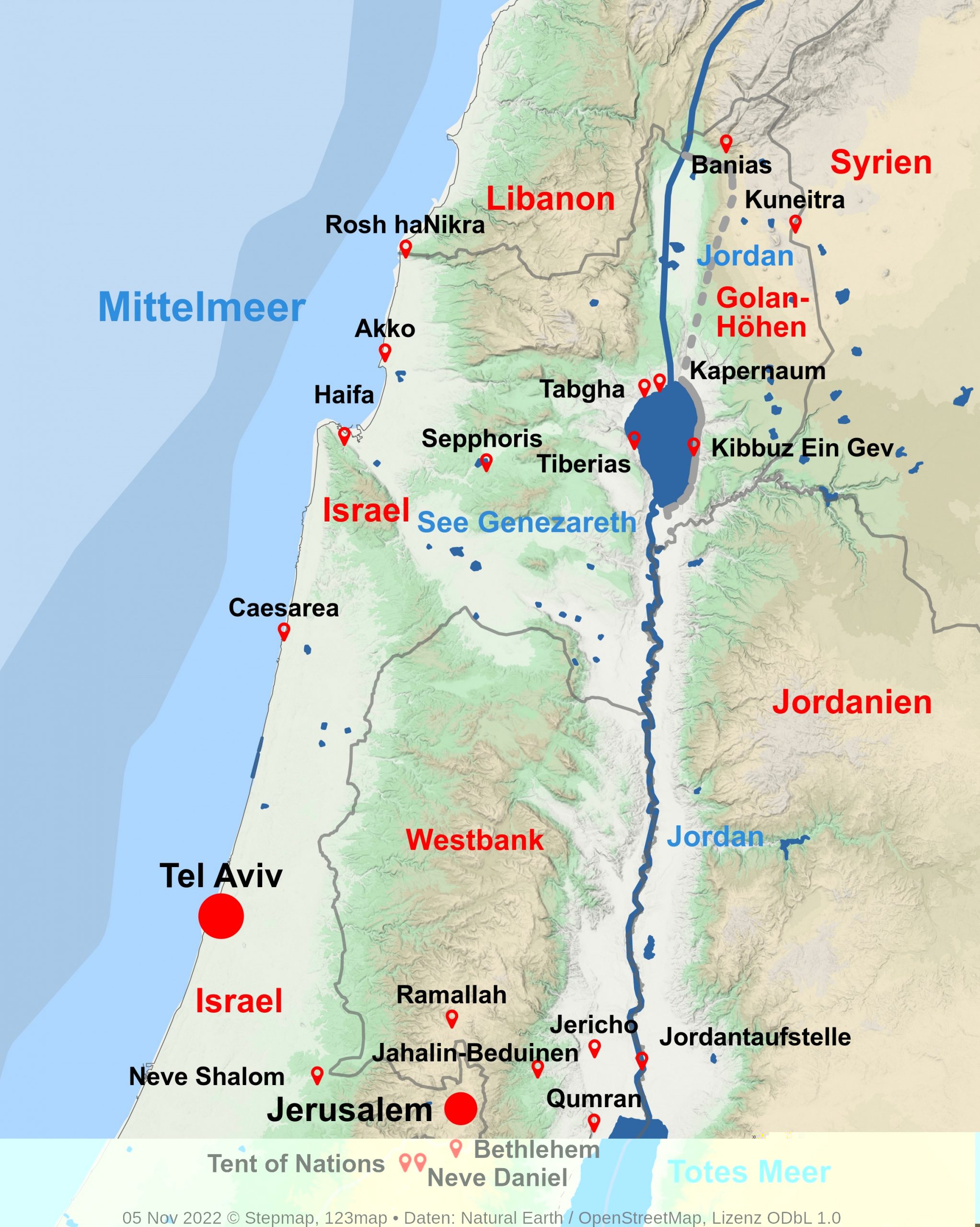
Northern part of the JIK map of Israel-Palestine-Jordan (southern part see below on Day 11).
Day 1: Saturday, 1.10.: Jaffa – Tel Aviv – Neve Shalom – Latrun – East Jerusalem
In order not to miss the flight from Cologne to Tel Aviv at 1:50 because of expected overlong waiting times, we met already on 30.9. at 10 p.m. at the Turkish Airlines counter, especially since it was not possible to check in online beforehand. All of them had as additional hand luggage a large art/cloth bag with thousands of JIK and ToN folders in English and German as well as tons of writing materials and notebooks for the 200 students of the car tire school of the Jahalin Bedouins in the Judean Desert in Israel (see below, Day 11).
Thank goodness there were no complaints about our (excess) luggage, the check-in and the hand luggage checks went smoothly, so that after a stopover in Istanbul we arrived at Ben Gourion Airport about 30 minutes late.
Passport control was initially electronic and very straightforward. Afterwards, a security officer looked at our group’s passports only superficially at first, so we already thought that we would pass this check in record time. But then he discovered that one participant had a last name with an Iranian migrant background, even though she was born here and has a German passport. Therefore, she had to endure a 2.5-hour “security check” in the presence of a female escort.
Since no one knows how long such a survey takes, we left with our new driver Edgar without the 2 TNs for a short visit to picturesque 3,000 year old Jaffa and then to the 10 km long beautiful sandy beach of Tel Aviv. Around noon, the two TN who stayed behind at the airport came by cab to the beach, so that they could at least swim in the Mediterranean Sea.
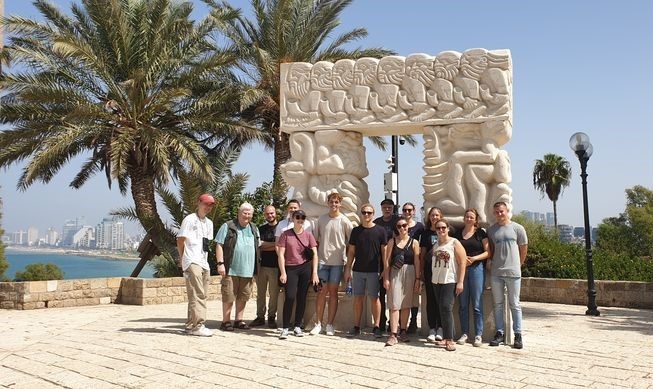

Tel Aviv-Jaffa overlooking Mediterranean Sea and Tel Aviv beach
In the afternoon, on our way to Jerusalem, we first drove to the peace village of Neve Shalom, the only village in which about 80 Jewish, Muslim and Christian Orthodox families live together on an equal footing, celebrate the corresponding religious festivals together and attend kindergarten and peace school together. In all other kindergartens and schools – with the exception of the few Christian institutions – Israeli Jews and Israeli Muslim Arabs or Palestinians are taught in separate schools and, with regard to the Middle East conflict, are only taught the very one-sided Jewish or Muslim narrative, which in each case blames the other side for this conflict.
We walked through the village to the Spiritual Center, where we meditated for a few minutes in the “Room of Silence” in the form of a dome, used among other things for religious celebrations.
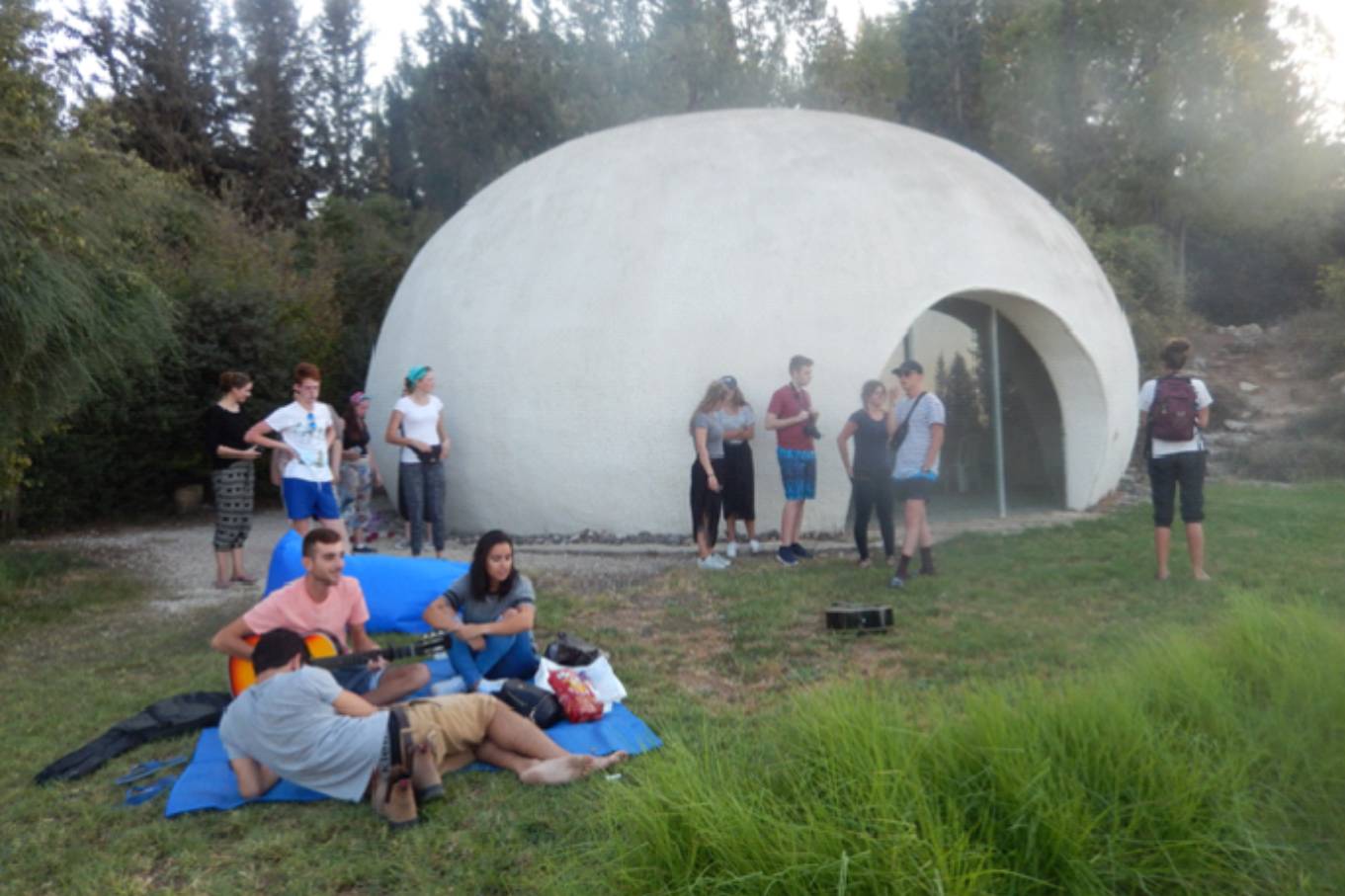
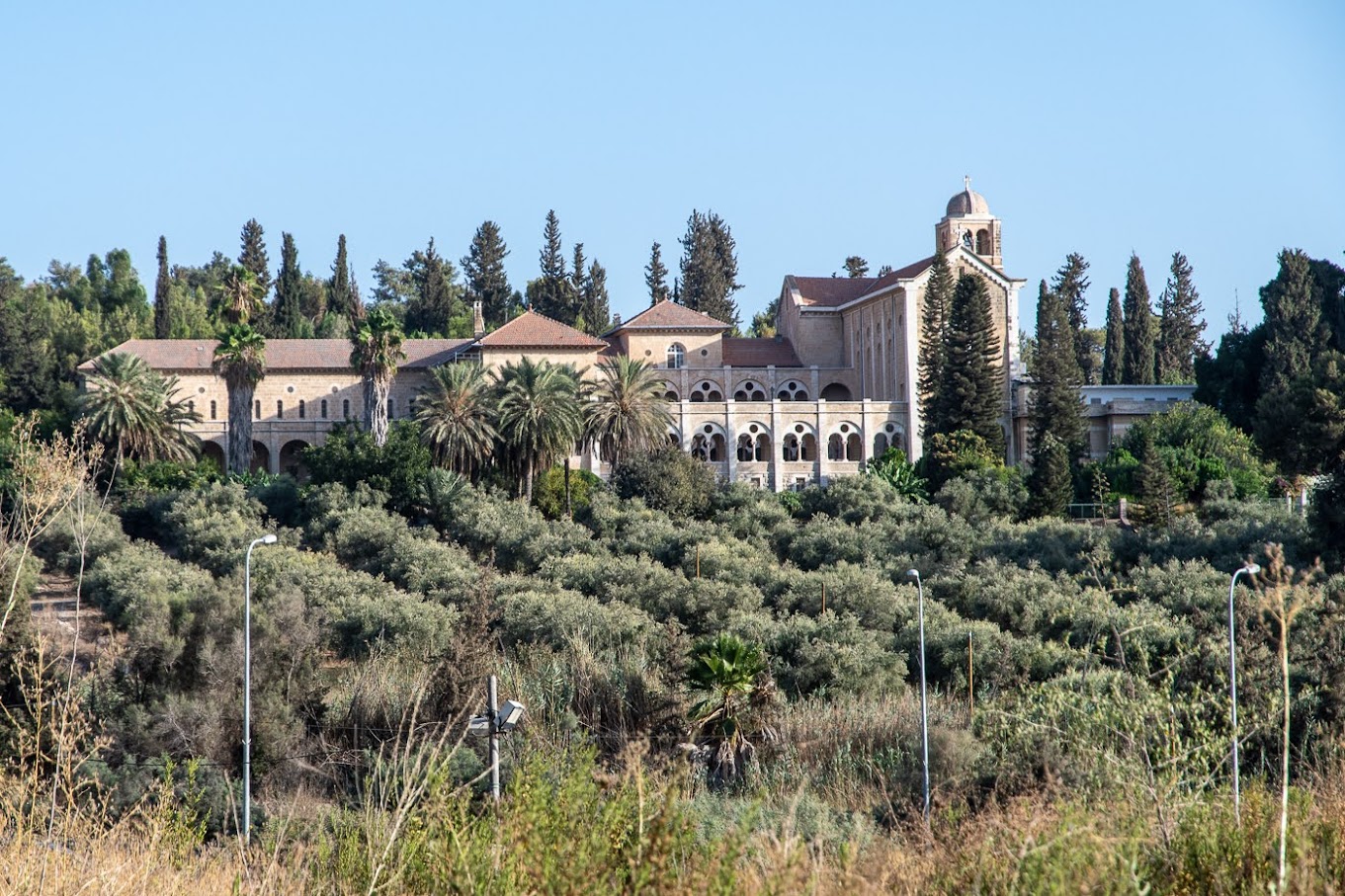
Neve Shalom – Spiritual Centre and Latrun Monastery
Due to time constraints, as a contrast to the Peace Village, we visited the Army Museum in Latrun from the outside, where the Israelis proudly display their tanks, planes, etc., mostly of German origin, captured in several wars (We are still the third largest arms exporter in the world.). The trapiste monastery Latrun was already closed, so we had to be content with a photo from a distance.
Trapiste monastery Latrun
On the hill of a former crusader castle a small community of members of the Jesus-Brotherhood lives, works and prays together with local staff and German volunteers. The place where the Monastery of the Silent Monks stands today, served in the 19th century. as a way station for pilgrims from Jaffa to Jerusalem. After being sold to the Order of St. Benedict, the monastery, which became known as the Monastery of the Silent Monks, was built in 1890. Until 1960, it was part of the vow to refrain from talking and instead maintain silence at all times except during prayer. A large church and living quarters are located on the monastery grounds, there is also a beautiful garden and a modest courtyard.
Although this silent order, like all monks in Israel, is absolutely peaceful, their monks have been repeatedly attacked and beaten by Israeli settlers in the past, as these groups want to expel not only Muslims but also Christians from Israel. Similar things have often happened to Benedictine monks of the Dormitio Abbey in Jerusalem. In Tabgha on the Sea of Galilee, the branch of the Dormitio Abbey, a devastating arson attack with a clear anti-Christian background was even carried out by ultra-nationalist groups in 2015 (see below, Day 10).
As a result of the high media coverage and the clear condemnation of the crime by then President Rivlin, criminally underage perpetrators and a mastermind were identified. In the end, only one perpetrator could be proven to have committed the crime. He was sentenced to 6 years in prison and a fine equivalent to €13,000. After tough negotiations, the State of Israel paid €400,000 for the reconstruction, and the same amount was raised within a short time through worldwide donations.
In the early evening we met the German volunteer Jakob Hochbaum from Freiburg in the Kaiserin Auguste-Viktoria-Stiftung in East Jerusalem, near our accommodation on the Mount of Olives, who – in the absence of the new parish vicar Svenja Prust, who was prevented from attending – very competently explained to us the history and the work of the foundation as well as the Protestant congregation in Jerusalem. of the hospital, although he has only started a one-year traineeship there since the beginning of September after graduating from high school.
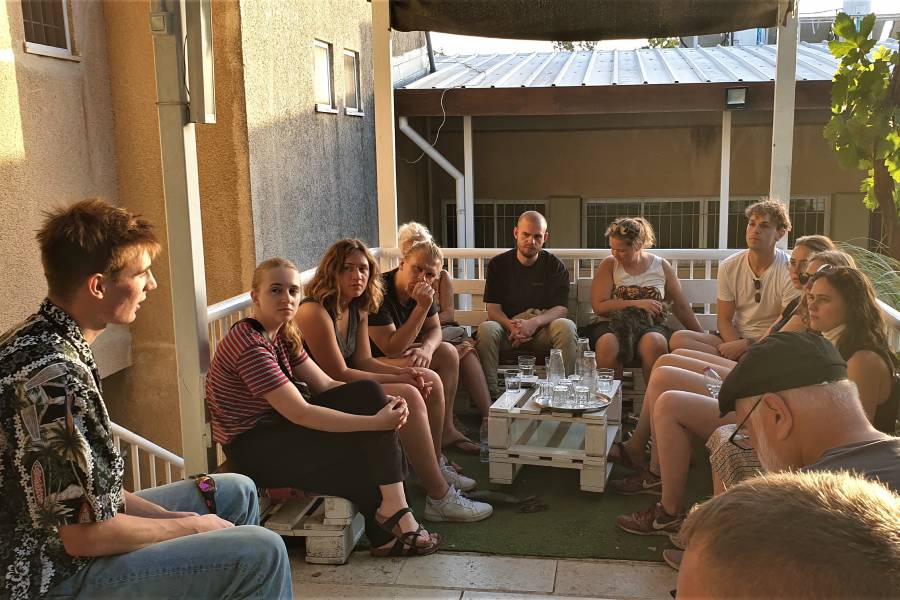
Interview with volunteer Jakob Hochbaum
The Protestant Empress Auguste Victoria Foundation goes back to the visit of Kaiser Wilhelm II. 1898 in Palestine, during which he – together with his wife Empress Auguste Viktoria – also officially visited the Germans in the Holy Land. Thus, he promised the German Protestant congregation in Jerusalem and the Catholic Holy Land Association a convalescent home with hospice (today’s Paulus House with attached Schmidt School opposite the Damascus Gate). This was intended primarily for malaria sufferers and the many Germans in Jerusalem. In addition, he had a church built. At that time, there were several thousand Germans living in the Holy City who were in urgent need of medical assistance. Even today you can see the steeple of the church of Jerusalem from the ridge of the Mount of Olives. Mount of Olives into the sky.
The Church of the Ascension is a sacred building on the Mount of Olives in Jerusalem, completed in 1914. It was built on the Mount of Olives by the Empress Auguste Victoria Foundation, which was established there in 1899. In 1907 the foundation stone for a malaria hospital was laid and in 1910 the church was consecrated. Today’s Auguste Victoria Hospital provides life-saving medical care to Palestinians in the West Bank and Gaza Strip, including specialized therapies in its cancer, diabetes and pediatric units. It is the only facility that provides radiation therapy for the 4.5 million Palestinians in Gaza and the West Bank. The church stands on one of the highest points of Jerusalem, 850 meters above sea level and almost 1300 meters above the Dead Sea. The church is built in the Wilhelminian-Neobyzantine style. The entire west facade was surrounded by a massive porch to protect it from the strong winds and rainfall. In 1988-1991, after the structural restoration and the elimination of earthquake damage, the works of art were restored to their original condition.
Since we had to be at our accommodation in the Birgittine Convent at the foot of the Mount of Olives before 7 p.m., because we wanted to move our extensive luggage, which only with great difficulty found room in Edgar’s minibus, as well as our rooms and have dinner there at 7 p.m. (The 6 sisters pray after dinner is served and go to bed around 9 p.m., since they get up very early for morning prayer.), we had to forego the guided tour of the Church of the Ascension offered by Jakob, to the regret of some of the participants.
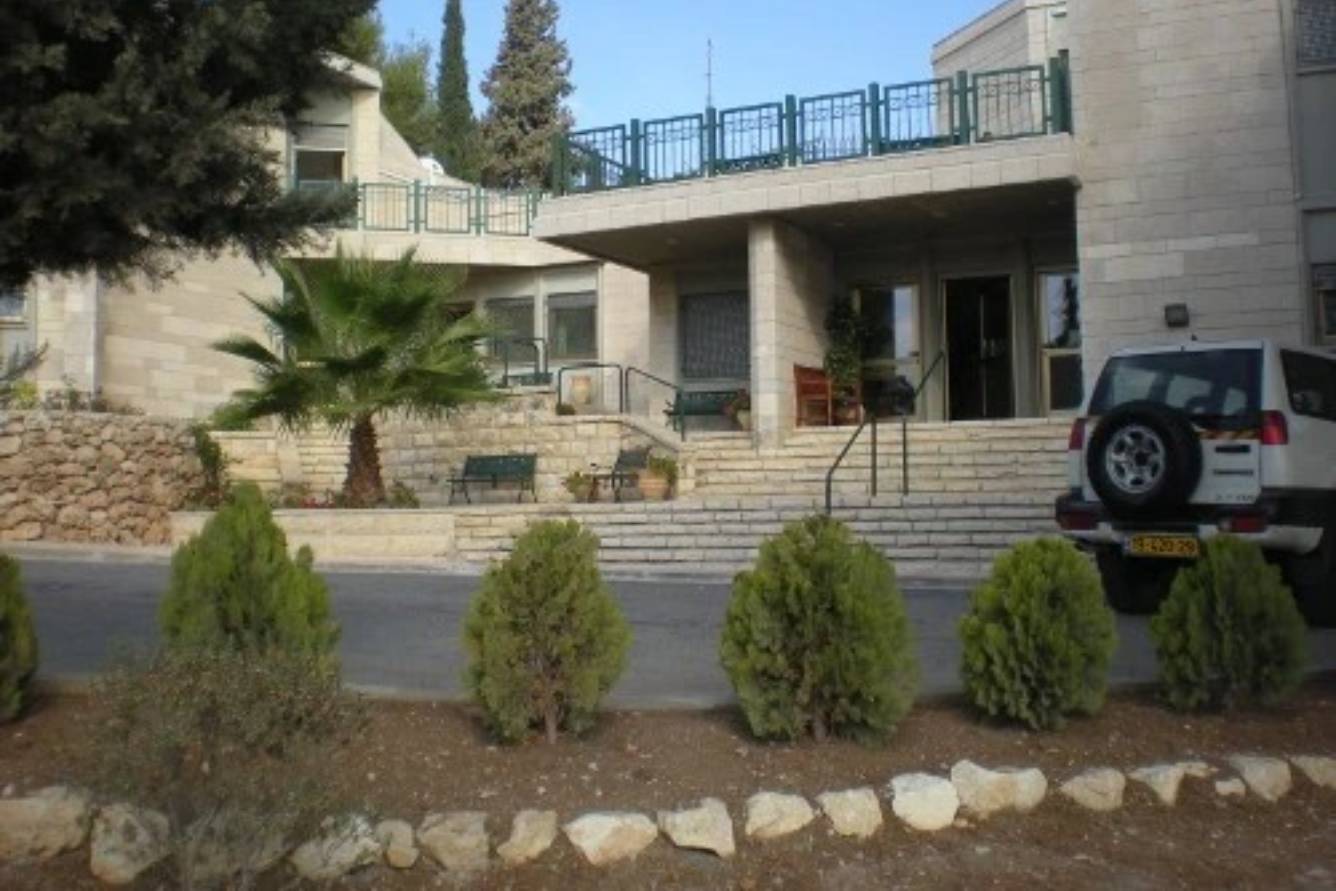
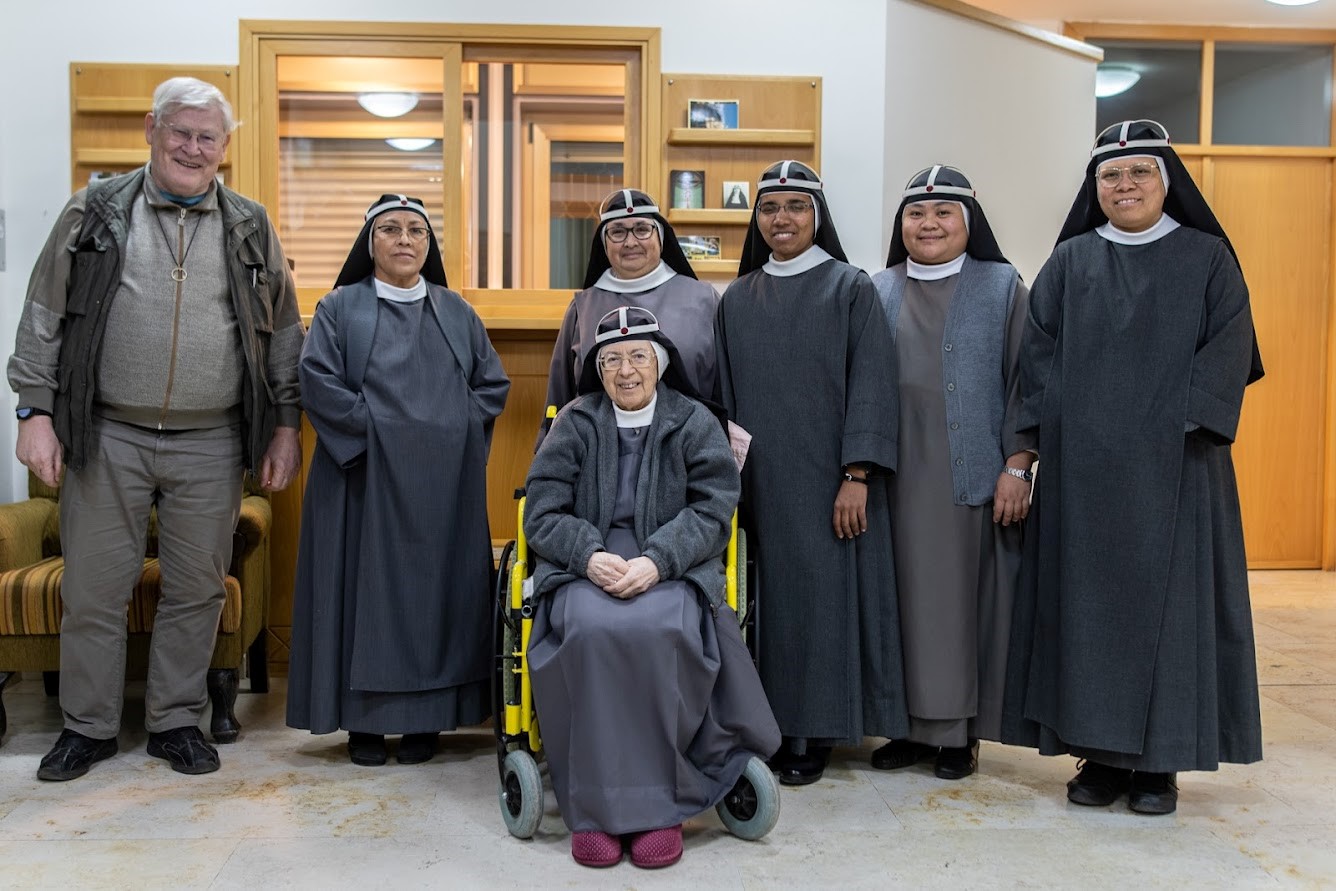
The Birgittine Convent at the Foot of the Mount of Olives and The Birgittines
On 7.10. could the church tour incl. Tower tour and outdoor area of the Auguste-Viktoria-Foundation then still be made up for. After dinner, reflecting on this eventful day with the TN (which we were able to do most evenings) and discussing tomorrow’s program, we sat outside on the terrace of the monastery for some time, enjoying the unique sight of the brightly shining golden dome of the Dome of the Rock not far away.
Day 2: Sunday, 2.10.: Jerusalem – Old City and Reform Synagogue Kol Haneshama
After breakfast, Edgar drove us very early to the Dung Gate, from where we hurried towards the Western Wall to the entrance for the Temple Mount, in order not to have to wait for hours in a queue in front of the entrance – as in some previous years. Amazingly, we managed to get to the entrance ahead of a large tour group at the very front, so we were able to immediately pass through the Israeli entrance controls and get to the Palestinian entrance control under the suzerainty of the Jordanian Waqf (religious authority) at the entrance to the Temple Mount. Problems with our clothes because of not enough covered knees, arms and breast area in women were solved thanks to provided skirts, extra scarves etc.
There were larger accumulations of tourists / pilgrimage groups on our trip now and then, but overall much less than by 2019.
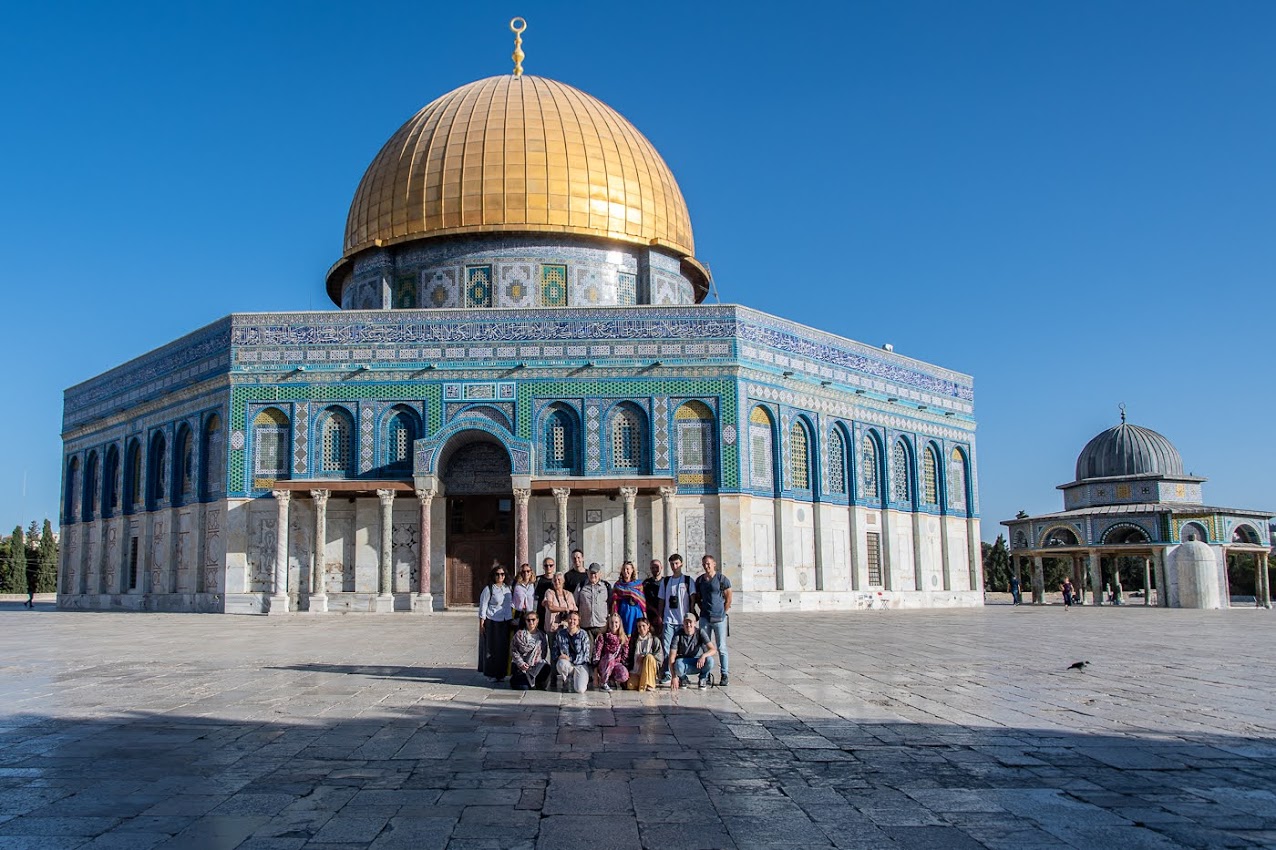

On the Temple Mount: Dome of the Rock and Al Aqsa Mosque
Temple Mount + Dome of the Rock
The Temple Mount is a hill in the southeast of the Old City of Jerusalem, above the Kidron Valley. On its summit is an artificial plateau of about 14 hectares, in the center of which stood the Herodian Temple, a successor building to the post-exilic Jewish Temple, which in turn was built on the foundations of Solomon’s Temple. Since the end of the 7th century. n. Chr. the Dome of the Rock stands here. On the southern side of the esplanade is the al-Aqsa Mosque (completed in 717 CE). The Temple Mount is one of the most controversial holy places in the world and the third largest Muslim sanctuary (after Mecca and Medina).
The Dome of the Rock in Jerusalem is the oldest monumental sacred building in Islam and one of the main Islamic shrines. It stands on the Temple Mount, was built in 687-691, and has been restored, altered and extensively added to many times over the centuries, most recently in the early 1990s. On the rock standing in the center of the building, according to popular Jewish tradition, the world was founded, the center of which was the stone in the Jerusalem Temple. At this place Abraham had wanted to sacrifice his son Isaac and here the ark of the covenant had been. The later Temple Mount, in turn, became the holy place of the Israelites with an altar to end the plague only after King David bought it from the Jebusite Arawna.
According to Islamic tradition, it is from this rock that Mohammed is said to have started his ascension and his meeting with the earlier prophets of Judaism and Jesus. The Dome of the Rock is a masterpiece of Islamic architecture of the early Umayyad style and adopts the early Christian Byzantine central building type. The building, with a dome originally of wooden construction, was built over an exposed rock. In archaeological research, the relationship of this rock to previous temple buildings from biblical times is disputed. It is often assumed that the Holy of Holies or the altar of burnt offering of the ancient Jerusalem sanctuary was located on the rock. The Dome of the Rock is an octagon modeled on the Church of the Holy Sepulchre and was originally – and still is not – understood to be a mosque, but a shrine or dome. Since 2000, non-Muslims have been allowed to Dome of the Rock and Al-Aqsa Mosque because the many Muslims praying there 5 times a day used to feel considerably disturbed by the numerous tourists.
Jews are only allowed to enter the Temple Mount without a kippah via the tourist entrance and are not allowed to pray there. That is why there are frequent violent clashes on the Temple Mount with Orthodox Jews and radical settler groups who want to tear down the Dome of the Rock to put a new, 3rd temple in its place, for which they say they have already raised several billion dollars.
After visiting the Al-Aqsa Mosque, the Dome of the Rock and the outdoor area, we left the Temple Mount on the Via Dolorosa side. We first went to Lions Gate and through the gate to the Muslim cemetery at the city wall, but it was cordoned off by Israeli soldiers. We then returned to the Via Dolorosa and the Damascus Gate, where we exchanged money, and to the Austrian Hospice (3rd stop), from where we followed the individual stations of Jesus’ Passion to the Church of the Holy Sepulchre.
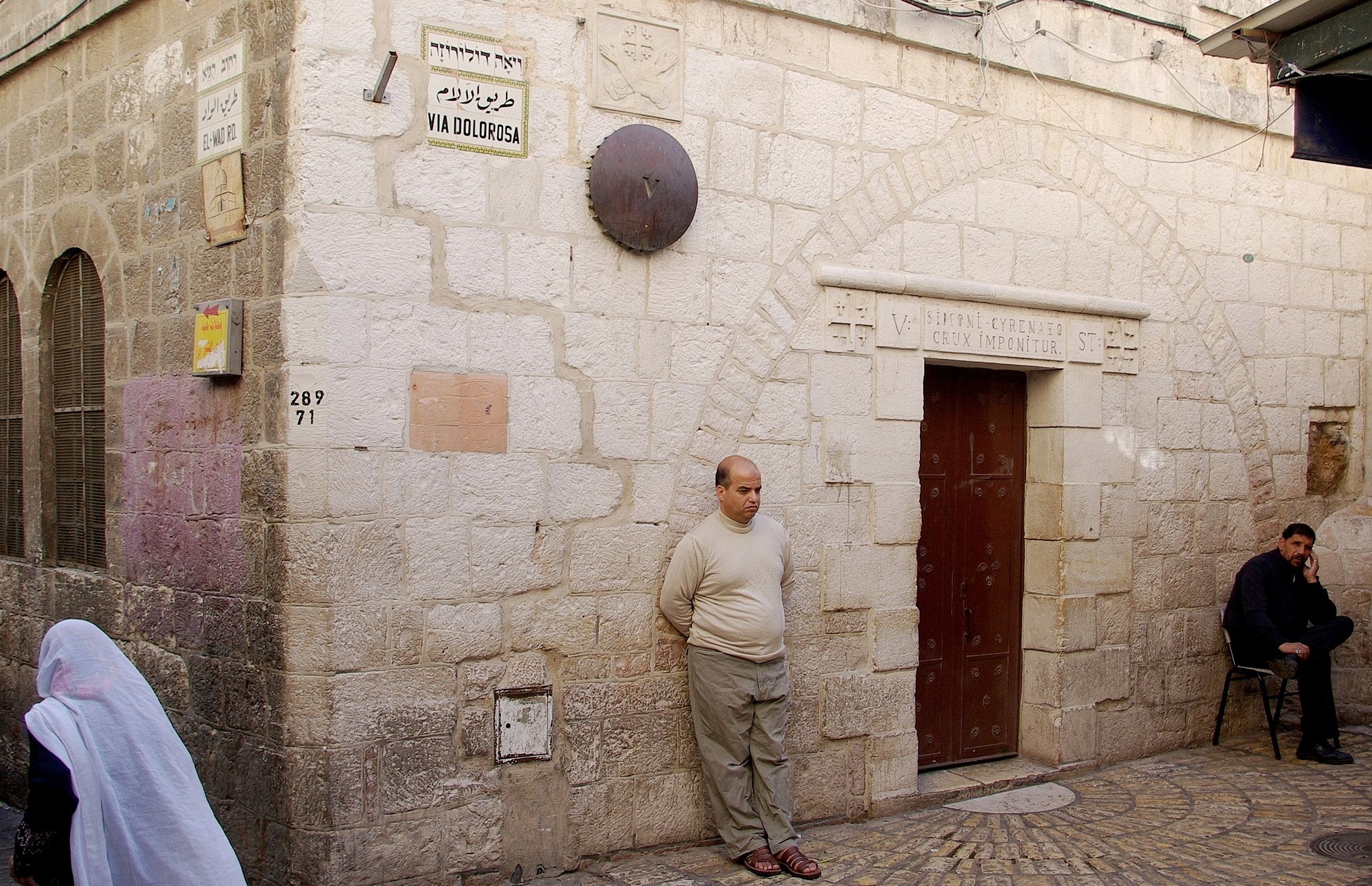
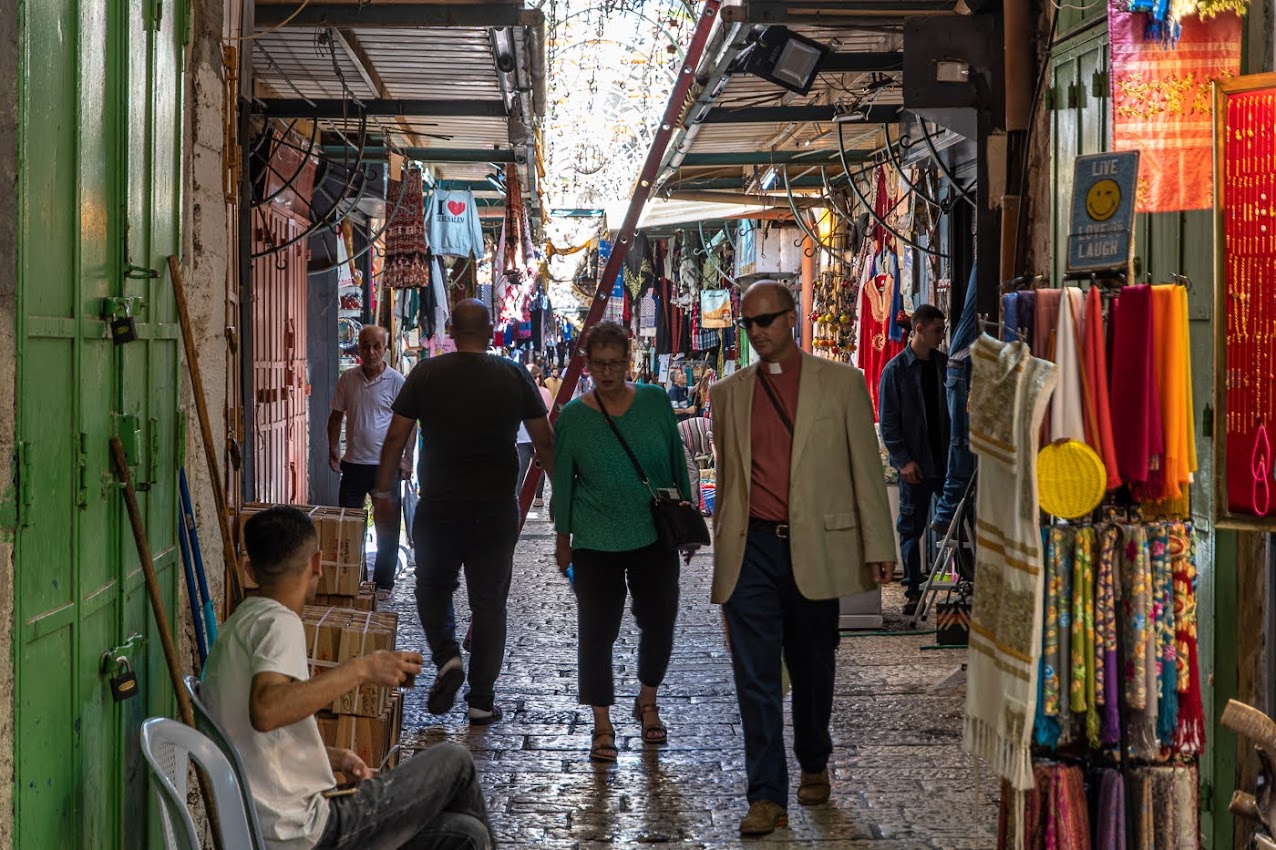
Via Dolorosa, V. Station and Souk in Jerusalem Old City
Via Dolorosa
Every year, tens of thousands of believers walk the processional way with song and prayer or in silence, every Friday at 3 p.m. the Franciscan friars from Jerusalem. The name Via Dolorosa dates back to the 16th century. At that time, however, the Via Dolorosa had only four stations, which in the course of the centuries were extended by Franciscan friars and also changed in the routing, depending on the needs of the pilgrim groups at that time. The Via Dolorosa cannot be the actual path that Jesus had to take from the arrest on the Mount of Olives to the crucifixion site of Golgotha, especially since these narrow streets have existed only since the Middle Ages. It is – as elsewhere in the Holy Land – not decisive whether Jesus really went this way or took another way to Golgotha. What is decisive is that Jesus was led from the Mount of Olives to the place of crucifixion on Friday night and died there on the cross before the dawn of Shabbat at the beginning of the Jewish Passover festival, probably on 7.4. 30 AD.
Church of the Holy Sepulchre
The Church of the Holy Sepulcher is located in the heart of the Christian Quarter in Jerusalem’s Old City and is considered one of the holiest sites in the Christian world. The church stands on the place where, according to tradition, Jesus was crucified and buried, and where he rose after three days.
It was built in 335 AD by St. Helena, the mother of the Byzantine Emperor Constantine the Great. It was repeatedly destroyed and rebuilt during the Byzantine era and at the time of the Crusaders. This was also the case in the mid-11th century, when the Fatimid Khalif al Hakim enforced harsh laws against Jews and Christians and razed many of their places of worship to the ground. His successor, Khalif al Zahir, allowed the reconstruction of this holiest site of Christianity; the new building was smaller, but more ornate and richly decorated than the original church built by St. Helena.
The church is venerated as Golgotha (Calvary), which literally means “skull”. It got its current appearance at the time of the Crusaders. They were the first to unite the sites of crucifixion and burial under one roof. The 800-year-old façade of the Crusaders is splendidly decorated, and at the entrance there are two massive wooden gates, one of which has been in use since the reign of Saladin in the 12th century. is locked.
Today the Church of the Holy Sepulchre is administered by 6 Christian denominations. At the top are the Greek Orthodox, the Armenian Apostolic and the Roman Catholic Churches, the latter represented by the Franciscans. In the 19th c. were joined by the Coptic Church of Egypt, the Syriac Orthodox Church of Antioch, and the Orthodox Tewahedo Church of the Ethiopians. These churches received only a few chapels, and the Ethiopians are limited to the dilapidated Deir al-Sultan monastery on the roof.
The coexistence of the Christian denominations is determined by the so-called “status quo,” a decree issued by the Turkish sultan in 1852. Since there have long been disagreements over the claims of the various denominations to the church, which have led to physical confrontations on several occasions in the past, the keys to the church are held by the Muslim Joudeh family. The second wooden gate that allows access today is opened and closed every day by a representative of the Muslim Nusseibeh family. This custom is part of the current status quo of religions in Jerusalem and dates back to the Muslim dominance in the city in the days of Saladin. The conflicts of the Graves Church residents keep complicating urgently needed renovation work. The symbol of the disputes became a Wooden ladder (see below picture “Entrance to the Church of the Holy Sepulchre”), which was built in the 19th century. was placed on the facade above the main portal. It is still there today, as it is unclear who would be authorized to do so.
Following agreement between the Greek Orthodox, Armenian and Roman Catholic Churches, the overdue restoration of the Chapel of the Holy Sepulchre began in 2016. The marble slab above the burial bench was removed so that the original rock surface could be examined, on which, according to tradition, Jesus’ body was laid. As part of the restoration, a window opening was cut and glazed into the marble facing of the inner wall of the burial chamber on the opposite side of the burial bench. The window provides a view of the remains of the rising rock wall, confirming that the burial chamber is a single grave, which is rare in the region. Also in the Gospel of John it says that Jesus was buried in a new tomb where no one had yet been laid.
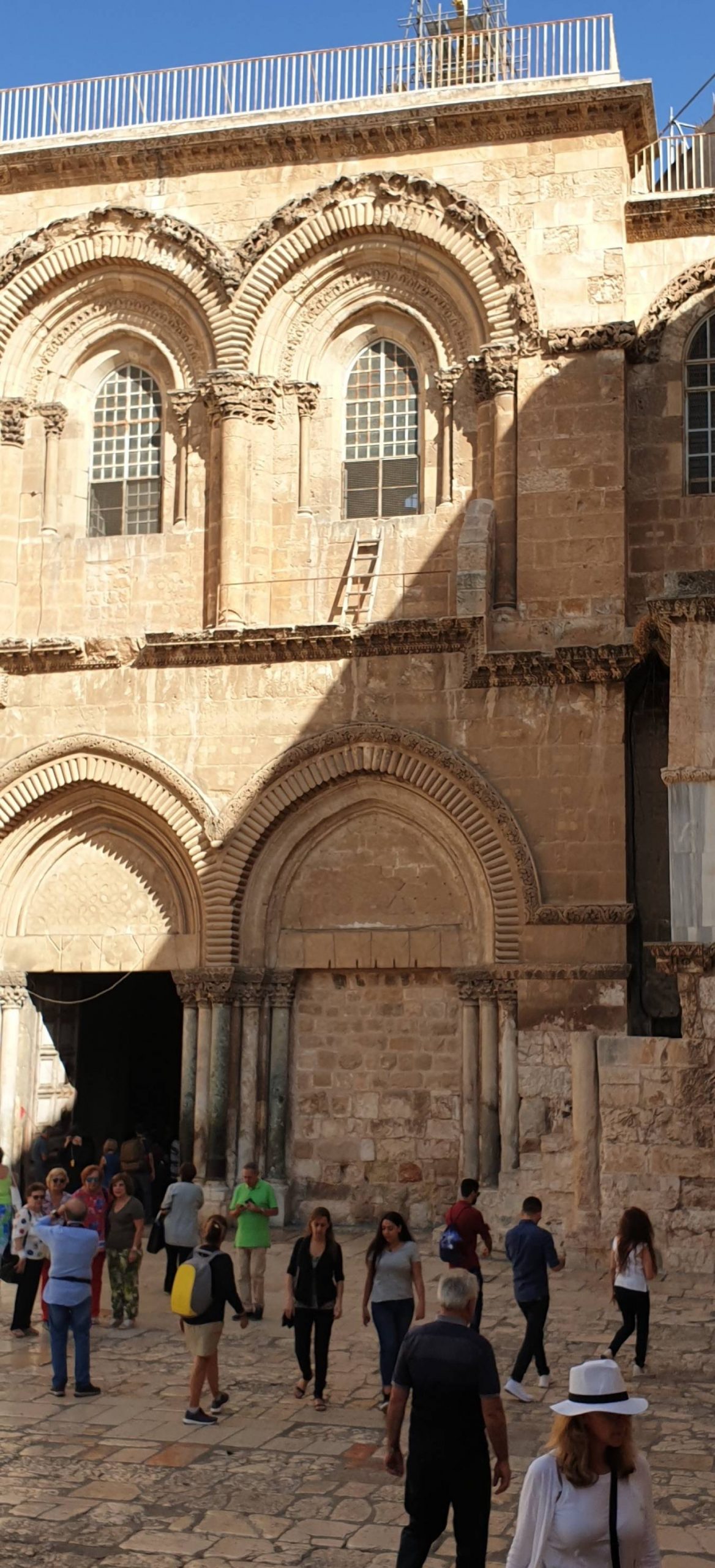
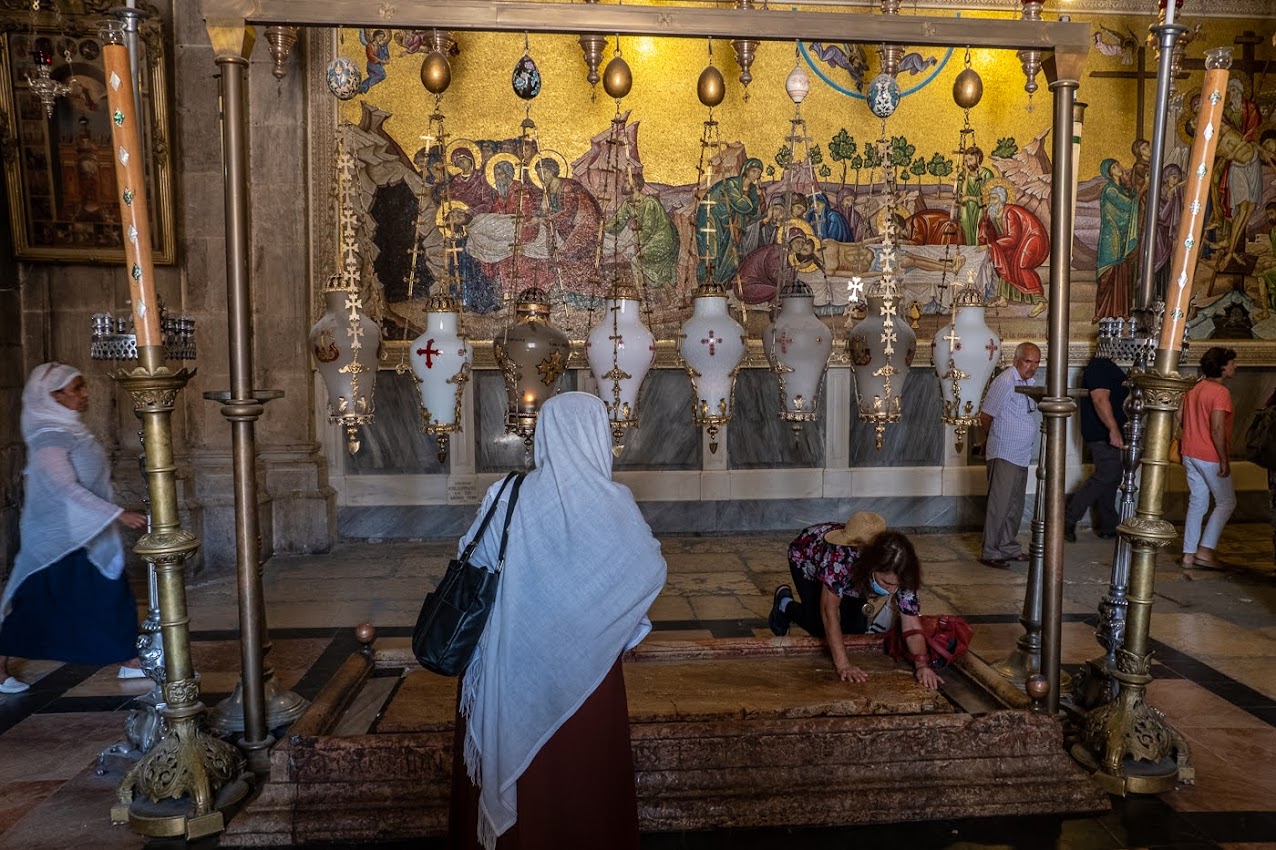
Entrance to the Church of the Holy Sepulchre and anointing stone inside the Church of the Holy Sepulchre
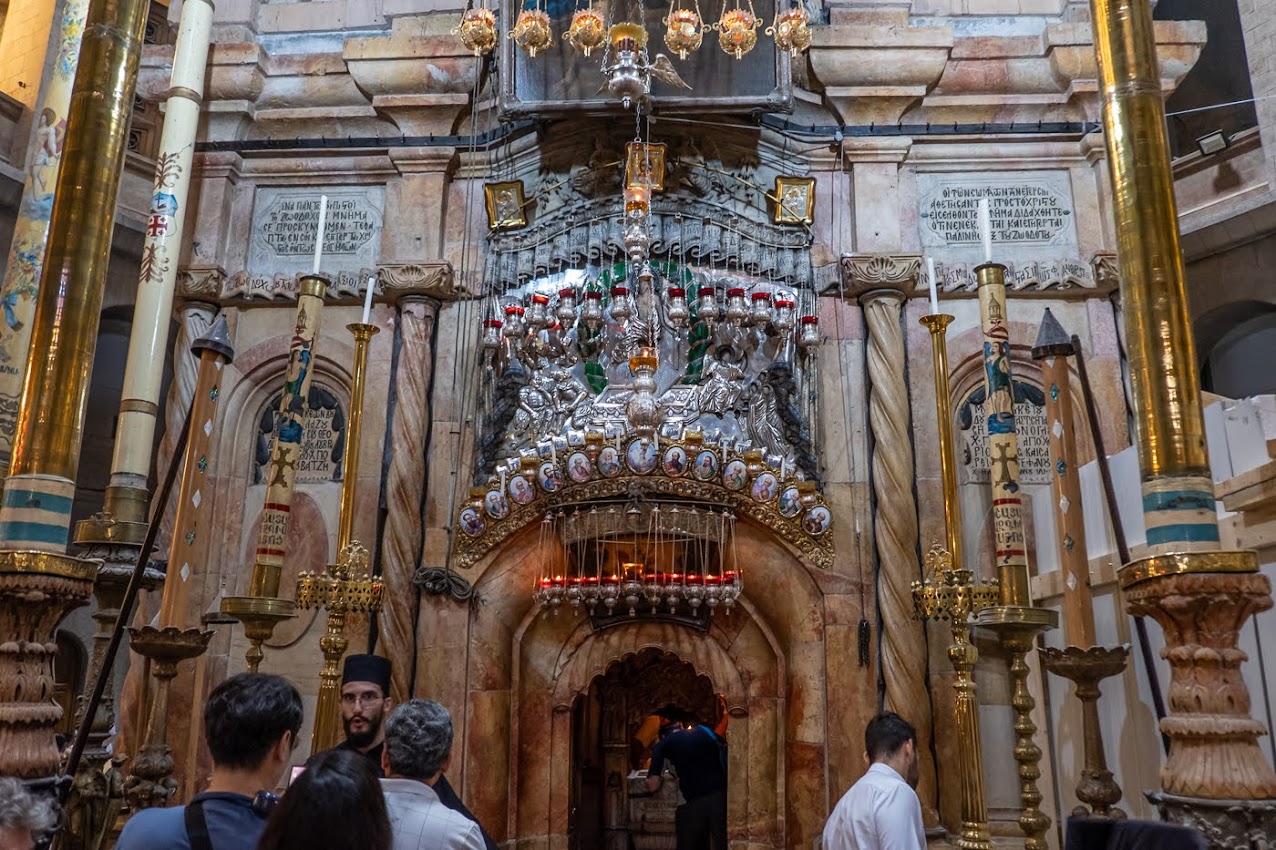
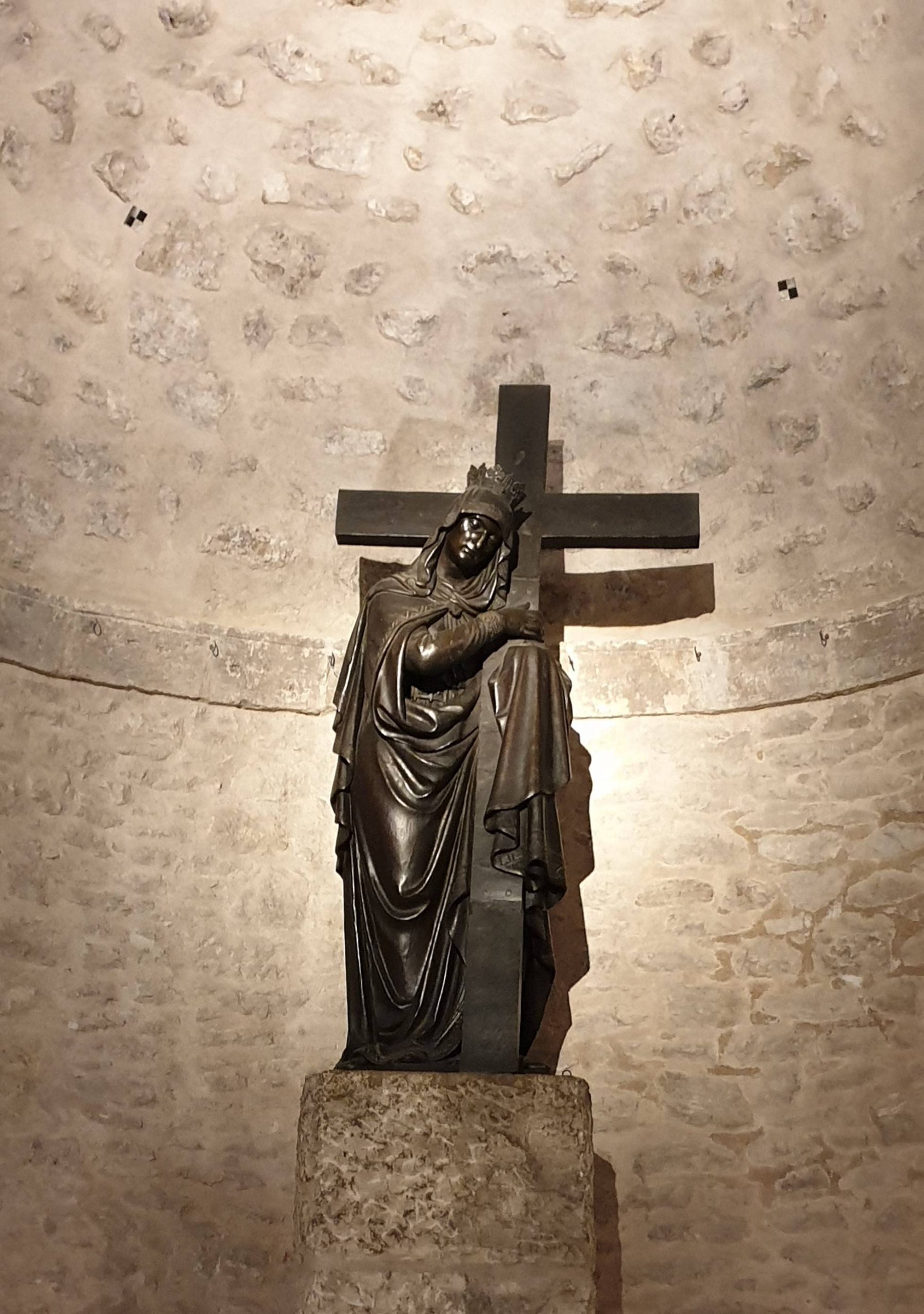
Entrance to Jesus’ tomb and Helena Chapel
We first went to the roof of the Church of the Holy Sepulchre, where the Ethiopian Christians are housed. Then we descended the steps to the entrance and entered the Church of the Holy Sepulchre. We now first looked at the Anointing Stone and then followed Stations of the Cross X-XIV in the Church of the Holy Sepulchre: (X) Jesus is unclothed; (XI) Jesus is crucified; (XII) Jesus dies on the cross; (XIII) Jesus’ body is taken down from the cross; (XIV) the Holy Sepulchre. Since the queue in front of the entrance to the Holy Sepulchre was quite long – there were several opportunities to visit the Holy Sepulchre after the guided tour and in the following days – we entered the central nave in the center of the church, which is partitioned off as the worship space of the Greek Orthodox Church and where a bowl-like stone (omphalos) can be seen, since in the past Jerusalem or the Golgotha rock was called the “navel of the world”. Behind the Holy Sepulcher in the west apse is a Syriac Orthodox chapel with a Jewish cave tomb from the 1st century AD, very similar to the tomb of Jesus described in the NT. Unfortunately, we could not visit this tomb because of a service in the chapel. We went down to the Helena Chapel, where the Empress Helena in 325 AD immediately recognized the cross of Christ among the many crosses lying there, which was the reason for the construction of the Church of the Holy Sepulchre.
You can still clearly see parts of the Golgatha rock there. We left the Church of the Holy Sepulchre, walked through the Christian Muristan Quarter with the Lutheran Church of the Redeemer as well as the Provost Church, and then up through the souk through the Jaffa Gate, from where there is a wonderful view of the city wall as well as West Jerusalem. From there you can walk down to the sinfully expensive Israeli shopping mall in the New Town.
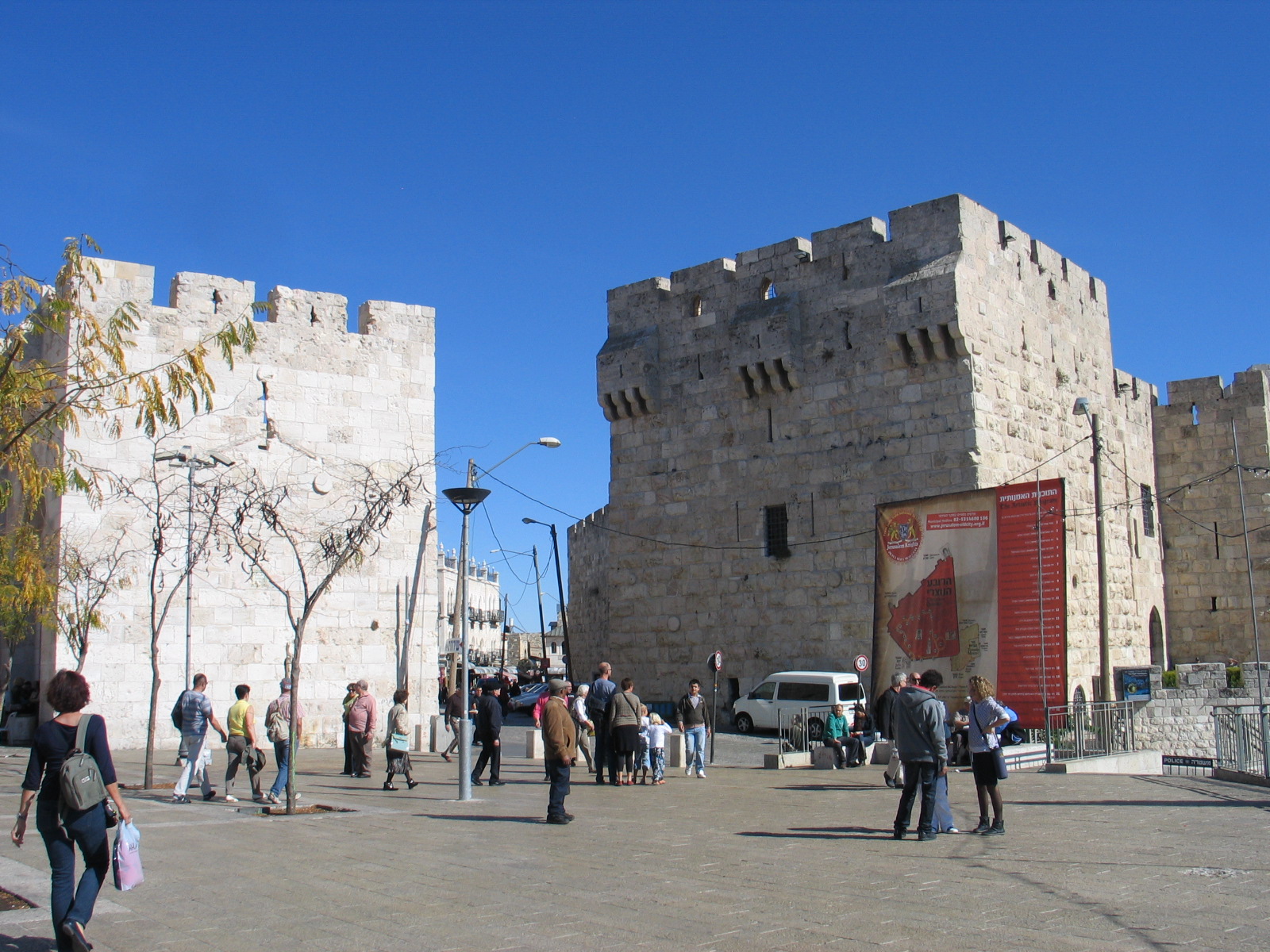
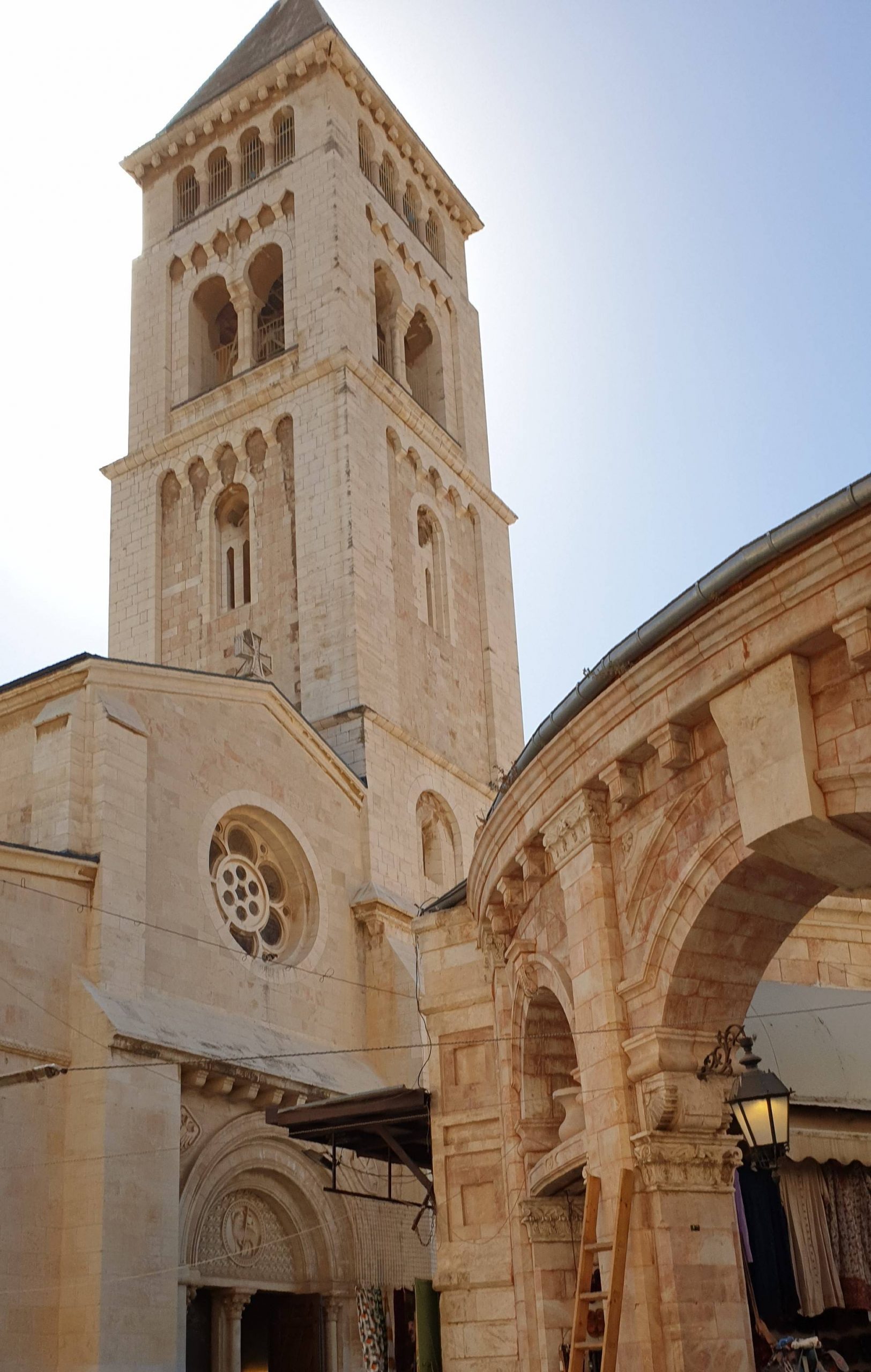
Jaffa Gate and Church of the Redeemer
We walked back through the very wide Jaffa Gate, which was supposedly widened on Kaiser Wilhelm II’s orders during his visit in 1898, so that the Kaiser and his entourage could ride high on horseback through the Jaffa Gate. We left the David Citadel (now a museum of the city’s history) on the right and strolled back through the souk until we came to the first turn to the right to a metal staircase that takes you to the roof terrace, from where you have a wonderful view of the old city.
From there we went to the Wailing Wall, where many young Israelis were singing loudly because of the upcoming High Festival of Sukkot and were already getting in the mood for this festival or were probably also celebrating Bar Mitzvah.
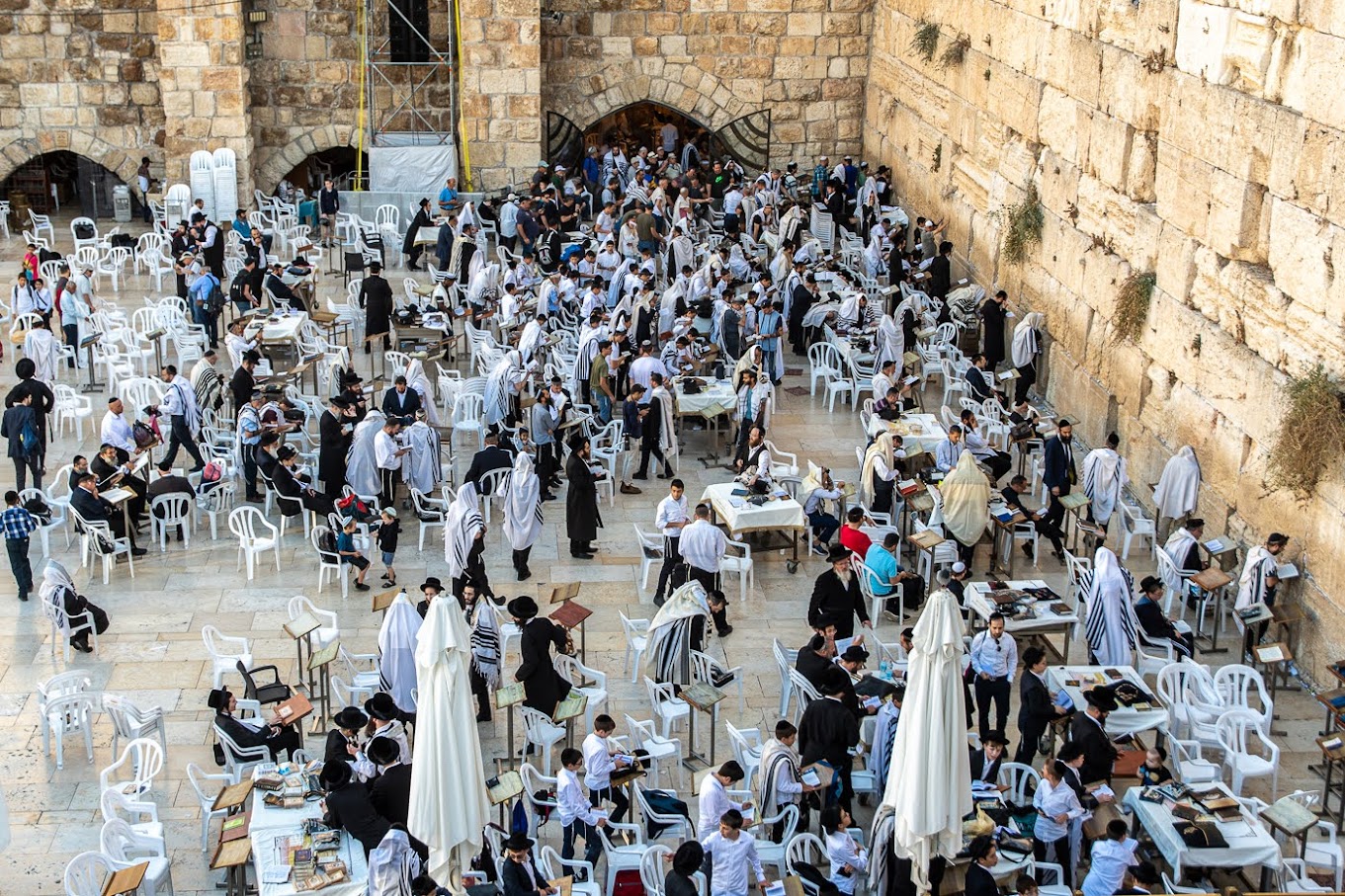
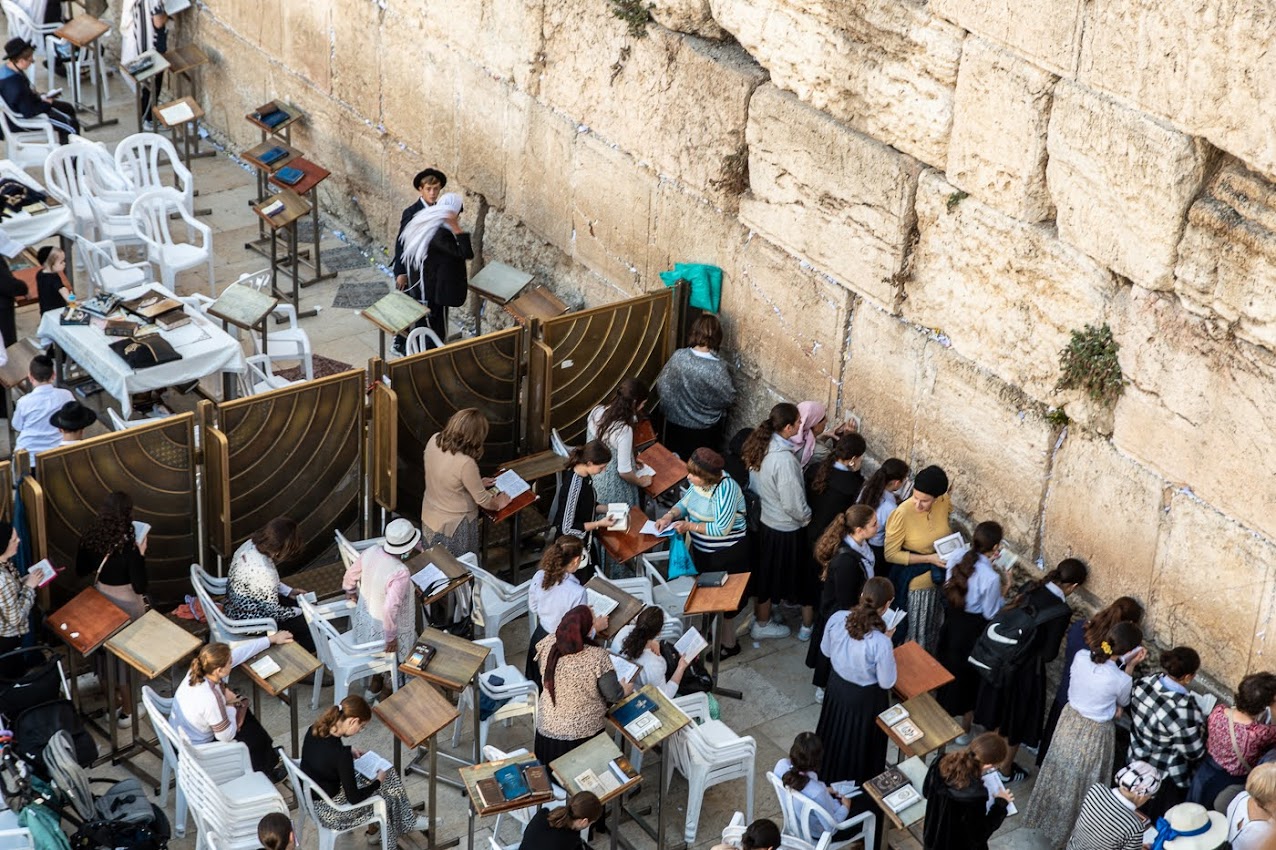
Western Wall: area for men and small separated area for women
After some information about the history and meaning of the Western Wall including the vault to the left, where many Orthodox Jews pray incessantly (the only part of the Western Wall of the Temple Mount that is accessible to Jews since the end of the 6-Day War), I ended the tour, since we wanted to be in the Reform Synagogue by 14:00.
Traditionally, believers and tourists stick small and large pieces of paper with hopes, wishes, worries, needs and fears into the cracks of the wall. Since the cracks in the wall are not enough for so many notes, the Western Wall is cleaned before Passover. In a solemn ceremony supervised by the Western Wall Rabbi, thousands of prayer slips are removed from the cracks and then buried on the Mount of Olives.
Afterwards, some of us returned to the Austrian Hospice today a guesthouse with outdoor dining above the souk amid palm trees and cacti, a paradisiacal oasis of calm in the otherwise hectic old town and a popular tourist meeting place.
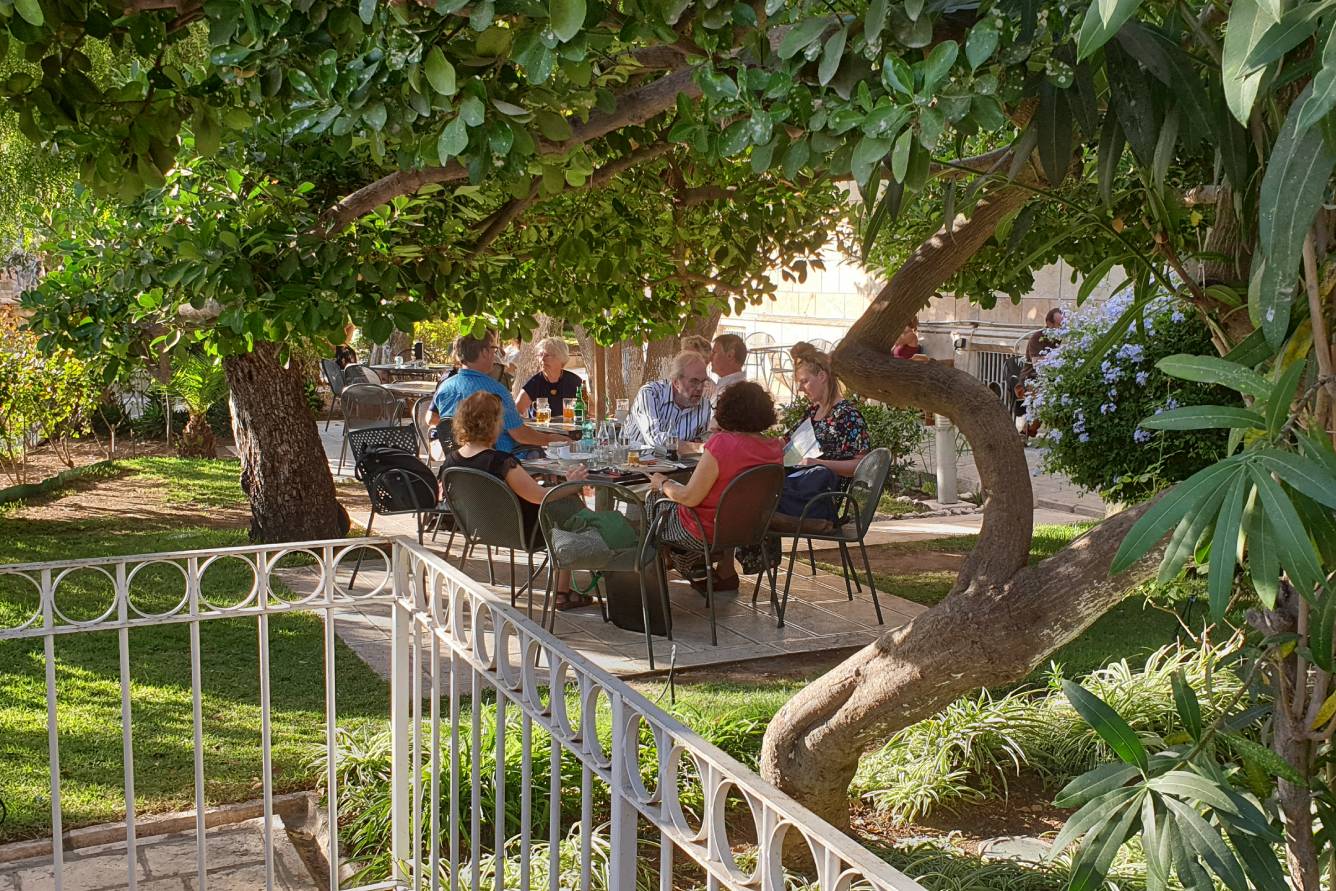

Outdoor restaurant of the Austrian Hospice and Damascus Gate: Entrance to the Muslim Quarter.
The Austrian Pilgrimage Hospice to the Holy Family in Jerusalem is a pilgrim hostel of the Catholic Church of Austria in the Old City of Jerusalem. It is located at the corner of Via Dolorosa and el-Wad Street of the Muslim Quarter, situated at the 3rd station of the Way of the Cross. Founded in 1856 and opened on March 19, 1863, the hospice is the oldest national pilgrimage house in the Holy Land.
After the lunch break we drove to the Reform Synagogue Kol Haneshama, where we had a highly informative conversation with the still young and very open-minded Rabbi Oded about the differentiations within Judaism (positive attitude towards homosexuality, female rabbis etc. only among Reform Jews), Jewish festivals, the lack of civil marriage in Israel, etc. He explained to us the process of a Shabbat celebration, the making and use of the Torah scrolls, recited some verses from them, and also blew the shofar horn. We probably could have listened to him for hours, but Oded’s and our time budget did not allow it.
Kehilat Kol HaNeshama is a Jewish Reform community in southern Jerusalem advocating pluralism, equality, social justice, peace and volunteerism. It is a caring, supportive community where people pray, study, engage in Jewish education, celebrate life cycle events, and engage in social activities. Although the majority of Jews in the USA belong to this liberal direction, they are a vanishingly small minority in Israel. Their rabbis are volunteers – unlike the approximately 4,000 Orthodox rabbis paid by the state. Only to them are reserved marriages, funerals and decisions on the interpretation of the Torah. Since there are no registry offices in Israel, couples who do not want to or cannot get married by an Orthodox rabbi must get married in Cyprus, for example, since Israel recognizes marriages performed abroad. There are about 40% Orthodox and 10% ultra-Orthodox Jews. The latter reject the state of Israel and refuse to work as well as to perform military service (men 3, women 2 years – no alternative service possible, conscientious objectors face prison sentences). About half of Israelis describe themselves as non-religious.
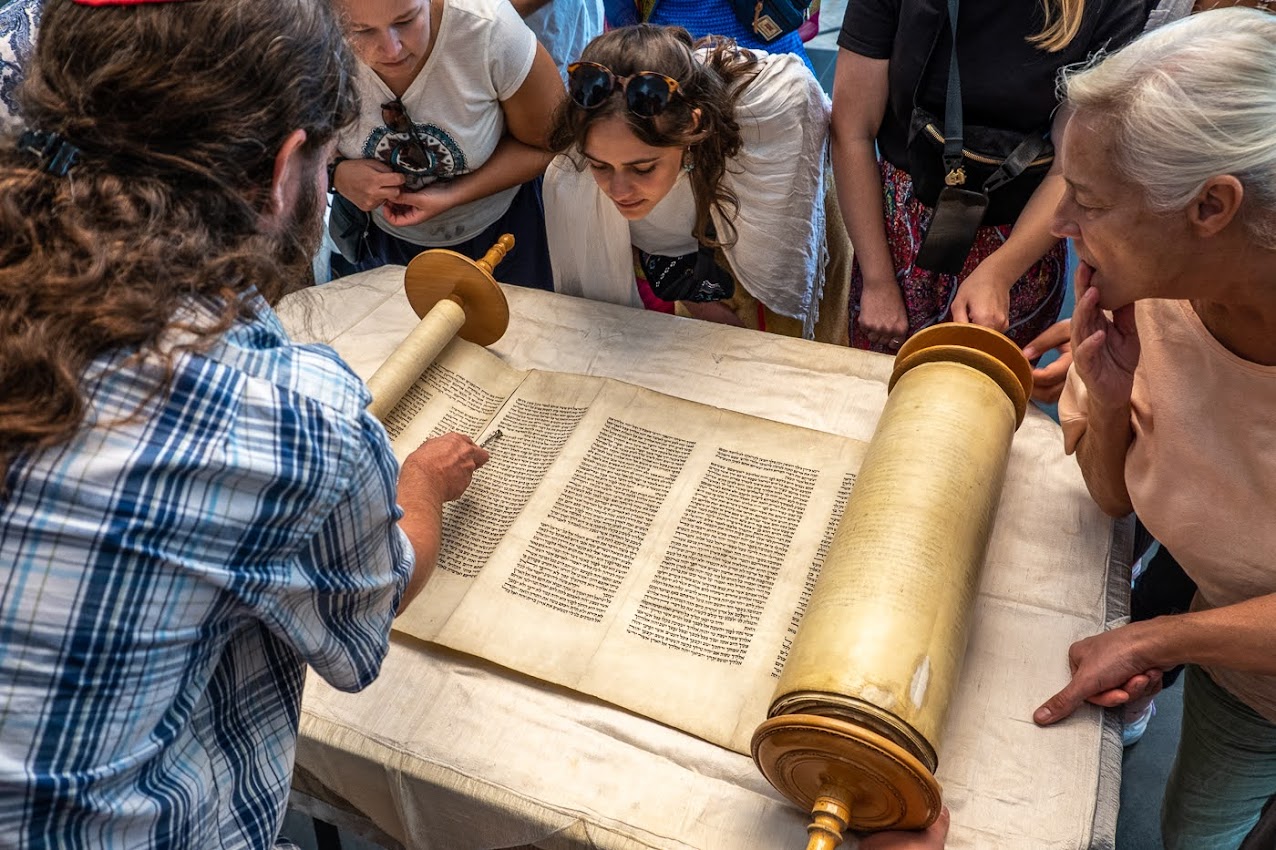
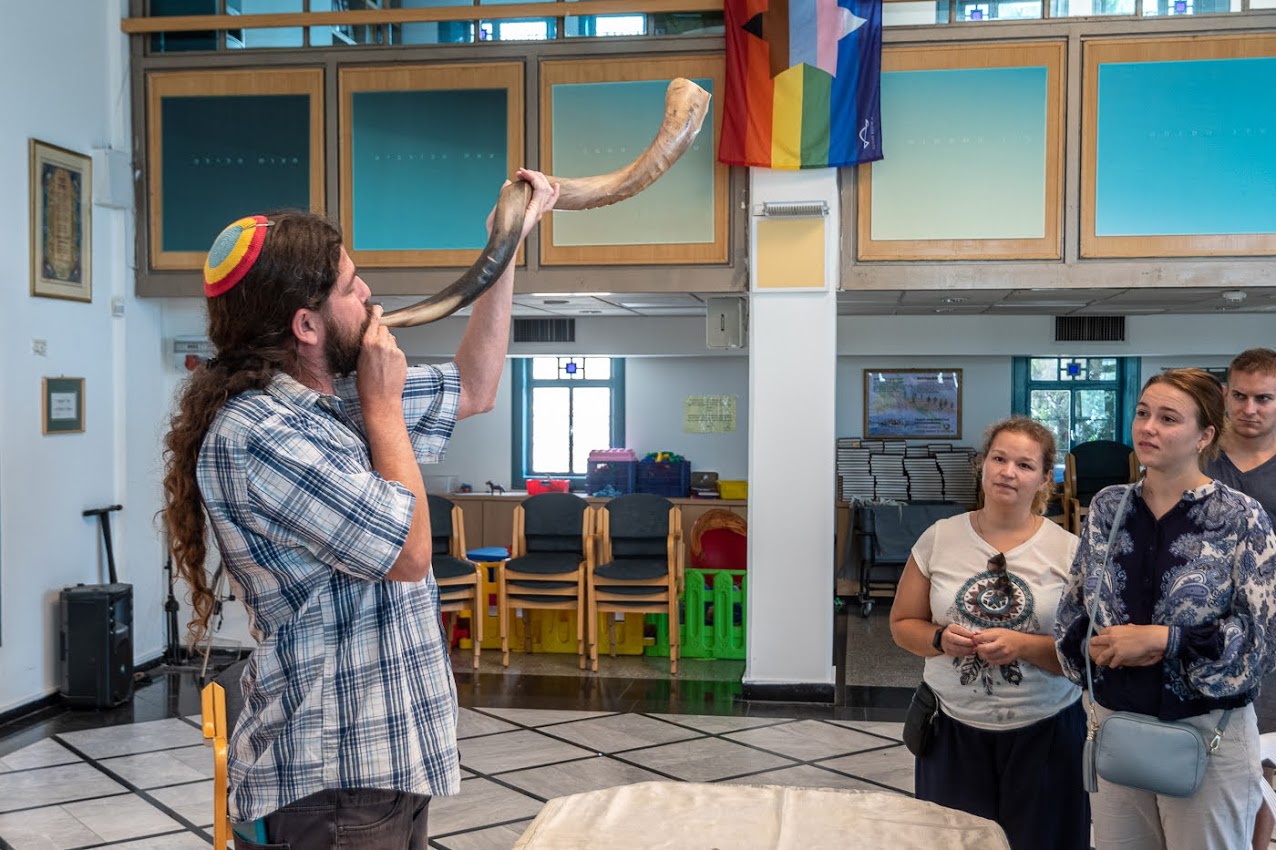
Rabbi Oded explains to us the use of the Torah scroll and Rabbi Oded blows the shofar horn
Edgar then drove us back to the Old City of Jerusalem, which we then explored independently and from where we walked to dinner at the Birgittine Convent. Fortunately, we were able to leave our suitcases in our rooms even during our absence, which lasted several days, since there were only 2 guests there besides us and our rooms remained free. Therefore, most of them took only a few things in the backpack into the minibus, which made the respective departure in the morning much easier.
Day 3: Monday, 3.10.: (Ramallah) – Jerusalem Old City – Bethlehem
Actually, we wanted to drive to Ramallah early in the morning, in order to visit the Al Jalazoon Secondary Girl’s School, which was built in 2007 with German KFW funds, after visiting the tomb of Yassir Arafat and viewing the palace of Palestinian President Abbas from the outside in the refugee camp, where we wanted to complete an approximately 3-hour workshop with the students there.
But because of the raid of Israeli soldiers near the school with 2 Palestinian dead all checkpoints to Ramallah among others were closed, we had to change our program and continued our guided tours through the Old City of Jerusalem among other things with a visit to the Jewish Quarter including the Hurva Synagogue and the remains of the Cardo Maximus from Roman times with the Madaba Mosaic from the 6th century AD, showing the much smaller Jerusalem Old City including the Church of the Holy Sepulchre (without the Temple destroyed in 70 AD) with the original city walls before the construction of the Dome of the Rock and Al Aqsa Mosque, leaving plenty of time to buy souvenirs, explore the Old City independently and visit the Temple Mount again.
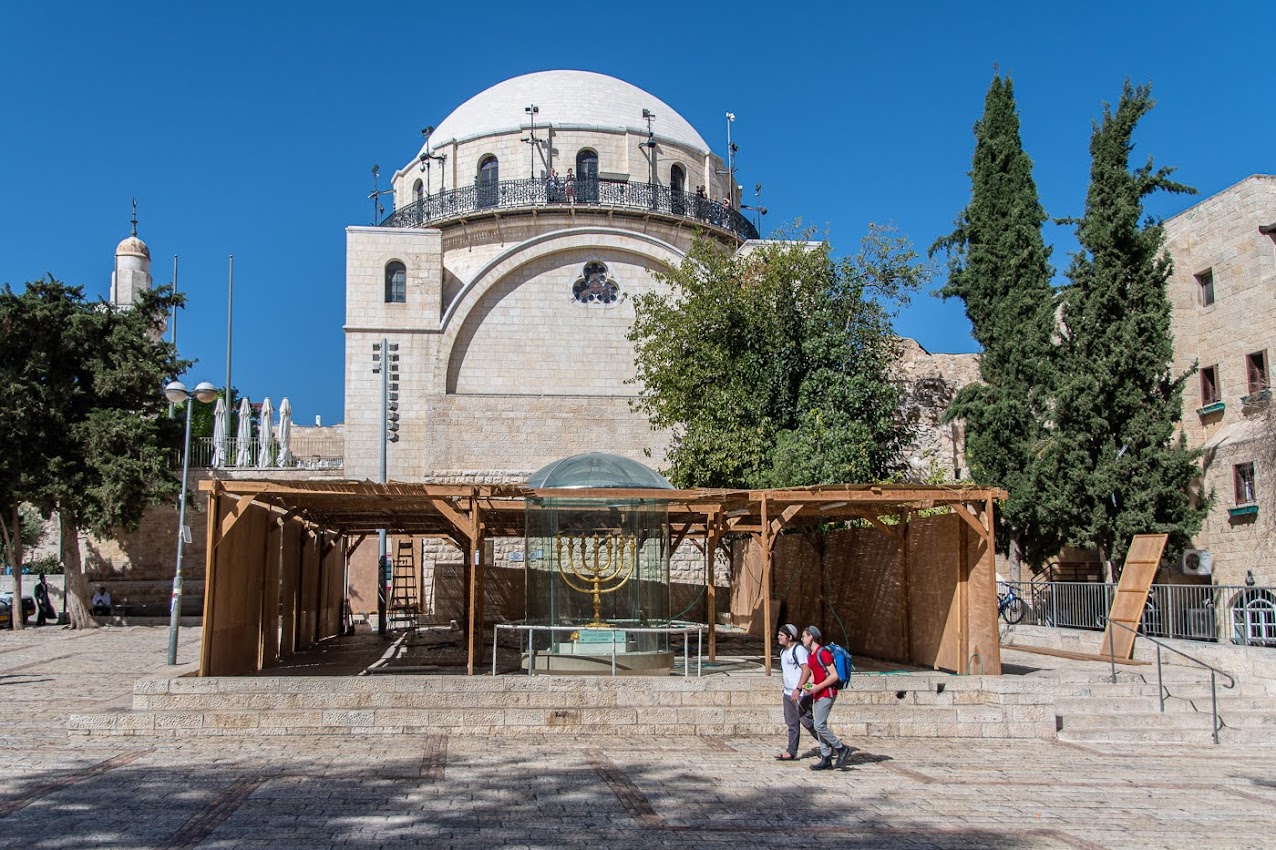

Hurva synagogue in the Jewish quarter and the Cardo Maximus from the Roman period
In the early evening we drove back across the checkpoint to Beit Sahour (German = Shepherd’s Fields, district of Bethlehem) for dinner at the Al Hakoura restaurant. Afterwards Edgar took us to the Talitha Kumi School (TK School) in Beit Jala (also a district of Bethlehem), where our host parents picked us up, with whom our TN then stayed overnight. Roland and I stayed in the large apartment of the German principal Matthias Wolf on the school grounds, our driver Edgar in the guest house next to the school.
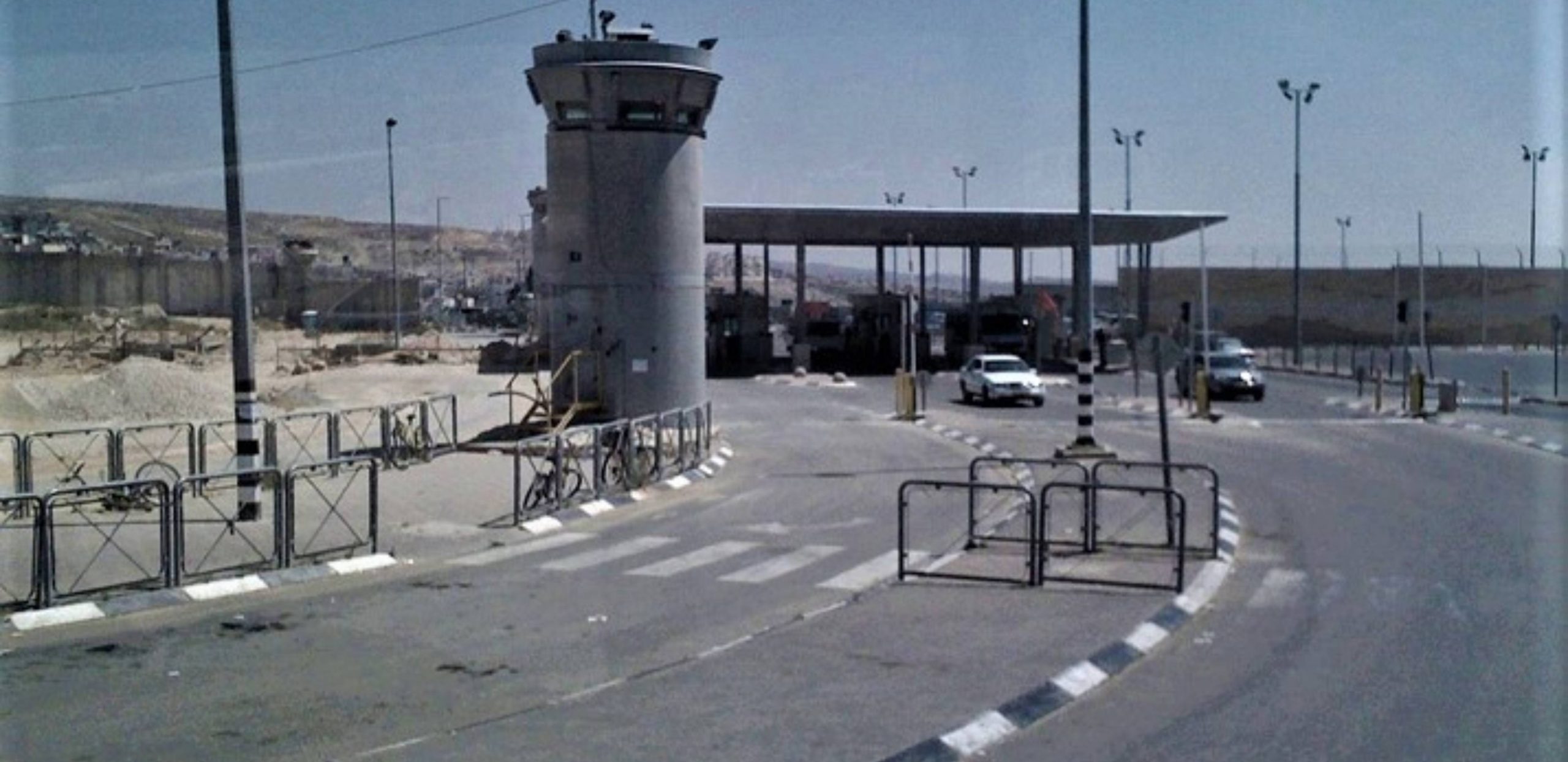
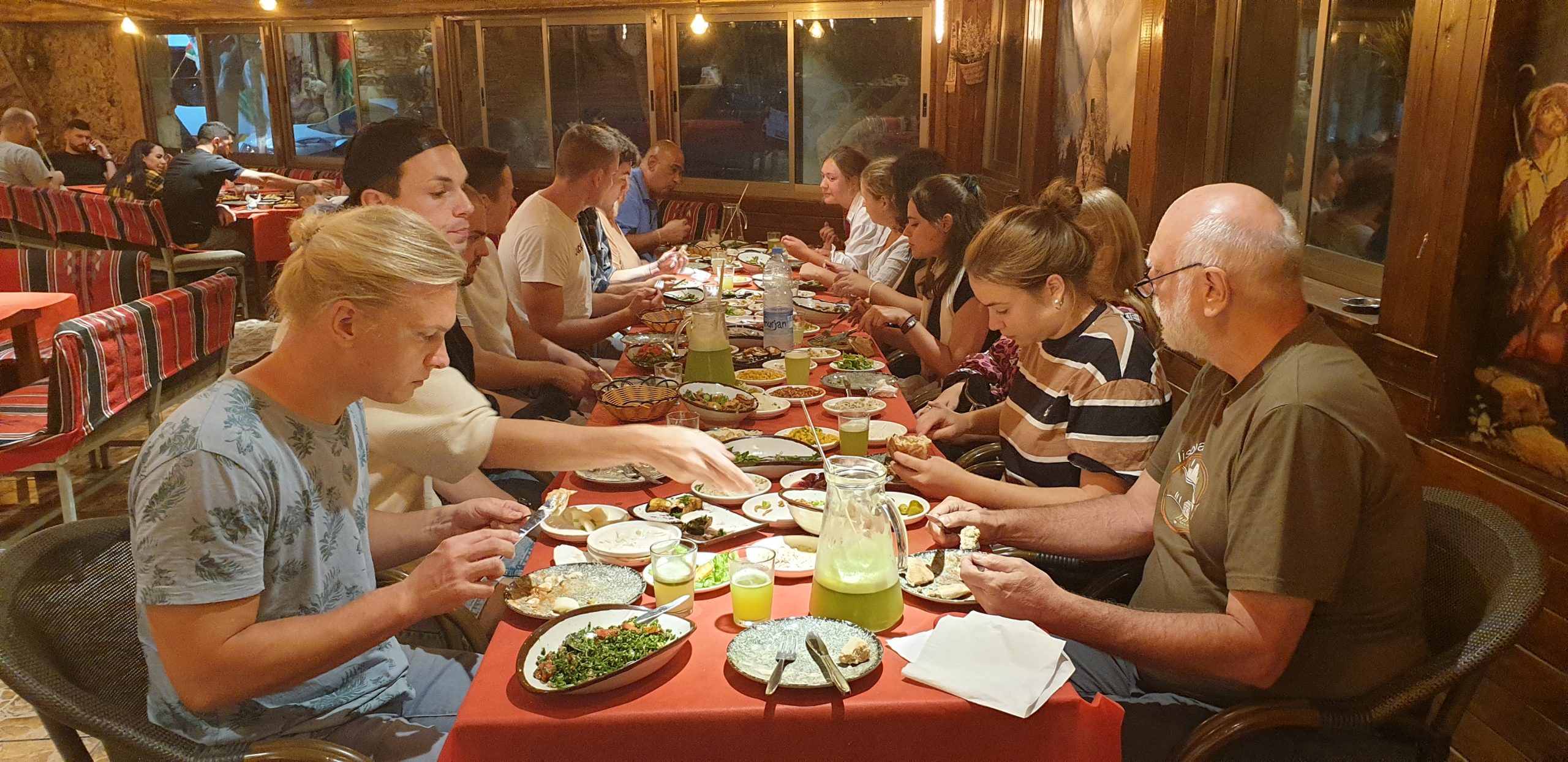
Checkpoint in Bethlehem and Al Hakoura Restaurant in Beit Sahour (Bethlehem)
Talitha Kumi School (TK School)
Founded in 1851 by Kaiserswerth deaconesses and today sponsored by the Berlin Mission, the German Evangelical Lutheran school Talitha-Kumi in Beit Jala near Bethlehem passes on the message of reconciliation and peace in the spirit of the Gospel and offers Christian and Muslim girls and boys a protected space. Here they can learn with each other and develop into self-confident personalities. In 2017, Talitha-Kumi was awarded the “Excellent German School Abroad” seal of approval. It offers the “German Abitur” and also the customary “Tawjihi” as school-leaving qualifications.
There are 135 children enrolled in kindergarten for the 2020/2021 school year. Approximately 700 students attend classes in grades 1-12. 30% of them come from Christian families, 70% from Muslim families. Enrollment is still ongoing for the vocational school (community college), and in the 2019/2020 school year, about 100 students would be trained there in hospitality and food service.
“Talitha Kumi” means “Girl, get up!”. This appeal is still the name, program and mission of the oldest Protestant school in Palestine. It comes from the Gospel of Mark, where it says, “And Jesus took the child by the hand, and said, Talitha Kumi, girl, I say unto thee, arise.” Talitha Kumi School sees all of its educational work as a contribution to overcoming conflict and violence and thus to peace. One of the goals of teaching is to teach tolerance and respect to members of different denominations and religions. The spacious and abundantly planted school grounds provide a protected space in which such work is possible. Talitha-Kumi is also a place where representatives of both sides of the Middle East conflict can meet and get to know each other.
The extracurricular activities include joint devotions, regular workshops on peace education and the training of students as mediators. These mediators learn and practice how to resolve conflicts that arise peacefully. After their training, they mediate in conflicts of their fellow students and carry their skills for peaceful conflict resolution into their social environment as well.
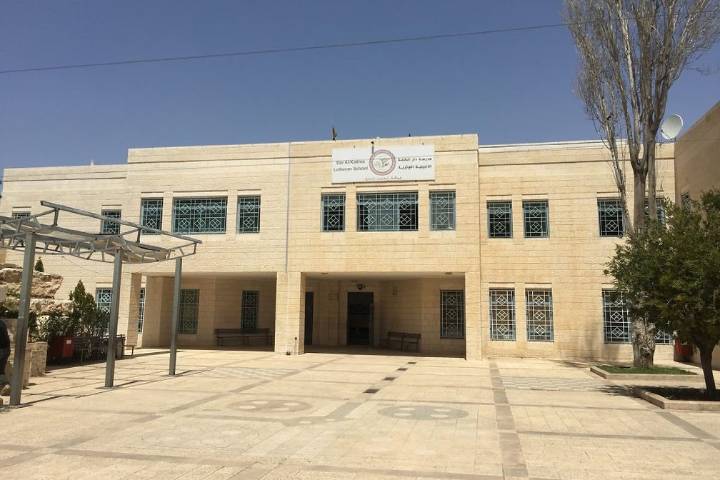
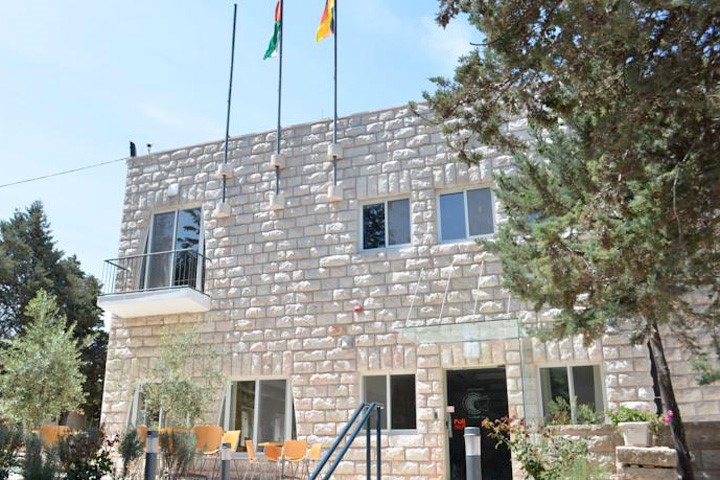
Talitha Kumi School in Beit Jala and Talitha Kumi School Guest House
Day 4: Tuesday, 4.10.: Bethlehem – Neve Daniel – ToN – (Hebron) – Bethlehem
In the morning we gathered for a short religious attunement in the TK church, which is used as a multifunctional space, then there was a short tour of the school for us, before we conducted several successful get-to-know-you games in the church under the leadership of Patrick, before we started our workshop in the art room of the school together with a Palestinian group of students of the same size.
5 groups of 5 workshop participants each were formed and given the following task: After a group brainstorming session, each participant was asked to paint a flat piece of olive wood with a self-selected symbol/image of positive basic values such as peace, justice, equality, community, etc. and glue it on a group poster. On the final day, the respective group should then present their poster.
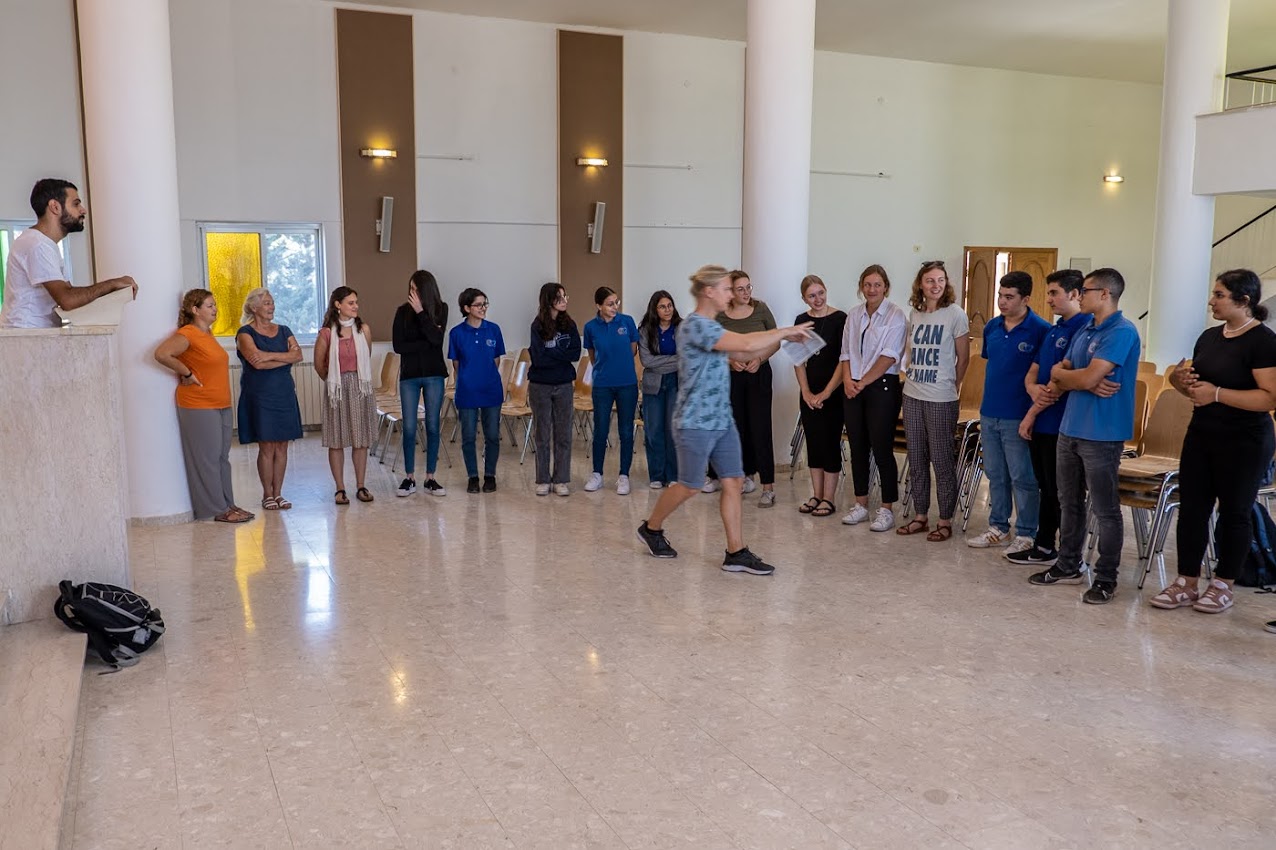
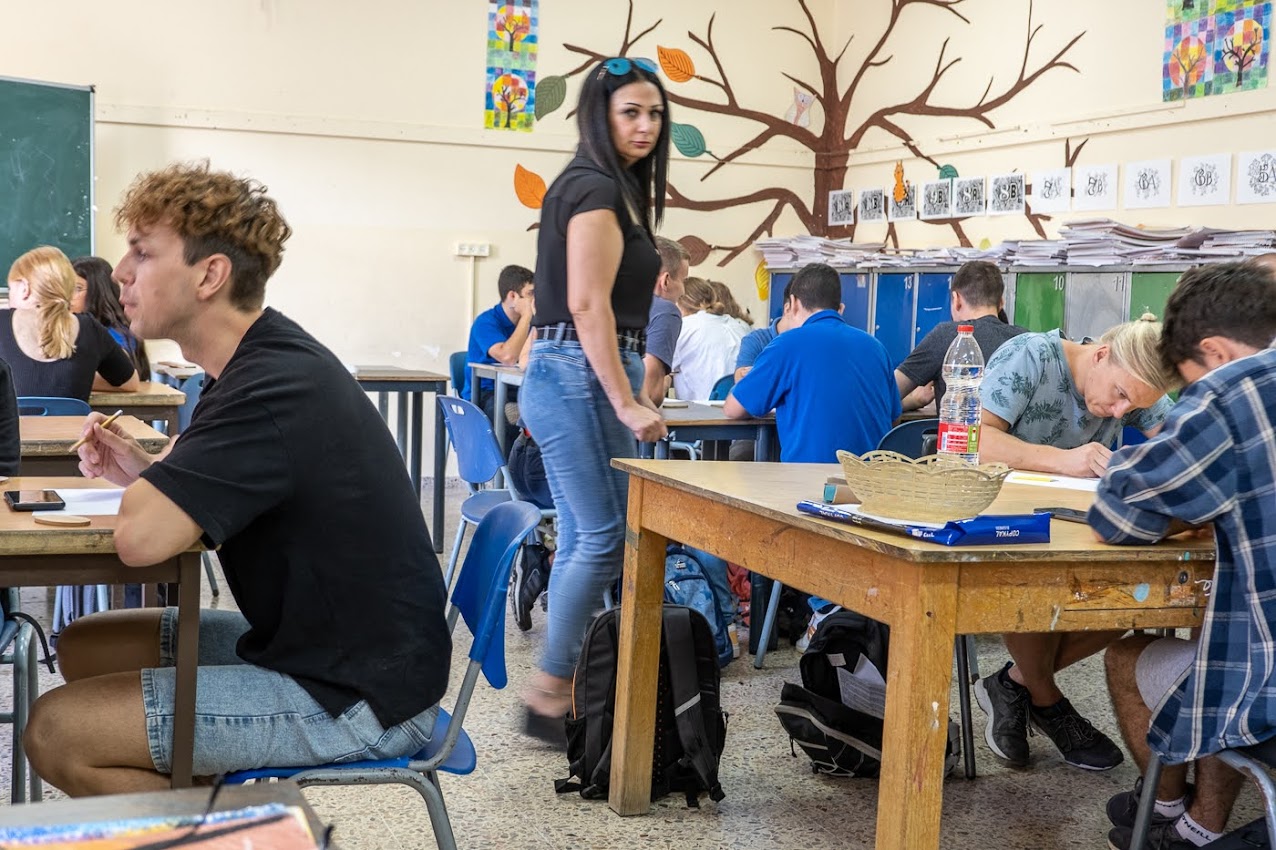
Getting to know each other games led by Patrick and workshop at Talitha-Kumi School
After the workshop ended, we ate a stuffed pita at the guest house and then drove to the Israeli settlement of Neve Daniel, where Nethanel welcomed us very warmly. Nethanel comes from Bonn, married an Israeli woman in the settlement and converted to the Jewish faith, which took several years. He is now an Israeli and an Orthodox Jew who, as a settler, naturally holds certain positions that are still moderate compared to other settlers. He told us a lot about Israeli Jewish history, his biography and life in the settlement. At the end we went to the synagogue, where he also answered our questions willingly. Although we have very different views on some issues, I very much appreciate Nethanel’s openness and reliability. Even if one does not have to share his views by any means, it is important to listen to his quite widespread opinions, because only in this way the insolubility of the Middle East conflict becomes more understandable.
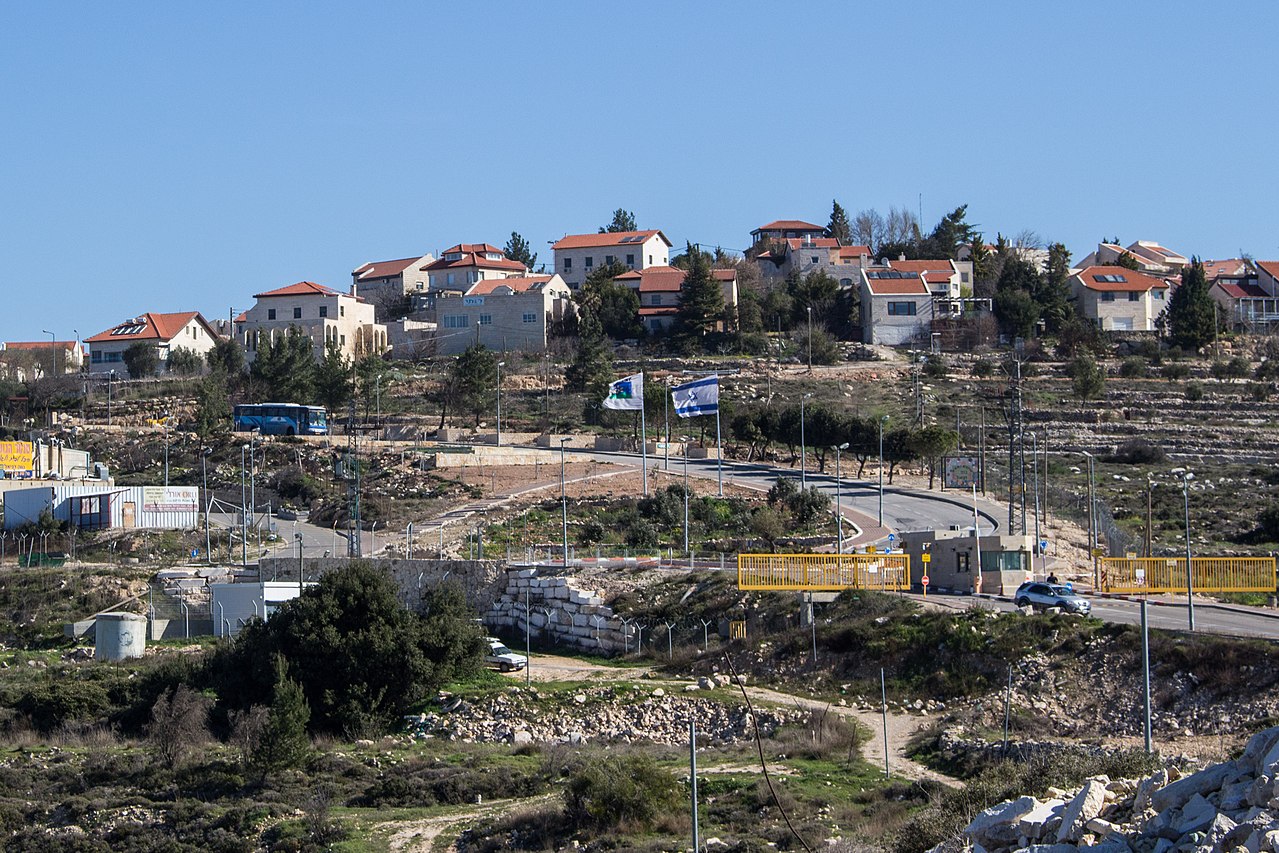
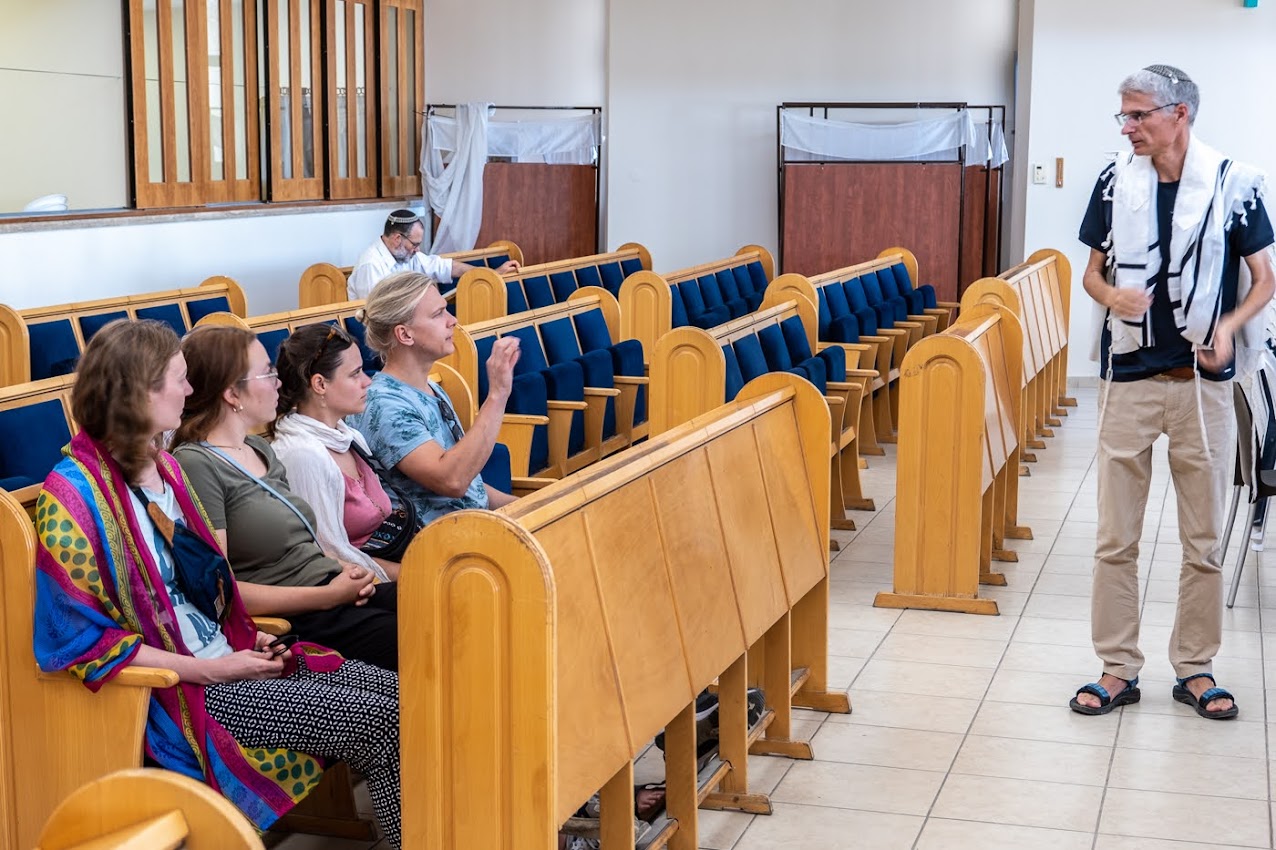
Israeli settlement of Neve Daniel and Nethanel (right) in the synagogue of Neve Daniel.
Afterwards we visited the Tent of Nations (ToN) directly adjacent to Neve Daniel, next to the Torah School, which is surrounded by 5 Jewish settlements. After overcoming the roadblock by the Israeli military (so that Daoud Nassar and the visitors could not get to the ToN by car in a direct way), we arrived at the ToN, where Daoud and later also his older brother Daher (which is also the name of their grandfather, who gave the vineyard (ToN) its original name) welcomed us very warmly.
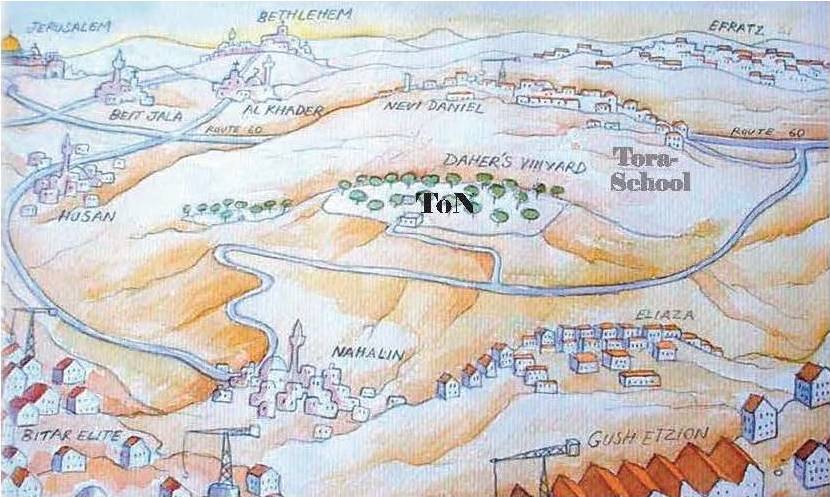
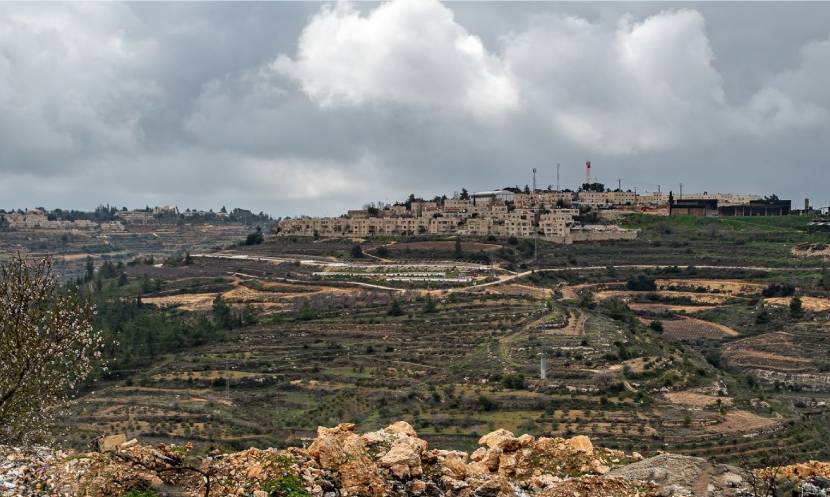
Map with Jewish settlements (top right Neve Daniel, also picture right) below Torah School and the ToN).
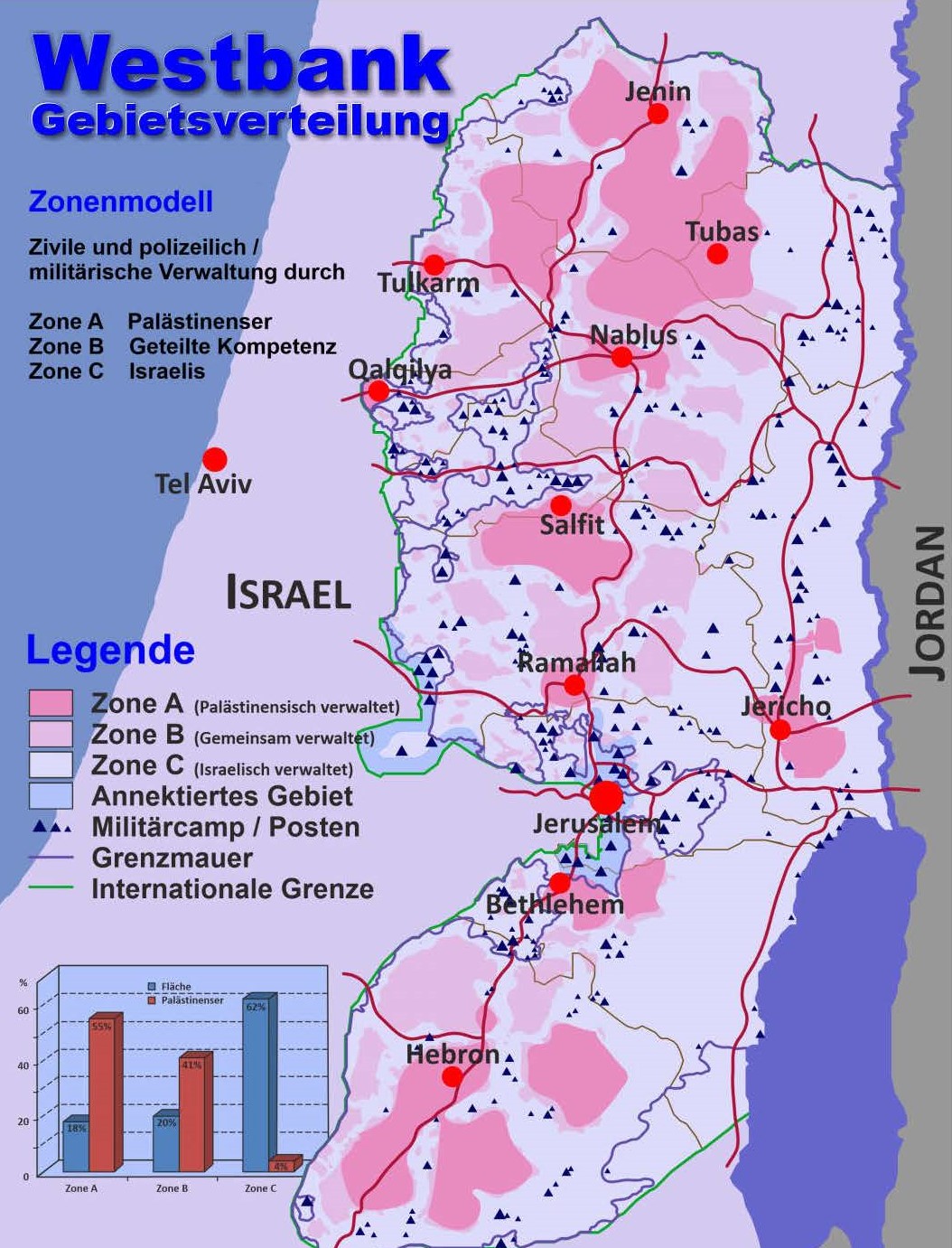
(Free map version from www.geo-ref.net)
Brief information about Palestine:
Palestine is internationally recognized as a state entity by 138 UN member states (72%) and has had observer status at the UN since 2012. It includes the Gaza Strip (360 km², about 2.1 million Palestinians) and the West Bank (about 2.7 million Palestinians), with the Palestinian Authority also claiming East Jerusalem (about 8.4 km² and over 0.3 million Palestinians) as its capital. In the whole of Jerusalem (125 km²) currently live about 0.95 million people. More than 0.75 million Jewish settlers already live in the West Bank and East Jerusalem. These settlements are considered illegal by the International Court of Justice and the UN.
The West Bank has been divided into 3 zones since 1995 (Oslo Accords). Zone A is administered entirely by the Palestinian Authority, which is also allowed to make independent decisions there. In Zone B, such action is possible only with Israeli approval, e.g., for building permits. Zone C is under the exclusive jurisdiction of the Israeli military administration. It accounts for 62% of the West Bank.
Zone A (18%): Under Palestinian self-government.
Zone B (20%): Palestinian self-rule under the control of the Israeli military.
Zone C (62%): Blockaded by the Israeli military and not recognized by the Israeli government as belonging to the Palestinian autonomous areas.
Sources: Wikipedia articles West Bank, Palestine, Gaza Strip, Jewish settlement, etc. (9/9/22) and BpB.
Daoud described in his inimitable charismatic way the history and the situation on the ToN and explained his motto “We refuse to be enemies”, which impressed all TN very much. He then showed us the main venues on the ToN before we said goodbye to him, as we still wanted to visit the Bethlehem Palace of Congress.
JIK particularly supports (with more than 220 T € so far) the Tent of Nations (ToN) Daoud Nassars, who with the slogan “We refuse to be enemies” has been fighting for 32 years in court to preserve his 42 ha land (family owned since 1916). He is not allowed to erect any buildings there, has to live in caves or underground dwellings without water and electricity. Therefore, he collects water in self-dug cisterns & uses solar panels. Countless times the ToN was attacked, over 10 T trees were destroyed, damages of over 150 T € were caused. Several times his life and that of his family were threatened. As Christians, they counter the occupation, the countless destructions and attacks on their lives with peaceableness and charity. There, the EdK-LandArt project (Ø:30m) is created from stones of the surroundings, among others with JIK funds. Work is scheduled to continue from April. The ToN (approx. 13 T visitors annually before Corona) offers the following 10-day work camps from March to November, in addition to children’s and women’s development projects: Tree planting, weeding & wheat harvesting, cave restoration & fruit harvesting, children’s summer camp, almond & fruit harvesting, grape & fig & olive harvesting.
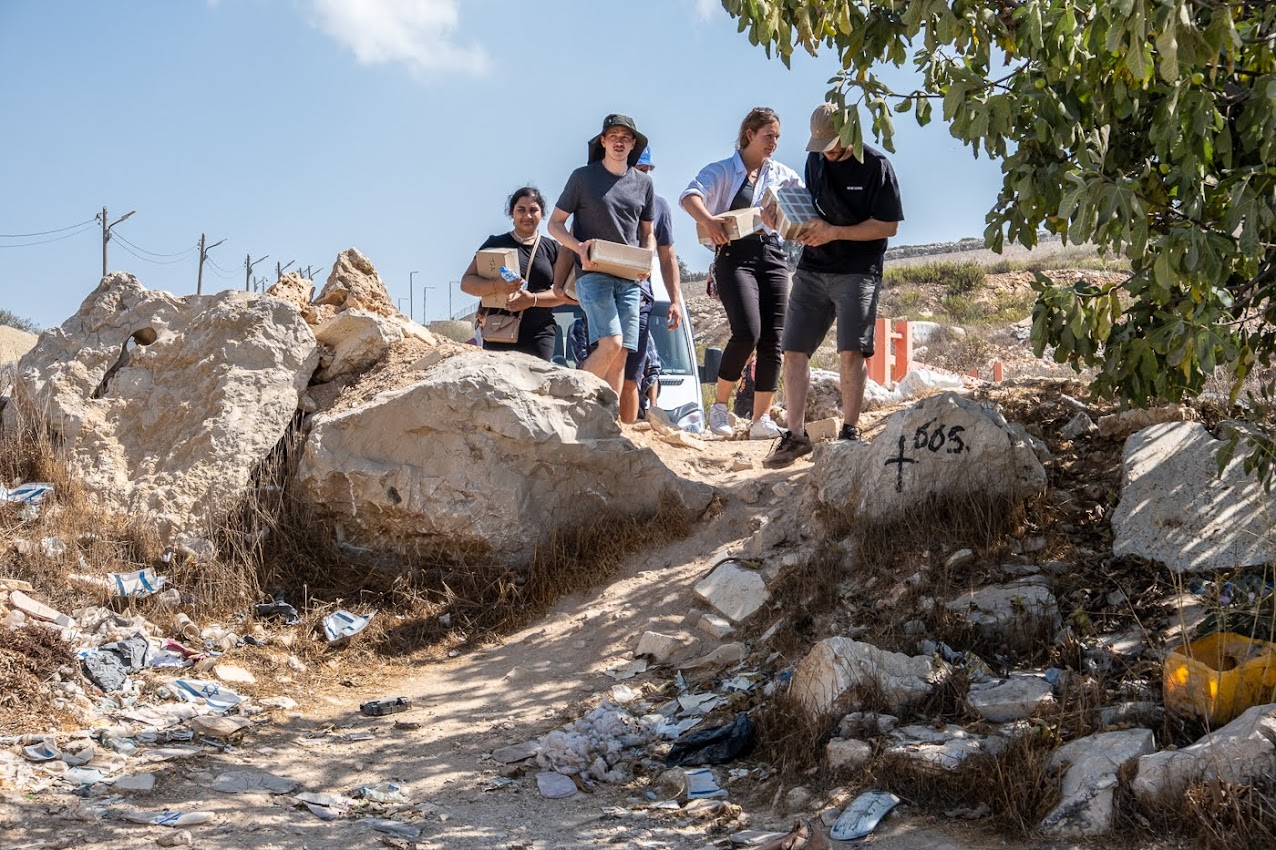
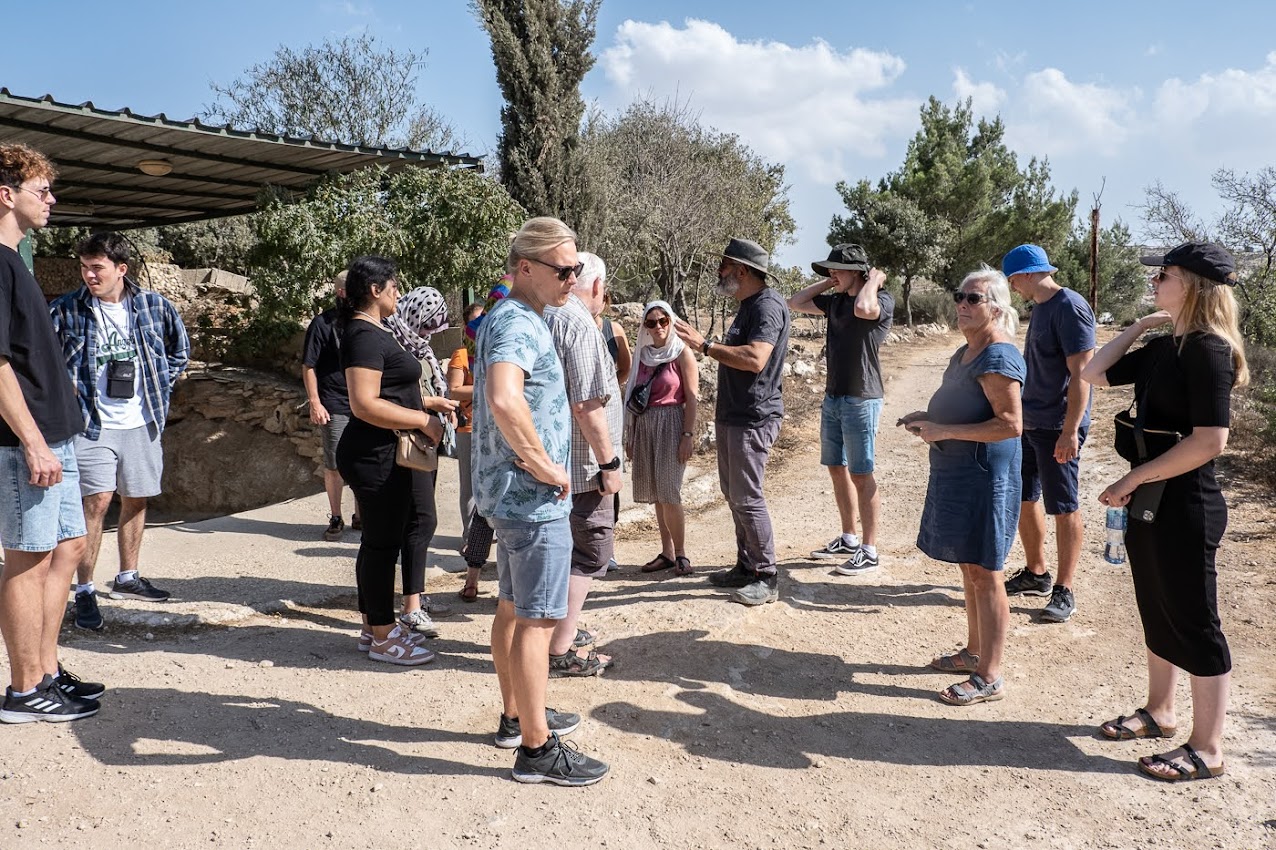
Roadblock blocking the entrance to the ToN and Daoud (in the back with hat) reporting on his work.
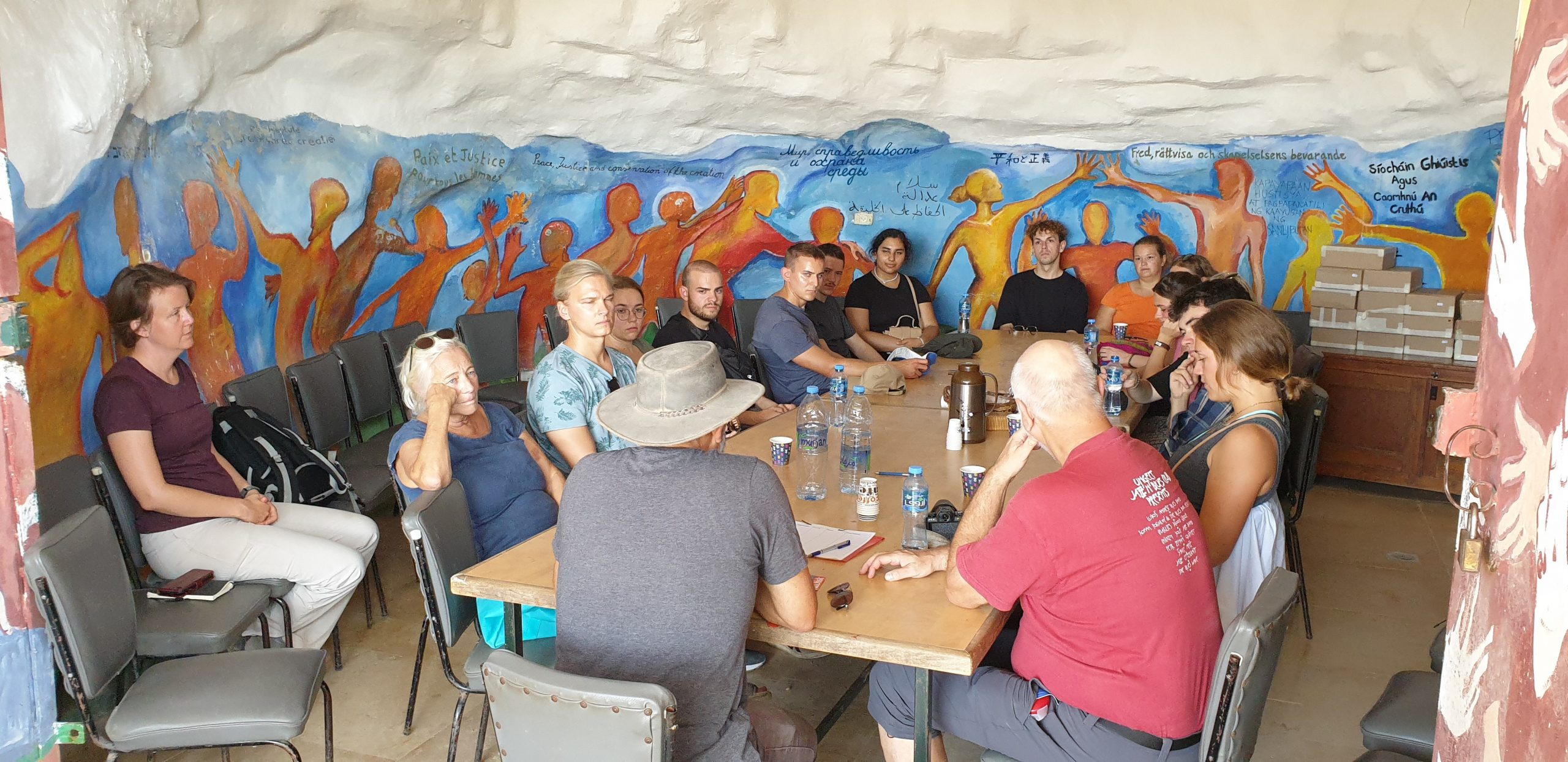

In the underground meeting room with Daoud and garden of all nations on the ToN.
Actually, we wanted to go to Hebron to walk through the – very depressing, because almost deserted – souk in addition to visiting the Abraham’s Mosque. But according to our driver it was already 3 hours before the beginning of Yom Kippur (from 6 p.m.) quite dangerous to drive with the minibus in the vicinity of Jewish settlements because of the absolute driving ban for Israelis, especially since we had to drive through the Jewish settlement Kiryat Arba to get to the Abraham’s Mosque at all, so we drove back to Bethlehem instead (the only place for us to be on the road with a car until the end of the driving ban on Yom Kippur on 5.10. at about 9 p.m., to be on the road with a car). There we visited Syrian Aramaic Palestinian Christian George Bassous, architect and general manager of the Congress Palace in Bethlehem (These Christians still speak Aramaic – the language of Jesus.).
The Convention Palace, a joint investment of the Consolidated Contractors Company “CCC” and the Palestine Investment Fund “PIF”, was one of the projects that were part of Bethlehem’s preparations to welcome the new millennium. The architecture was synchronized with the nearby landmarks such as the “Murad Castle”, the museum and the historic “Solomon Pools”, preserving the historical and archaeological nature of the area. The premises, located on the southern outskirts of Bethlehem, include a huge auditorium, an exhibition gallery, a theater with more than 2,300 seats and state-of-the-art technology, meeting rooms and a cafeteria. The Palace hosts several important local and international events throughout the year and has managed to maintain international standards of hospitality. The area in and around the Palace of Congress welcomed thousands of visitors every year (until 2019) to explore the history and heritage of the place and enjoy the interesting mix of events and activities, especially the programs held in the summer. The Castle Museum houses one of the largest ethnographic collections of Palestinian history and culture.
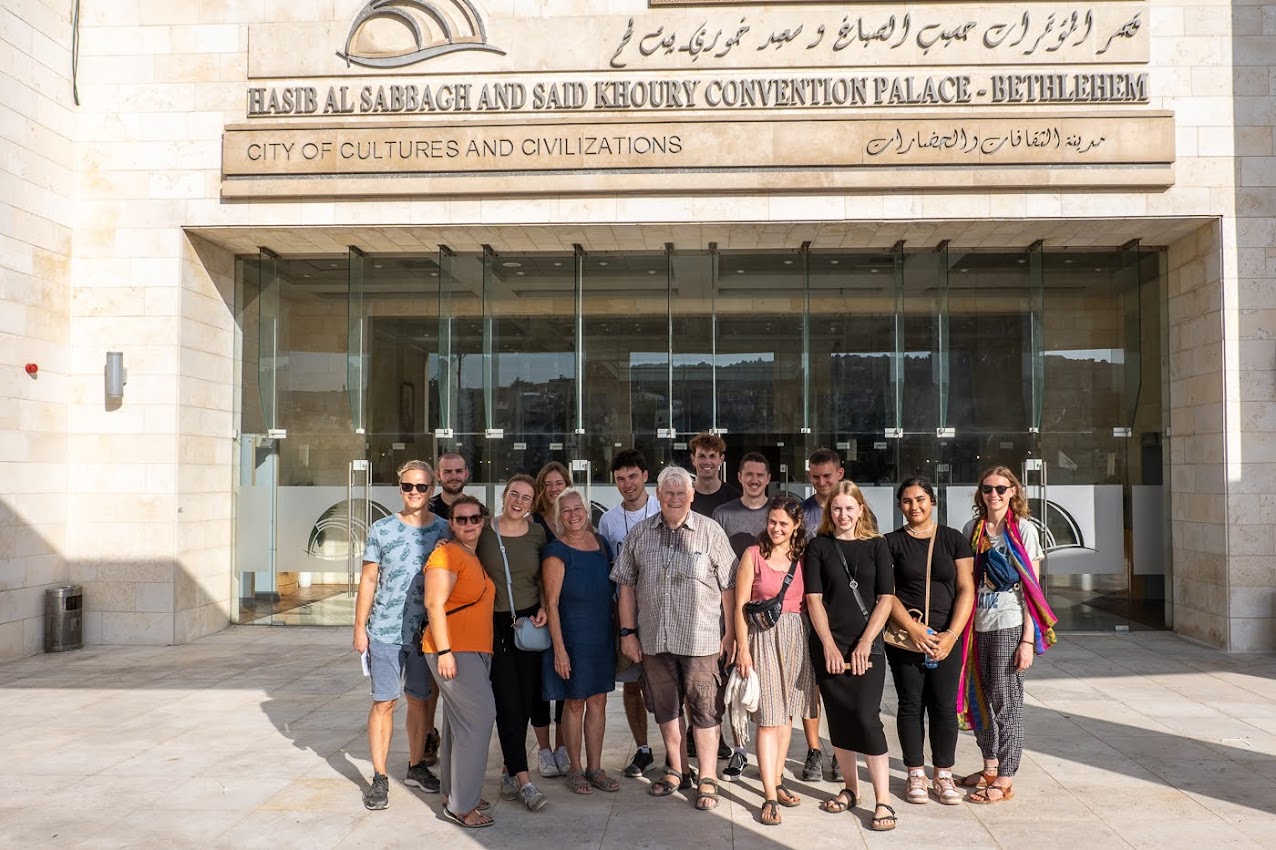
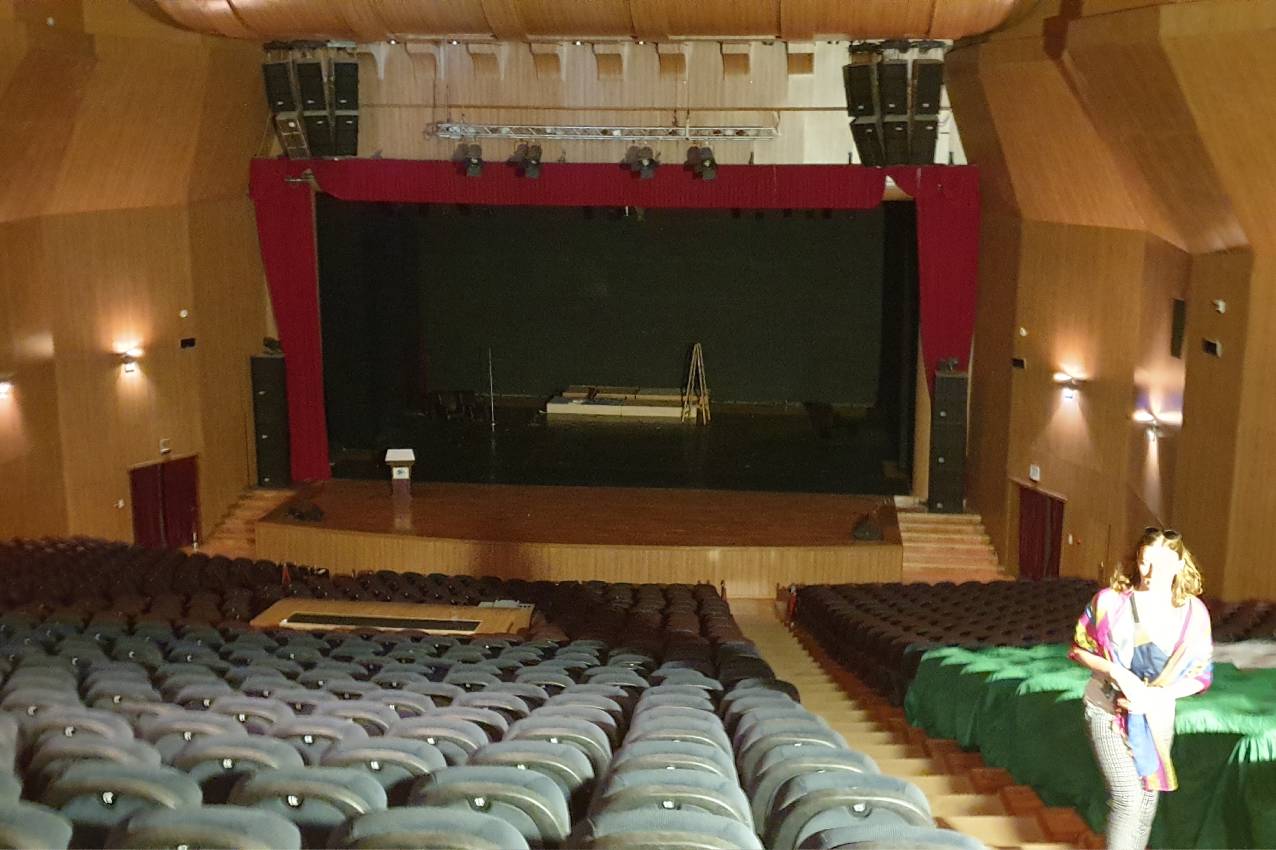
Congress Palace in Bethlehem and Theater at the Congress Palace
First, we were welcomed by his assistant, who took us through the exhibition on the history and activities of the Congress Palace “City of Cultures and Civilizations” and showed us the large theater with 2,300 seats and impressive stage technology. (Even Bonn does not have such a theater!!!). Just before the end of our visit, George did arrive, having been delayed due to a funeral.
Afterwards, we went back to Al Hakoura Restaurant for dinner and from there to TK School where our TN were picked up by their host families. Roland and I had Tony Nassar (the younger brother of Daoud Nassar) drive us to his family where we spent a very nice evening. Afterwards, Tony brought us back to the TK school, where we stayed overnight with the principal Matthias Wolf.
Day 5: Wednesday, 5.10.: Bethlehem
In the morning, several of us visited one lesson each before we talked to the principal Matthias Wolf, who introduced the TK-School as an excellent German school abroad. After that, we continued the workshop at the TK school. After the snack in the guesthouse we drove to the university in Bethlehem, where the new German volunteer Sofie welcomed us very warmly. After a short tour of the university, we watched a film about the history and present of the university before having interesting conversations with 2 students about their biographical background, their studies, their current situation and their plans for the future, even though the university business was dormant because, among other things, the students from East Jerusalem could not come to Bethlehem because of the driving ban on Yom Kippur.
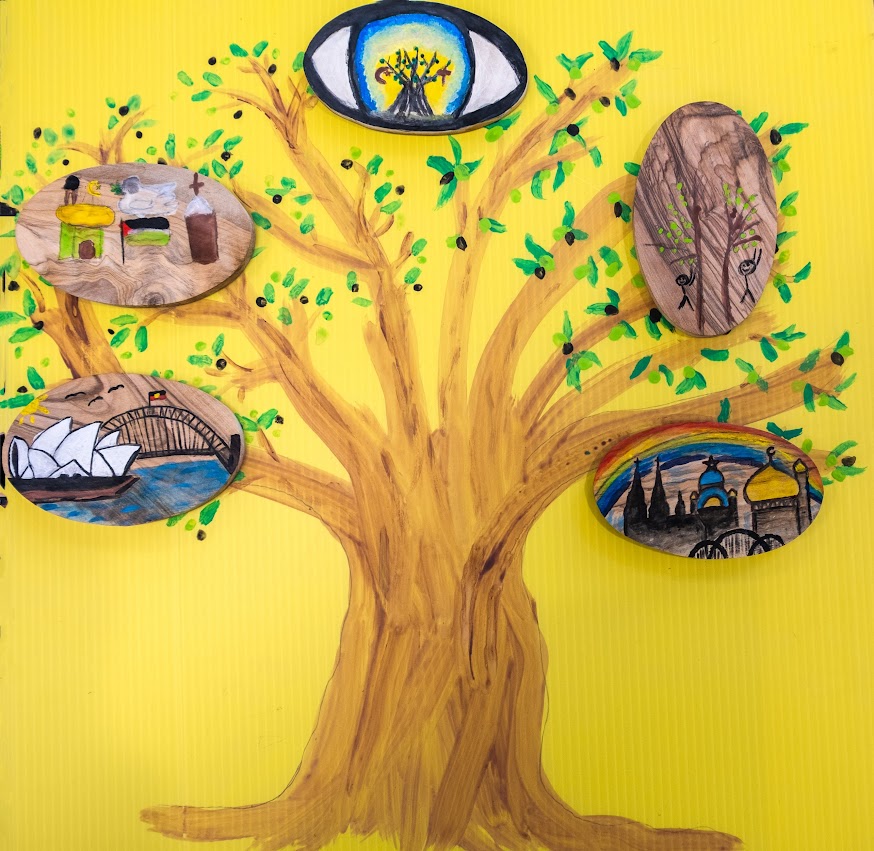
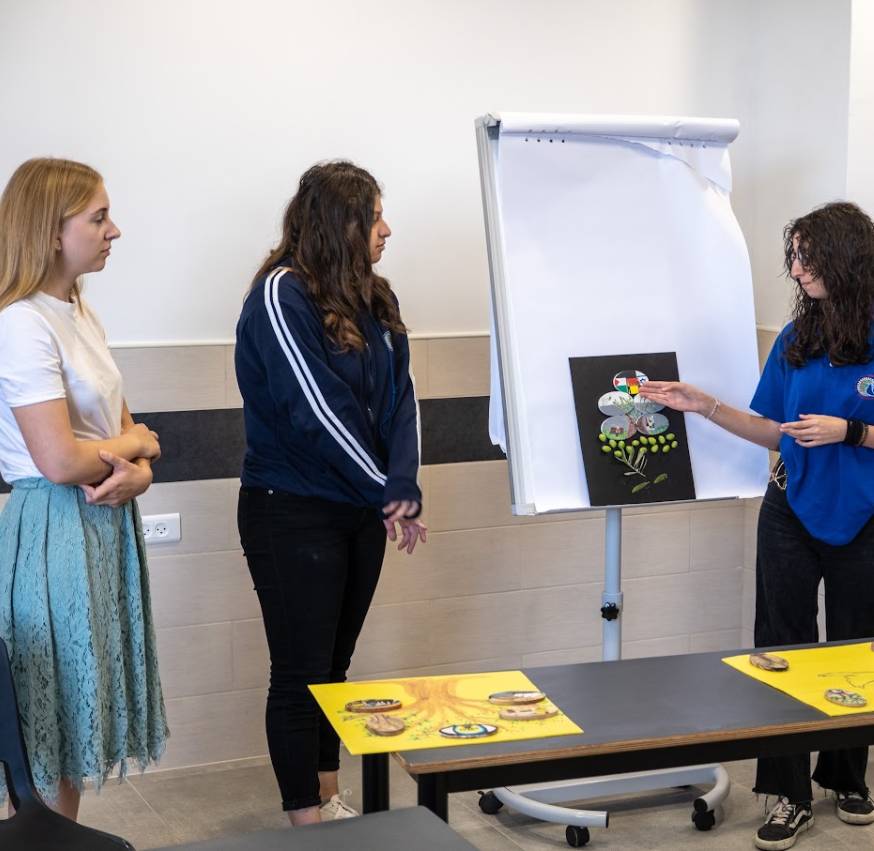
Workshop at the TK School and final presentation of one of the 5 groups (see below, Day 6).
Bethlehem University (BU) – a university sponsored by the Catholic Church and located in Bethlehem, West Bank, Palestine – opened in 1973, making it the oldest university in the West Bank. The Holy See entrusted the management of the university to the De La Salle Christian School Brothers, who still run the university today. To meet the demands of the growing student population, BU was expanded to include the Library (1978), the Faculty of Science Annex (1980), the Auditorium and Dining Hall Building (1990), the Institute for Community Partnership/ICP (1991), “Bethlehem Hall” for the Faculties of Nursing and Education (1995), Turathuna: Center for Palestinian Heritage (2000), and “Millennium Hall” for the Faculties of Humanities and Business Administration (2002). In 2011, a new building for educational sciences was opened.
At the beginning of the 2017/2018 academic year, there were 3308 students enrolled, of which 77.2% were women. There are several reasons for this high percentage of female students:
– The fields of study offered at Bethlehem University are more likely to be taken by women.
– Men get permission from their families to study abroad more easily.
– Many young men work after graduating from school in order to be able to support their families.
– More men are imprisoned in Israeli prisons than women.
Although the university is Catholic, there are 76% Muslims and only 24% Christians. This figure is comparatively high given less than 1% Christians in all of Palestine. Interfaith dialogue and the peaceful coexistence of religions are among the key points of BU’s mission. A large proportion of students come from the eastern parts of Jerusalem (46.2%) or the Bethlehem region (44.3%). Another 7.7% come to the university from Hebron. As of August 2017, 17,197 students have received their degree from BU.
With a total of over 420 employees (approximately 50% faculty), Bethlehem University is the largest employer in the region. Bethlehem University offers 21 bachelor’s and four master’s degree programs.
Unlike many other universities, BU relies on donations to fund 2/3 of its day-to-day operations. This comes from the discrepancy between actual tuition costs and student fees adjusted for family economic strength.
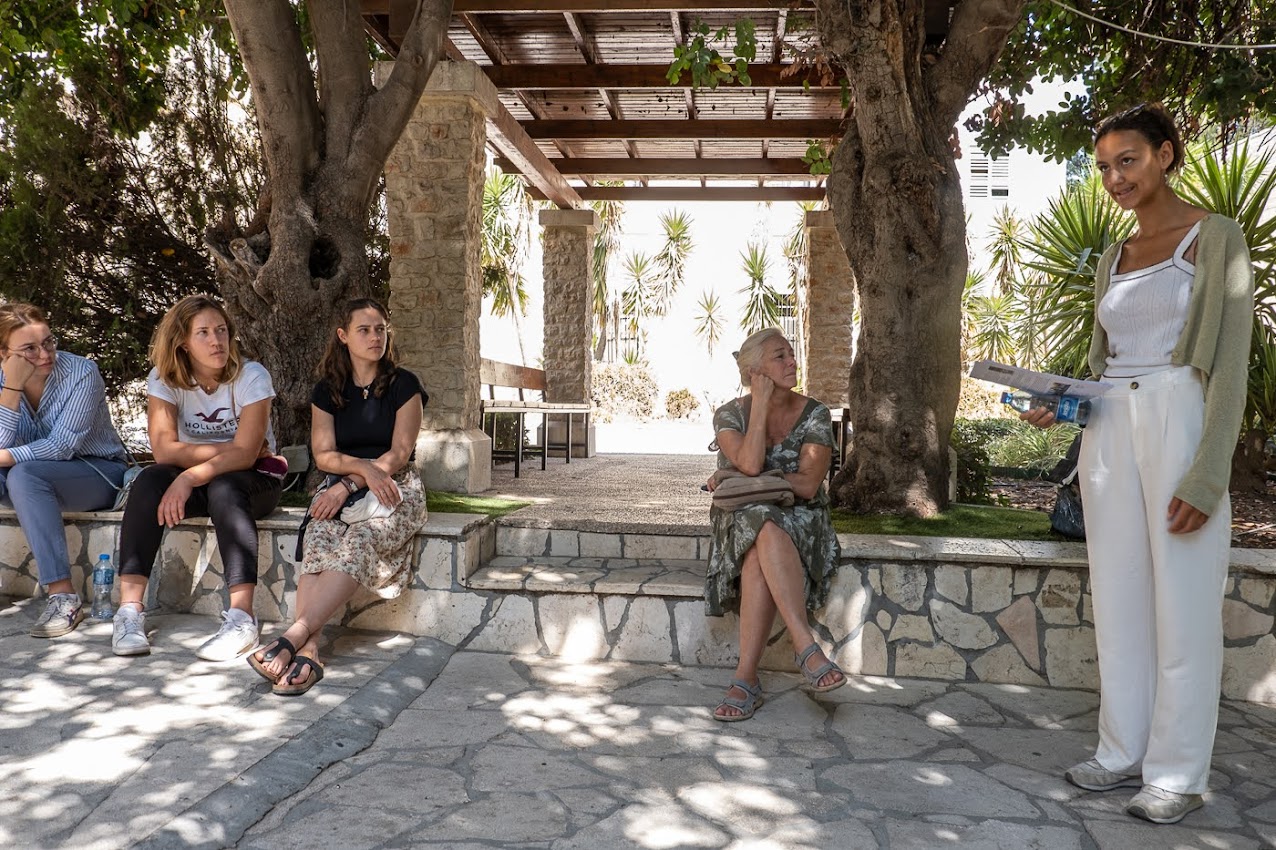
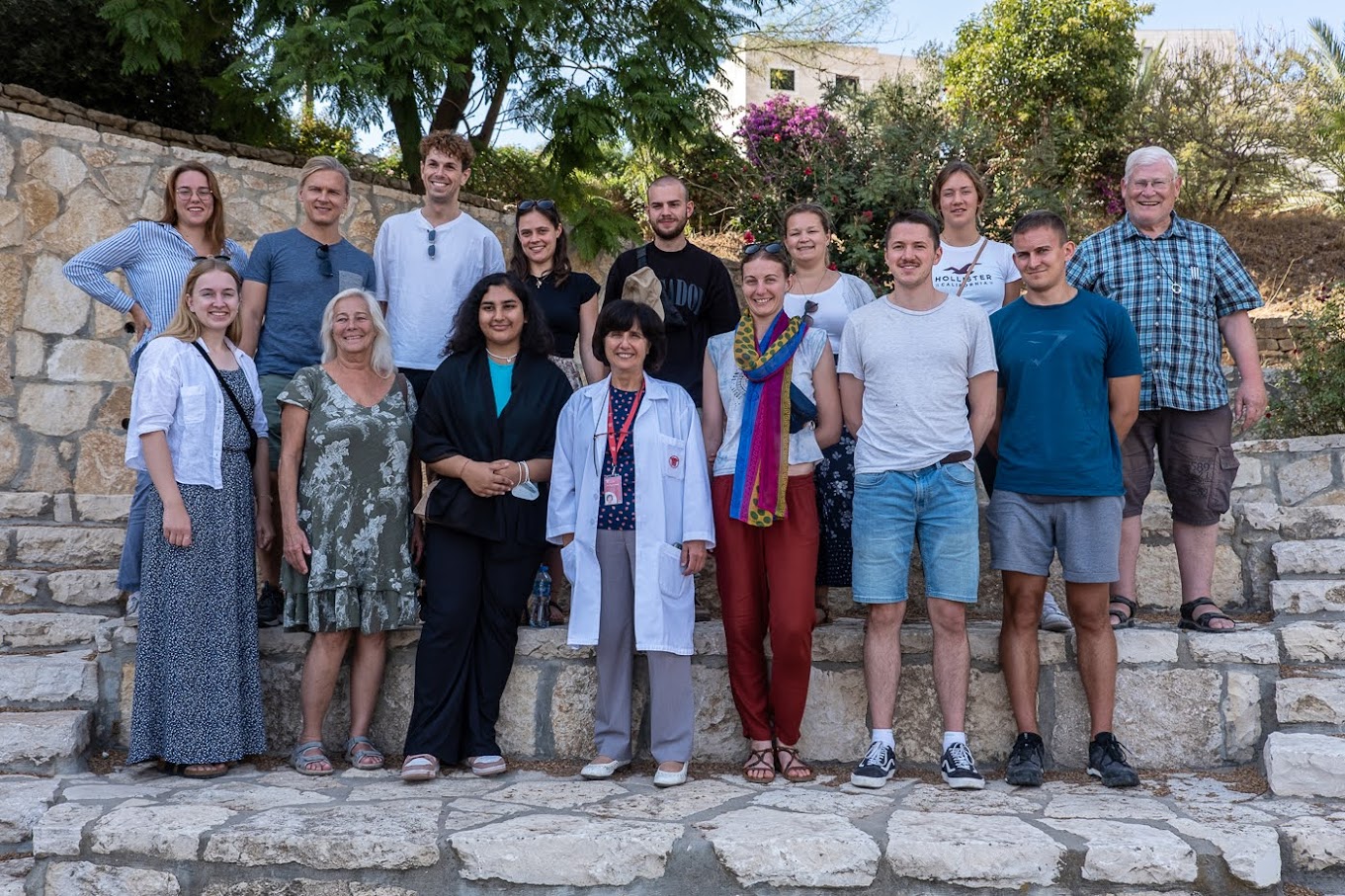
University of Bethlehem: German volunteer Sofie on the right and Caritas Baby Hospital: Dr. Marzouqa in the front center.
Afterwards we drove to the Caritas Baby Hospital, where we talked to the chief physician Dr. Marzouqa about the work of the hospital. She speaks German very well, as she studied in Germany. Very moving, authentic and competent, she reported about her difficult work in this hospital (financed by donations), which treats children up to the age of 18 free of charge, if the families cannot afford the money for the treatment, as there are no statutory health insurance funds like in our country. Their staff also advise families on contraception, among other things, and also educate them about widespread inherited damage as a result of the frequent marriage of cousins to cousins.
She herself does not believe in a solution to the Middle East conflict and can only continue her work, which is especially psychologically very stressful, by, for example, consciously not looking at the Bethlehem Wall in the mornings and evenings, which stands directly across the street from the hospital.
Israel refers to a 759-kilometer-long barrier along the border line between Israel and the West Bank as the barrier. Most of the fence runs through the territory of the West Bank. Construction began in 2002 to curb suicide bombings in Israel’s heartland. It is more than questionable whether its decline is due to this wall construction. In 2004, the International Court of Justice declared that Israel was violating international law by building the facilities. Construction would have to be stopped immediately, property confiscated for construction would have to be returned, or those expropriated would have to be compensated in some other way. According to critics, the plant represents a severe disruption to Palestinians. In some cases, he said, it cuts off villages and towns from their fields and wells, threatening to destroy the economic base of farmers. In addition, the construction would result in the destruction of agricultural land. The majority of the barrier (at least 700 kilometers) will be constructed as a heavily secured metal fence with barbed wire, a ditch, a fence with motion detectors, a raked sand strip for tracking footprints, an asphalt patrol path, and more barbed wire on the Israeli side. On both sides of the fence, a military restricted area with a total width of 70 meters will be erected, which will be additionally monitored visually by observation posts. In small parts, near Qalqiliya and Jerusalem (totaling at least 25 kilometers), where this width cannot be maintained, a wall of reinforced concrete up to eight meters high will be built. Parts of this wall were built by Palestinian workers from Hebron, among others. Gate systems exist at irregular intervals.
Approximately 20% of the installations run along the Green Line, the armistice line between Israel and the West Bank in 1949, which delimited the territory controlled by Israel until the Six-Day War in 1967; in approximately 80% they deviate from this line, running almost exclusively within the West Bank.
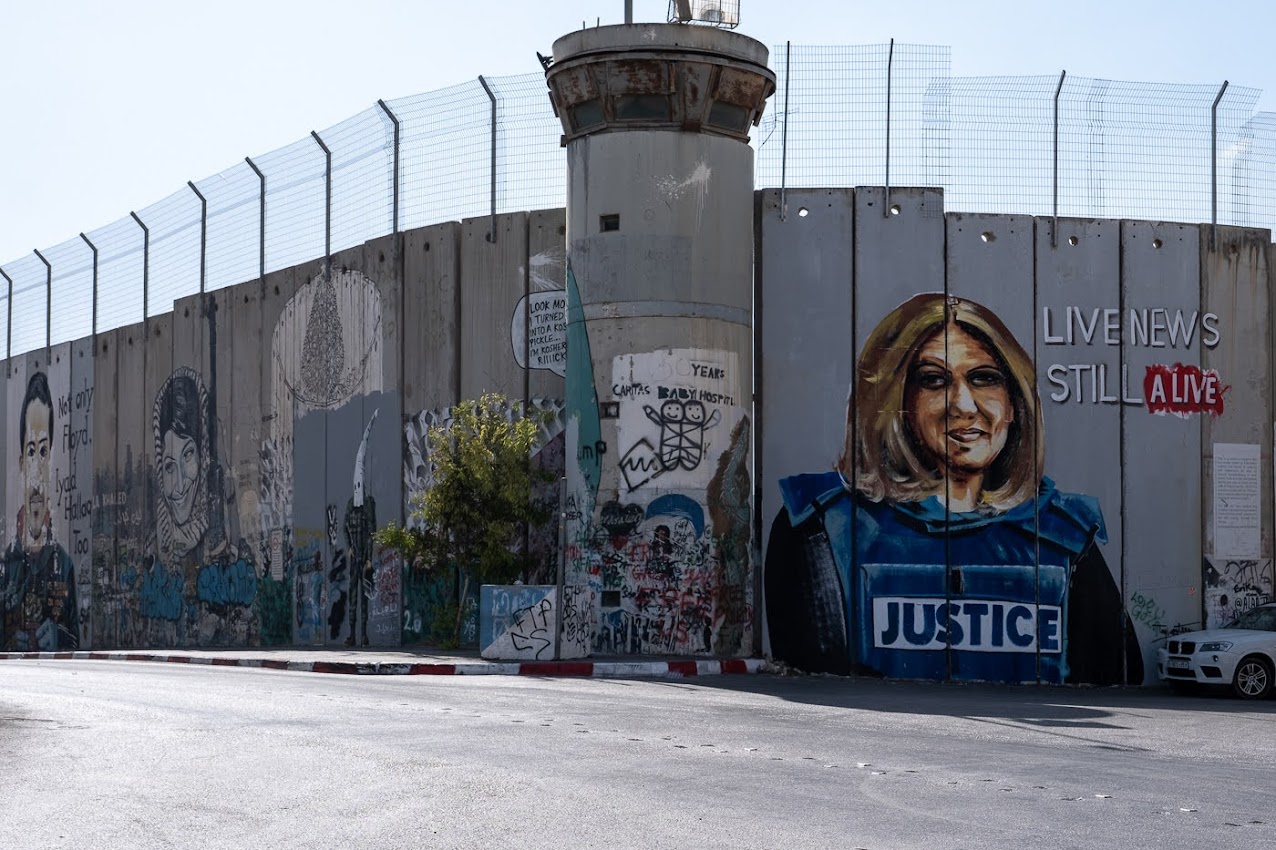
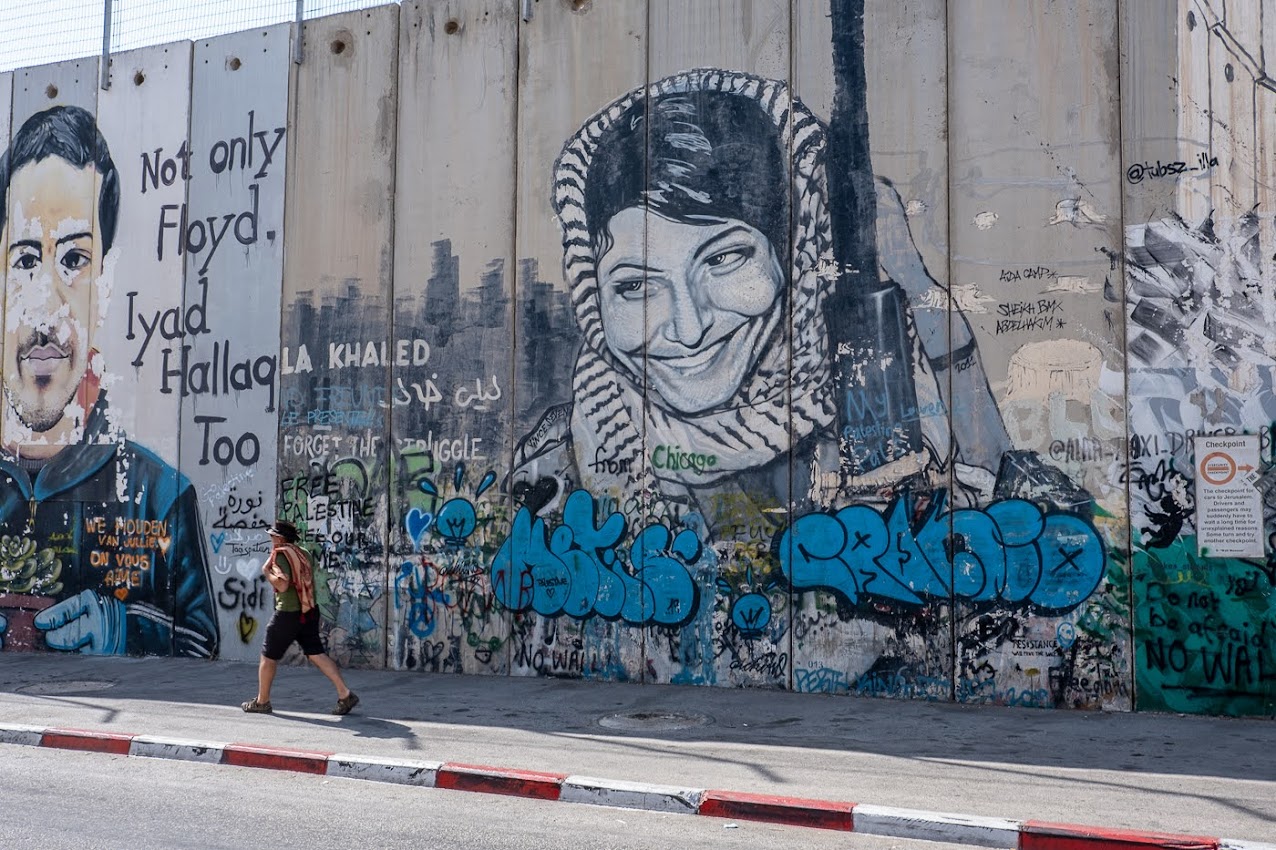
The wall in Bethlehem
After visiting the wall with some new and current graffiti, Edgar drove us to the vicinity of the Church of the Nativity, where we could visit the Grotto of the Nativity after a rather short waiting time due to the lack of mass tourism. Unfortunately, the neighboring and worth seeing cave was closed, in which St. Francis of Assisi was buried. Jerome really lived for a while and translated the Bible into Latin from 385 AD, which as the Vulgate was long considered the authoritative translation of the Bible.
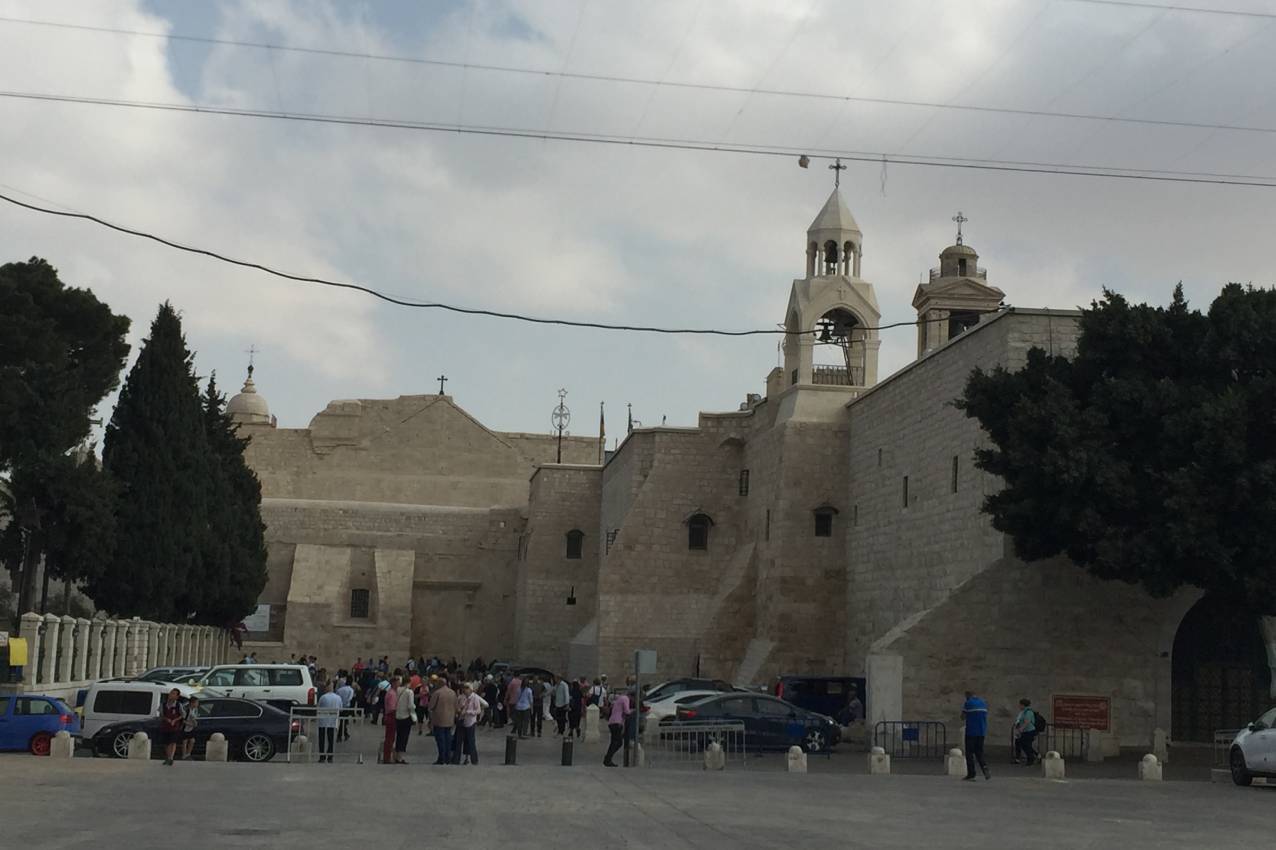
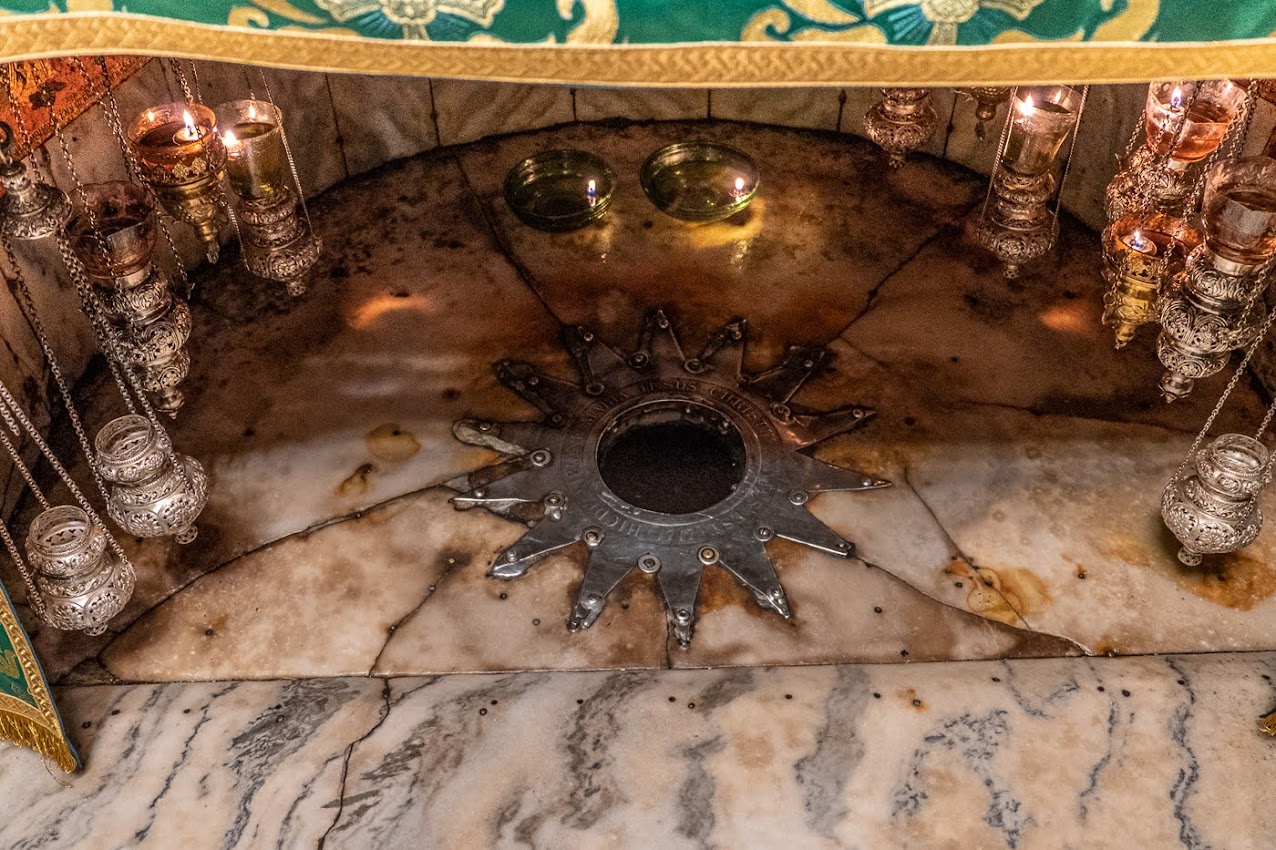
Church of the Nativity in Bethlehem and Star in the Grotto of the Nativity
The Church of the Nativity is the church in Bethlehem built over the presumed birthplace of Jesus Christ. The Church of the Nativity is one of the few completely preserved early Christian church buildings. The cave, which Christians consider the birthplace of Jesus, was built from the 2nd century. worshipped Emperor Hadrian allegedly erected an Adonis sanctuary over it in 135, probably also to stop Jesus worship again. Emperor Constantine the Great and his mother Helena had a memorial church with rich mosaic floors built at the birthplace, which they dedicated to Jesus Christ before 335. The building was a five-nave, 27-meter basilica with an atrium in front to the west and a polygonal apse to the east. The apse was 17 meters wide and had a four-meter-wide opening in the center that provided a view of the Grotto of the Nativity. In 386 Jerome settled in Bethlehem, where he completed his Latin translation of the Bible, Vulgate. The Constantinian basilica was built in the 2nd half of the 5th century. completely rebuilt with a western narthex. The Crusaders restored the church from the ground up (1161-1169).
Under the Turks, the church increasingly deteriorated. In 1670 the Greek Orthodox Church began to renovate the church. At the presumed place of birth in the Grotto of the Nativity, exactly on the central axis of the basilica, a silver star with the Latin inscription “Hic de virgine Maria Jesus Christus natus est” (Here was born of the Virgin Mary Jesus Christ) was placed by the Roman Catholic Church in 1717. Its 14 prongs symbolize the 14 genders in Jesus’ family tree.
After severe damage by an earthquake (1927), the British Mandate Administration and later the Franciscans had excavations and restorations carried out. During the 2nd Intifada in 2002, a 39-day siege of the site by the Israeli military occurred after 40 armed Palestinian fighters took refuge in the Church of the Nativity and entrenched themselves there. In addition, about 160 other people (including 60 priests, monks and nuns) were trapped on the church complex. The fire changes destroyed some windows; adjacent buildings sustained major damage.
Nazareth as the most probable birthplace of Jesus
However, the newer theological-historical research holds with a large majority Nazareth for the birthplace of Jesus, because of the 4 gospels only the gospel of Luke (written more than 50 years after Jesus’ death) mentions Bethlehem as the birthplace, because for the fulfillment of the Old Testament prophecy the Messiah had to come from the city of David (= Bethlehem). In the tax estimate of Quirinus mentioned by Luke – as in other tax estimates in the Roman Empire – by no means everyone had to move to their hometown (in this case Joseph with Mary to Bethlehem), which would have been a logistical nightmare. Also, the tax estimate of Quirinus mentioned by Luke falls in the year 6/7 of our era, that is, about 12 years after the actual birth of Jesus at the time of King Herod. Furthermore, the NT always speaks of Jesus from Nazareth.
Therefore we visited the Milk Grotto, bought some souvenirs and then drove with the volunteer Sofie, who had joined us in Bethlehem, to the TK School, where the car of the host family, who had invited us and the Palestinian exchange students to their home for dinner, guided us to their house.
In the evening we learned how to prepare “Zarb”. The dish (usually chicken/lamb with rice, etc.) is cooked underground for several hours. This dish we got in the Bedouin camp then even daily.
Roland, Sofie and I stayed there only until we were taken by Daoud Nassar to his family, where we spent a very relaxed evening, especially since there was no time for personal talks during the meeting on the ToN. Daoud took Sofie to her apartment near the university and us to the TK school or to the apartment of the principal Matthias Wolf.
Day 6: Thursday, 6.10.: Bethlehem – Jerusalem
The next morning all groups presented their results very successfully before we said goodbye and drove to Jerusalem to the Schmidt School opposite the Damascus Gate of the Old City. There we had after welcome by the Stv. Principal and Middle East expert Dirk Poppendieker (representing the prevented principal Dr. Schönemann) again had the opportunity to talk in German with 3 female students about school, free time and their personal future perspectives.
Schmidt School
The Schmidt School was founded in 1886 as a private girls’ school under Catholic school sponsorship. The objective to this day is to offer girls’ education at the highest level: intercultural, interreligious, multilingual, holistic and independent of the social and religious background of the students. Today, this offer is taken up by 500 girls of Christian or Muslim faith. Since 2008, the Schmidt School has belonged to the circle of 140 German schools abroad worldwide and since 2015 it has held the seal of approval “Excellent German School Abroad”.
The Schmidt-Schule offers both the “German Abitur” and the national “Tawjihi” as school-leaving qualifications. International quality standards are guaranteed by the joint school supervision of the federal and state governments in Germany. This guarantees access to the world’s leading universities for the students. The Schmidt School is located in the heart of Jerusalem, right by the Damascus Gate. It is one of the leading educational institutions in Jerusalem, equipped with state-of-the-art laboratories, media center, smartboards, elementary school library, music rooms, auditorium, sports facilities, etc. It offers the entire educational program from elementary school to high school.
The focus of the education is the formation of the students’ personality. The Schmidt School is known for educating young women to be active, confident, critical and creative individuals who have the courage to stand up for their beliefs. This is complemented by a challenging academic program in natural sciences, languages, and art and music. This predestines these students to take on leadership positions in various fields later on. In this context, it is important that female students learn to live up to their social responsibility already during their school years. This is achieved through numerous social projects initiated annually by the students. This also includes an intensive examination of the three world religions that so intensively shape everyday life around the Schmidt School.
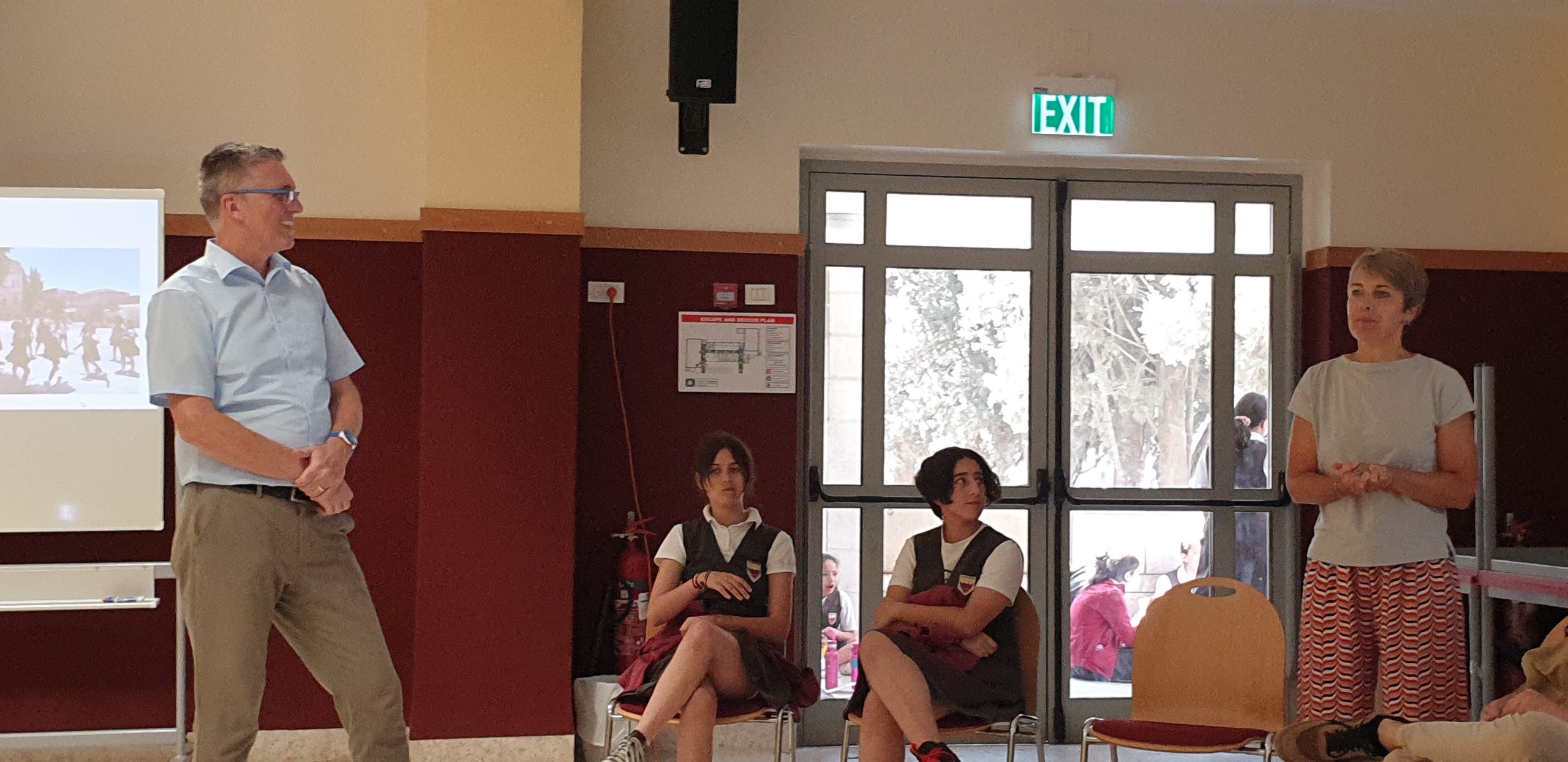
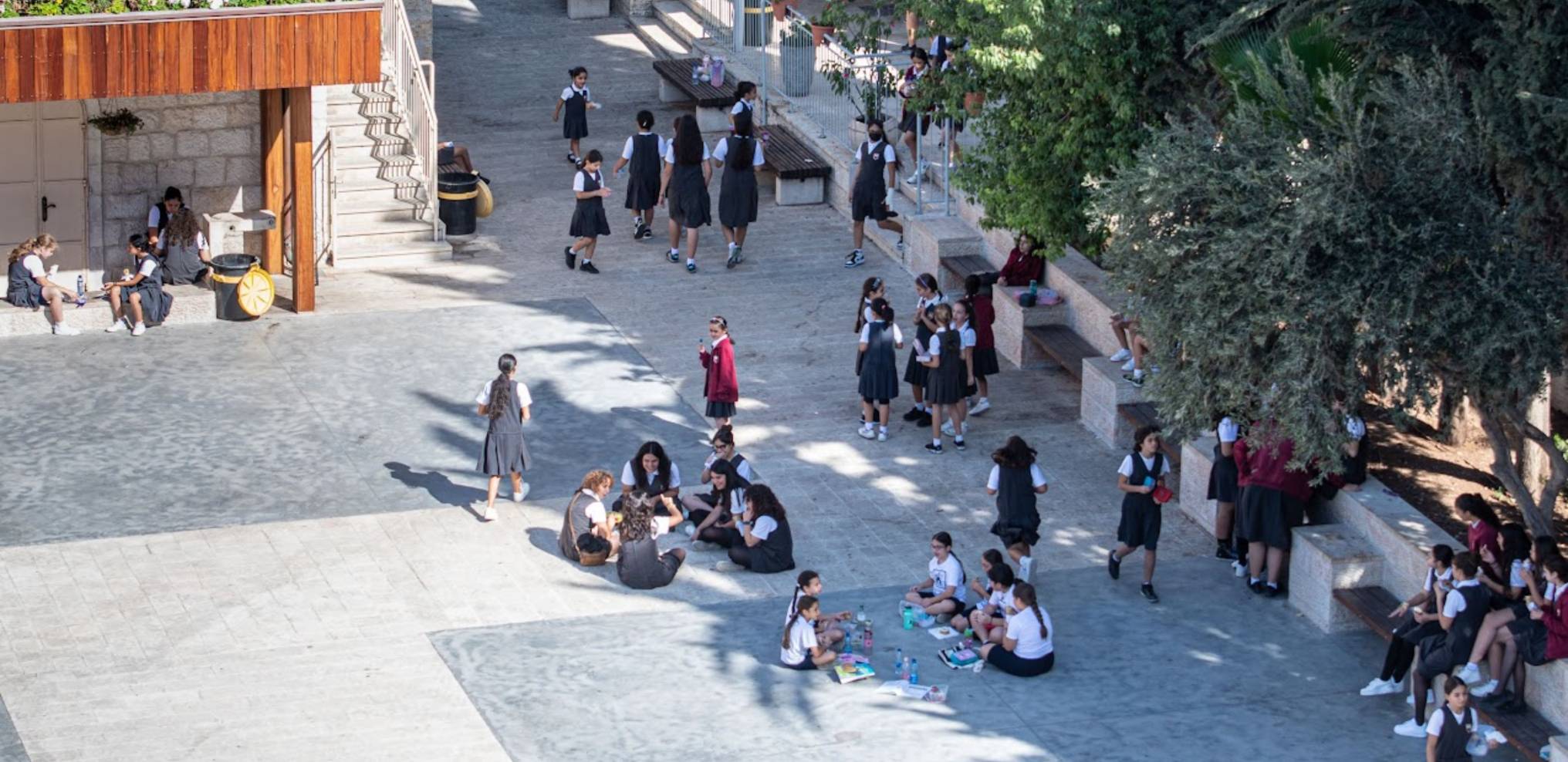
Conversation with schoolgirls of the Schmidt School and schoolyard of the Schmidt School
After exchanging money and having a snack, we drove to Yad Vashem to the Shoa memorial, where we were guided for 3 hours through the museum and part of the outside area. However, this year’s guided tour of the memorial, which was very crowded due to the large number of soldiers, by a retired teacher was very unstructured and unfortunately lacked the necessary professional distance. She presented partly incorrect theses about the prehistory of Nazi anti-Semitism and the rise of Hitler and also referred to all of us unasked as her children, whom she of course had to lecture intensively.
Yad Vashem
Even though I have been to Yad Vashem countless times since 1982, this visit shakes me anew each time, as the Holocaust remains ultimately incomprehensible and inexplicable even after reading so many scholarly books. A list of over 11 million Jews in Europe and the USSR (over 16 million Jews worldwide at the time) is on display at Yad Vashem, which was approved at the Wannsee Conference on Jan. 20. 1942 served as the basis for the “Final Solution of the Jewish Question”. So at least 11 million Jews were to be murdered if the war had lasted long enough. From this point of view, it is completely irrelevant whether almost 6 million or even about 6.5 million Jews were killed, since it was supposed to be 11 million. Approximately 4.5 million Jews killed are now recorded by name in Yad Vashem. In total, about 40% of the Jews of that time were murdered. Only recently have there been as many Jews worldwide as there were before the Holocaust.
The Shoa memorial shows with an overwhelming abundance of documents, eyewitness accounts, etc. the Nazi persecution of Jews / extermination, among other things, with the goal: to arouse emotions so that such a thing should never be repeated. However, the causes and antecedents of Nazi anti-Semitism are presented only very superficially, which would be absolutely necessary for a deeper understanding.
All Israelis visit Yad Vashem several times in their lives (during their school/military years) and the Auschwitz concentration camp. Very many are shaken and draw from it the lesson never again to be a defenseless victim and therefore always to fight back and in case of doubt to shoot first. The message that the Holocaust also conveys – never again oppress, discriminate against, degrade, kill, rob, etc. other people (even if they are Muslims) – is unfortunately neglected by many Israelis. – is unfortunately neglected by many Israelis, as the shameful result of the Knesset election on 1.11.22 shows, so that Israel will probably now have a right-wing government under Netanyahu with a racist-fascist party alliance.
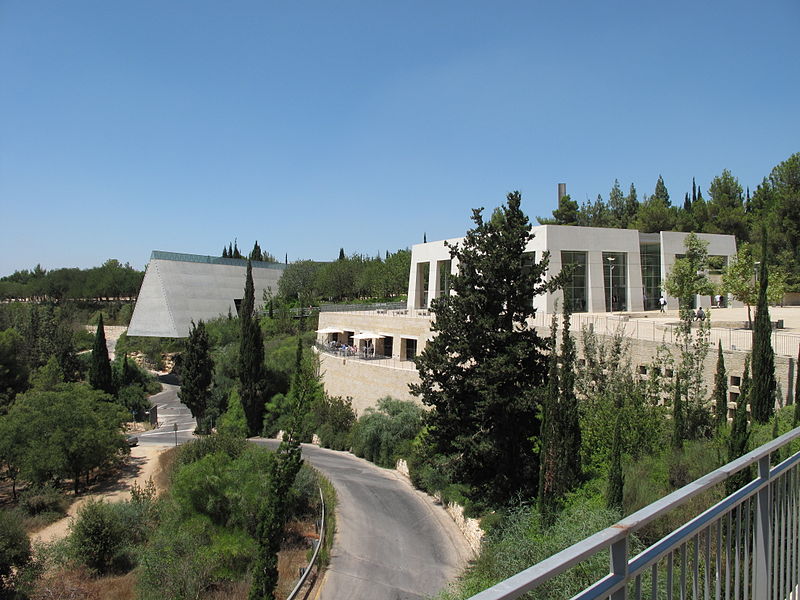
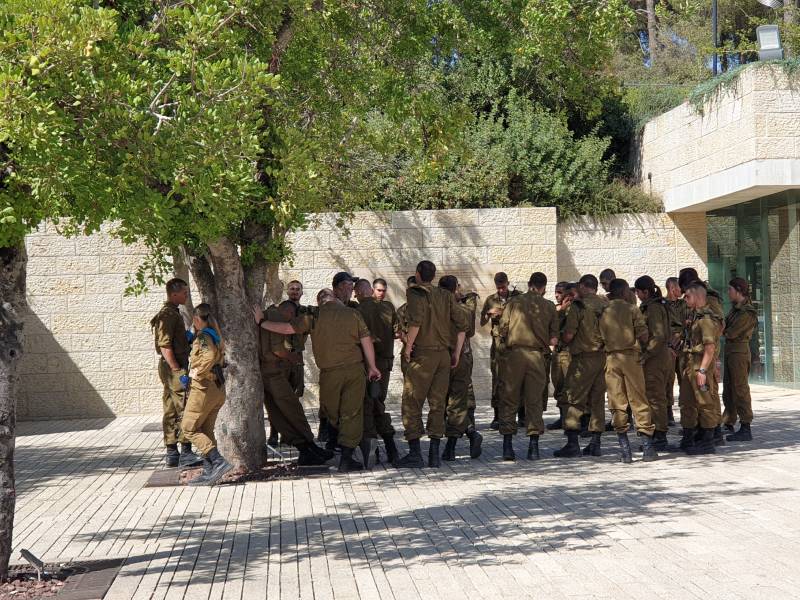
Yad Yashem and soldiers as visitors to the Holocaust memorial site
Afterwards we drove back to our quarters at the foot of the Mount of Olives, where after dinner we again sat comfortably together in the face of the Dome of the Rock until late in the evening.
Day 7: Friday, 7.10.: – Jerusalem Old City
After breakfast, we had Edgar drive us to the top of the Mount of Olives, from where there is an incomparable panoramic view of all of Jerusalem and especially the Old City. Then we walked slowly down the Mount of Olives, stopping at various places (entrance to the Jewish tombs on the Mount of Olives, the church “Dominus flevit” incl. the bone boxes, the Russian Orthodox Church of Mary Magdalene, open only a few hours a week, with the wonderful golden domes, etc.), and as always I gave the TN the necessary information about this. From the church Dominus Flevit (lat. “The Lord wept”) you have another breathtaking view of the Old City of Jerusalem with the Dome of the Rock. The Church recalls Jesus’ mourning in foreshadowing regarding the coming destruction of Jerusalem:
“And when he drew near (from the Mount of Olives), he saw the city and wept over it, saying, ‘If only you also knew at this time what is for peace!’ But now it is hidden from your eyes. For the time will come upon you when your enemies will raise a wall around you, besiege you, and harass you on every side, and will level you to the ground, along with your children within you, and will not leave one stone upon another within you, because you did not recognize the time when you were afflicted.'” (Luke 19:41ff.).
Truly prophetic Jesus about the countless destructions of Jerusalem until modern times and the city of Jerusalem, where until today it has not been recognized what serves peace!
Dominus Flevit
The church belongs to the Franciscan order and was built in 1955 on the foundations of a 6th century Byzantine church. built. The sensational excavations of the 1950s revealed a Jewish-Christian cemetery from the 1st century. free. The ossuaries, or stone caskets for storing the bones, have numerous scribbles with some of the oldest Christian symbols. Particularly striking is a monogram of the “Constantinian” type, which apparently dates from much earlier Judaeo-Christian times (Constantine died in 337 AD). Further, valuable sarcophagi with plant ornaments or geometric patterns were found, which can be seen today in the Museum of Flagellation.
To the left of the main entrance are preserved the remains of a Christian mosaic from the Byzantine period, which were uncovered during the construction of the present church. On this, some very rare motifs (for example, a pierced pearl in reference to the corresponding parable of Jesus) are particularly worth seeing. Architecturally striking is the teardrop shape of the dome. On the 4 sides of the dome, the architect has installed “tear vases”, an allusion from his homeland to keep the last tear of a dying person in special vessels.
The church is best known for interior photographs, because unlike other Christian churches, Dominus Flevit does not face east, but west: through a window behind the altar, the view falls on the Old City in the direction of the Church of the Holy Sepulchre, which represents redemption in the Christian faith, and the Dome of the Rock, both of which are (almost) at the same level as Dominus Flevit.
Afterwards we visited the tomb of Mary, the grotto as well as the Garden of Gethsemane, where Judas is said to have hanged himself after betraying Jesus, and the Church of the Nations.
Mary’s Tomb
The Tomb of Mary in the Kidron Valley near Jerusalem is considered by early church tradition to be the burial place of Mary, the mother of Jesus. The tomb is at the foot of the Mount of Olives, near the Church of All Nations.
A small church was built there in the 4th century. erected. Crusaders restored and expanded it in the 12th century before it was destroyed by Saladin after the conquest of Jerusalem. The crypt was spared in the process and has been preserved to this day, as Mary is also venerated in Islam.
The present church belongs to the Greek Orthodox and Armenian Apostolic churches; the Syrian Orthodox, Coptic Orthodox and Ethiopian Orthodox churches may share it. A steep staircase behind the façade leads down to the tomb where Mary is said to have lain for a few days until her Assumption. In addition, the graves of her parents Joachim and Anna and her husband Joseph are shown there. Next to the entrance to the church is the entrance to the Catholics’ Grotto of Betrayal, which is said to have been built on the spot where Jesus’ capture took place. According to a Jerusalem tradition, Mary died on Mount Zion in the circle of the disciples. This is commemorated by the Roman Catholic Dormitio Church. In Ephesus there is another site where Mary is said to have died or ascended to heaven according to a much more recent hypothesis. The trend is clearly toward the second tomb for the Blessed Virgin Mary.
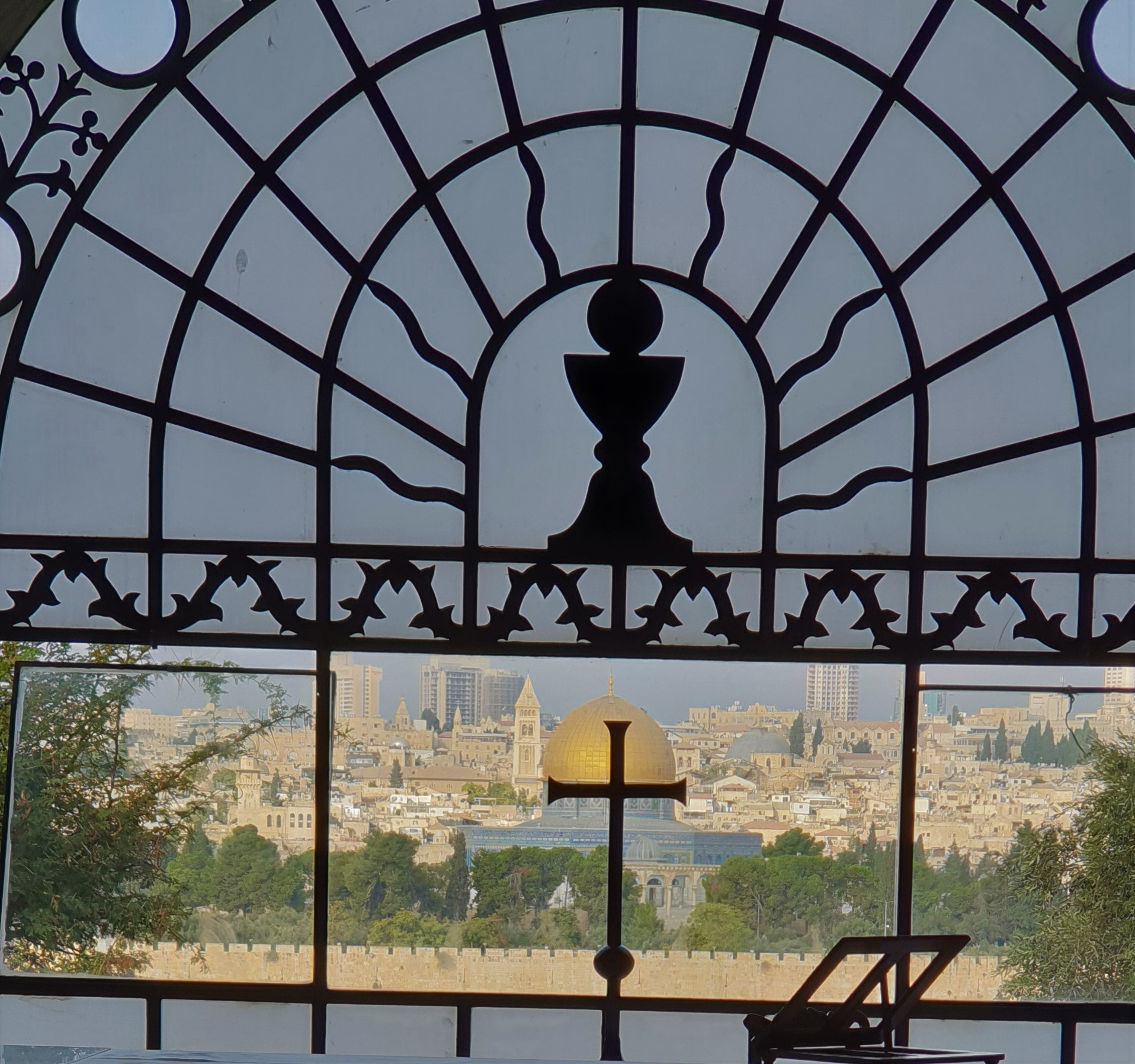
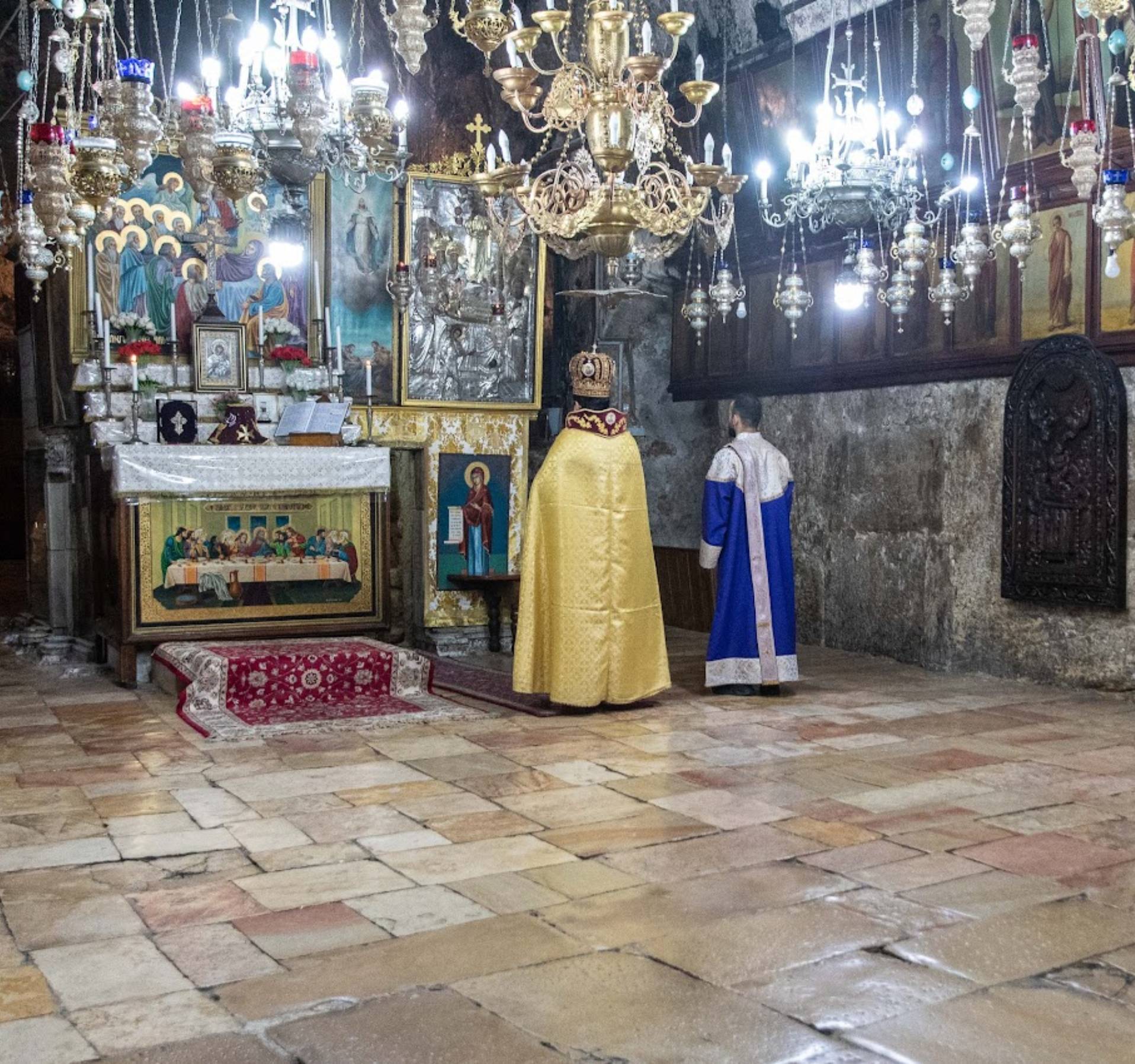
View from church “Dominus Flevit” to the old town and in the Greek Orthodox part of the church “Mary’s Tomb
Afterwards we went down to the Cidron Valley, from where you can see the Palestinian East Jerusalem settlement of Silwan (about 40,000 inhabitants), which was built without a building permit, since the Israeli government generally does not issue such a permit. Now this settlement is also threatened with demolition.
After visiting Absalom’s Pillar – a wayward son of Solomon (in reality tomb of a rich Christian Roman in the 1st century, on the outer wall of which a small text of Luke’s Gospel was discovered at the very top) – we passed through the Lion’s Gate and visited the biblical “Pool of Bethesda”.
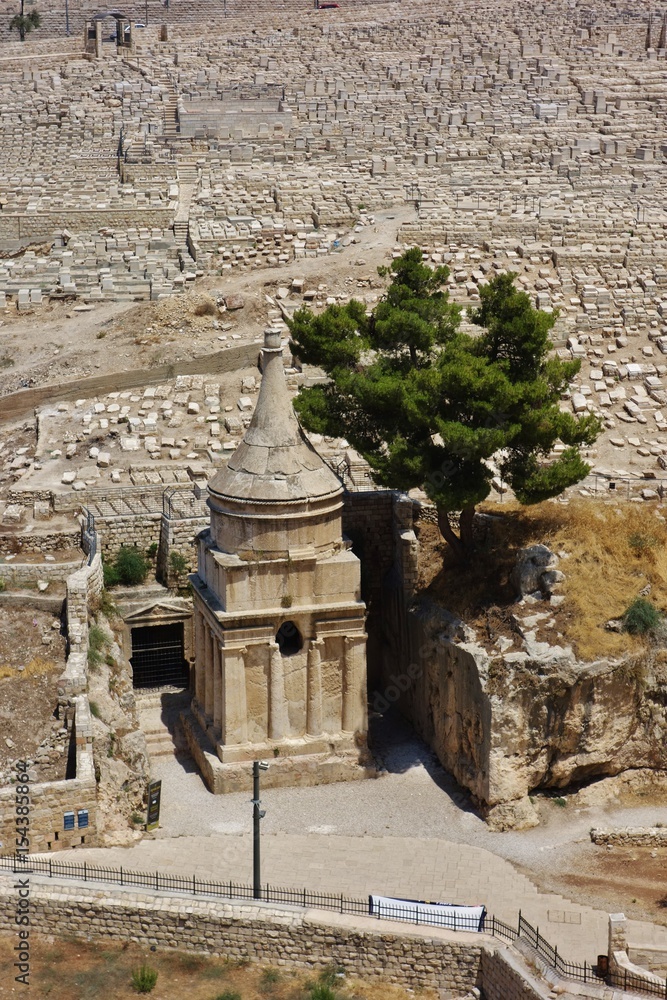
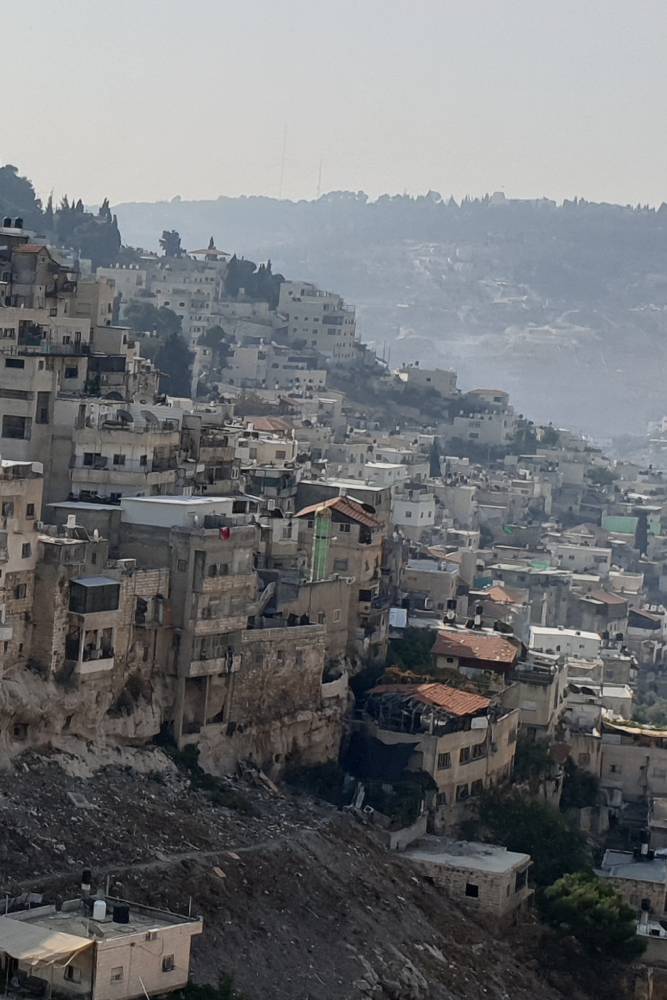
Absalom’s Pillar and the Palestinian Settlement of Silwan in the Cidron Valley Below the City Wall
Pond Bethesda
In the 1st century AD the cultic worship of the Bethesda water increased. There are remains of a sanctuary of the healing god Serapis/Aesculapius. Around a central water reservoir several small bathing rooms are arranged, into which the water was led. Next to them, votive offerings show that people actually believed themselves to be healed by this water. In the Byzantine period in the 5th century, the pools were vaulted with arched structures and a three-nave basilica was built on top. Only remains of this church and of its successor churches are preserved. The Byzantine basilica, due to its location above the ponds, is a sign of remembrance of Jesus’ healing miracles, while the Church of St. Anna, built by the Crusaders in 1142 to the east of the basins, is an expression of Marian devotion, since the dwelling of Joachim and Anna, Mary’s parents, was believed to be next to the Bethesda pond. In 1856, the entire area was ceded to France, which in 1874 entrusted the administration of the site to the White Fathers (French order of the African Mission).
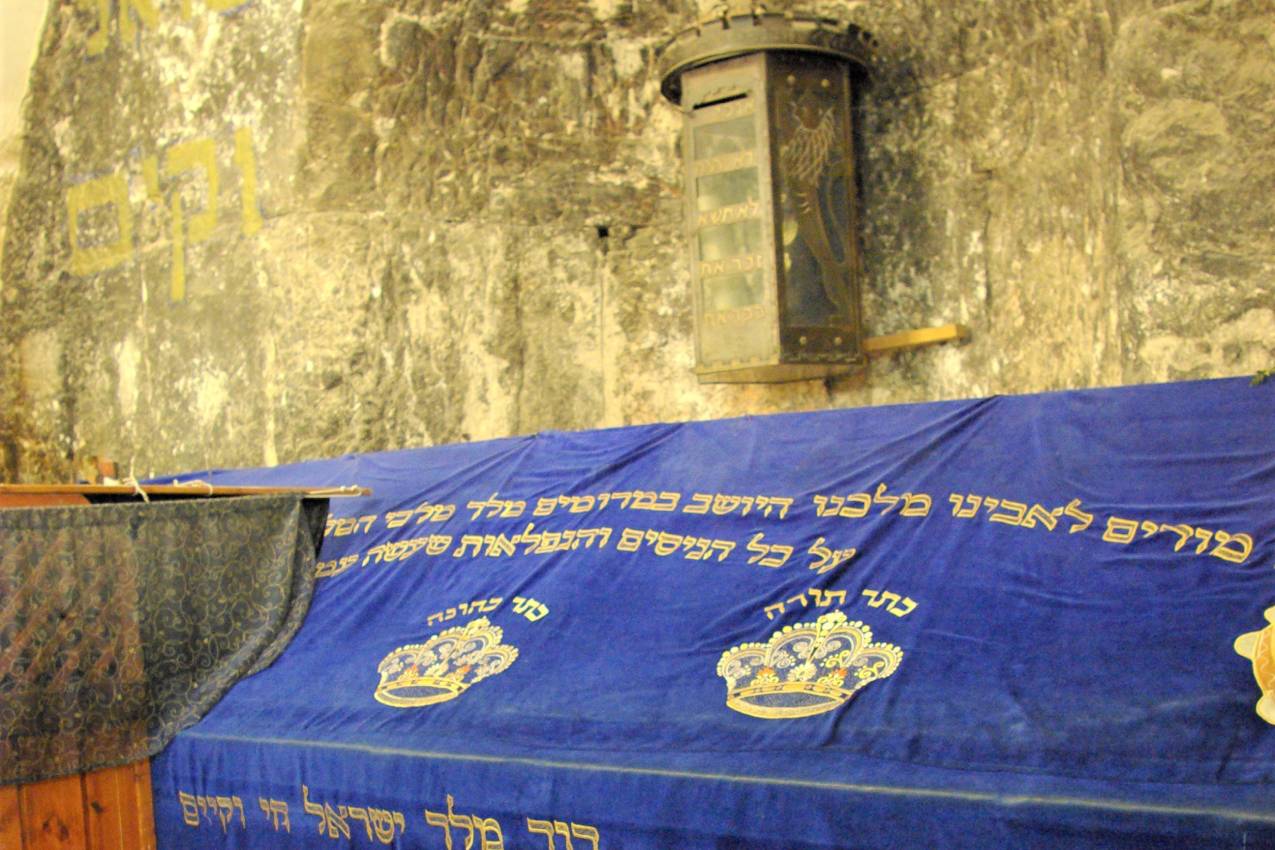
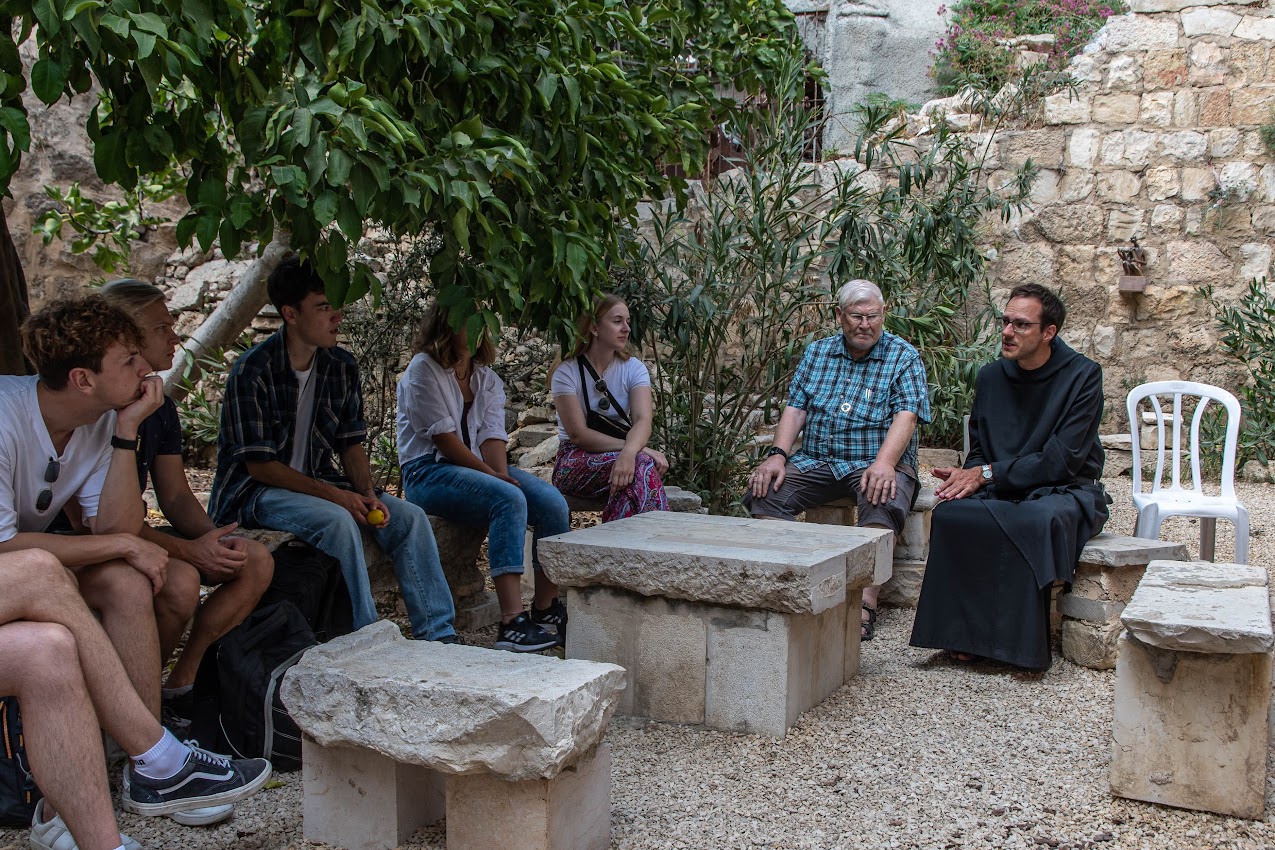
“David’s Tomb” (Cenotaph) and with Father Simeon in the garden of Dormitio Abbey.
Afterwards we let Edgar drive us to the Zion Gate, from where we visited the Upper Room and below it the cenotaph of the “David’s Tomb” – he was probably not buried there – before we met with Father Simeon in the garden of the Dormitio Abbey, since the entire abbey incl. the church is in the center of the city. Church currently undergoing extensive renovation and will not be open to pilgrims again until Easter 23.
Very openly, Father Simeon informed us about the history of the monastery, the life of the monks, his personal areas of work, his leisure activities outside the monastery and how and where he spends his vacation. In support of the exemplary work of the Beit Noah Center for the Disabled and Youth in Tabgha, I presented him with a JIK donation of 1 T € for this facility.
We could not visit the nearby grave of Oskar Schindler at the Roman Catholic Franciscan cemetery on Mount Zion, who – although a Nazi – nevertheless saved the lives of about 1,200 Jews in the end and was therefore only awarded the title “Righteous Among the Nations” by Israel in 1993, almost 20 years after his death, because, strangely enough, a large truck parked directly in front of the entrance blocked the entire cemetery entrance. Some of the participants were dropped off by Edgar at the Damascus Gate, because they wanted to buy souvenirs in the old town, others met for a second time with the German volunteer Jakob at the Auguste-Viktoria-Stiftung, who took over the church tour for them. The rest had themselves driven directly to the quarters at the Birgittinnen.
After dinner, some suggested that everyone take a Corona self-test, as some were showing noticeable symptoms. In fact, 2 TN were then positive except me (later another TN joined), so from now on we all wore masks in the minibus and the Corona-positive sat down at a neighboring table during meals.
Dormitio Abbey
Dormitio Abbey of the German Benedictines is a Roman Catholic monastery and church on Jerusalem’s Mount Zion, south of the old city walls. The imposing complex with its unusual tower is visible from afar and is one of the landmarks of the old town. The abbey is very close to the tomb of King David and the Upper Room. According to tradition, the Mother of God Mary fell asleep on this site, and hence the name Dormitio Mariae – an ancient name of the feast of the Assumption of Mary. Thus, the area holds special historical and spiritual significance for both Jews and Christians.
The destruction of Jerusalem by the Romans in 70 A.D. also resulted in the destruction of the Hall of the Last Supper, and a Jewish-Christian church was established in the 5th century. was replaced by the Byzantine basilica Hagia Sion. At the beginning of the 7th century. the Persian king Korush razed the basilica to the ground, and it was not until about 500 years later that the Crusaders built a church called Sancta Maria in Monte Sion on the remains. This was laid in ruins a short time later by the Muslim rulers of the country after their victory over the Crusaders. The land became German property when Kaiser Wilhelm II acquired it from the Turkish Sultan on the occasion of his visit to the Holy Land and gave it to the German Association of the Holy Land. In April 1910 the monastery and church were consecrated. In addition to their center in Jerusalem, the German Benedictines also maintain a priory in Tabgha on the Sea of Galilee and care for the Shrine of the Multiplication of Bread there. True to their premise “ora et labora”, the monks of the abbey, in addition to monastic life and worship, also devote themselves to peace work, the care of pilgrims, the education of young people, handicrafts and arts and crafts. In addition, the Jerusalem Church serves as a center of cultural-spiritual events.
Day 8: Saturday, 8.10.: Caesarea – Sepphoris – Haifa
Early in the morning we drove to Caesarea, a foundation of Herod the Great, which he named Caesarea in honor of the emperor (Caesar) Augustus and equipped with a theater, temple, hippodrome for 20,000 spectators, bathhouses, forum and a gigantic harbor. Today, however, there is little to be seen of it. So far, at the entrance you could see a very informative film about the history of Caerarea. This film can now be seen after Corona only at the rather distant exit. We therefore first visited the theater, the remains of the temple and the hippodrome, as well as the famous stele that proves that Pontius Pilate, prefect of the Roman emperor Tiberius in Judea, was a historical figure.
Since there was nothing more to see in the direction of the exit except for the Mediterranean Sea and it was uncertain when the movie would start, we went back to the bus and continued towards Sepphoris, especially since Edgar probably didn’t know this national park and therefore I didn’t know exactly when we would be there. After a short film about the history of Sepphoris, our young guide Rinat showed us quite competently the most important sights of the important ancient city of Sepphoris, but seemed quite distant, so that not everyone was satisfied with the tour.
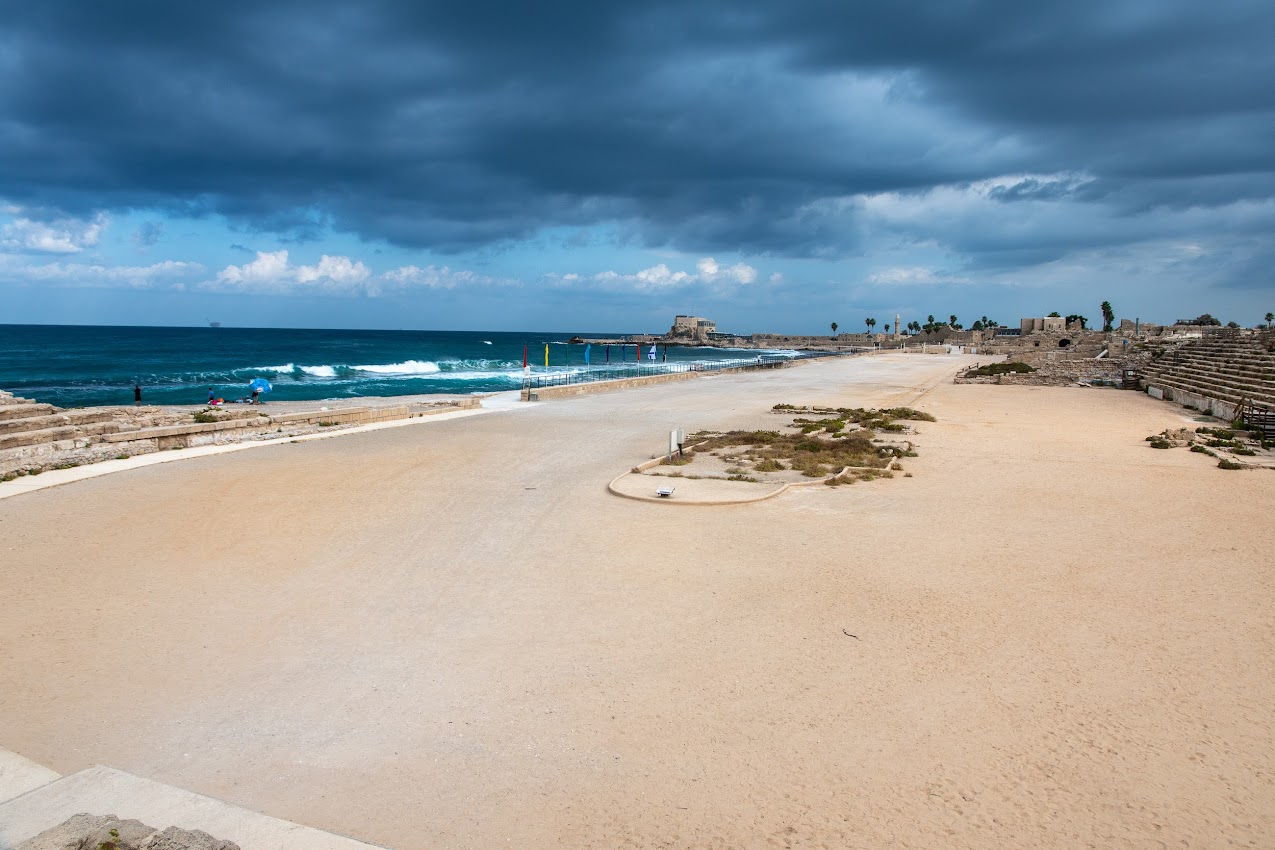
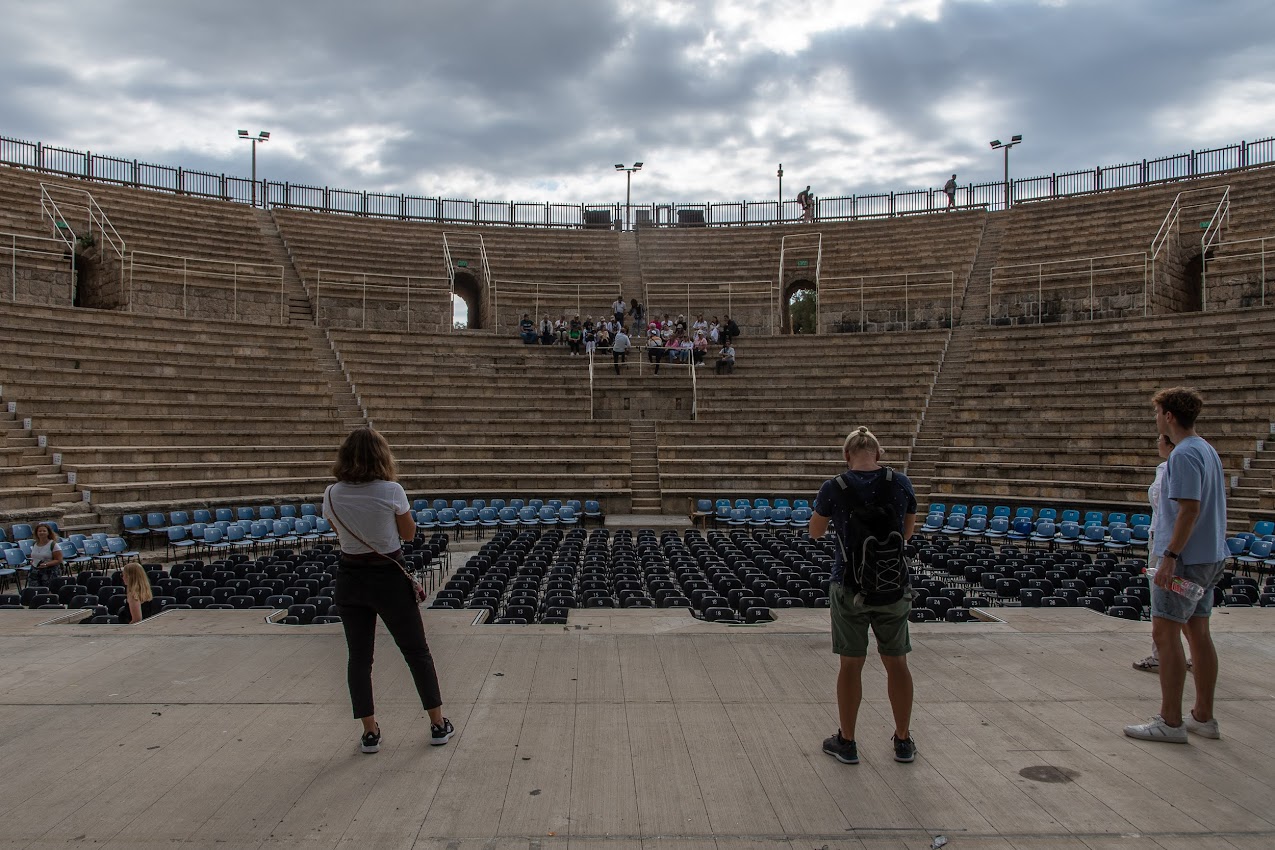
Caesarea: Hippodrome, right remains of the tribunes and theater of Caesarea
Sepphoris
Sepphoris (Hebrew Zippōrī) was an ancient city in Galilee. It was in the 1st c. v. Chr. a larger city of the region and was located about 8 kilometers north of Nazareth. Herod Antipas, a son of Herod the Great, then had Sepphoris rebuilt after its destruction and made it his magnificent capital. Sepphoris was situated on a hill and was visible from afar. Its streets were covered with precious broken marble. A Roman theater was built into a hill. From the 1st c. n. Chr. comes a burgher basilica with white mosaic floors and rich wall paintings. Ordinary and genteel houses were found side by side in the downtown area. There were two markets where there was a lively trade in regional goods – probably mainly food (wheat, olives, grapes, dried fish), ceramics, jewelry and woven fabrics. In 1993 the remains of a synagogue from the 5th century were found. Especially the well-preserved mosaics, which represent, among others, the god Helios, form one of the peculiarities of Sepphoris.
The mosaic of the synagogue is divided into 7 panels, which are differently preserved, but overall show severe destruction. The pictorial program of the mosaic is a mixture of biblical-Jewish and extra-biblical motifs. Thus, in panels 7 and 6 (near the entrance) there are representations of biblical stories. Panels 4, 3 and 2 contain Jewish symbols, panel 1 has a wreath in the center from which the water streams of life flow. Panel 5 contains a representation of the Zodiac. In the center you can see the four horses of the sun chariot of the god Helios. The god himself is not depicted figuratively-anthropomorphic, but as a sun with rays. This is an important difference to other representations of the Zodiac, where the sun god is depicted as a human figure. Of the figural zodiac signs around it, only four are largely preserved. Outside the zodiac, in the corners of the square in which the zodiac is embedded, there are figural representations of the four seasons.
In the 12th century, the Crusaders built the Gothic Church of St. Anne and a castle in Sepphoris, which they called Le Saforie, and incorporated it into their Kingdom of Jerusalem. In 1516 the place, now called Saffuriyya, became part of the Ottoman Empire and was inhabited exclusively by Muslims. In 1745, a fortress was built on the hill next to the village. The church of St. Anne, to which pilgrimages were still made in the 17th century, was destroyed by the beginning of the 19th century at the latest. Under the British Mandate, Saffuriya became the largest village in the Galilee and lived mainly from the cultivation of olives. In 1949, the moshav Tzippori was founded south of the village. The remaining Arab settlers were deported in the 1960s and the village was demolished.
Was Jesus in Sepphoris?
Josef (His profession “tekton” in Greek does not mean carpenter, but building craftsman; there was no specialization supervised by a chamber of crafts yet). and his son Jesus (from “Iēsoûs” = Greek and “Jeshua” = Hebrew, which means “God helps”) probably went regularly from Nazareth, which is only 8 km away, to Sepphoris, since there was long-term work at this large construction site, unlike in the village of Nazareth. There he probably also got to know the Greek culture or philosophy, because some views of Jesus resemble those of the Greek Cynics, according to Prof. Lang, who even calls him a Jewish Cynic.
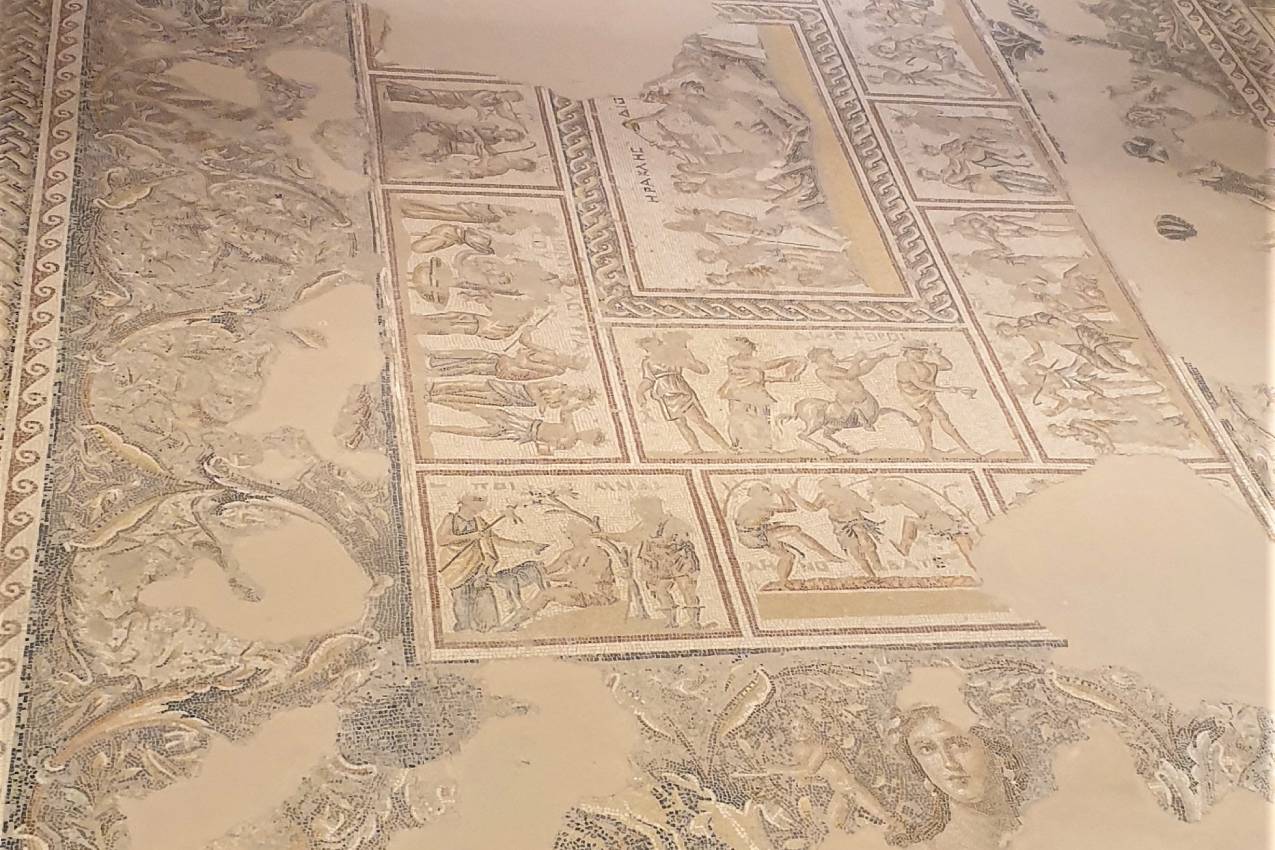
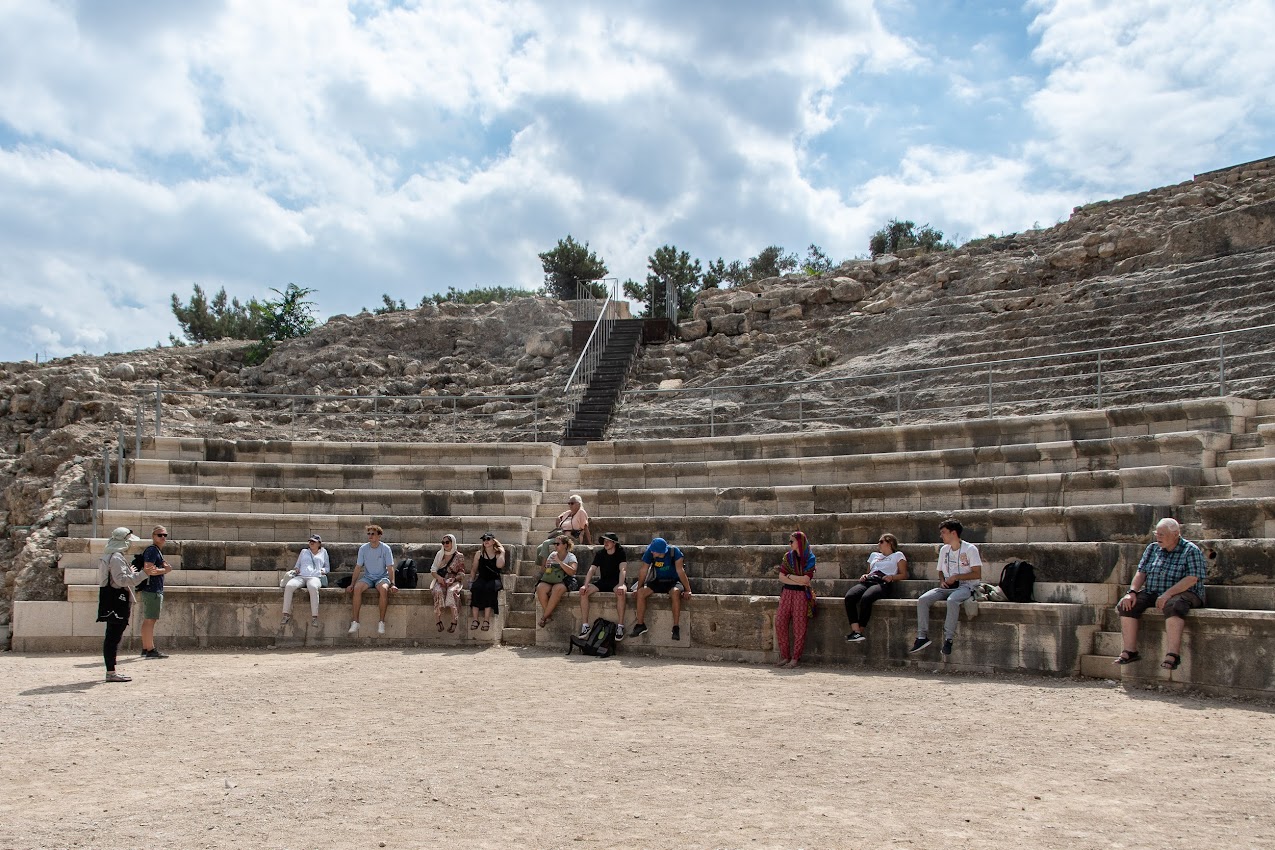
Sepphoris: mosaic floor and theater
We reached Haifa in time, where we first wanted to visit the famous and unique Bahá’í Garden (open until 5 p.m.) with the Shrine of the Bab from the lower entrance. Unfortunately, we could only get to the 1st barred gate there. The security guard at the entrance told us that tomorrow from 9 am we could also get to the shrine from the middle entrance through the garden and visit it from the inside.
Therefore, we first went to the Stella Maris Monastery, where we also had dinner and spent the night.
Monastery Stella Maris
The Carmelite monastery Stella Maris (Latin Stella Maris ‘Star of the Sea’) is located on the slope of the Carmel mountain in Haifa. The name Stella Maris is an invocation to Mary, the mother of Jesus Christ. The 19th century church building and Stella Maris Monastery are located on the western slope. According to the 1st Book of Kings, the trial of strength between Elijah and the prophets of Baal took place on Mount Carmel in the 9th century BC (1 Kings 18:37-39). Above a grotto commemorating Elijah’s stay, the sanctuary of Stella Maris was built. In the 12th century, under the rule of the Crusaders, hermits first inhabited caves on Mount Carmel to imitate the life of the prophet Elijah.
Edgar took us to the viewpoint opposite the monastery, from which there is a wonderful view of Haifa and the port facilities. It is said that one is in Jerusalem to pray, in Tel Aviv to celebrate, and in Haifa to work. We then took our bathing suits from the bus and took the cable car down to the sandy beach on the Mediterranean Sea for an extensive swim. Although the cable car ride back up to the monastery took seemingly forever, we were able to check in before dinner. Afterwards, some of us sat on the roof of the monastery and admired the sea of lights of the port city of Haifa at night.
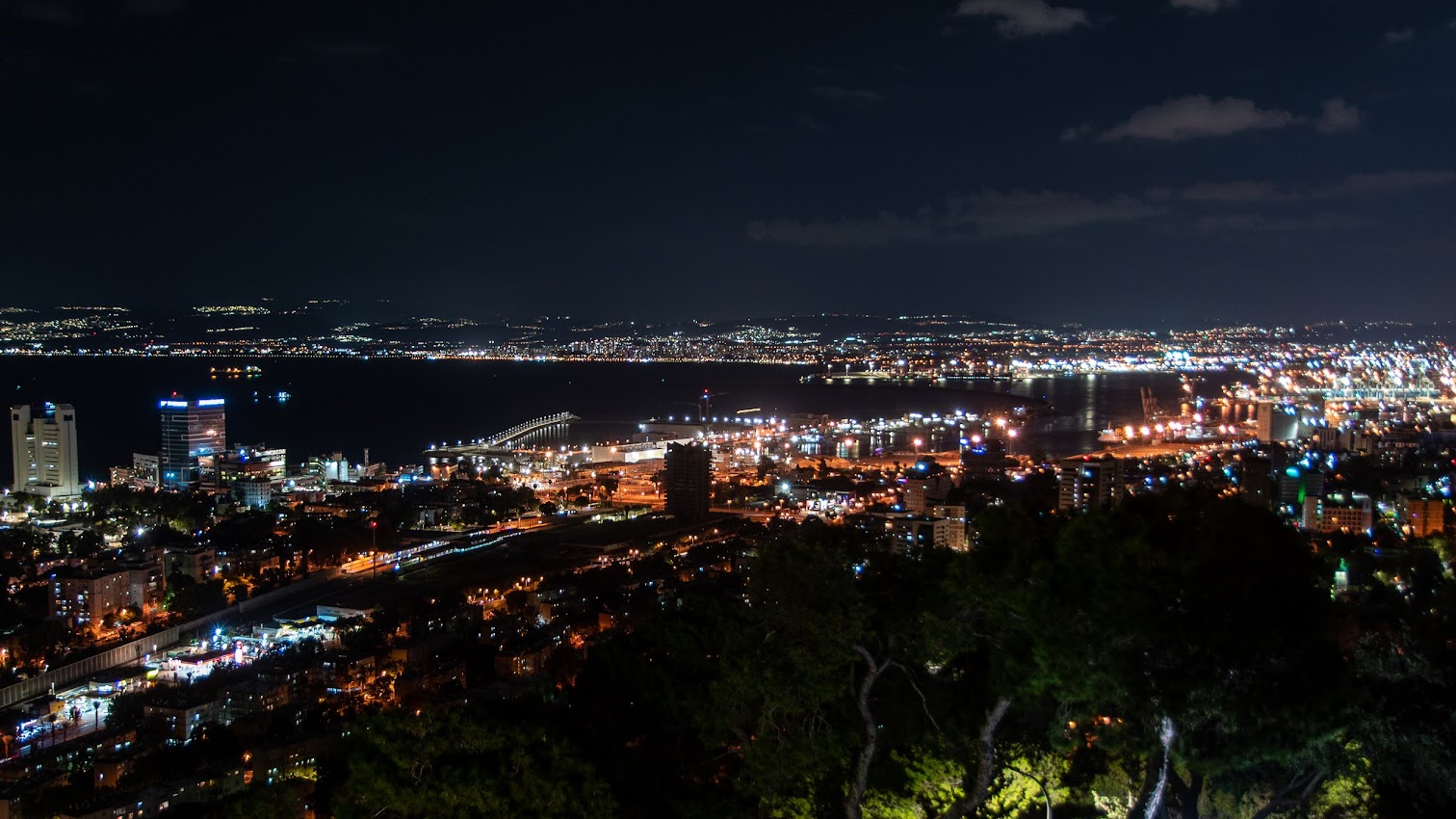
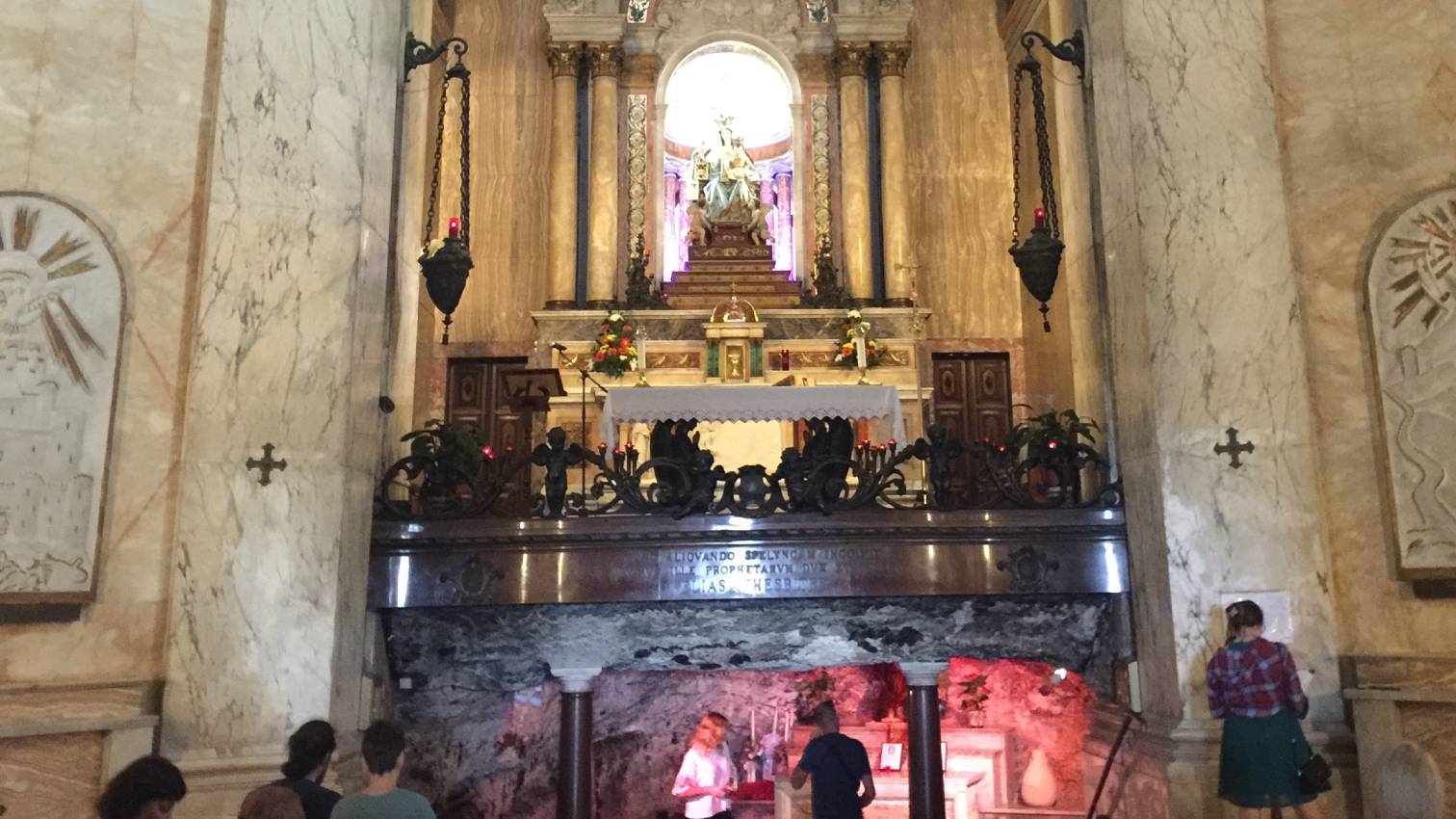
View of Haifa and Mediterranean Sea from the roof of Stella Maris Monastery and church with Elia Grotto (below).
The Bahá’ís (about 8 million worldwide) believe in an all-knowing and all-loving God. Their young religion originated in Iran, where the religion’s founder Bab was executed in 1850 and 20,000 followers were killed. Especially in Islam, the Bahai are considered to be apostates from the true faith and are subject to persecution and discrimination in many countries (even in Israel they are only tolerated.). All the people and nations of the world, with their completely different abilities, characteristics and appearance, should join together, live peacefully with each other, preserve nature and work together to ensure that all living beings are well. This can only succeed if all people know enough. That is why Bahai attach great importance to good schools and, above all, to the fact that every person can attend them and learn throughout his or her life.
Bahá’ís believe in an eternal, inaccessible, omniscient, and omnipresent Creator God and thus join the tradition of Abrahamic monotheism. But the Bahá’ís see the role of their own and also other religions and prophets completely differently: Their prophet does not proclaim a final, uniquely correct revelation or understand the Bahá’ís as the excellent people of God and other religious communities as infidels. Bahá’ís believe much more in a kind of evolutionary theory of religions. The Bahá’ís explain the fact that there are so many divergent religions by the fact that each religion responds only to the needs and circumstances of its time. With the development of new social forms and advancing culture, there is room for a new revelation, a new prophet. Thus, Bahá’ís also see themselves as only one link in the chain after Krishna, Moses, Christ, Mohammed, and many more. The messages of religions and the God to whom they refer are always the same in the eyes of Bahá’ís. But to live according to the guidelines of a religion whose teachings refer only to its centuries-old time of origin is out of time, according to the Prophet Bahá’u’lláh.
On the holiest days of the Ridvan period, the 1st when Baha’u’llah, the successor of the Bab announced that he was the Promised One, the 9th when his family visited him in the Garden of Ridvan, and the 12th when he left the Garden, the Baha’i do not work. They meet on these days to hold devotions and celebrate. In some countries, such as India, children are also off school. Exact beginning of Ridvan festival is April 21, 2 hours before sunset. For the feast, religious gatherings are held in devotional rooms with common prayers and celebrations. The story about the time Baha’u’llah spent in the Garden of Ridvan is told, read aloud, or acted out by the children as a play. Afterwards, celebrate at home with a good meal. Even though there are no set rituals for the celebration. For the Bahai do not know such. Likewise, there are neither ceremonial services nor a religious clergy. Community affairs are carried out at the local, national and international levels by democratically elected bodies. Also on the first Ridvan day, local bodies are convened, the “spiritual councils,” each consisting of 9 people. Before that, they must be elected from the entirety of the community and then exercise their religious office for one year.
When it comes to sexuality, however, the Bahá’ís are similarly conservative as their related religions: Sexual relations before and outside the framework of marriage, as well as the practice of homosexual love, are forbidden. Homosexual people can be active members of the religious community, but they must suppress their predispositions or inclinations and try to remain faithful to the laws of God or guidelines of Bahá’u’lláh. The Bahá’í religion, however, does not discriminate against or punish homosexuals.
1. digression: religion + homosexuality: the Bible does not condemn homosexuality in today's sense.
Since in most Asian and African countries there is either no protection against criminalization of homosexuality (so also in Palestine and Jordan, which we visited) or very severe penalties up to the death penalty (mostly in Muslim countries like Saudi Arabia), but homosexuality is also rejected in Orthodox Judaism, here is a short digression on this topic in the Holy Land of the Bible and the 3 Abrahamic religions:
Mainly in the Abrahamic religions homosexuality is rejected from the beginning and punished with death. Since Islam, as the youngest of these 3 religions, has adopted the view of the Bible, I will limit myself to the depiction of homosexuality in the Bible or the Torah. The term homosexuality is an artificial word that was used for the 1st time only in 1868. In the OT or the Torah (5 books of Moses) only the term sodomy is used, which occurs only 3 times, in reference to the story of Sodom and Gomorrah (Genesis 13ff.):
Lot lived as a stranger in Sodom and was therefore probably shunned by the locals. Now when he received 3 angels with him, all the men of Sodom went before Lot’s house and demanded the surrender of these 3 foreign men. These cannot have been all homosexual at all, since probably at all times in a population approx. 6% of the women and men were and are homosexually inclined. So it was 94% heterosexual men who had only one goal, the brutal mass rape of these strangers. It is not uncommon for men in prisons to experience something similar, and for them it is the worst humiliation that can be inflicted on them. This story has nothing at all to do with sexuality and homosexuality in the modern sense, especially since the Sodomites had rejected the offered daughters of Lot as substitutes. The OT then lists the many sins of Sodom and Gomorrah: Turning away from God; idolatry; wickedness; unrighteousness; breasting to do evil; supporting evildoers; pride; contumacy; violence; cruelty; adultery; lying; deception; not caring for the poor and miserable; inhospitality; reviling Israel; impenitence; lawlessness; carelessness; fornication; spurning God’s witnesses – but not homosexuality. After this demonstration of godlessness and violence by all the men of Sodom, both cities were destroyed by God. This shows that this passage has been and is completely misunderstood by fundamentalist Christians since the beginning.
The 2. and 3rd passage at Deut. 18-20ff. (Leviticus) reads, “And if a man lies with a man as one lies with a woman, both have committed an abomination. They must be put to death; their blood is on them.” In Hebrew, the word “abomination” is “toevah” and means: something that is detested by God because it is unclean. It is a ritual impurity, not a moral sin (Heb. “Zimah”). For example, a menstruating woman was called an “abomination” and was not allowed to enter the temple, but she was not morally reprehensible because of it. For Jewish law, homosexuality had to do with ritual impurity, not sexual ethics. Incidentally, many other abominations are listed in Leviticus, among others: eating shellfish such as mussels or lobsters, approaching the altar of God with an eye disease, planting two different seeds in one field, wearing clothes made of two different fabrics (e.g. cotton & polyester), cutting the hair of the head and beard. On the other hand, keeping slaves and selling daughters into slavery are permitted, but working on Saturday is forbidden under penalty of death (Exodus 21:7 and 35:2). So if someone demands the punishment of homosexuals with the reference to Leviticus, he would also have to demand the strict observance of all other divine commandments of the OT or the Torah, but this is probably not demanded by any of these Christian/Jewish fundamentalists.
The condemnation of homosexual male behavior in Leviticus (see above) is also about the entrenched patriarchal gender roles. The man married in the antiquity with approx. 18 years an approx. 14 years old “woman” and should beget as many children as possible as proof of his manhood (for the survival at that time very important), particularly since a part of the children died prematurely in the 1. year of life or later from diseases. Behaving as a man like a woman was a clear violation of these gender roles and therefore had to be condemned in the strongest terms.
The man was the crown of the creation, then came the completely lawless children, women, slaves or the servants. Almost all of the men (and women) who secretly acted out their homosexual needs were married and had children. They were not even aware that they were differently inclined, but only that they were committing a grave sin. Moreover, in ancient times it was not known that one man could produce enough sperm, which theoretically would have been enough for hundreds of children. People were afraid that if the semen was wasted, there would not be enough left for childbearing. Therefore, in the Judeo-Christian tradition, the death of Onan (Gen 38) as a punishment for “wasting” his seed was interpreted as a divine prohibition of coitus interruptus and onanism.
Also in the NT homosexuality is only discussed in 3 places by Paul, neither in the gospels, nor by Jesus. In Romans 1:26ff. Paul is talking about people who have turned away from God and have unnatural lust. In 1 Corinthians 6ff. and 1 Timothy 1:9 ff. he explicitly condemns “boy abusers.” Hereby he alludes to the sexually perverted behavior of the decadent Greek and Roman upper classes at that time.
The context is Greek and Roman culture and the upper class sexuality that was lived there. Both cultures were male-oriented and dominated. A man’s intellectual and emotional partner was often another man. The male body was an ideal of beauty and this ideal influenced the eroticism of the Greeks and Romans. So this homosexual culture had a completely different background than modern homosexuality. The Greeks in particular practiced and taught “pederasty,” the love of boys in which there was an active partner (an adult male) and a passive partner (a teenager of about 14). As soon as the boy grew up (about 16 years), the relationship was over. In this relationship, there was no equality and no community. The older partner determined what happened and only he had sexual satisfaction. It was not a consistent love relationship with more than sex. Besides pederasty, there was gay sex with slaves, a forced pleasure satisfaction, and male prostitution, the latter often as part of the fertility cult. The dominant male sexual partners were of course statistically 94% heterosexual, since this was about dominance and living out perverted fantasies, which Paul quite rightly condemned. Biblical judgments against homosexuality are irrelevant in the modern debate. They should no longer be used as a weapon in the discussion of homosexuality – not because the Bible is not authoritative, but simply because the loving, equal homosexual partnership practiced today and accepted in advanced nations was completely unknown and unthinkable at the time the patriarchal Bible was written. There is extensive scientific literature on this subject, as well as lectures by Prof. Siegfried Zimmer, among others https://worthaus.org/mediathek/.
Excursus: Rise of Christianity and Rise and Decline of Islam
In truth, Christianity defeated the Roman Empire by infiltrating from below. At the time of Emperor Constantine, a significant part of his army already consisted of Christians who wanted to fight for Christ, but not for the Roman emperor. Therefore, Constantine (following a supposedly divine vision and instruction “In this sign you will conquer”) ordered his army to wear the Christ monogram ☧ See image below. (ΧΡ are the first two letters of the Greek word Χριστός = Christos) on the shields of the soldiers and to paint his new field emblem. So, from now on, the soldiers fought for Christ and so Constantine won the decisive victory against Maxentius at the Milvian Bridge in Rome in 312 AD. The Edict of Tolerance of 313 then brought religious freedom for all Christians in the Roman Empire in the following years, and in 380 Christianity was then declared the state religion and the practice of pagan cults was made a punishable offense.
This naturally led to an increasingly hierarchical organizational structure of the church. As early as 304, the Bishop of Rome was also called the Pope for all Christians. Since the convocation of the 1st Council of Nicaea in 325 under Constantine, the first of many dogmas (Jesus is equal – not only similar – to God, perpetual virginity of Mary, etc.) came into being, over which there were very fierce disputes in the following centuries and whose claim to absoluteness did not become reality until the Enlightenment in the 18th century. was questioned.
The original, peaceable teachings of Jesus were often pushed into the background, especially since the Bible was not published until the 16th century. The majority of the believers were illiterate and did not speak the language of the country.
Christianity gained many followers, certainly in part by brute force (baptism or death), but initially also by linking up with well-known models from other religions. The sign of the cross (among others, the handle cross as an ancient Egyptian sign of life as a model), but also the Christ monogram in relation to other persons with the same initial letters already exist centuries before Christ. Mary with the infant Jesus adapts widespread image types from the Mediterranean region, in which mother deities were depicted with child on the lap, in the arm or nursing, etc.. Furthermore, very often churches were built on non-Christian places of worship in order to transfer their sanctity to these churches. Jesus also performed his healing miracles at the Pool of Bethesda (an ancient Greek place of worship of Asclepius, the god of healing).
After the fall of the Roman Empire (476/480 AD), the Pope and the Roman-German Emperor fought for legitimate succession or supremacy from the Middle Ages to modern times. The church of the Christian West naturally had to be structured completely differently – especially in the estates society that prevailed at the time – than the original Christian communities based on equality.
Already in the 7th century Christianity was threatened by the ever-advancing Arab armies, which eventually spread to Pakistan (Today, Indonesia is the state with the most Muslims.). In 732, Charles Martell was able to defeat the Muslim Arabs, who had also advanced into Gaul, and stop their westward advance; otherwise, we would be living today in the “Orient” instead of the Occident.
The call for the 1st Crusade was not a war of aggression against the Muslims, but was intended to liberate the Christian sites previously conquered by the Muslims, which the Christian pilgrims could no longer visit. The time between. 750 and 1258 A.D., on the other hand, was the golden age of Islam (leading in the field of mathematics, science, medicine, geography and, of course, the translation of many world-famous Greek and Roman authors whose lost works we often know today only through their translations into Arabic). The leading Muslims of the time in Spain, Persia, etc. were open-minded and tolerant of scientists of other faiths. Although the Syrian Sultan Saladin conquered Jerusalem in 1187, he did not destroy the Church of the Holy Sepulcher, for example, and was considered an exemplary Muslim ruler.
After that, the decline of the Islamic world began so slowly. Authoritative caliphs proclaimed that the present Koran was of divine origin as well as unchangeable and that any discussion about it was forbidden (still true for many Muslims today). In Spain and elsewhere, however, Muslims were pushed back again. In 1485, the Ottoman Sultan banned letterpress printing using Arabic characters, while in Europe letterpress printing democratized the creation and dissemination of information. For the first time, it enabled the mass dissemination of knowledge, news and opinions free of control by the church and authorities, which in the long run promoted great social upheavals – thus it was one of the driving forces for the Renaissance era as well as for the Age of Enlightenment, and played an important role in the rise of the bourgeoisie as a prerequisite for the development of democracy. In the age of the Renaissance from the 14th-16th centuries. Europe also experienced an unprecedented upswing in architecture, painting, economics, society and philosophy, and in the discovery of the world. The Ottoman Empire, as a result of its internal weakness and the incompetence of its rulers, became more and more the sick man of the Bosphorus and dissolved at the end of the First World War.
It was not until 300 years later (!!!) that letterpress printing was permitted there. Even today, Muslim states are very far behind Western states in the distribution of secular books, newspapers, etc. This also applies to almost all areas of science, since creativity, the urge to research, artistic freedom, etc. cannot develop in a strictly conservative Islamic dictatorship.
Islam has not recovered from this decline in the Arab world to this day. There are hardly any democratic Muslim states. Since the Muslim-Arab states also lack a broad middle class as a prerequisite for economic/democratic development, as well as democratic structures or role models from the past, the Arab Spring (2010 ff.) has also fizzled out again.
The great mass of Muslims live under the rule of violent dictators who brutally crush all calls for democratic change. In Islam, there has been no development comparable to our Enlightenment (and thus the criticism of the sanctity of the Koran and the teachings of Islam). Most Muslims pray suras from Islam, whose meaning (and language) they often understand far too little, let alone could critically question. The adherents of a reform Islam are a small minority worldwide.
In almost all countries where Christians and Muslims live, especially the Christians are more educated as well as wealthier and have a much lower birth rate. Worldwide, more than 360 million Christians face intense persecution and discrimination because of their faith (in reality, because of their greater wealth, education, and greater spiritual freedom). In the 50 countries of the World Persecution Index, this is even true to a very high to extreme degree; 312 million of the 737 million Christians living there are affected.
Conclusion: All world religions, especially in the richer countries, suffer from the increasing secularization, especially after World War II. In the poorer world religions, on the other hand, a contrary trend can be observed in some cases (hardship teaches to pray), with dubious sects spreading in many regions. Overall, Christianity is certainly the most modern and enlightened world religion with 2.5 billion Christians). However, Catholic Christianity still has to do some homework (women’s priesthood, celibacy, etc., see below Excursus 3.2., Day 10) in order to arrive in the 3rd millennium.
Islam and the Arab states, on the other hand, are in a tragic impasse that weighs heavily on the world. Anyone who can show a realistic way they could get out of this will surely get the Nobel Peace Prize immediately. On the other hand, no one knows whether we will be able to get a grip on the climate crisis and the many other current crises or wars (not only in Ukraine). I am left with the principle of hope that Jesus’ messages, which are still relevant, will one day prevail for the good of the world.
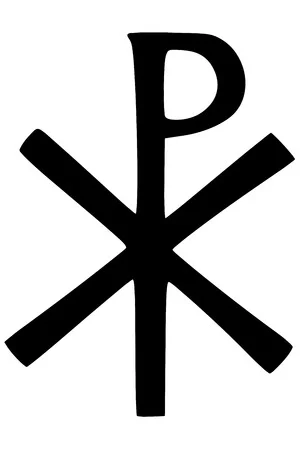 Christ monogram
Christ monogram
Day 9: Sunday, 9.10.: Haifa – Rosh HaNikra – (Nes Ammim) – Akko – Tiberias
In the morning we first drove to the upper entrance of the Bahá’í Garden, from where there is a unique view of the garden, the shrine and the harbor. After that, we finally found the access to the middle entrance and passed through the beautifully designed garden, voluntarily maintained by followers of this religion, to the interior of the beautifully decorated shrine, brightly lit with many candles, with the Bab’s tomb underground in the center.
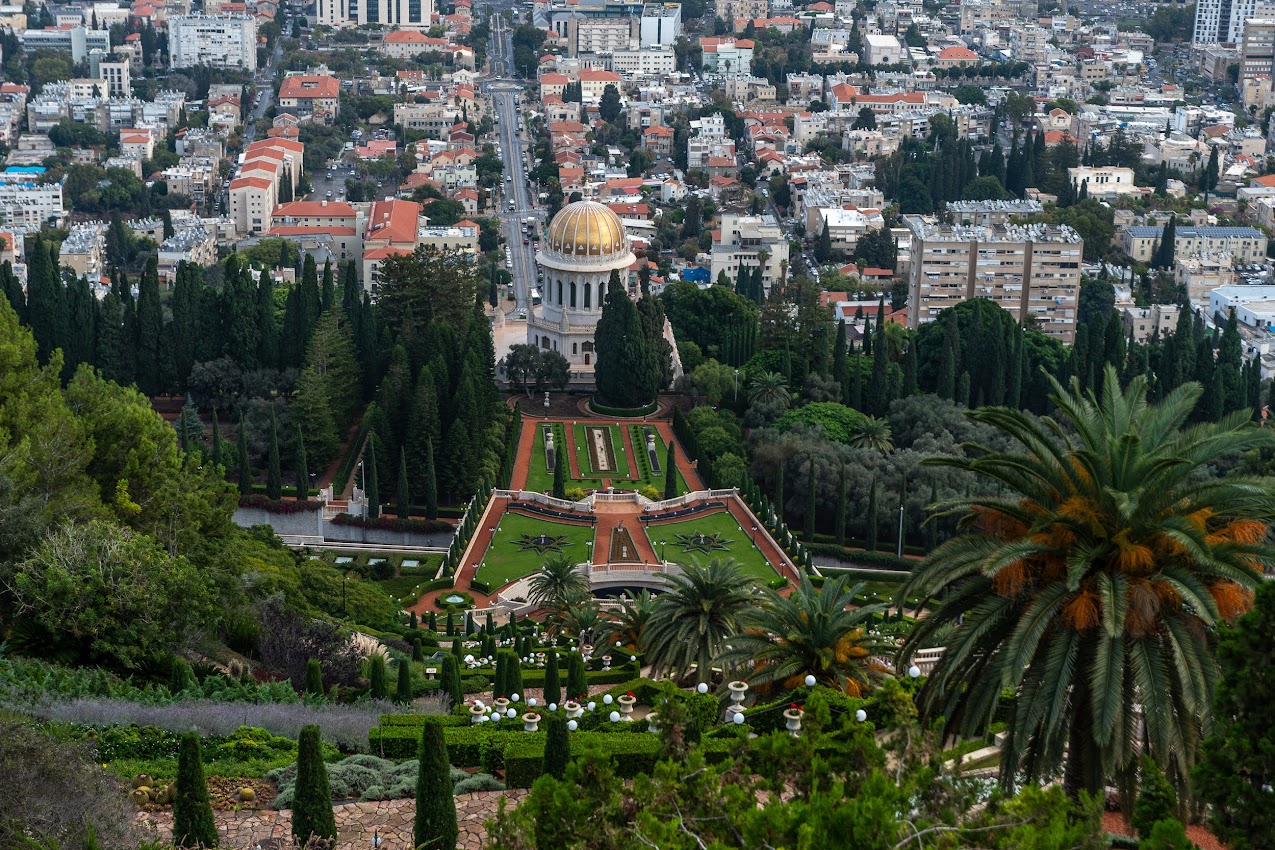
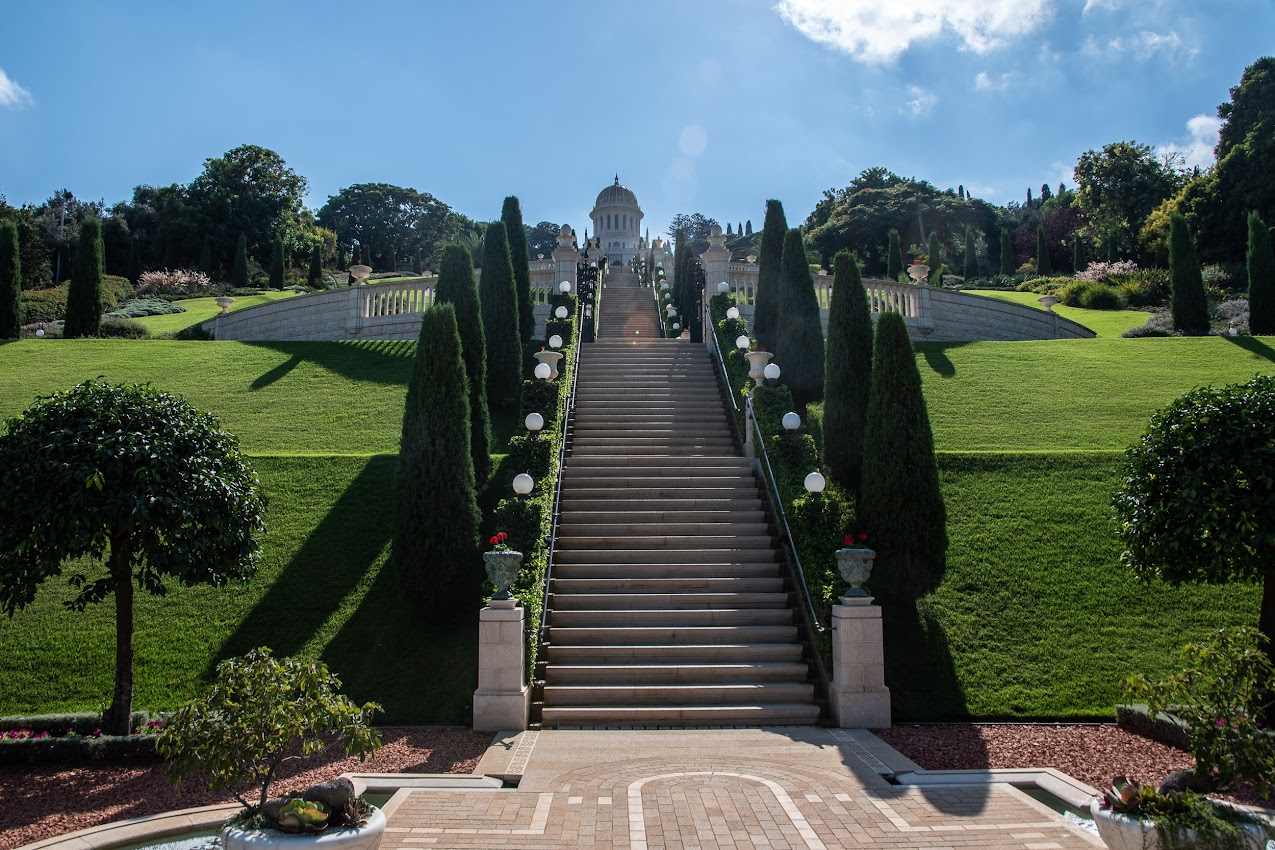
The Bahá’í Garden from above and below
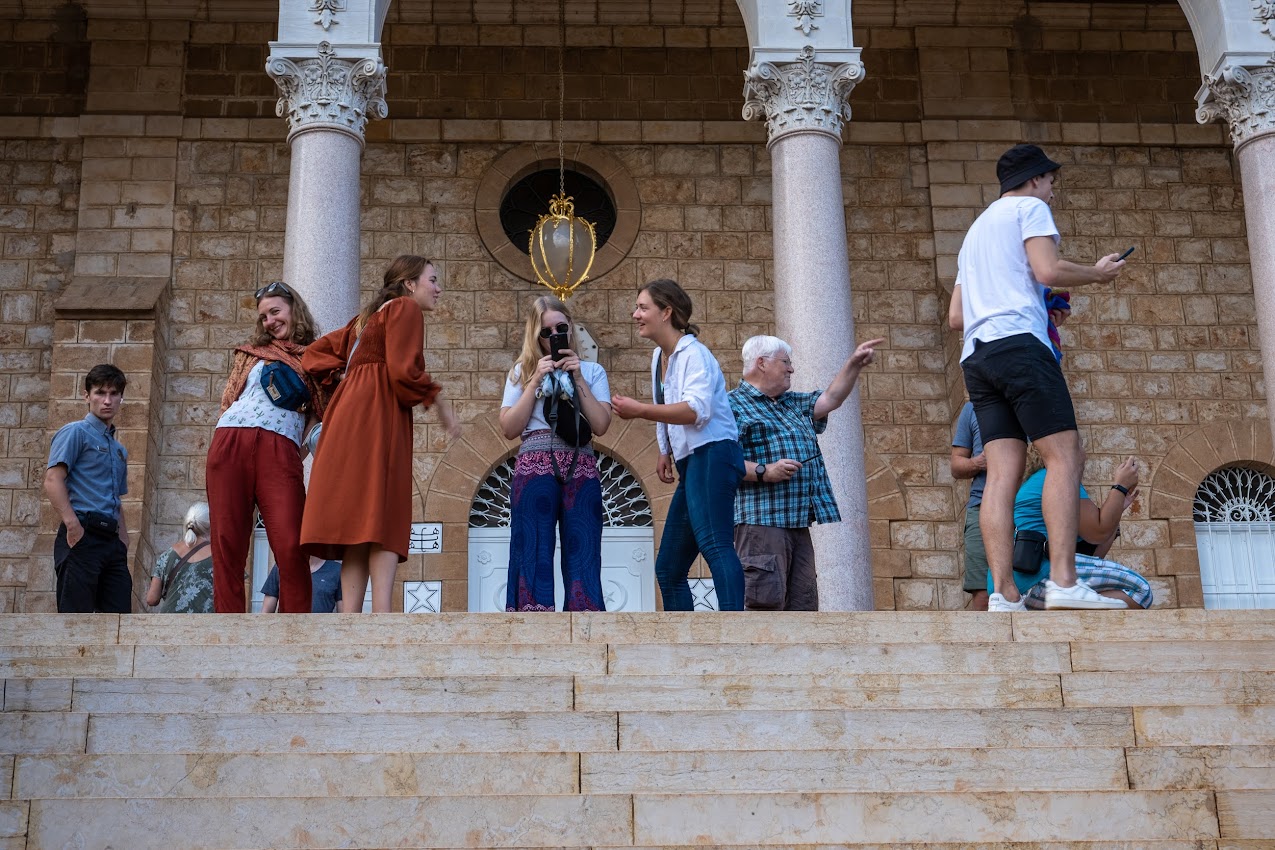
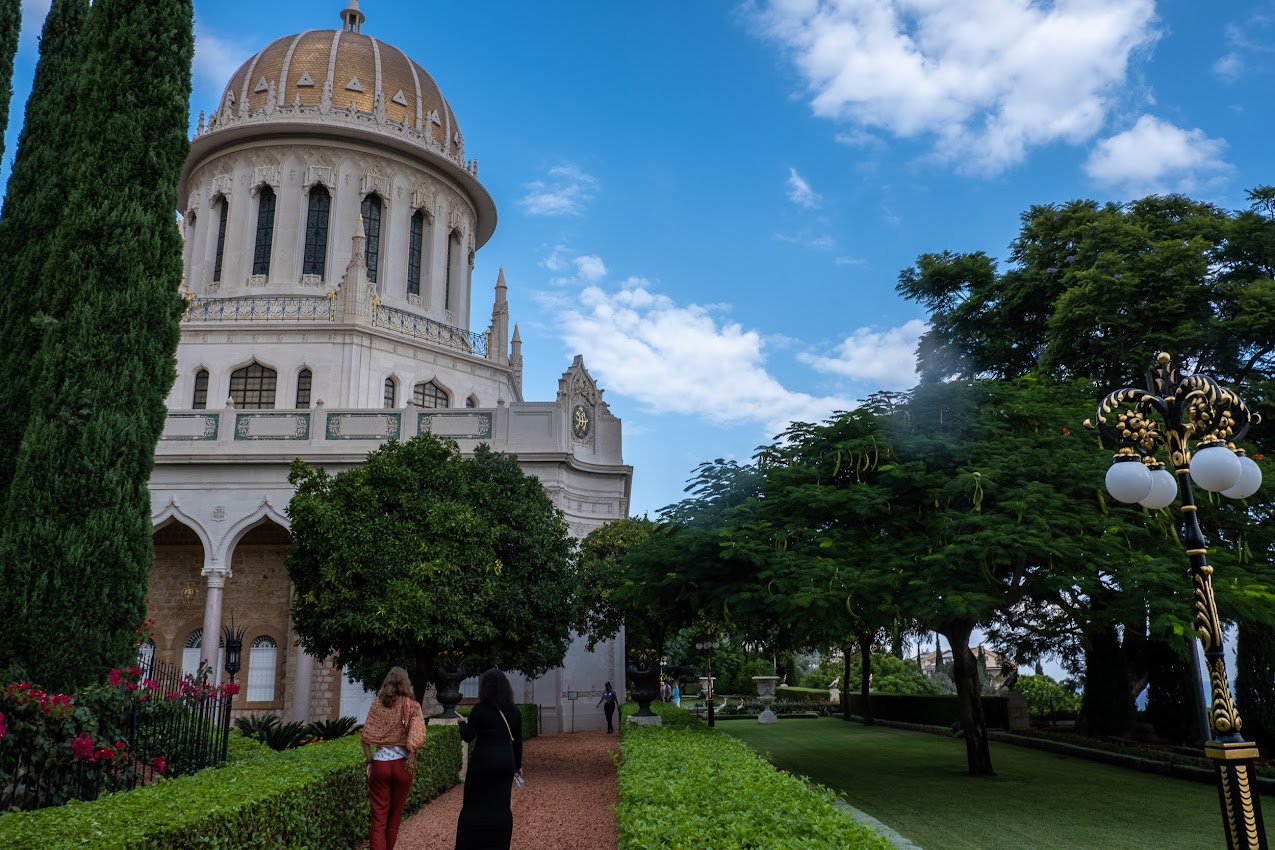
Inside the garden and the shrine of the Bab
We left this impressive Haifa landmark and drove to the chalk cliffs of Rosh haNikra on the Mediterranean Sea on the Lebanese border, where we took a cable car down to visit the grottoes after a short movie, where in many places you can see the sea crashing against the white cliffs and making the water appear beautifully turquoise. We went briefly to the strictly guarded border fence, where you can see the military base of the Israelis. The Israeli soldiers seemed very relaxed this time and even allowed themselves to be photographed. From here, the Lebanese terrorist organization Hezbollah sometimes fires rockets at Israel, but almost all of them are intercepted by the Iron Dome missile defense system.
Rosh haNikra (Head of the Rock Cave) is a place on the Mediterranean Sea near Naharija in northern Israel, just on the Lebanese border. On this site, since the early Bronze Age, there was a place called Misrephoth-Maim in the Bible (Joshua 11:8; 13:6). As early as 332 BC, on the orders of Alexander the Great, a first tunnel was dug through the rock to create a passage for his troops on their way back from the city of Tyros. At the time of the British Mandate for Palestine, a first paved road was built that passed through the rock. Border posts and customs office were also installed. During World War 2, the British drove a 250-meter tunnel through the rocks for the Haifa-Beirut-Tripoli rail line to send war materials north from Egypt. During the 1948 war for Israel’s independence, the railroad bridges were blown up by the Israeli Palmach in the Grottoes to prevent a Lebanese invasion through the tunnel. Because of the border, a wall separates the tunnel into an Israeli part about 200 meters long and a Lebanese part about 50 meters long. In an attack by terrorists on an Israeli bus near Rosh haNikra in 2002, 6 Israelis were killed and at least 7 others were injured.
Since 2021, the German warship “Magdeburg” has been leading the international UNIFIL mission there to help Lebanon monitor maritime traffic and stop weapons smuggling.
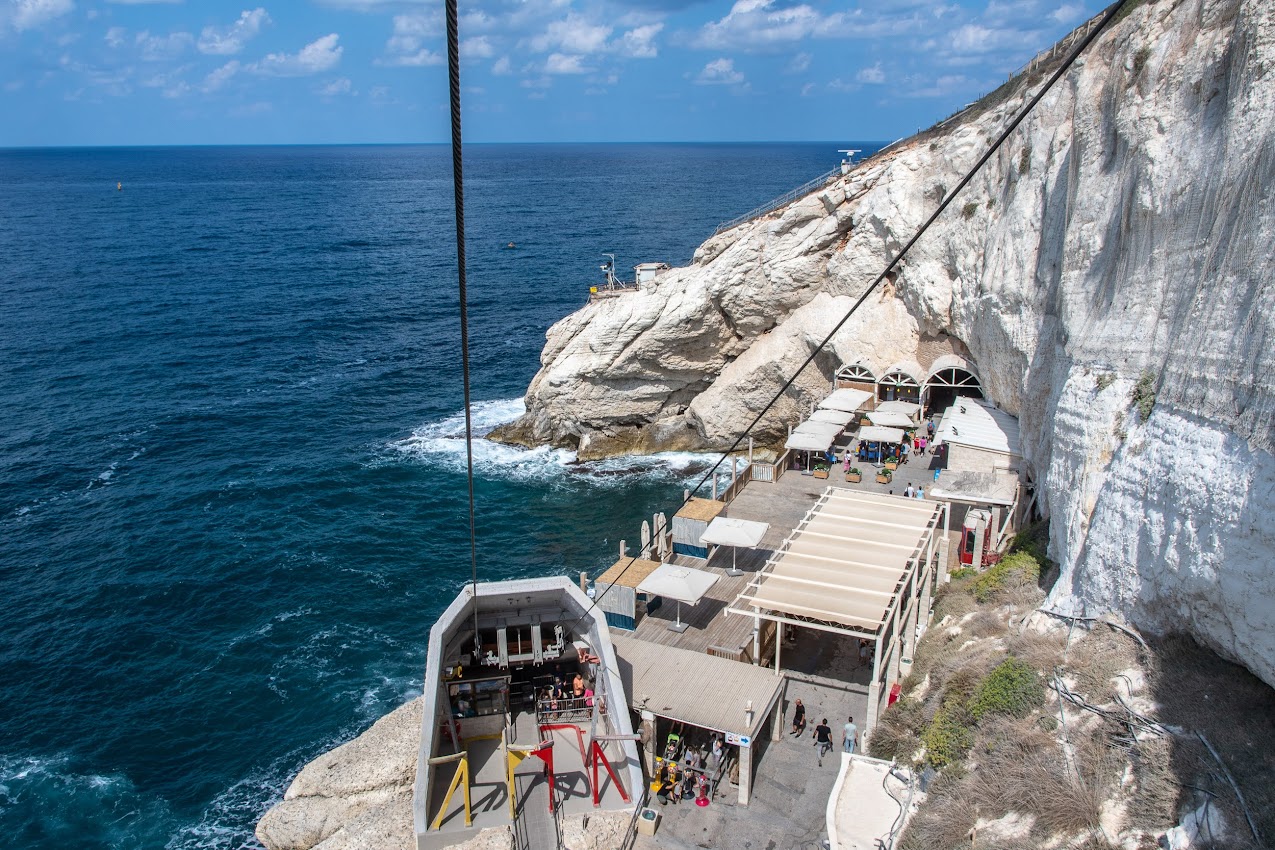
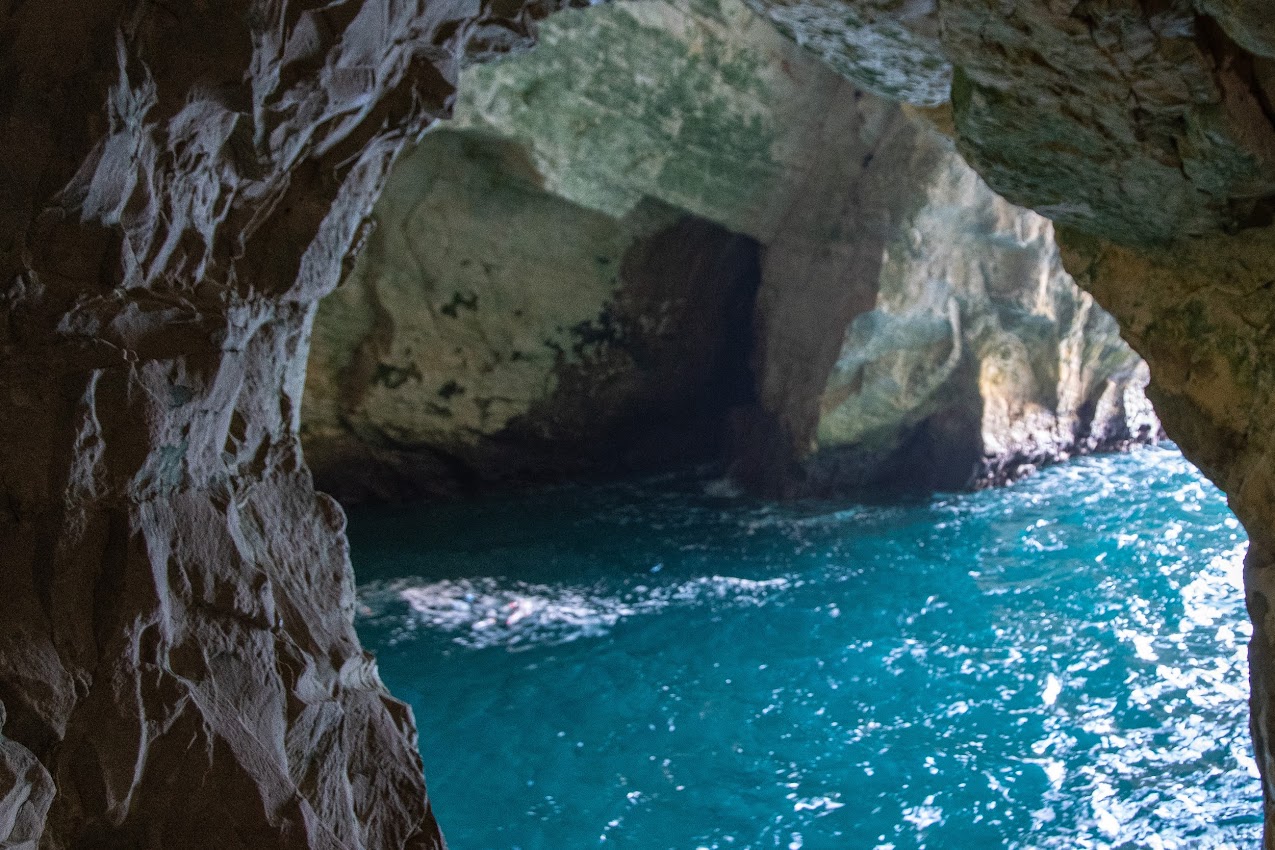
Rosh haNikra: by cable car down to the chalk cliffs and grottoes on the Lebanese border
Due to time constraints, we forwent a short visit to the Christian Kubbuz Nes Ammim and drove directly to Akko. After a snack, we first toured the impressive and extensive underground Crusader city following a short film about the diverse history of Ako, although only about 10% of the city has been excavated and is accessible. Afterwards we went to the still well preserved remains of the city wall, where you can still see the cannons left behind by Napoleon. Afterwards we visited the beautifully decorated Ahmed-el-Jazzar mosque, before we set off on a lengthy search, thanks to Google Maps, for the Templar tunnel, which connects the Crusader city underground with the port. The signs at every corner to this tunnel were also very confusing. Finally, we arrived through this tunnel to the port, where everyone could explore the old town and the souk on their own.
Acre is an ancient port city in the northern district of Israel on the coast of the eastern Mediterranean Sea. The old town is surrounded by a strong fortification. On the land side, the old town is enclosed by the new town. While the population of the New City is majority Jewish, the Old City is inhabited almost exclusively by Israeli Arabs and is one of the most oriental cities in Israel. The port of the city, which for several centuries was an important port of the eastern Mediterranean, has now lost much of its importance. Of economic importance today is the industry, especially iron processing.
From the 1st yr. v. BC, Acre, which had already existed since the Bronze Age, belonged to the sphere of influence of Tyros. After extensive destruction and numerous reconstructions, Akko again achieved economic prosperity under Persian rule. In 64 BC the city was captured by the Romans and became part of the Roman province of Syria. During the Islamic expansion, the city came under Arab rule in 638, which lasted until 1104. In the Middle Ages, Acre was the only port on the Levant coast where goods could be unloaded in any weather, which is why it was of particular strategic importance to the Crusaders who conquered Acre in 1104. During the Crusades, the seat of the Latin bishopric of Acre existed here, founded in 1135. In addition to pilgrims on their way to Jerusalem, Christian merchants also used the port to trade goods from Damascus, some 180 km away.
In 1187, besides Jerusalem, Acre was also reconquered by Sultan Saladin. After a bitter and long siege, the city finally fell again to the Crusaders, who had received reinforcements from the 3rd Crusade under Richard the Lionheart. Since Jerusalem remained in the hands of Saladin, Acre now became the capital of the Kingdom of Jerusalem. The Order of St. John and the Order of the Temple also moved their headquarters to Acre as a result. In 1190, during the siege of Acre, merchants from Lübeck and Bremen founded the Teutonic Order (Teutonic Knights) as a hospital community. In 1198 it was transformed into a knightly order, with Acre becoming the official seat of the Grand Master.
After the final conquest of Jerusalem by the Muslims in 1244, Acre was one of the last bases of the Crusaders until Sultan al-Ashraf Chalil captured the city in 1291. With the loss of Acre, the resistance of the Crusader states was broken and the Crusades failed. Sultan al-Ashraf Chalil had the fortifications ground down so that the Crusaders would never again be able to establish themselves on the coast. In 1517, under Sultan Selim I, Acre became part of the Ottoman Empire. In 1799 Acre was besieged by Napoleon for 61 days to no avail. Cannons left by him still stand on the ramparts.
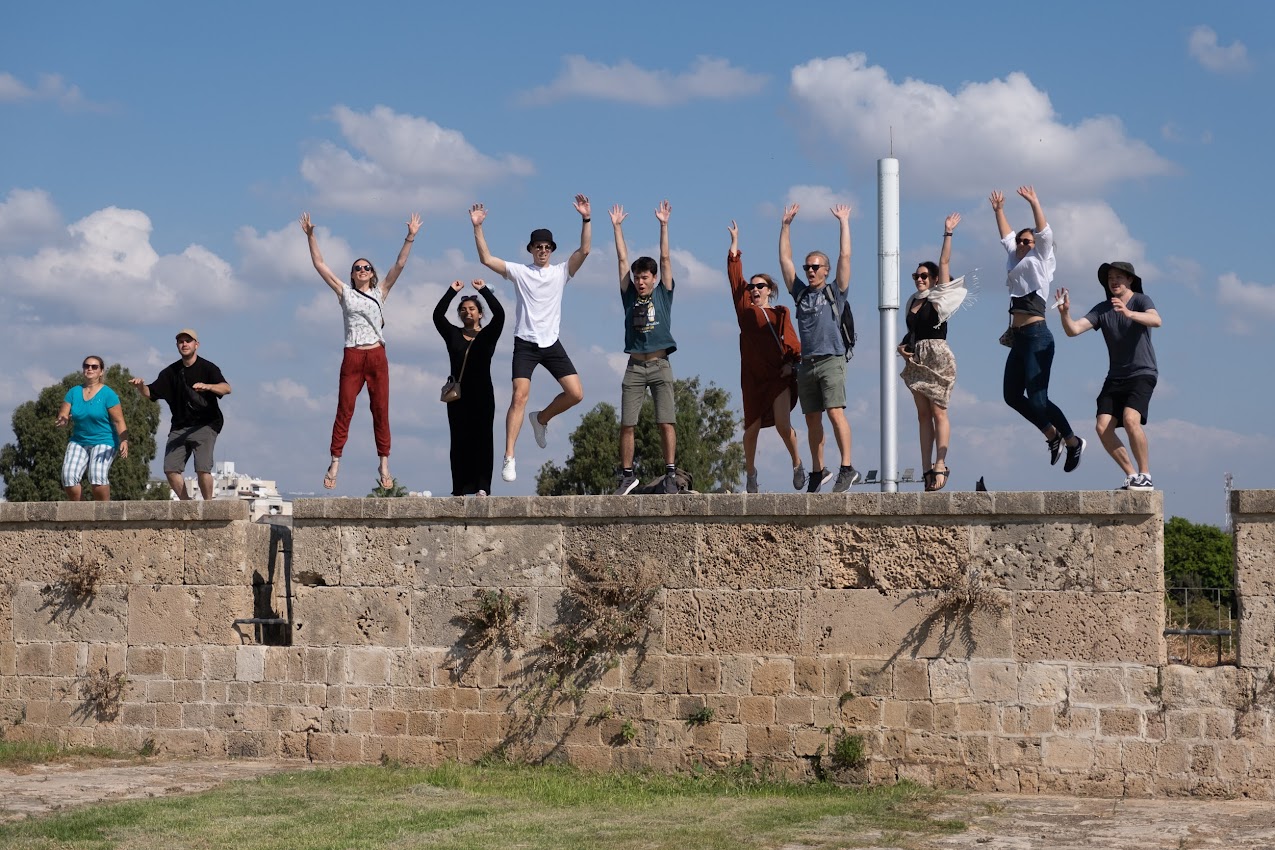
Fortress ramparts
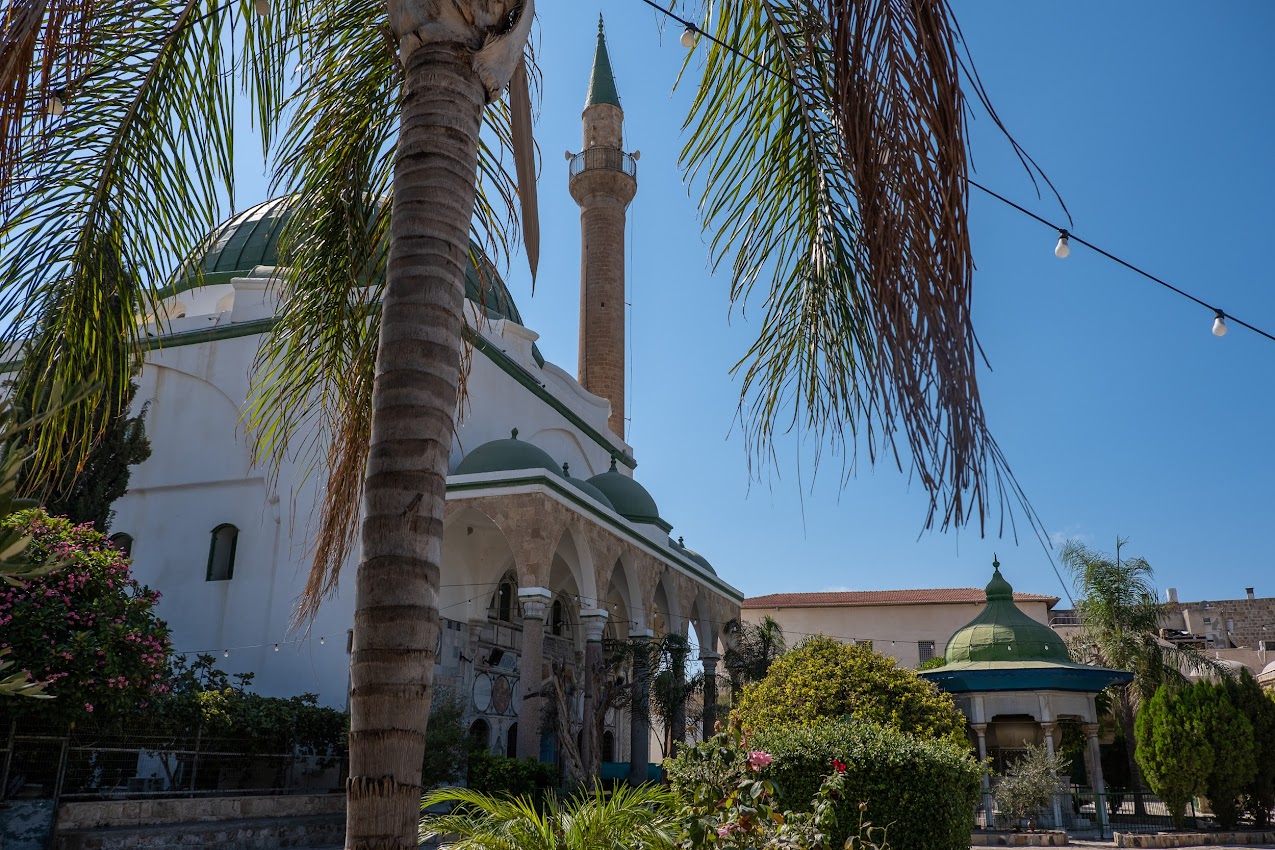
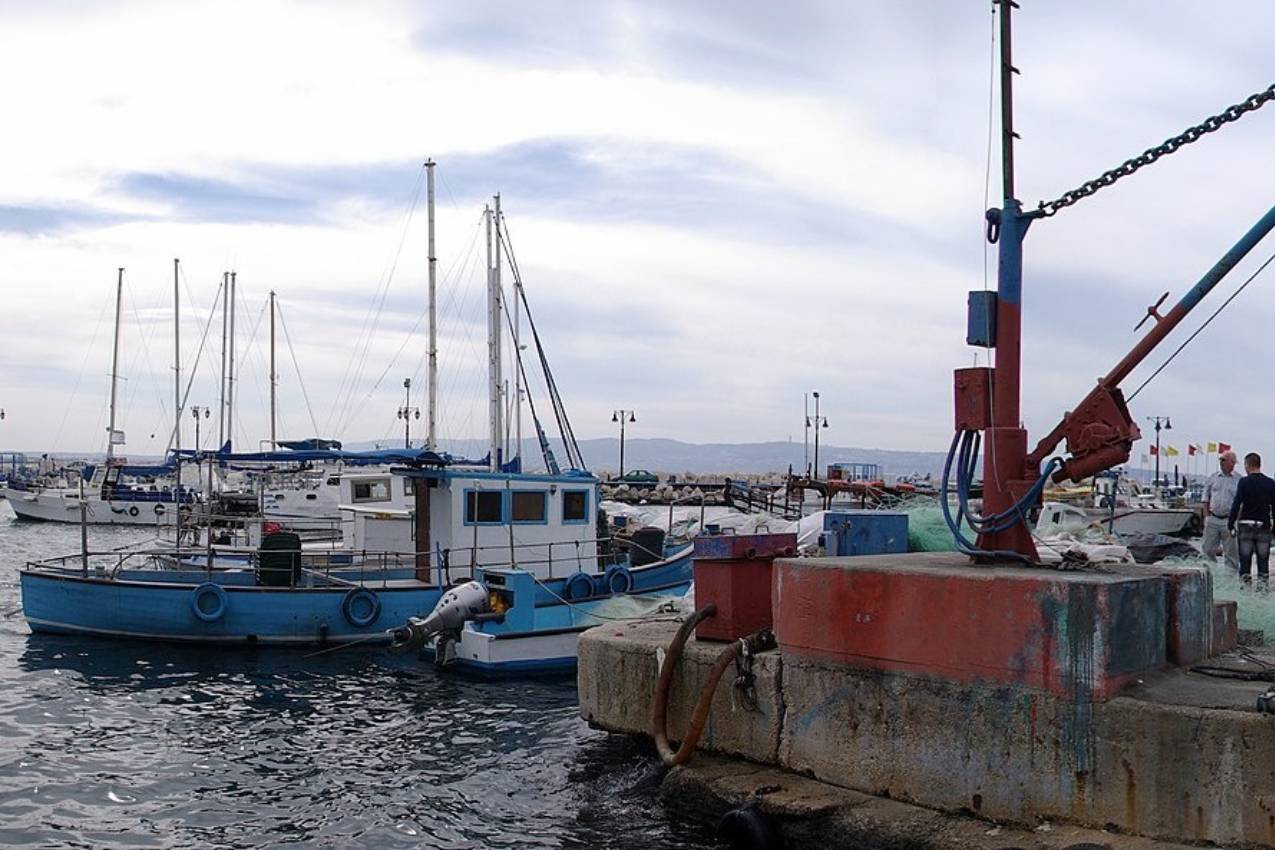
Ahmed el Jazzar Mosque and Acre Port
We then drove to Tiberias on the Sea of Galilee, where we checked into our Aviv Holiday Flat accommodation and enjoyed the great evening buffet. After dinner, we took a walk along the lakefront before we all sat down on the huge balcony that was part of several of our rooms and ended the day.
Tiberias
The city was built by Herod Antipas from the year 17 and replaced Sepphoris as the capital of the Tetrarchy of Galilee – Perea in the year 19 AD. The name was chosen by Herod Antipas in honor of the Roman emperor Tiberius. The city was built in Roman-Greek style with palaces and typical Roman buildings such as forum, theater and racecourse. In the process, the Jewish cemetery of the neighboring town of Hammat was built over, which is why the town was initially avoided by observant Jews as “unclean”. According to early Christian sources, John the Baptist was executed in Tiberias before the year 30 AD. After the destruction of Jerusalem in 70, the city soon became the spiritual and religious center of the Jews. At the beginning of the Islamic expansion, the city was conquered by the Muslim Arabs in 637. However, it continued to be inhabited by Jews. In 1099 the Crusaders conquered the city, which they used as a base after fortifying it with a city wall. Tiberias formed the center of the principality of Galilee within the kingdom of Jerusalem. In 1187, after a short siege, the city was conquered by Sultan Saladin, with only the citadel of Tiberias still offering resistance. The combined army of the Crusaders was crushed in battle at nearby Hattin, so the city once again fell to the Muslims. After several destructions, only a few remains of the ancient city, such as the amphitheater, are preserved. Noteworthy are the hot springs in which you can bathe in some hotels in Tiberias.
Day 10: Monday, 10.10.: Tiberias – Tabgha – Capernaum – Mount of Beatitudes Golan Heights – Sea of Galilee – Jerusalem
After breakfast, we drove first to the beautiful Tabgha Pilgrimage House of DVHL, which offers a magnificent view of the Sea of Galilee, and from there to the nearby Church of the Multiplication of the Loaves, with its famous mosaic of the multiplication of the loaves.
Bread multiplication church in Tabgha
The Church of the Multiplication of the Loaves is a Roman Catholic church located in the western part of Tabgha on the northwest shore of the Sea of Galilee and is believed to be the site where the miraculous multiplication of bread and fish took place at the feeding of the five thousand (Matt. 14:13-21). The present church belongs to the Benedictine Priory of Tabgha and was built in 1982 in Byzantine style. Previously, in the same place there were two predecessor buildings from the 4. and 5th c. The whole complex of the Church of the Multiplication of Bread was originally covered with mosaics. These mosaics from the 2nd Byzantine construction are preserved. Very famous is the mosaic on the altar, which depicts a basket with 4 loaves (the 5. bread is analogously the one used in the Eucharist) and a fish to the left and right of it. In 2015, the atrium of the Church of the Multiplication of the Bread was seriously damaged by arson (see above, Day 1, Latrun Monastery) Directly attached to the church is the Benedictine Priory belonging to the Jerusalem Dormitio Abbey. The Beit Noah Center for the Disabled and Youth is also located on the premises.
Afterwards we went to Capernaum, also called the “City of Jesus”, because Jesus stayed here often and stayed in the house of Peter’s mother-in-law. After visiting, among others, the synagogue and the House of Peter, including the modern church built above it, we went to the lakeside to enjoy the wonderful view of the Sea of Galilee.
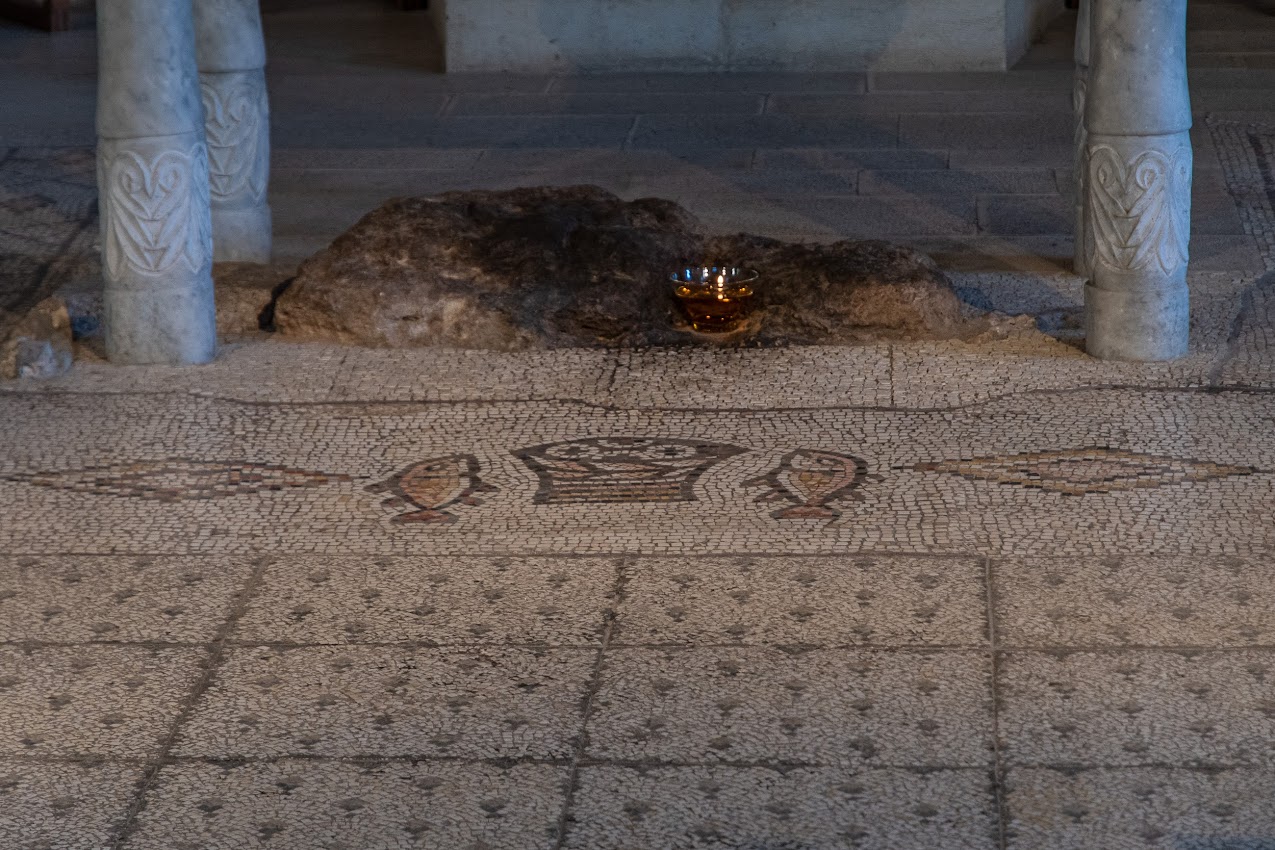
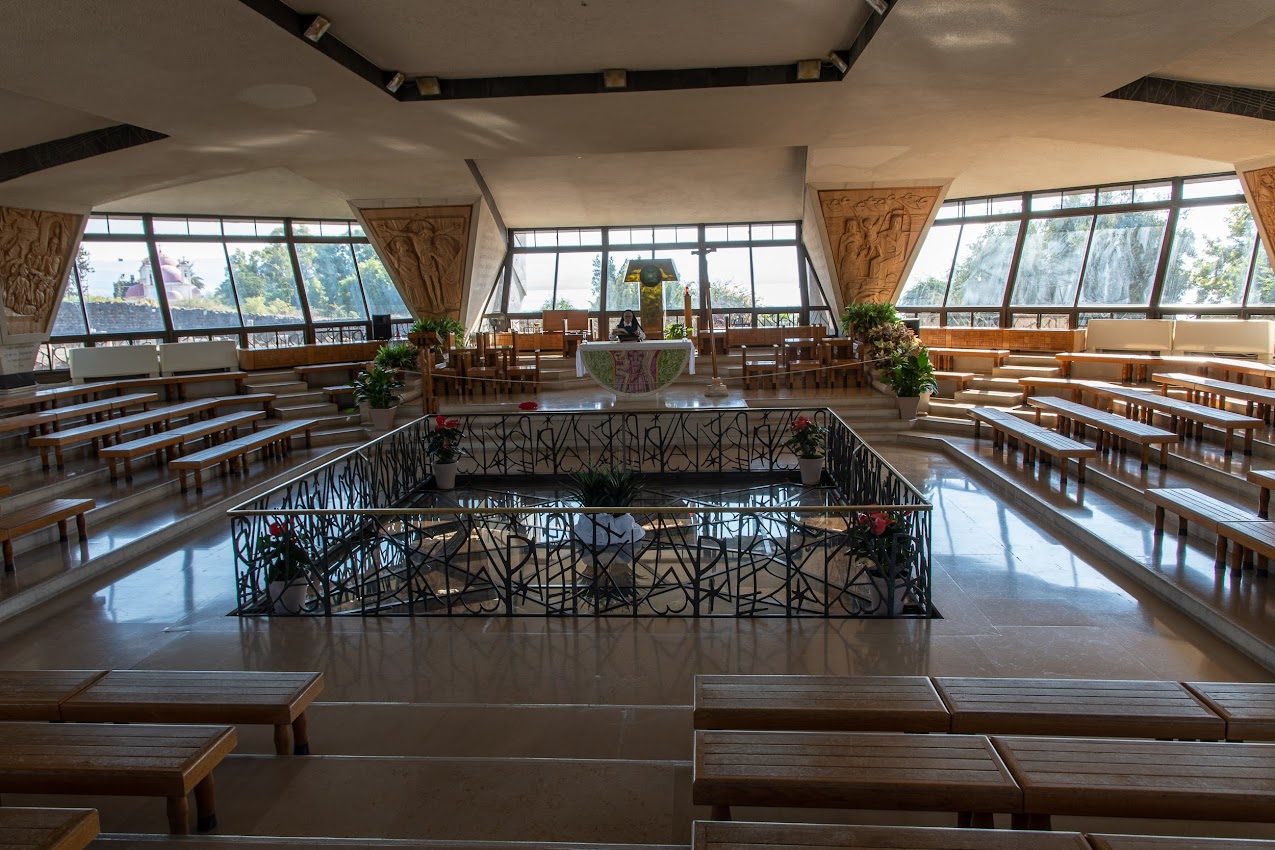
Tabgha: church with mosaic of the multiplication of bread and Capernaum: church over remains of “Peter’s house
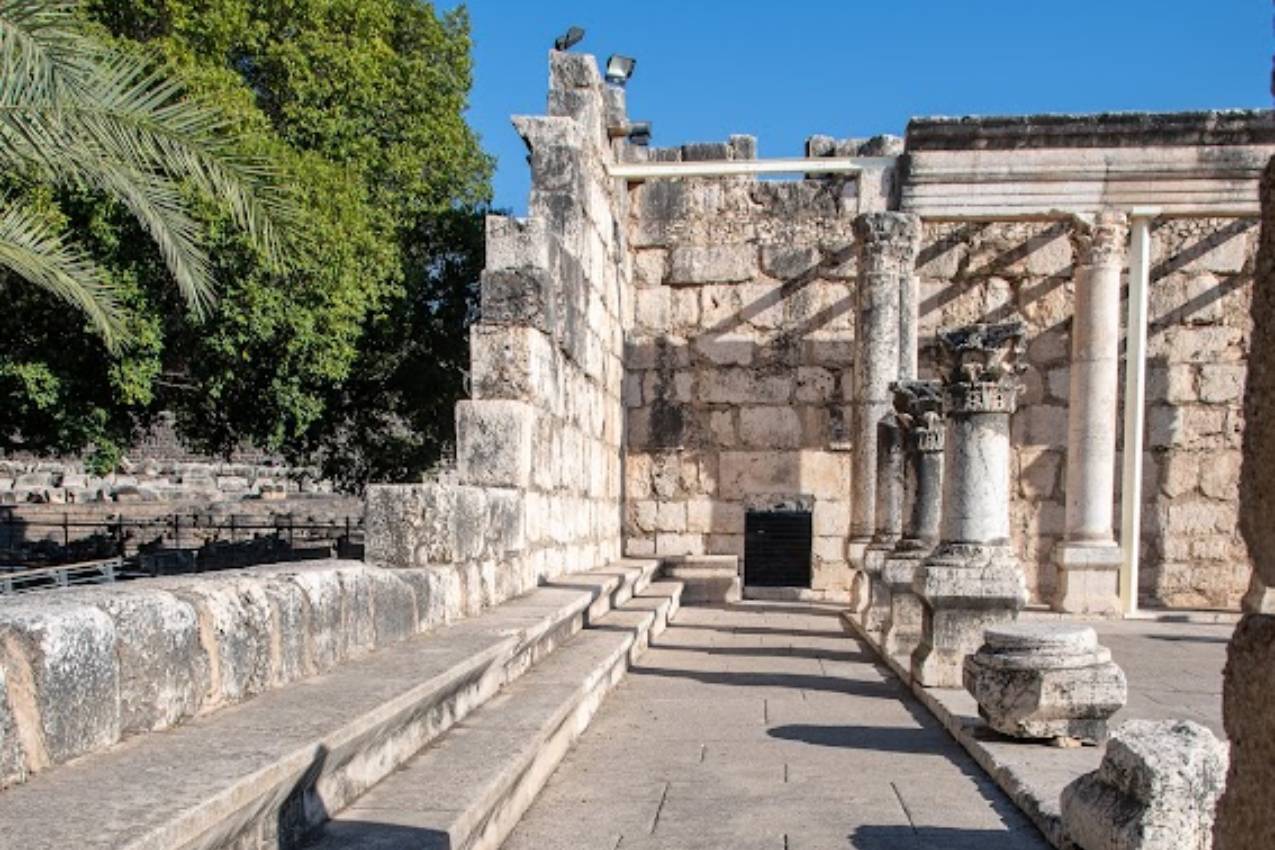
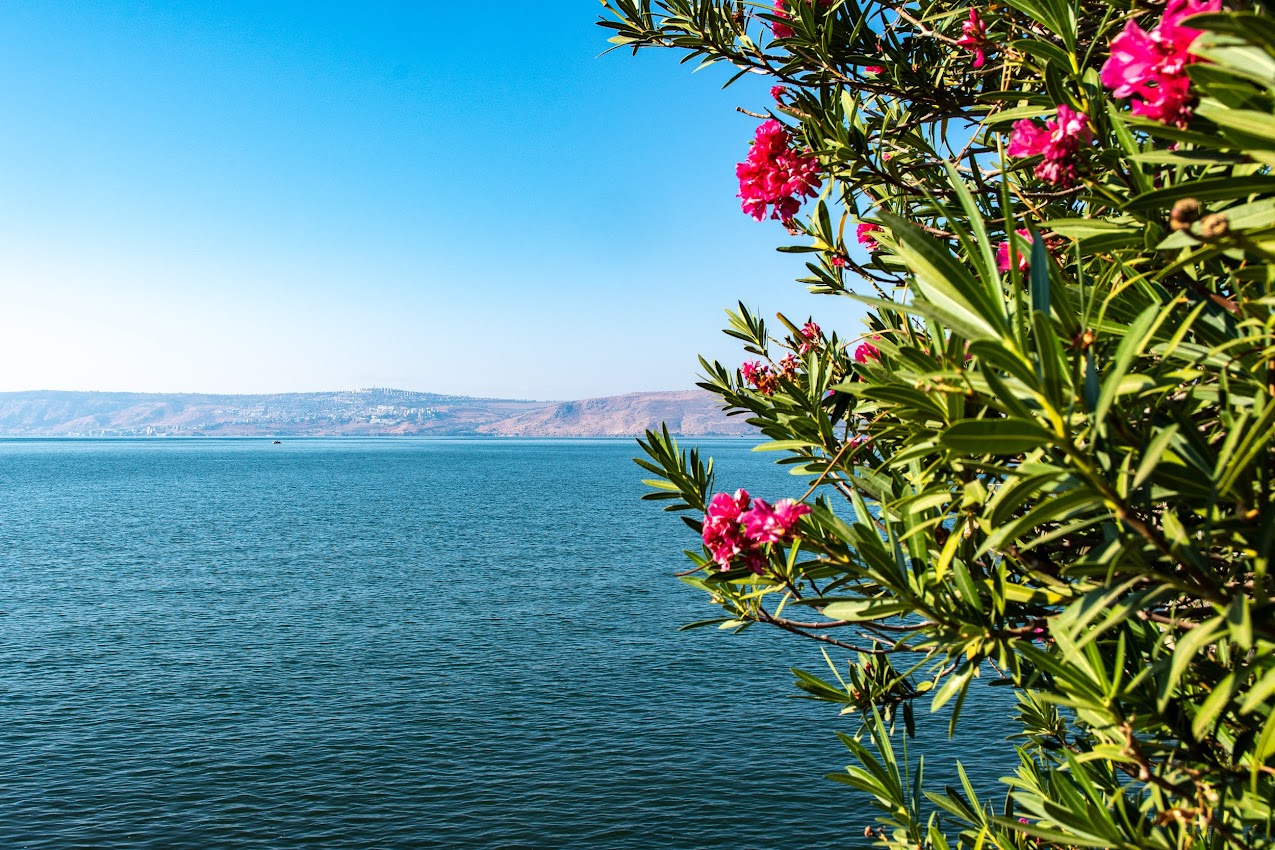
Capernaum: synagogue and view of the Sea of Galilee
Capernaum
Cafarnaum is an archaeological site in the northern district of Israel. It is located on the northwestern shore of the Sea of Galilee. Cafarnaum was a Christian pilgrimage destination in late antiquity as a setting for New Testament stories, and became so again in the 20th century. The area of the archaeological site is about 5 hectares; the western part is owned by the Franciscan Custody of the Holy Land, and the eastern part belongs to the Greek Orthodox Patriarchate of Jerusalem. On display are, among other things, remains of ancient housing and a representative synagogue from the beginning of the 5th century. The black stone foundations below are remains of the 1st century synagogue where Jesus taught, and a “House of Peter,” the latter built over by a modern Roman Catholic church. Archaeologists suggest that the house church is on the site of an early Christian meeting room from the late 1st century AD and ultimately dates back to the house of Simon Peter, which is also mentioned in the New Testament. This is evidenced by chalk inscriptions that name Jesus with titles of highness as well as Peter and show traces of cultic gatherings. They date back to the 3rd century at the earliest. For the assumed early Christian meeting room of the 1st century it can be argued that it was plastered more frequently than other, neighboring rooms, thus possibly being particularly valuable for the inhabitants of Cafarnaum at that time. Furthermore, an inscription was found where the words “Petr esti” are still legible. I think that where it says Petrus on it, there was also Petrus in it.
Excursus: What is historical in the Old and New Testaments?
3.1. The Old Testament (OT) respectively the 5 books of Moses (Torah)
For traditional, fundamentalist, evangelical and similar Christians, the Bible is the Word of God and therefore every word is true (as was generally the case until the Enlightenment and, of course, as is still the case today with the Koran among traditional Muslims).
However, already the Vatican Council II stated that the Bible is “man’s word”, but divinely inspired. One distinguishes with AT and/or Tora today basically 4 different groups of authors: The Jahwists (J) are the oldest, then follow the Elohists (E), (Ur-)Deuteronomium (D) and finally the Priestly Scriptures (P) from the Babylonian exile period around 550 B.C. Most scholars assume that the Torah (= The 5 Books of Moses of the OT) was completed only some time after the return of the Jewish scribes of the upper class from the Babylonian exile ordered by the Persian King Cyrus in 539 B.C. and after the rebuilding of the Jerusalem Temple from 517 B.C. by these Jews who had returned from Babylon. The destruction of the 1st Temple in 586 BC was seen by this priesthood as God’s punishment for the Jews’ violations of God’s commandments. In the Torah there are very many examples of God’s help, but also punishment towards His chosen people. The intention of the authors of the Torah was to encourage the Jews to live a God-fearing life – not to write a historically accurate history book.
Of course, there are also many historical events in the OT, but often changed in favor of a clear message. According to the leading Israeli archaeologist Finkelstein, the Exodus from Egypt – in the form described in the Bible – never took place, because there was never a forcible taking of land. Nor was there a united kingdom under a King Saul, a King David or a King Solomon. Rather, in the stories of these biblical kings, epochs of ancient Israelite history that were centuries apart were processed into a coherent myth – and thus given a deeper, religious meaning. Rather, they see the basis for the biblical account of such a great empire only in the kingdom of Jeroboam II in the 8th century B.C., who is said to have temporarily turned the northern kingdom of Israel into an important regional power.
There is circumstantial evidence for the historical existence of both Solomon himself and the Queen of Sheba, but this also dates back to the 8th century. v. Chr. David is probably a historical figure (In the north of Israel a stele from the 8th century has been found, where at least a “House of David” is mentioned), but was probably not a king, but rather a gang leader of the Hapiru (= Hebrews). Meanwhile, the existence of the 12 tribes of Israel is also doubted.
The Israeli historian Shlomo Sand (“The Invention of the Jewish People,” published in German in 2009) ends his groundbreaking book with a plea for a state of Israel in which citizenship no longer refers to religion and ethnocracy becomes a true democracy, so that Jews and non-Jews can live side by side on an equal footing. The above mentioned historical facts are so important especially in Israel-Palestine, because among others the myths of the glorious “kingdoms” of David and Solomon are used by orthodox Jews and radical settler groups to justify (unjustified) legal claims against Palestinians among others in Jerusalem and furthermore Israel defines itself as a Jewish and democratic state, which is already a contradiction in itself.
There can only be a real peace solution in the Middle East on the part of Israel if it frees itself from these myths and contradictions. However, this also applies equally to the Palestinians, who must also abandon their highly one-sided view of events since 1948 and unconditionally recognize Israel’s right to exist. But both sides are still miles away from that.
3.2. Excursus: the New Testament (NT) and the historical Jesus
Although there are also some extra-biblical sources about Jesus that attest to his existence, research regarding the life and teachings of Jesus relies virtually exclusively on the 4 Gospels, which, however, are from eyewitnesses and were not written until about 40-65 after Jesus’ death (30 AD), although there were certainly previous records and, of course, oral traditions on which these Gospels are based. Today it is assumed that many statements of the NT are essentially based on historical facts, e.g. the places of his ministry, his central messages, his charismatic appearance, statements about his family and his disciples, his behavior towards women, children, outcasts etc.. If all this were invented, it would be inexplicable why Jesus’ followers were so eager to spread his message and were willing to die for their conviction.
Jesus was a miracle healer and exorcist, i.e. through his sensitive care and touch of seemingly incurable (also psychologically) sick people he brought about their healing, probably also by these sick people taking new courage to live and activating their self-healing powers. As an exorcist, he exorcised the “demons” from mostly probably mentally ill people, by which, according to the widespread belief at the time, people could be possessed and was held responsible for serious illnesses. Jesus obviously healed many people in body and soul (psyche), which was definitely a miracle at that time.
Jesus’ Sermon on the Mount, his commitment to the weak and needy, his commandment to love one’s neighbor, his message that every human being is equally valuable, etc., also show that he is actually a man of the 3rd millennium. When and where Jesus preached what in detail is not decisive, because he surely repeated many messages and parables often, otherwise they would have been forgotten again. Therefore, in the places where Jesus stayed, it is not decisive where exactly he has been (This is especially true for Jerusalem). Jesus was there and proclaimed his still fundamental messages, which unfortunately are still taken to heart far too little.
Whether Jesus is the Son of God is, of course, a matter of faith. However, since Caesar already let himself be called the son of God, I think this was not as unusual for many in those days as it is today.
Whether Mary conceived Jesus as a virgin, as Isaiah prophesied in the OT, is perhaps a question of the translation of the Hebrew word “Alma” (= girl of marriageable age, whether virgin or married). Then in the NT in Matthew there is the Greek word “Parthenos”, which can mean virgin and young woman. Only in the 3rd-4th century AD, when the dogma of the immaculate conception prevailed, parthenos got the meaning “virgin”, i.e. without sexual intercourse.
In today’s Catholic Church, however, these questions are not in the foreground, but especially the questions of women’s priesthood, celibacy, the handling of homosexuality (see above, Day 8) and, of course, a more unbiased, natural handling of sexuality within the framework of our legal system.
1. celibacy
It is only since 1073 that celibacy has been fundamentally obligatory for priests in the Latin particular Church of the Roman Catholic Church. This was done to prevent married clergy from inheriting church property to their children and also to prevent cases of sexual debauchery by priests. So celibacy is not a dogma and could be lifted without any problem.
2. women priesthood
Paul refers to Iounia as a respected apostle in his letter to the Romans. In 2016, Pope Francis paid tribute to Mary Magdalene as the “apostle to the apostles” – a common designation in late antiquity. So if there were already women apostles at the time of Jesus or the early Christians, why should women not be allowed to become priests today? Conservative Catholics or dignitaries put forward the following main arguments:
(1) Jesus was a man. Of course, a prophet and religious leader in those days had to be a man. All ancient religions were founded by men. A woman would not have been accepted at all and moving around with male followers would have been called fornication.
(2) Jesus called 12 male apostles to follow him. The same applies here as for (1). In addition, the 12 apostles were to represent the 12 tribes of Israel, which is certainly not one of the core tasks of priests today.
(3) Only men were present at the Last Supper.
It is correct that women are not mentioned here. However, since it was about a meal, which was probably prepared by women, and women were certainly present at other meals as a matter of course, one can assume that also women, towards whom Jesus always met very respectfully and affectionately, were present at the last supper at least in the same room.
The other arguments are really just misogynistic, which is why I don’t mention them here. Incidentally, if married women priests had been allowed earlier, the abuse scandal would not have reached this scale.
Conclusion:
The Catholic Church should also take an example from Jesus, arrive in the 3rd millennium and orient its way of acting e.g. to the GG (among other things art. 3). It would then be able to cope much better with this crisis, which would otherwise threaten its very existence. Christian values, the exemplary commitment of missionaries, nuns and monks worldwide, and institutions such as Caritas are more necessary today than ever before in view of the strengthening of un-Christian, right-wing populist-fascist parties in the increasingly less Christian West.
Then we drove to the Mount of Beatitudes, where for the first and only time we were surprised by a myriad of large pilgrim tour buses. After visiting the wonderfully decorated church with, among other things, the Beatitudes in Latin, we walked through the breathtakingly beautiful gardens with a magnificent view of the lake.
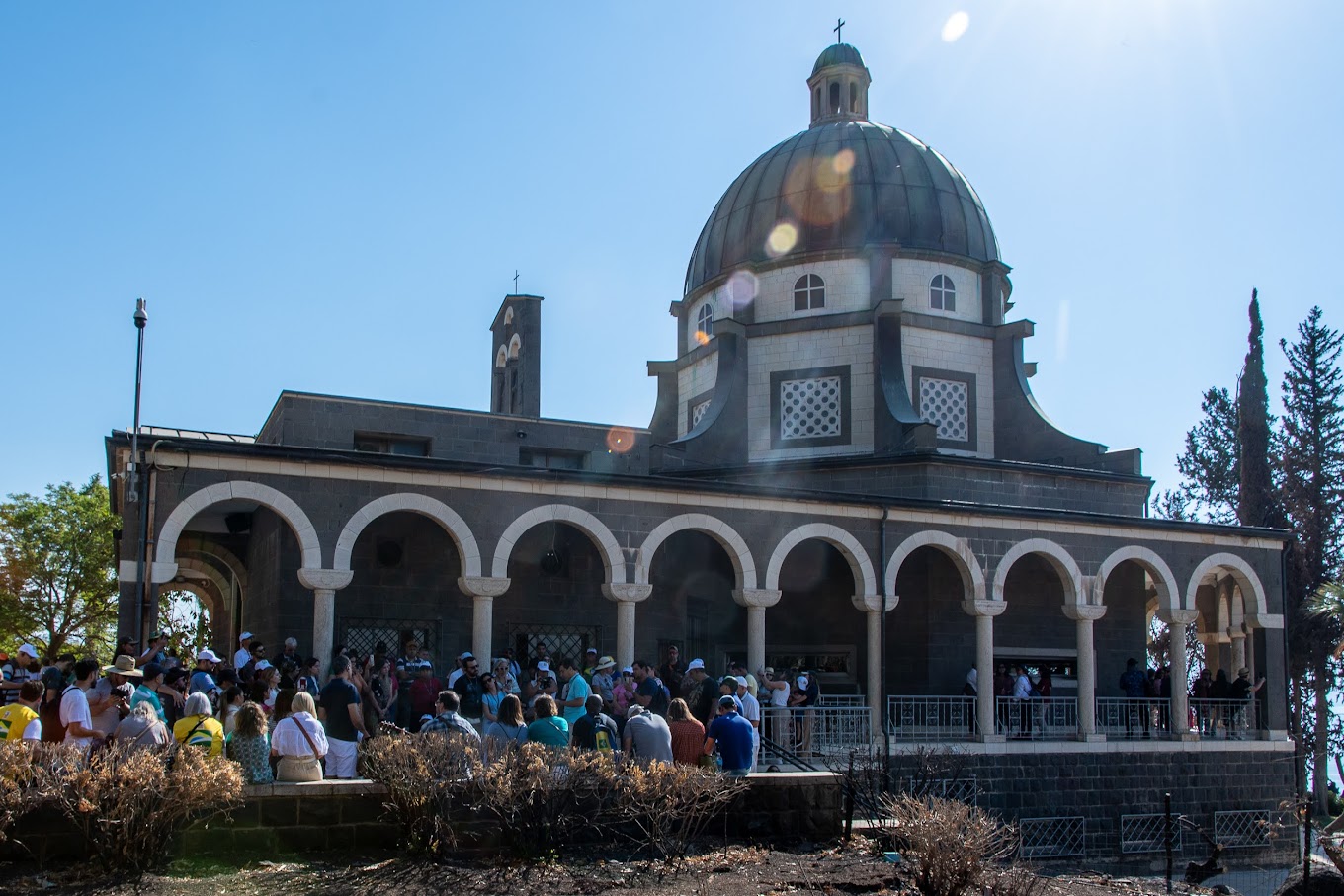
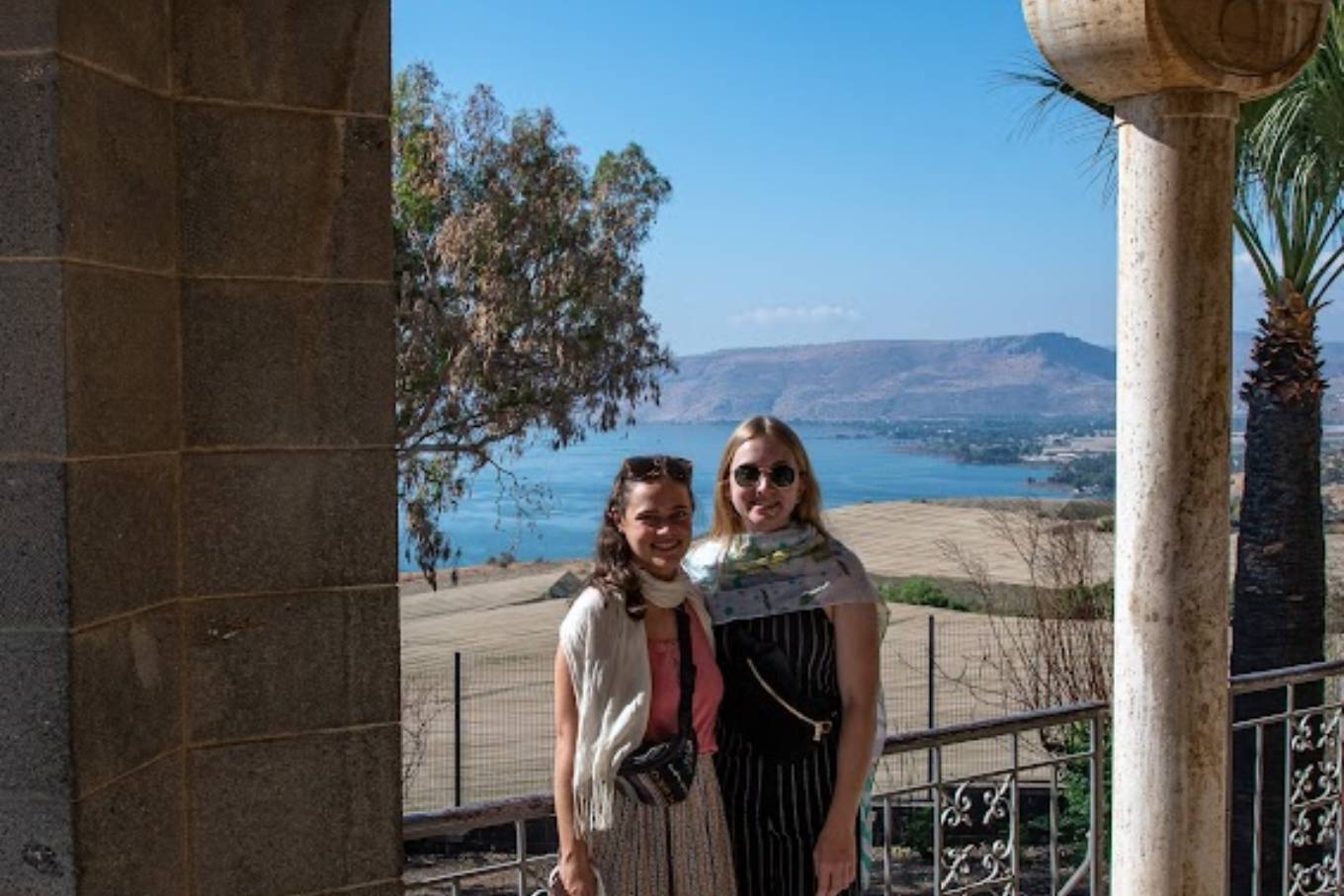
Church on the Mount of Beatitudes and view of the Sea of Galilee
Mount of the Beatitudes
The Mount of Beatitudes is an elevation on the northern edge of the Sea of Galilee. According to Christian tradition, this is the place where Jesus of Nazareth delivered the Sermon on the Mount, which begins with the Beatitudes (“Blessed are …”) (Mt 5:3-12). Moreover, it is here that he is said to have chosen the apostles from among his disciples (Luke 6:12-16). Today, there is a monastery and the Church of the Beatitudes on the hill. The latter has an octagonal floor plan. The church, built in 1937, is also visited for its beautiful gardens and view over the Sea of Galilee.
Then we drove to the Golan Heights and first to the waterfalls of Banias (= Caesarea Philippi), one of the 5 tributaries of the Jordan River, where our TN had their picture taken in front of the largest waterfall.
We then drove along the mined area to the Pan Shrine, 2 km away. It was in this place that Peter confessed Jesus as the Jewish Messiah (Matt 16:16). Jesus then said to Peter: “You are Peter” (= the rock), like this rock here (and he pointed to the rock at the entrance of the Pan sanctuary). “On this rock I will build my church (= ekklesia, by which he meant s/a spiritual community, but by no means the Christian church of today) and the gates of hell (by which he pointed to the cave entrance of the Pan-sanctuary) will not shake it.” A wonderful example of how a word of Jesus can be figuratively attached directly to a concrete place. The Greek god Pan was deeply detested by Jews – like all other gods/idols. After all, Pan became the model of the medieval devil. We drove on, past houses and minefields destroyed and abandoned in the 6-day war of 1967, to the Druze villages, where we had lunch at the parking lot of Birkat Ram at the Druze restaurant Mas’ade by a quarry pond.
Golan Heights
The Golan Heights is a sparsely populated, hilly stretch of land in the Middle East. Internationally recognized as part of Syria, they were occupied and mined by Israel in the 1967 6-Day War and annexed in 1981. In 1967, Israel destroyed 194 Syrian villages and farms with 82,709 inhabitants. Before the Israeli occupation, nearly 130,000 Syrians lived in the Golan Heights; two months later, there were only 6,396. Israel administered the territories as part of its Northern District; however, the annexation was not recognized by most states. Syria still claims the area in its entirety and counts it as part of its al-Quneitra governorate; a narrow buffer zone has been monitored by UN peacekeepers since 1974 (UNDOF). The status of the Golan Heights has been an obstacle to peace negotiations between the two states. During the Syrian Civil War, the region again became a flashpoint with rocket attacks from Syria and Israel. In 2019, the Golan Heights were formally recognized by the United States as part of Israel. Meanwhile, the Golan Heights are now being systematically resettled and used for agriculture.
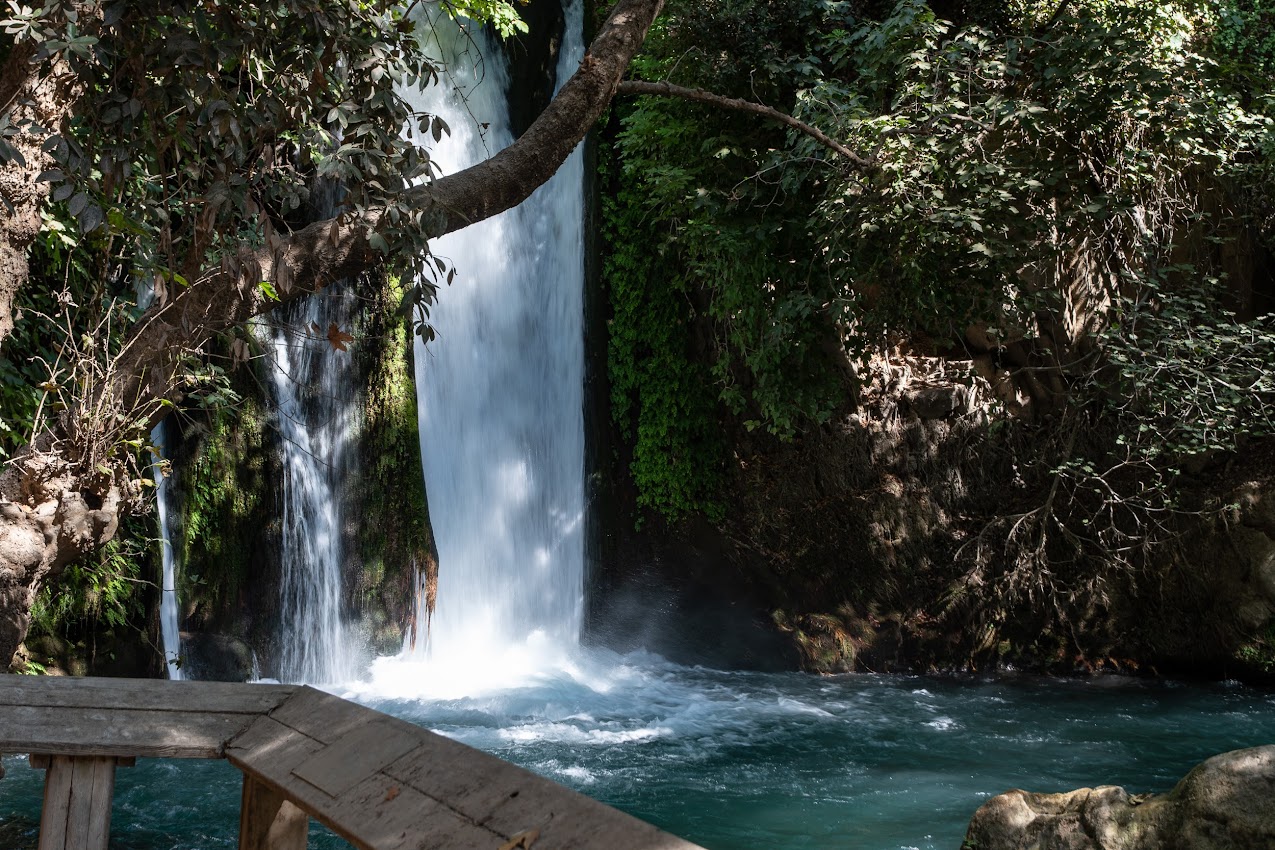
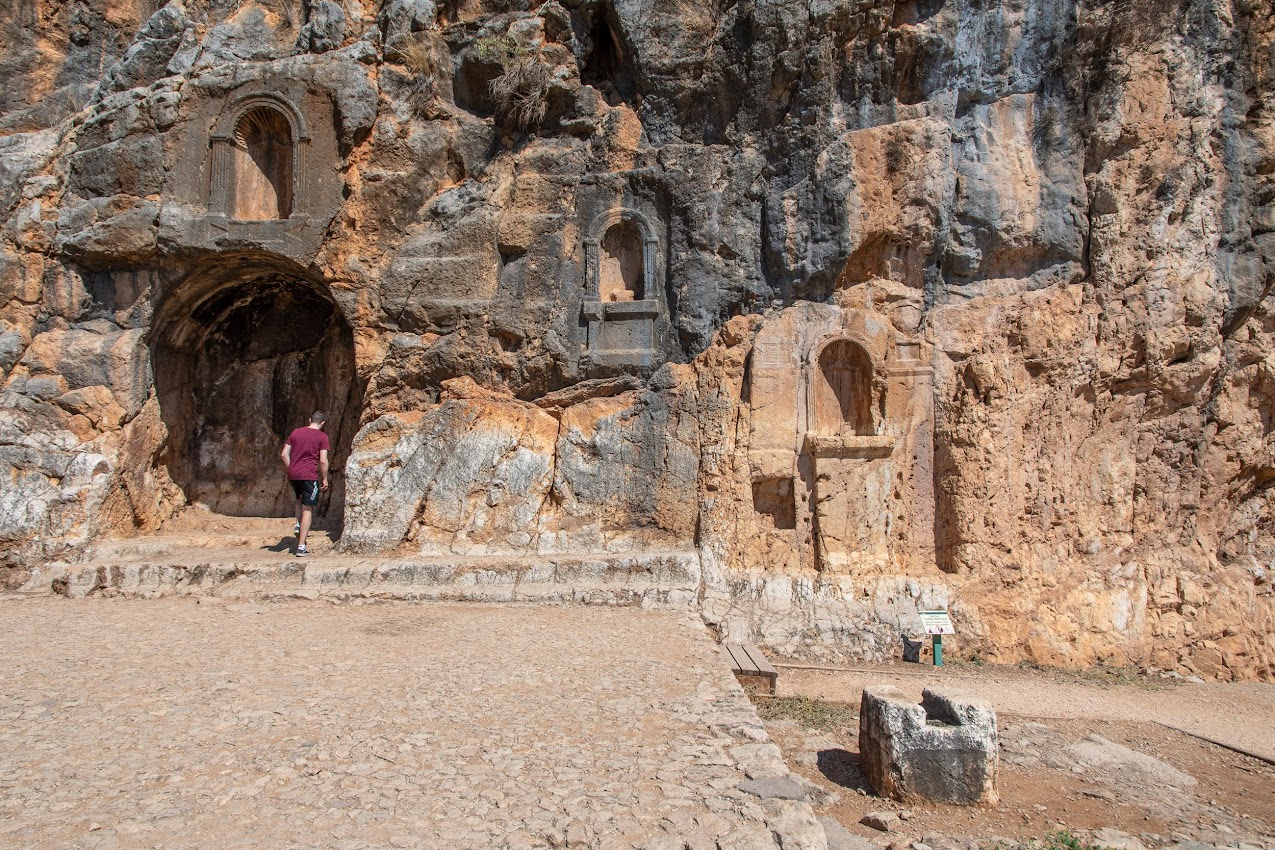
Golan Heights: Banias Waterfall and Banias (Caesarea Philippi): Pan Temple
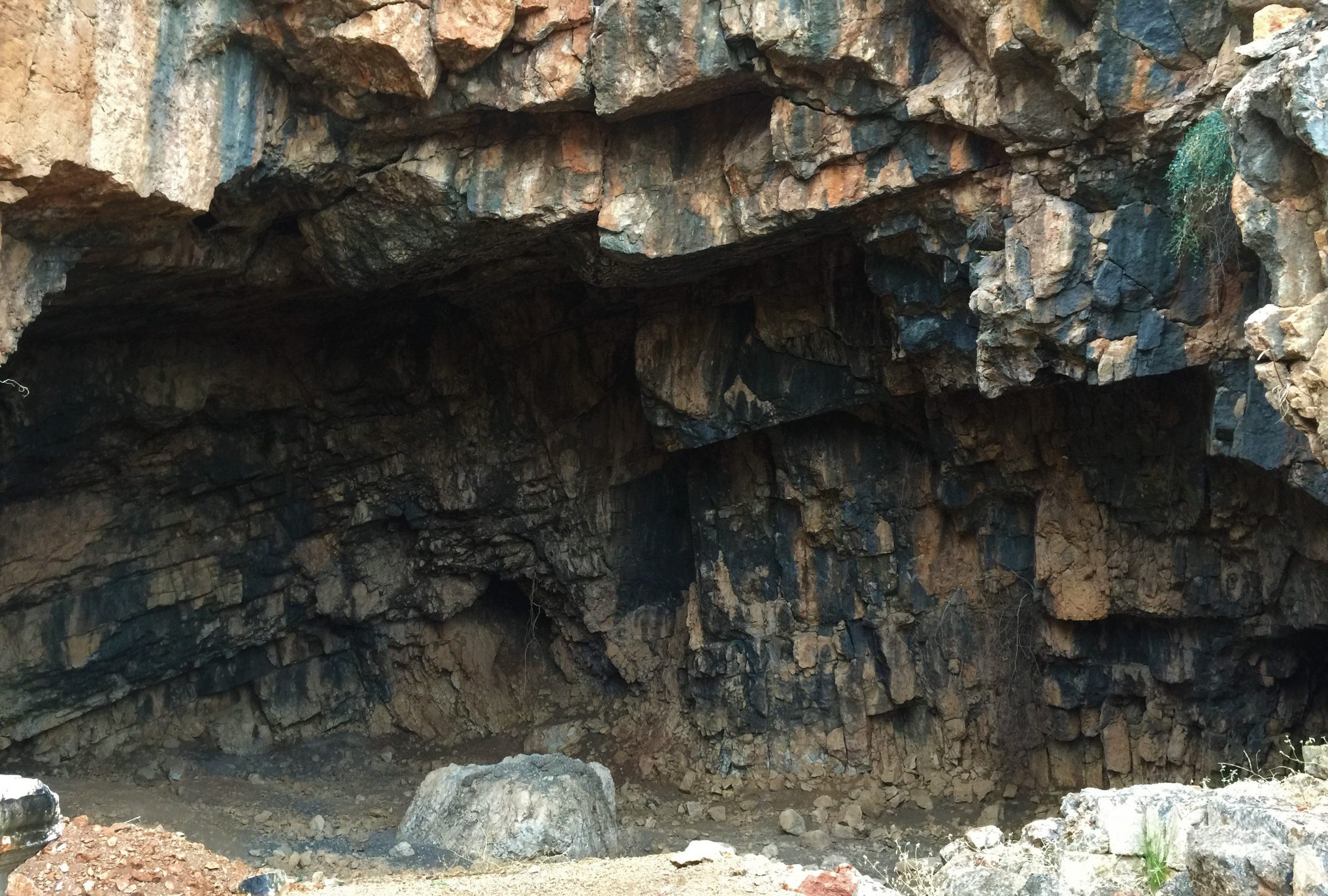
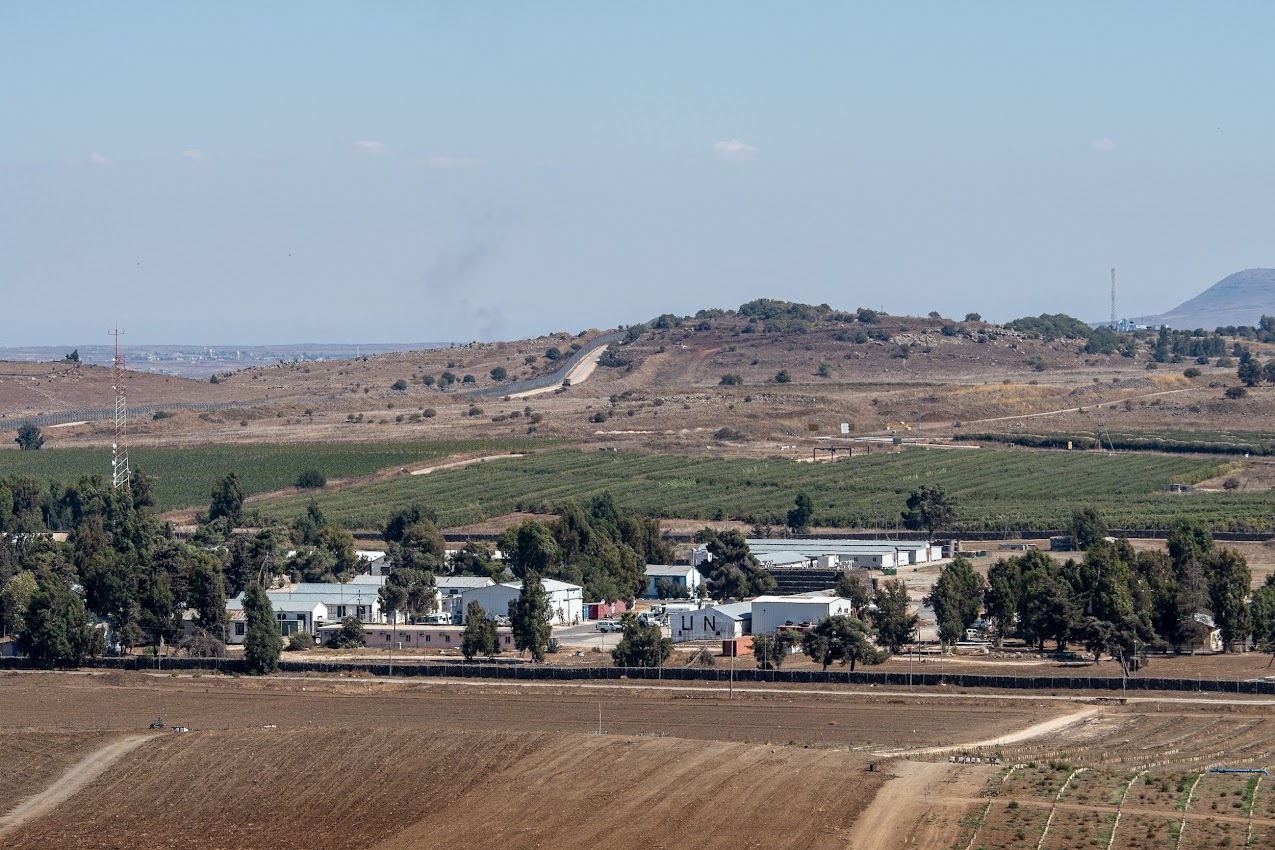
Pantempel: Cave entrance and Kuneitra: UN blue helmet soldiers at Syrian border
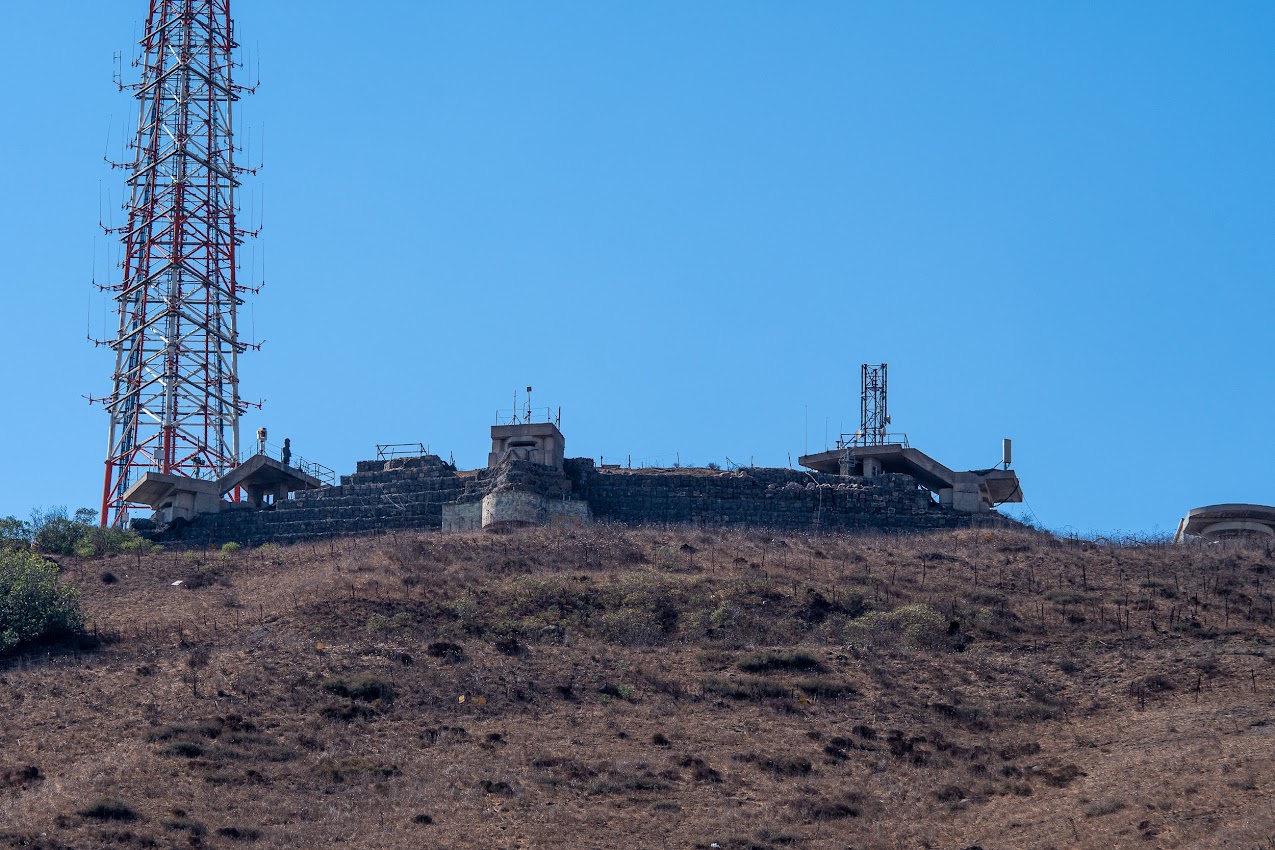
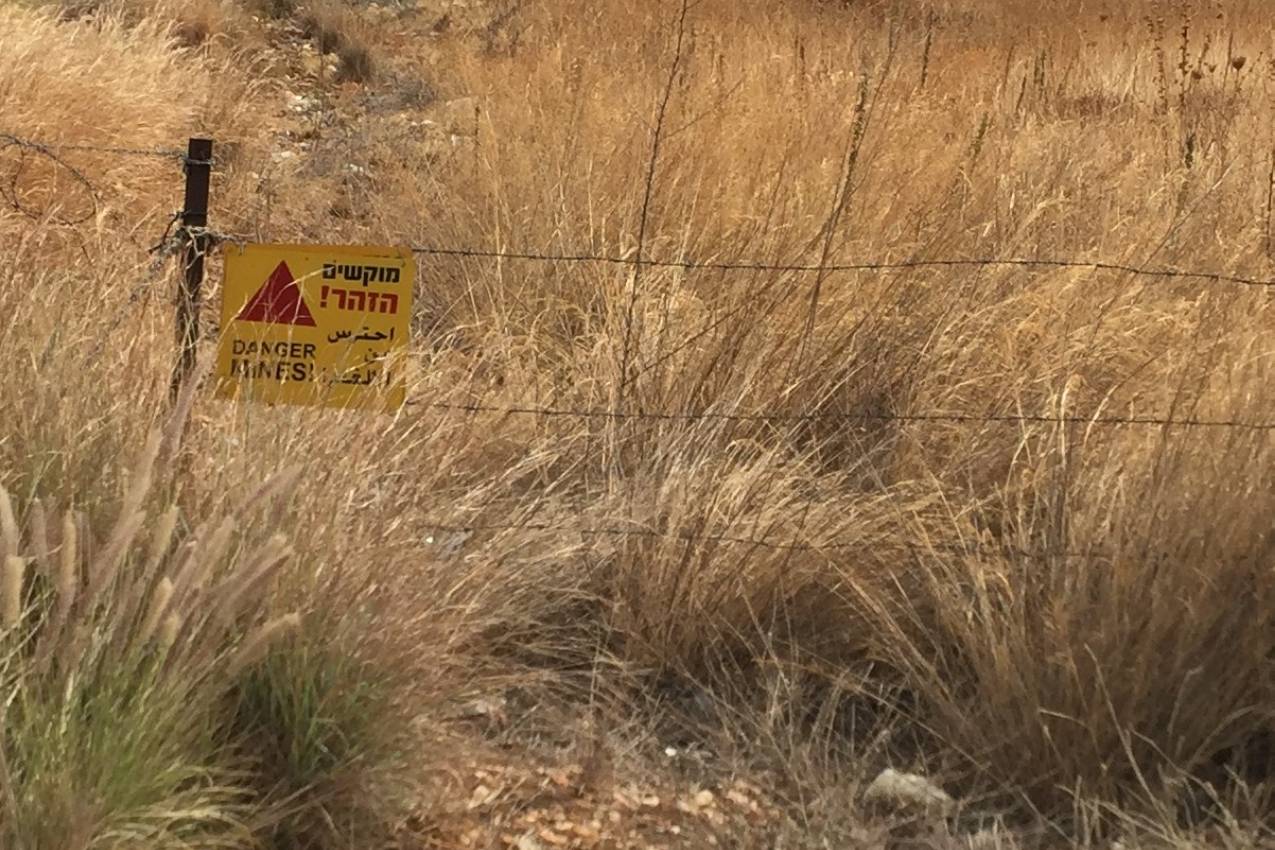
Highly armed Israeli military facility on Syr. Border and Golan Heights: Minefields
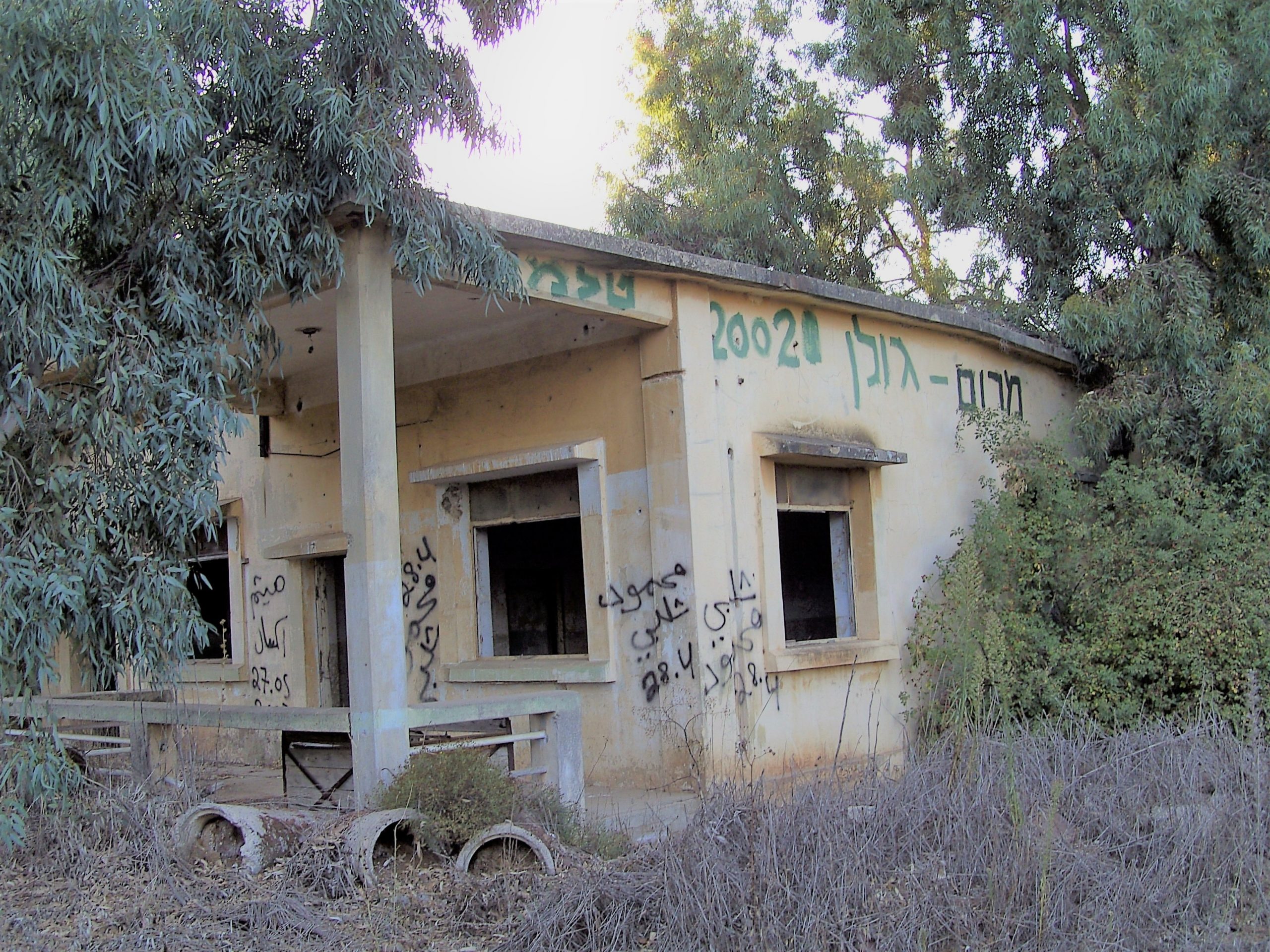

Houses destroyed since the 6-Day War and at Ein Gev: Bathing in the Sea of Galilee.
After visiting the viewpoint of Kuneitra (directly at the Syrian border), the UN blue helmet soldiers in the buffer zone between Israel and Syria, the opposite Israeli military highly equipped “radar installations” and the Syrian tank wreck from the 6-day war, we drove to a wild bathing place at the Sea of Galilee, about 3 km south of Kibbutz Ein Gev (Kibbutz = rural collective settlement in Israel with common property and grassroots democratic structures). There is the only freely accessible, but somewhat dingy place with a sandy beach, where we bathed for about 2 hours. After that we drove about 2.5 hours non-stop back to the Birgittine Convent and had dinner there, because due to the last day of Sukkot once again all restaurants in West Jerusalem were closed in the evening.
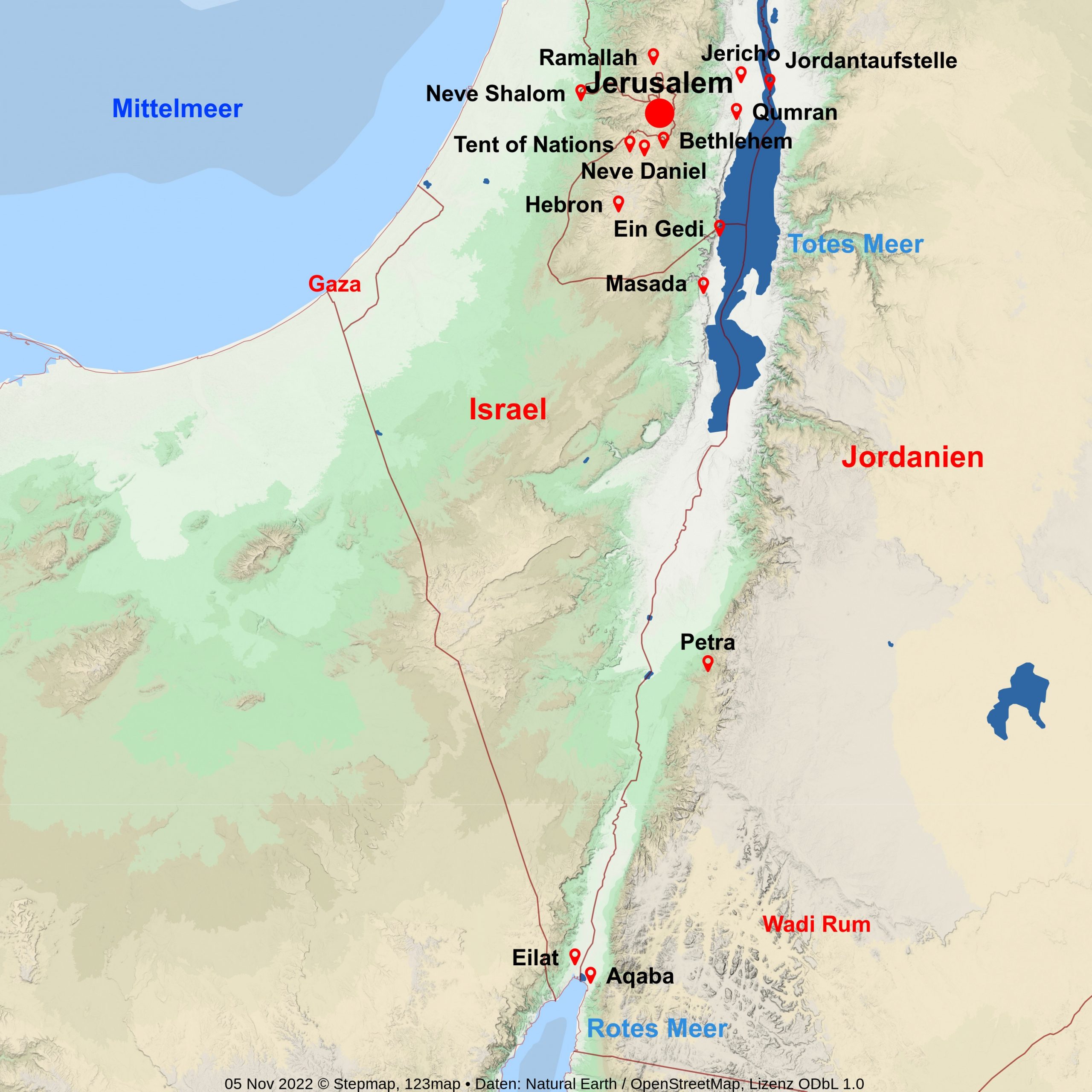
Southern part of JIK map of Israel-Palestine-Jordan (northern part see above on Day 1).
Day 11: Tuesday, 11.10.: Judean Desert – Jericho – Jordan site – Aqaba
Early in the morning we drove towards Jericho in the Judean Desert to the Jahalin Bedouins (see 1st map at the top), where the Bedouin speaker Eid abu Khamis Jahalin welcomed us warmly at the road to Jericho. Four of us loaded the extensive writing materials into his Toyota pickup truck and drove with him to the very basic Bedouin accommodations in the village of Khan al-Ahmar and to the car tire school. The rest of the group could easily manage the short but steep path. Eid informed us in English about the decades-long heroic (so far successful thanks to great support from home and abroad) struggle against Israel’s planned forced resettlement. He himself has already been to New York and the German Bundestag. Many celebrities (including former EU Parliament President Martin Schulz) have already been there.
As with the ToN (see above, Day 4), the Israeli military also blocked direct access by car with a roadblock. Lacking money for a school, the Bedouins built one themselves from old car tires and then plastered the walls. Just outside the fence of their school there is a water and electricity connection, as Israeli settlements are planned there again (as well as an amusement park and another airport). However, they are not allowed to use the connections and therefore have to fetch the water from a distant water point.
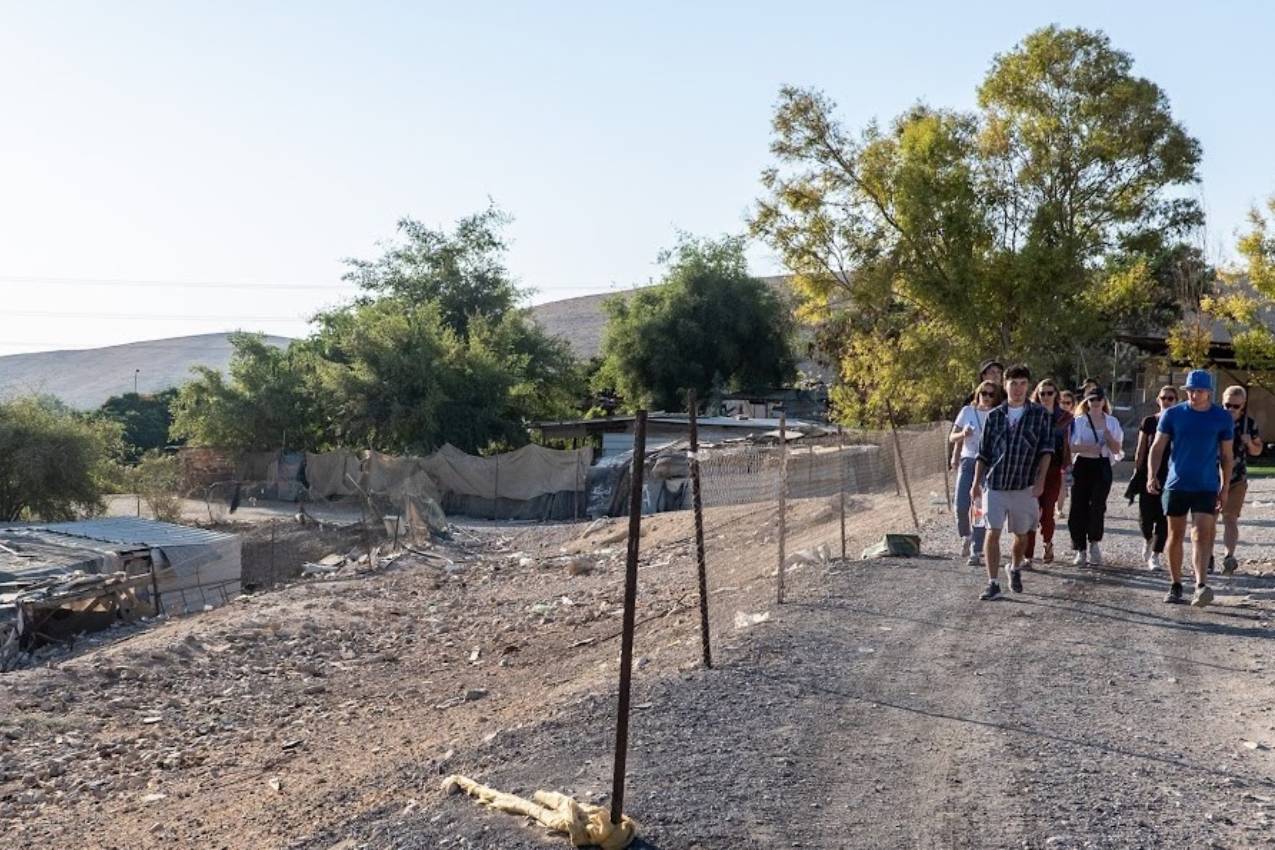
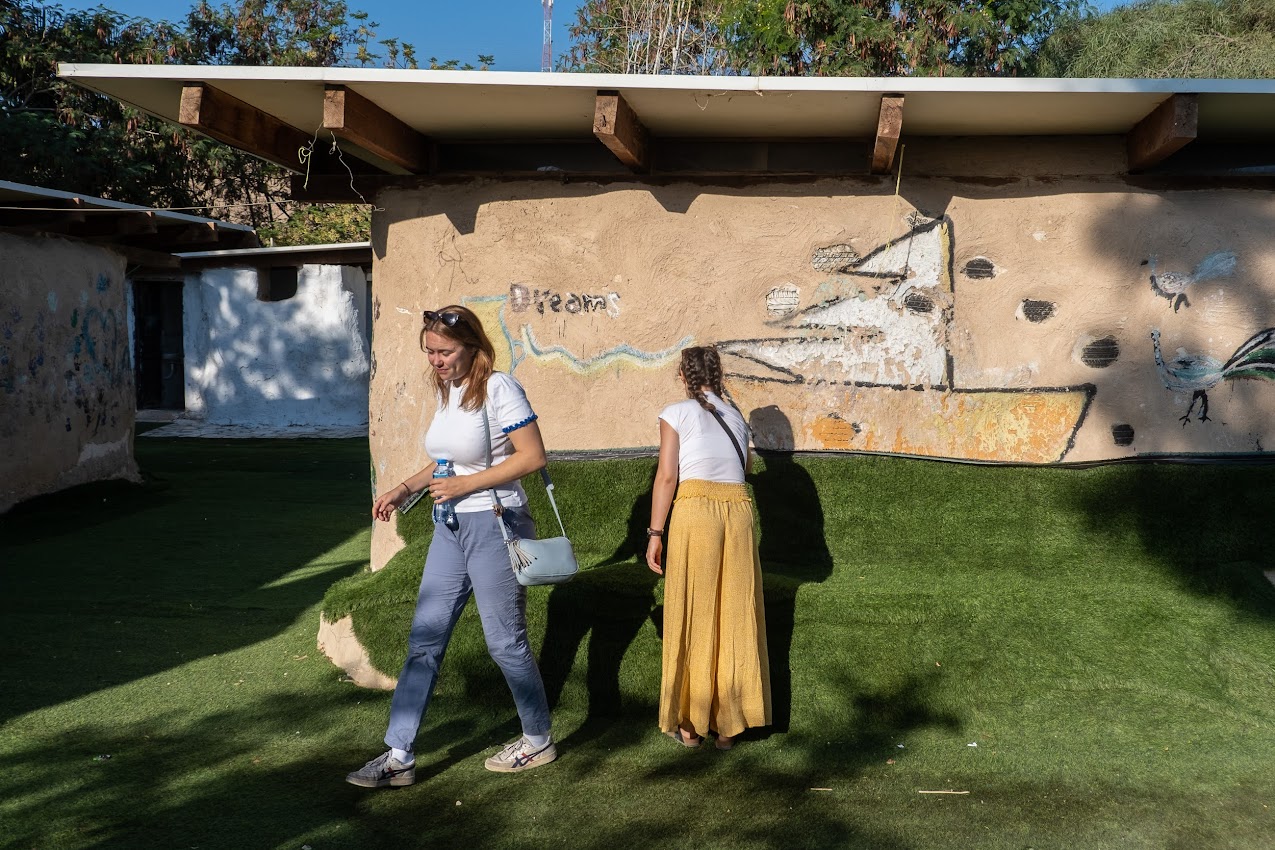
At the Jahalin Bedouins in the Jewish Desert and Car Tire School
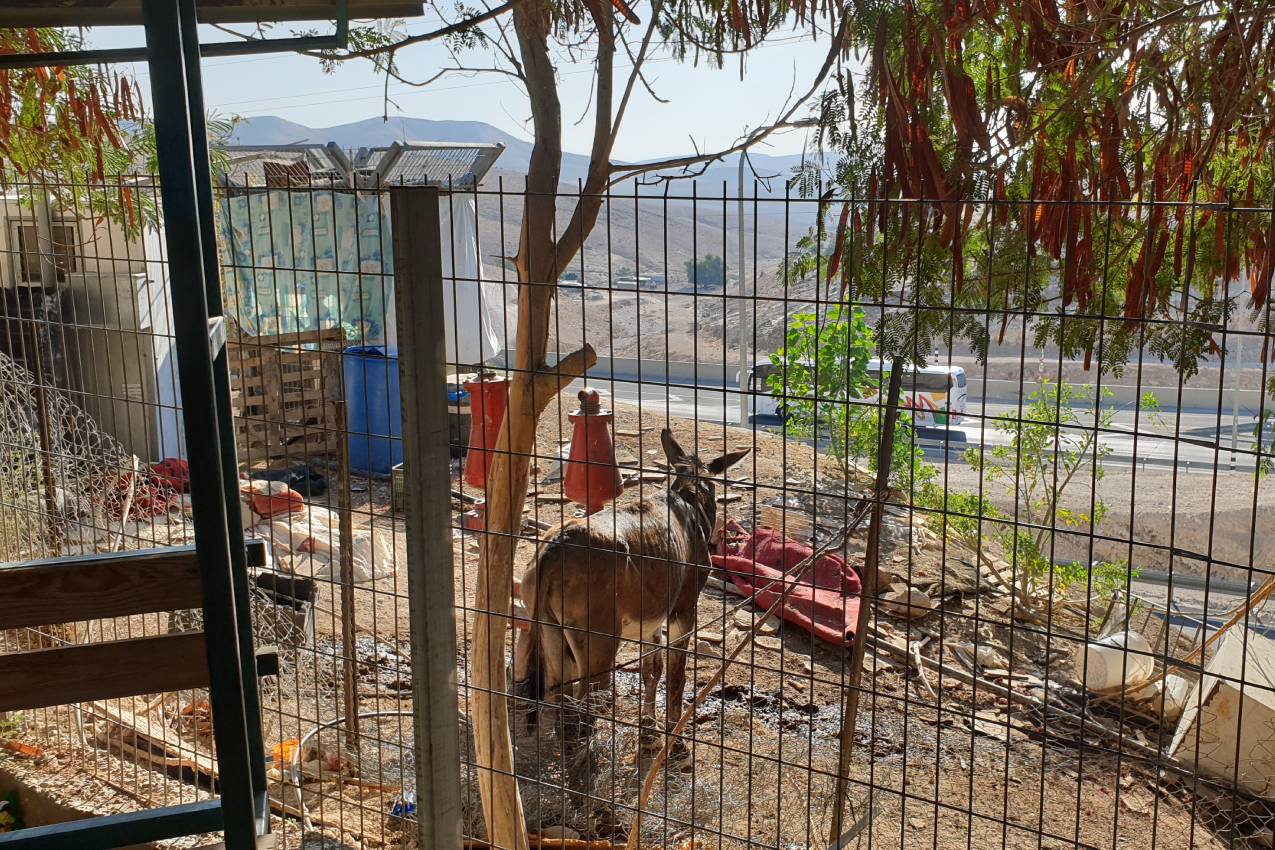
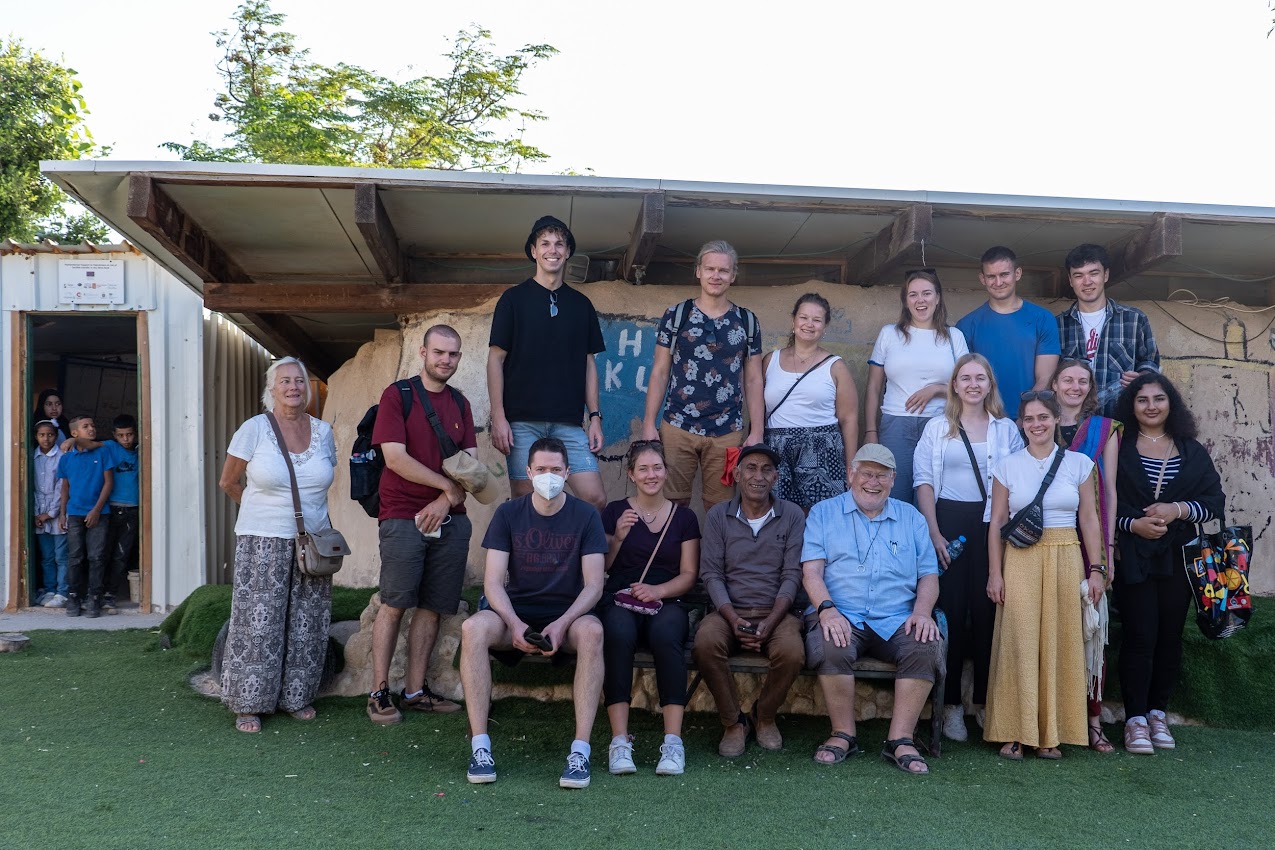
Water connection outside the school and photo with Bedouin spokesman Eid abu Khamis Jahalin (center).
After visiting the car tire school, we handed over all our school materials. As a sign of solidarity, he also received a JIK donation of €1,000 from me, which Eid was of course delighted about.
Then we went to Jericho, the lowest and (one of the) oldest cities in the world. Although in the excavation site Tell es-Sultan you can still see remains of the wall of Jericho with the oldest known staircase (about 8050 BC), but otherwise only ruins remains, so that a visit is interesting only for experts.
Therefore, we immediately went to the Hisham Palace, where, after watching a rather informative but unfortunately outdated film, we were able to admire the wonderful mosaics of the palace, uncovered and covered in 2021.
Hisham Palace
The Palace of Hisham is an Umayyad palace complex preserved only in ruins five kilometers north of Jericho. It was probably completed during the reign of Caliph Hisham or his successor al-Walid II around 743 A.D. In addition to the palace building, the site also contained a separate reception hall, a spacious bath, and a mosque. Only a few years after its construction, the structure was destroyed by an earthquake and abandoned.
The palace of Hisham was designed as a winter residence and consisted of several individual buildings. The largest structure was the residential complex, originally two stories high, located in the west; next to it there was a mosque and a bathhouse with an attached music room. To the east of the complex was the 40 × 135 meter forecourt with a centrally located fountain covered by a pavilion. The palace had a richly stuccoed and originally colored facade, which is only partially preserved. It also had its own water reservoir, which was connected to fresh water sources via an eight-kilometer aqueduct, still partially preserved today, and other sophisticated irrigation systems.
The bathhouse, which is located in the north of the complex and is larger than average, is architecturally derived from Roman models. It was heated by a hypocaust and had latrines. The floor of the reception hall is covered with a very well preserved mosaic. One of the individual motifs shows a fruit-bearing tree – probably the tree of life – with three gazelles and an attacking lion. The mosaic ensemble, consisting of 6 million pieces, has been completely uncovered in restoration work until 2021 and made accessible to tourists: A steel construction leads visitors several meters above the complex, so that the predominantly geometric representations can be viewed from above. The massive columns of the complex are decorated with acanthus capitals, the roof, which is no longer preserved, was covered with vaults and crowned by a dome. Human and animal figures in great abundance completed the decoration. Overall, the mosaics, stucco designs and sculptures of the palace, which show clear Sassanid and Byzantine influences, are considered among the highest quality works of the period anywhere.
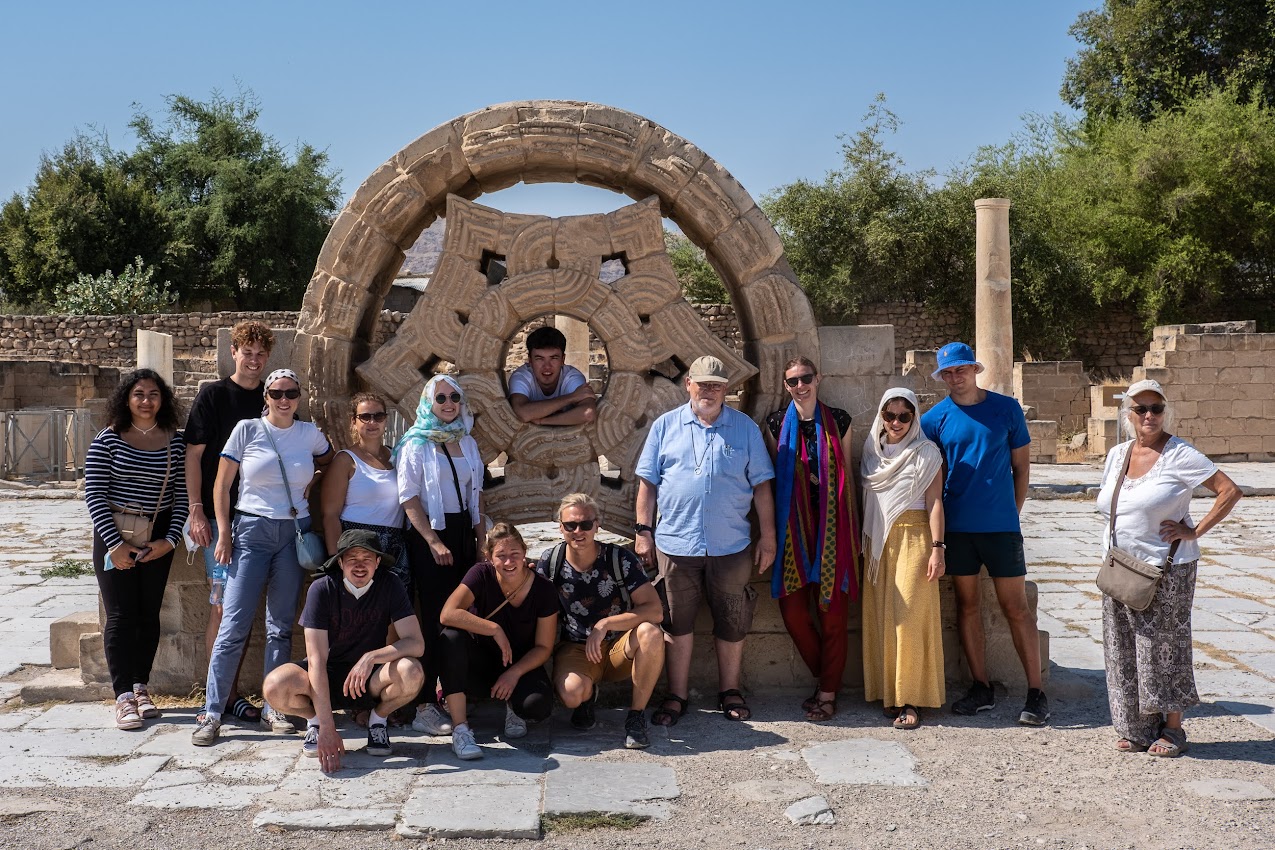
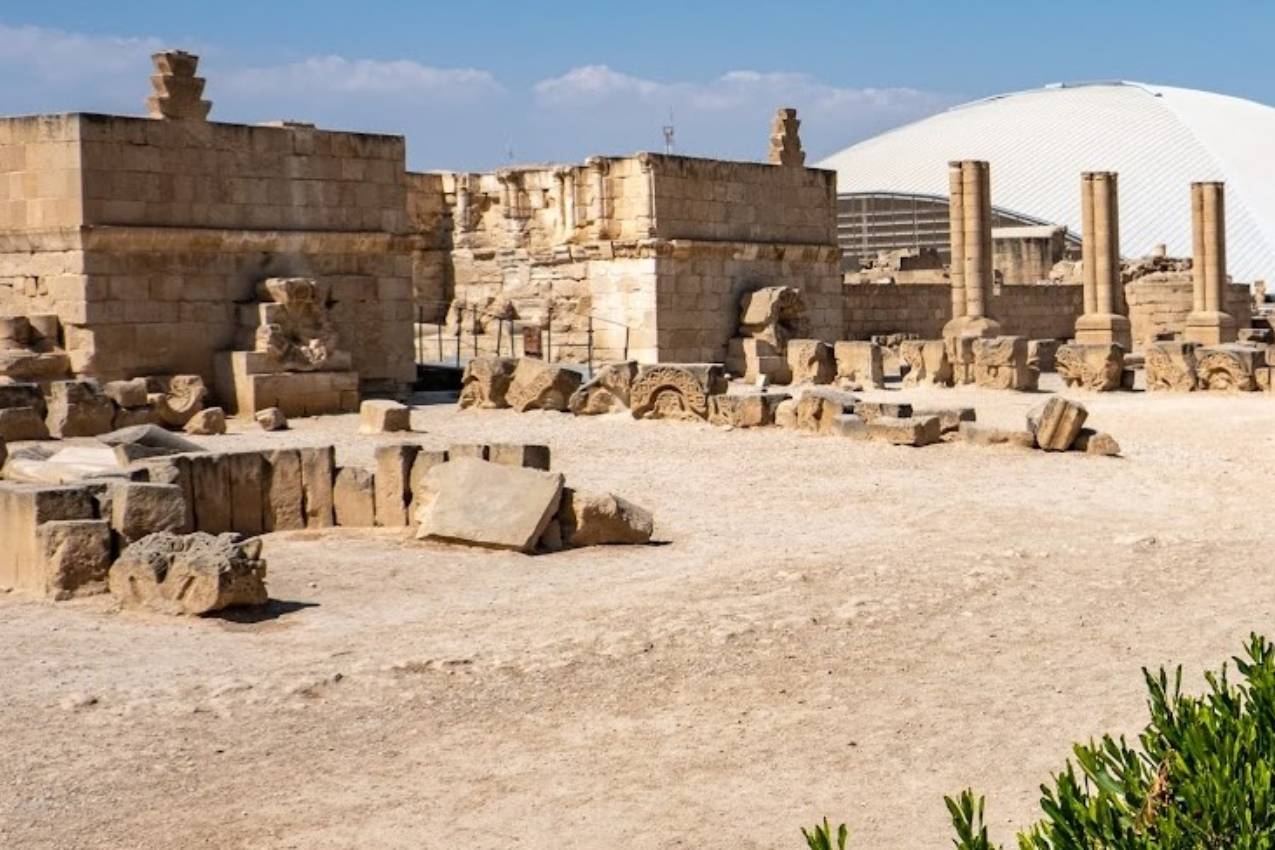
Jericho: Hisham Palace: rosette stone and view of palace complex with covered large mosaic floor
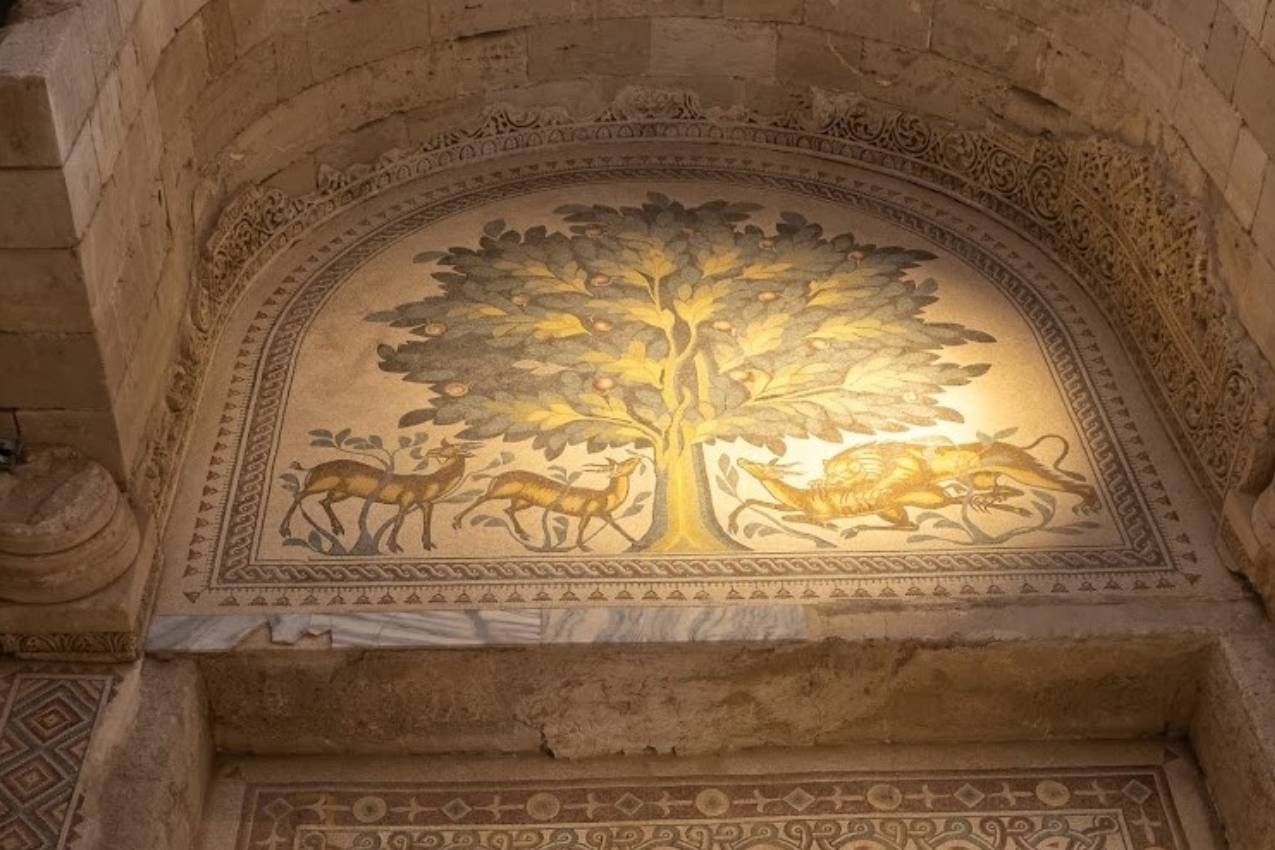
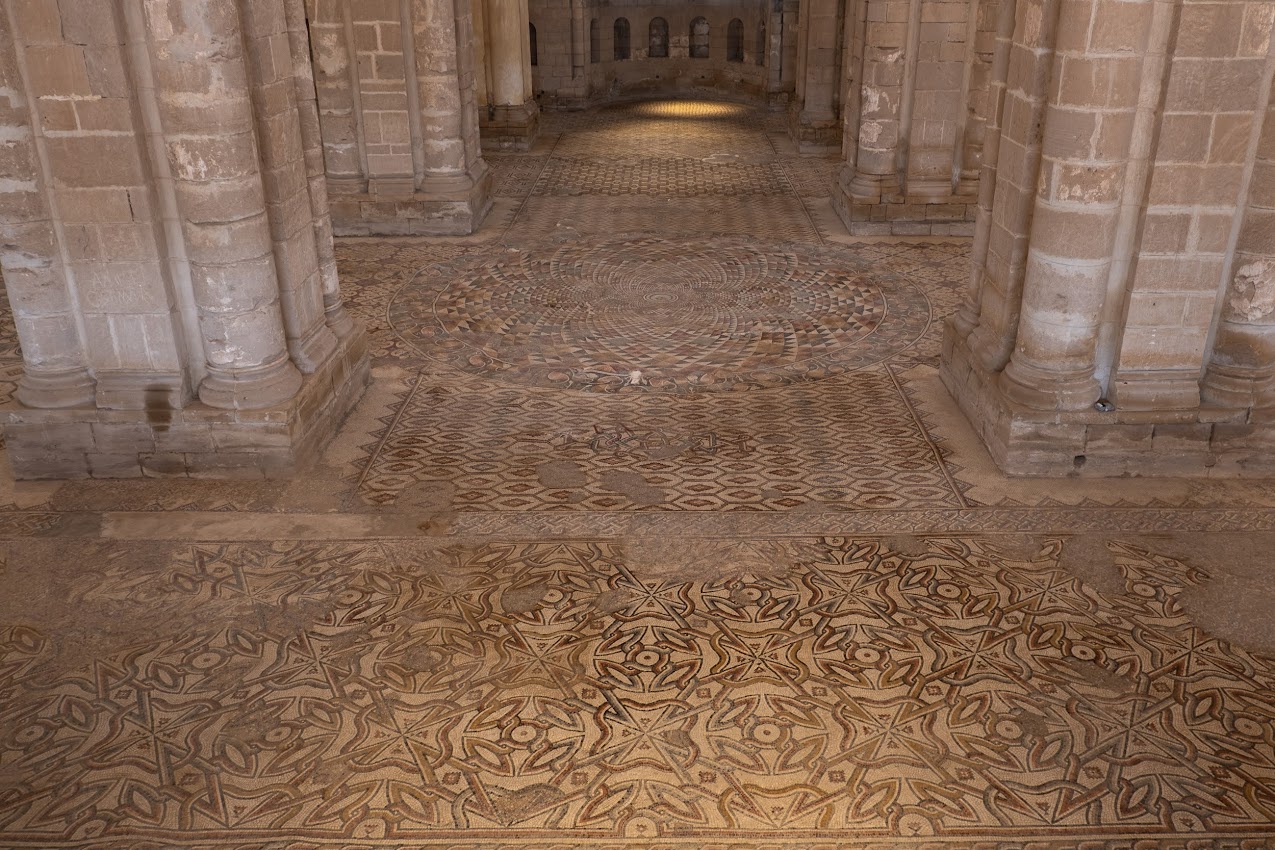
Mosaic with tree of life (paradise): Lion chasing a gazelle and mosaic floor in the great palace
Afterwards we visited the beautifully painted Romanian Orthodox Church built in 2011 with a large guest house for the many Romanian workers (A total of 12.8% of Israel’s workforce are guest workers, mainly from China, Romania, Bulgaria, Turkey, the Philippines and Thailand. These cheap laborers, who are often underpaid and for whom neither taxes nor social security contributions are paid, are an additional burden on the labor market).
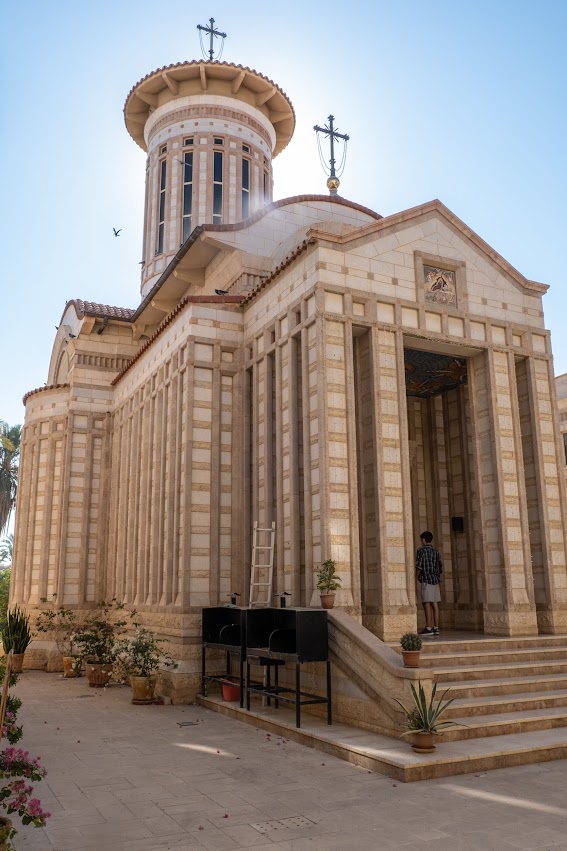
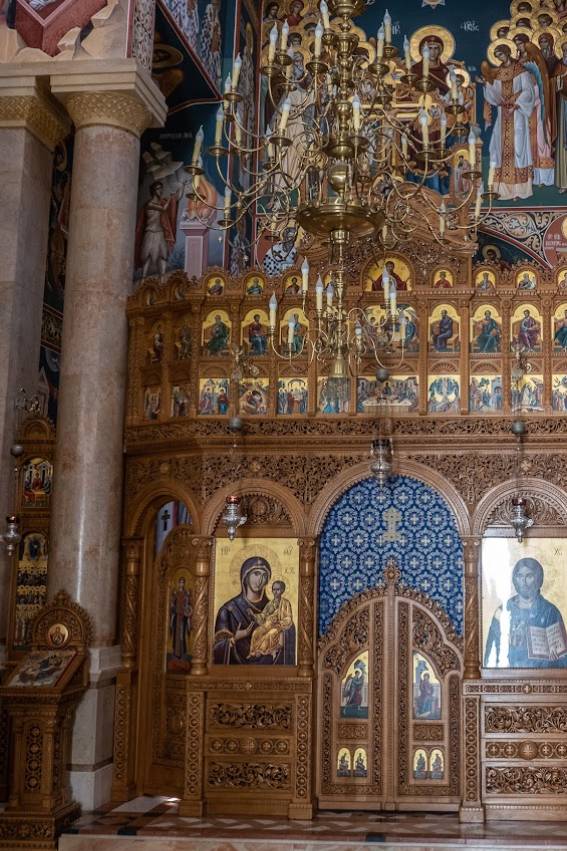
Jericho: Romanian Orthodox Church
We then took the cable car up to the Greek Orthodox rock monastery, where at the entrance we were able to solve the problems with our clothes because of not enough covered knees, arms and the breast area with women again thanks to provided skirts, additional scarves etc. (as with the Temple Mount, see above 2nd day).
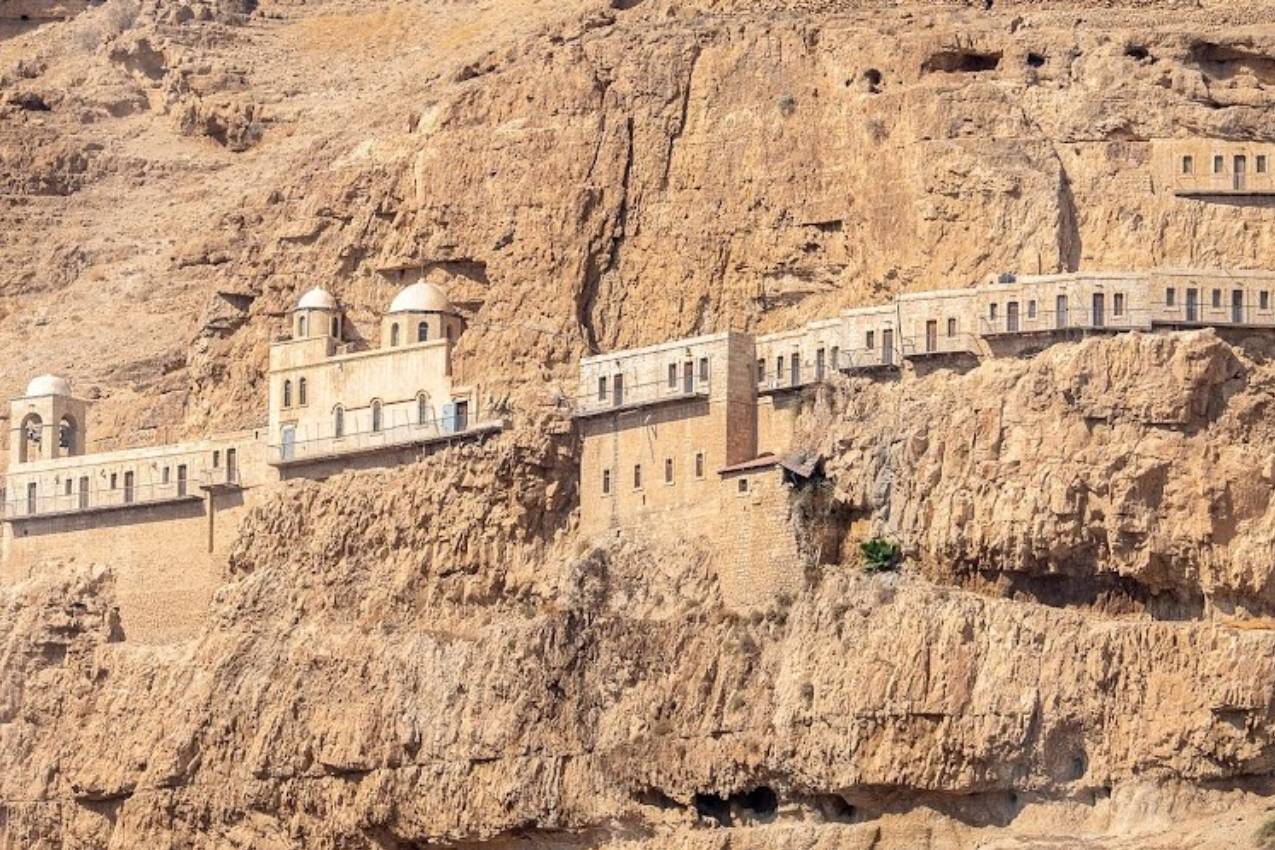
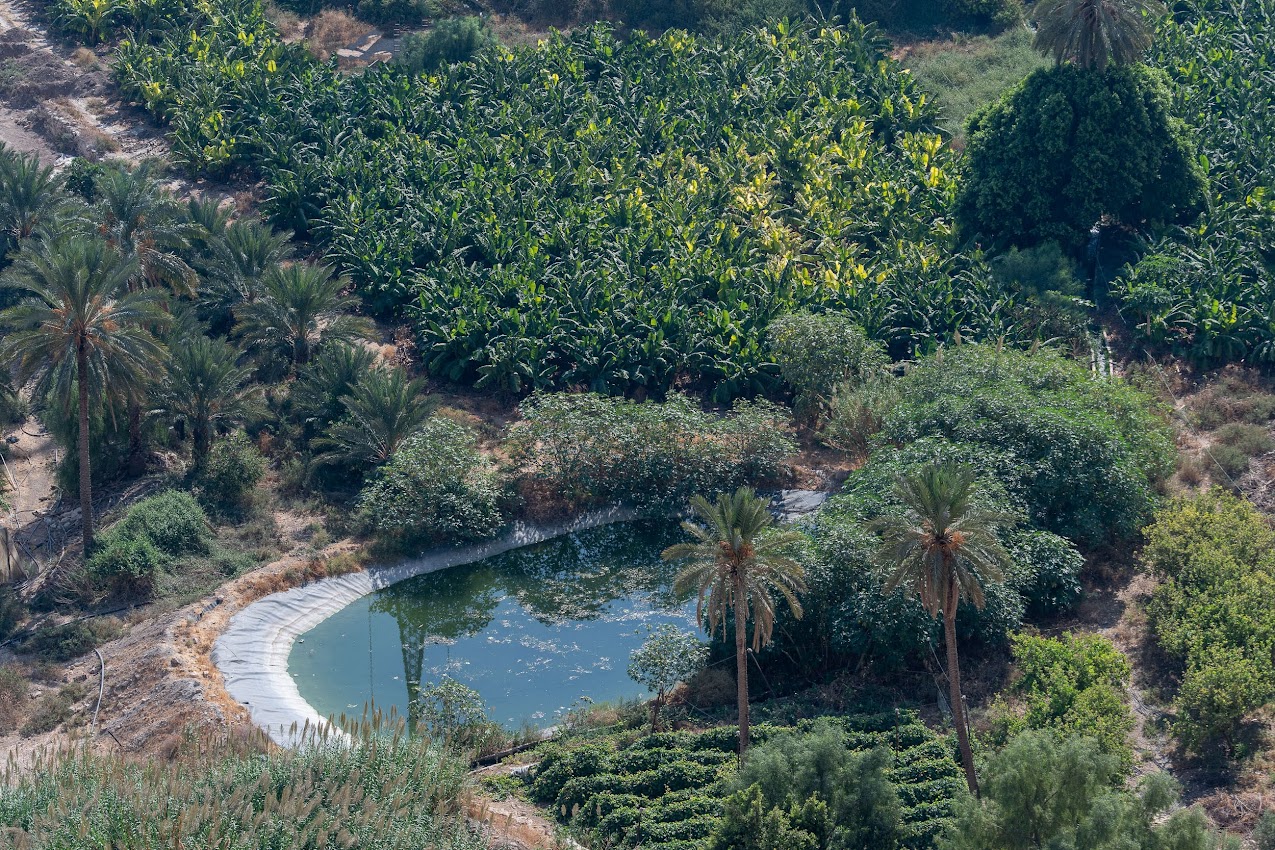
Jericho: View of the rock monastery at the Mount of Temptation and view of the oasis in Jericho
After visiting the monastery and looking at opposite caves and the whole area of Jericho, we returned to the valley station and arrived at the spring Ain es-Sultan with the viewpoint in the shade of a fig tree by a pond and a fountain fed by the spring.
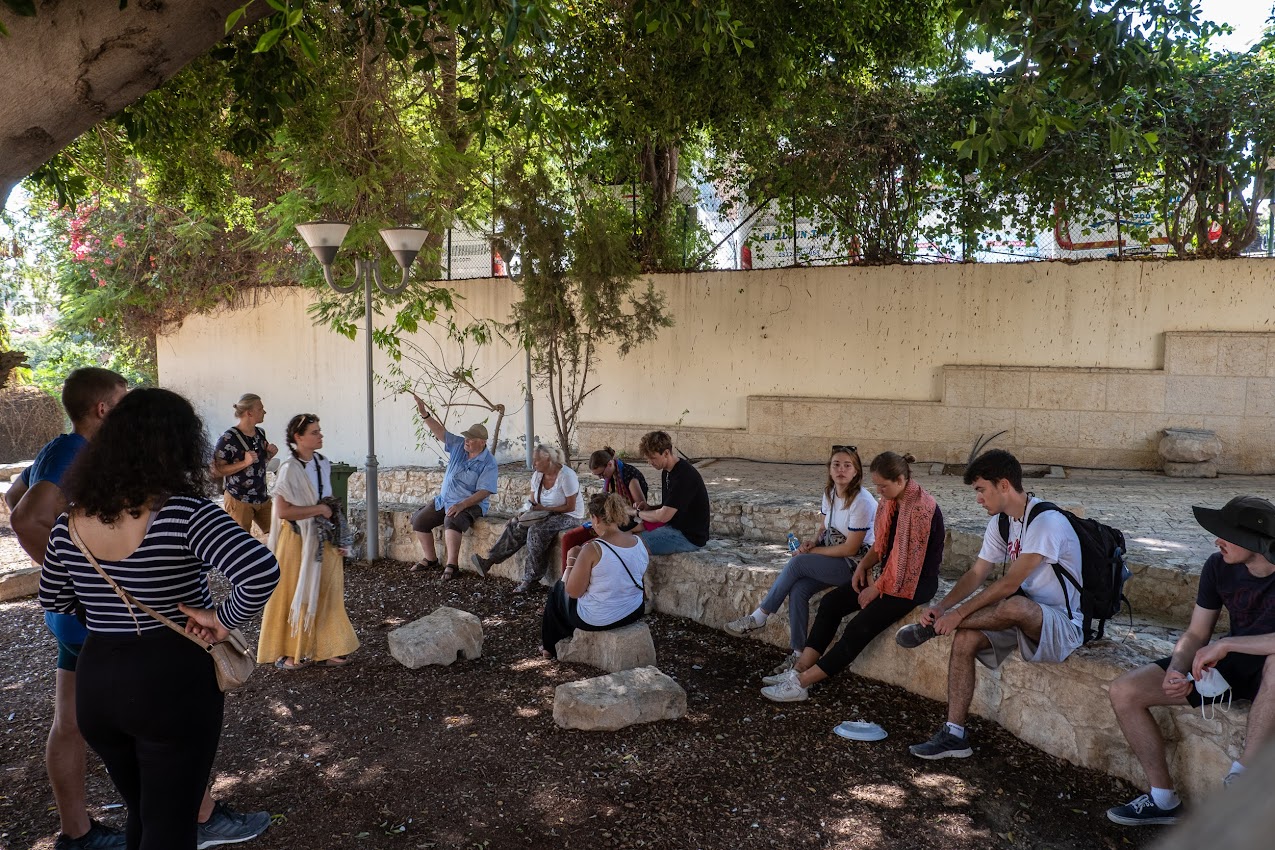
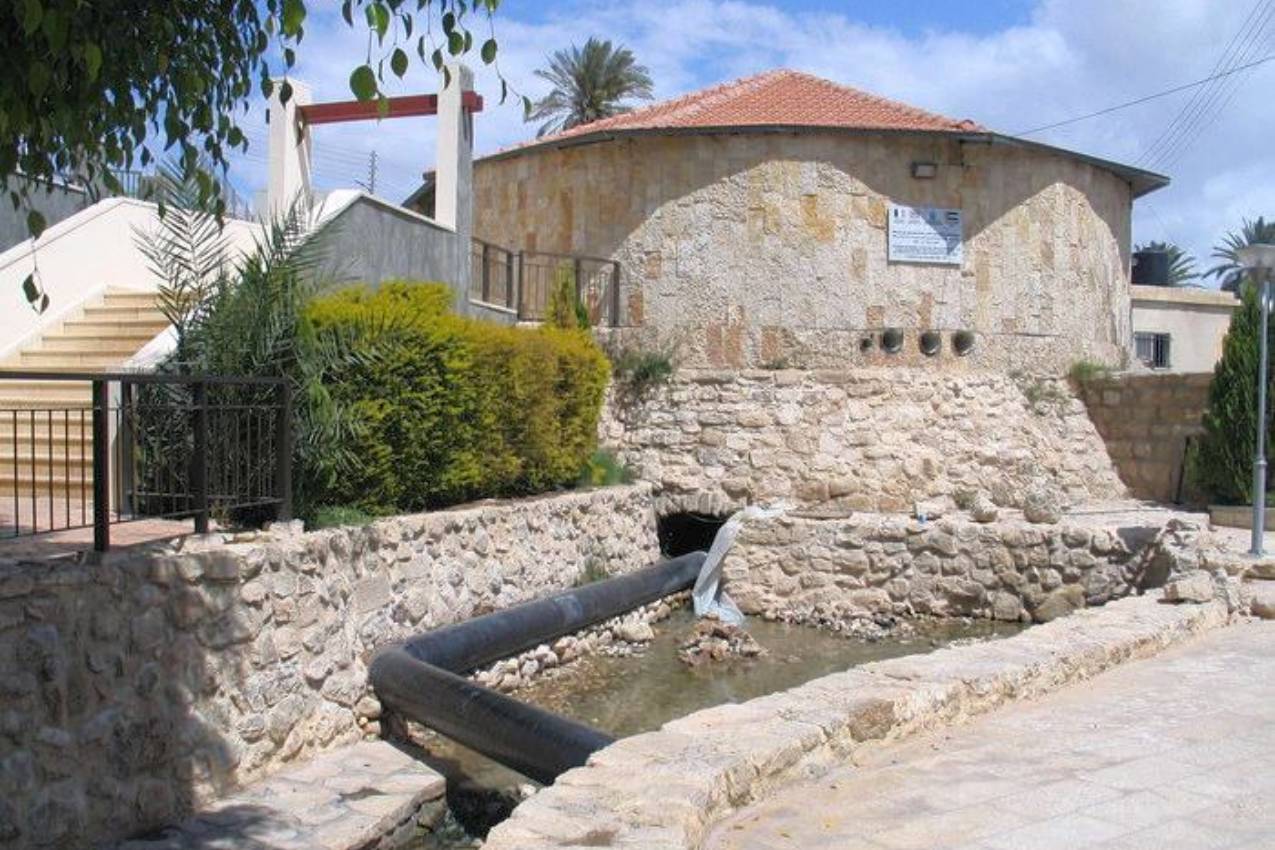
Jericho: Shady place under a fig tree at the Ain es-Sultan spring.
Mountain of temptation
The Mount of Temptation is a mountain a few kilometers outside the city of Jericho in the West Bank. According to Christian tradition, Jesus of Nazareth resisted the temptations of the devil at this place while fasting there for 40 days. Today, the Greek Orthodox monastery of Qarantal (Deir al-Quruntul) is located on its slope, and the Jericho cable car leads up there. Around 340 A.D. Chariton the Confessor, founder of the first monastery in the Judah desert, abandoned it due to overcrowding and founded a chapel on the top of the mountain as well as another in a cave further down the eastern slope where Jesus is said to have stayed. Duka and the caves in its vicinity were until the 8th century. inhabited before being abandoned and not repopulated until the Crusader period. In 1874 the Greek Orthodox Church bought the site and established the Sarandarion Monastery here in 1897.
We had lunch at Kentucky Fried Chicken + Pizza Hut due to time constraints, and then drove to the Jordan River site south of Jericho, where some of us – dressed only in a white robe – took a baptismal bath in the Jordan River.
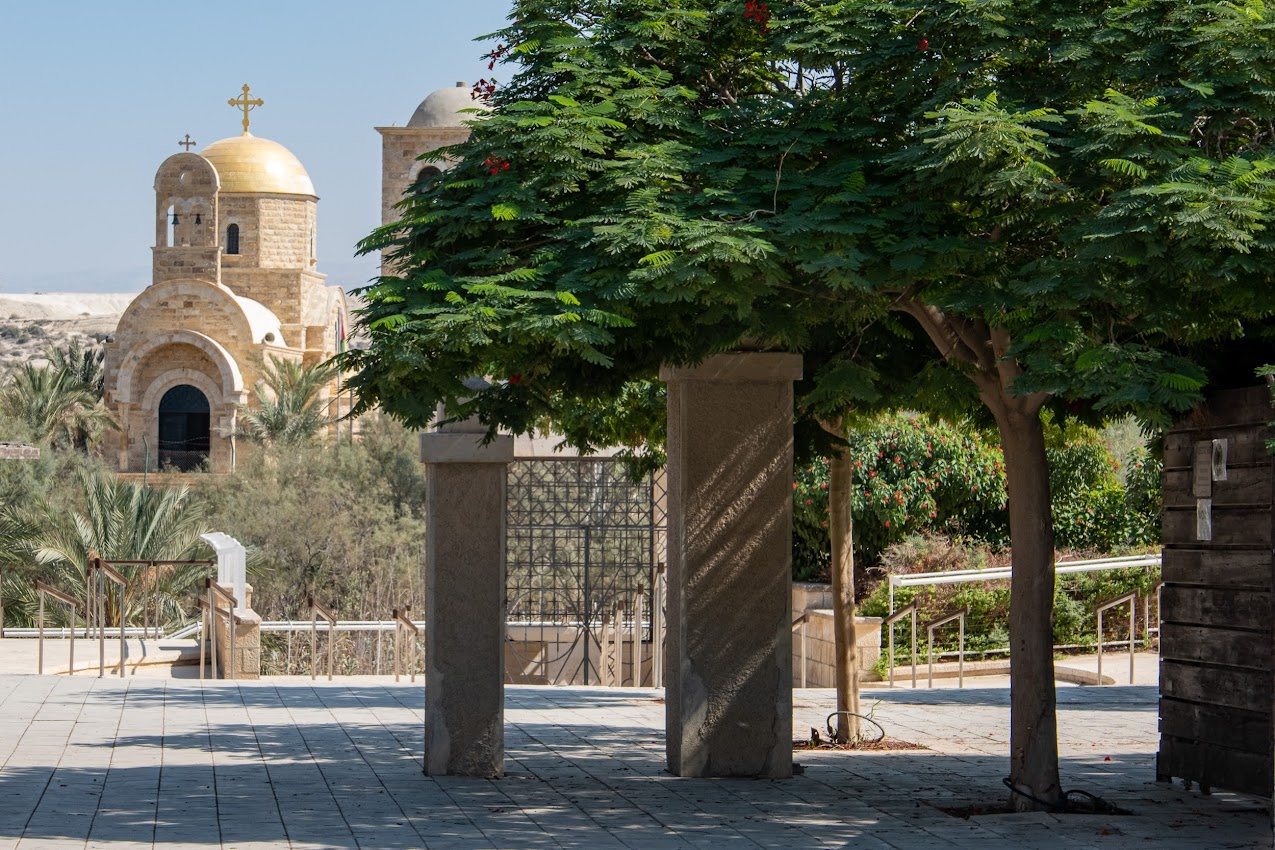
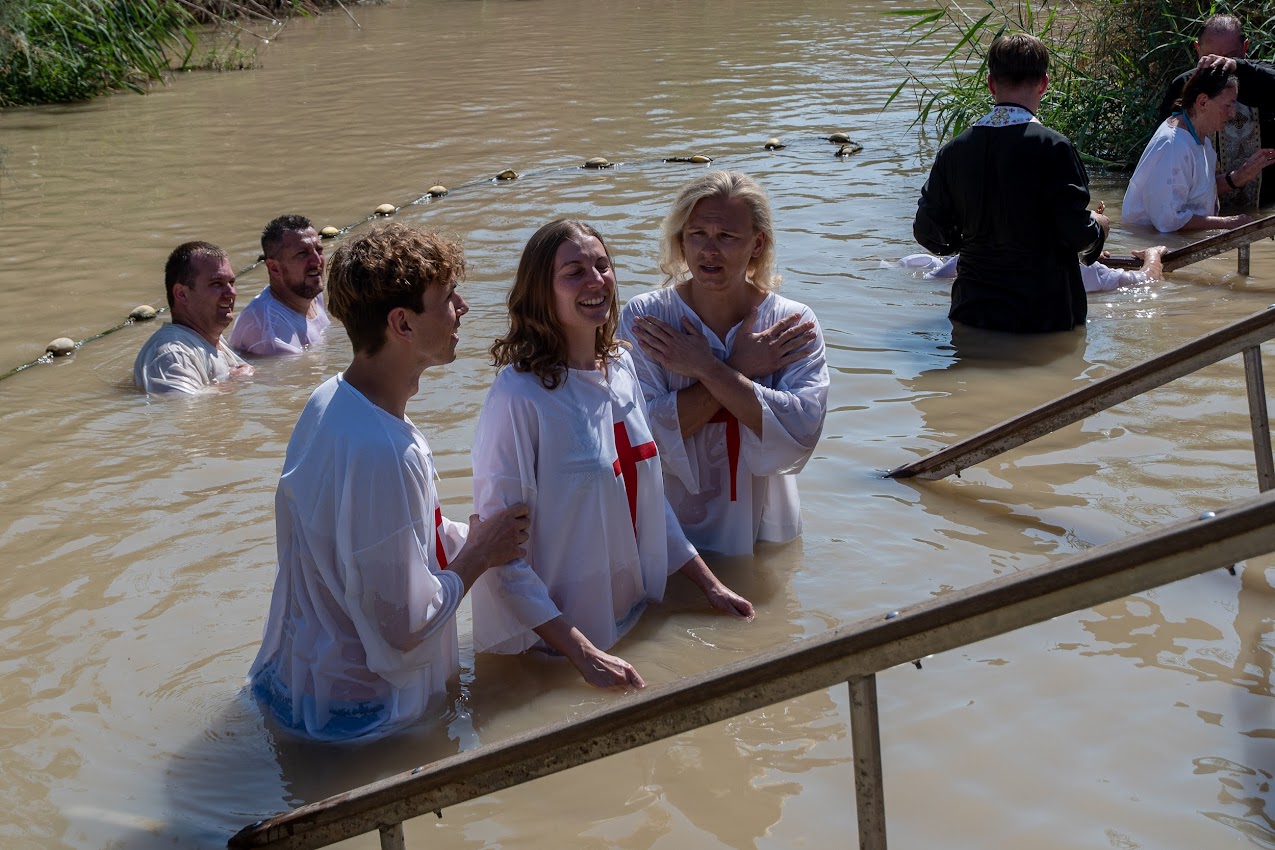
Jordan site south of Jericho and the baptismal bath
Edgar then took us directly non-stop to the Araba-Border border crossing, 2 km north of Eilat, which we reached in time around 18:00, although Edgar had probably driven further to Eilat in the direction of the Egyptian border crossing at Taba due to overtiredness, which I noticed immediately, however, so that we lost only a few minutes of time.
After passing the Israeli border control smoothly, we had to transport our luggage about 300 meters through no man’s land before we got to the Jordanian border, where we got our visas without any problems. After crossing the border, we boarded a large tour bus and were greeted very warmly by our German-speaking “tour guide”, who unfortunately did not deserve this designation due to his lack of experience or training (?). He did not have the program agreed in writing with the travel agency and had to find out accordingly based on my program for these 4 days.
The problem was that during the Corona period, several travel agencies went bankrupt and some continued under new names. In addition, our previous excellent German-speaking tour guide Mahmoud Younis, who had again started a new travel agency, had died of cancer in 2020.
Only after a couple of lost trips did the bus driver and tour guide find our large 4-star hotel in Aqaba, where we had dinner and then strolled through the city.
Day 12: Wednesday, 12.10.: Aqaba – Wadi Rum
After breakfast, we visited the SOS Children’s Village in Aqaba and also toured a house where several teenagers lived with a Children’s Village mother. Here, too, I delivered a JIK donation of € 1 T for this exemplary institution. Afterwards we visited the Greek Orthodox parish (approx. 200 members) in Aqaba with church, kindergarten and boarding school (high proportion of Muslim students as in Palestine and I also handed over a JIK donation of 1 T € especially for those children who cannot afford to go to school). Then we swam in the Red Sea at the 5-star Berenice Beach Club in Aqaba, not far from the border with Saudi Arabia. In the late afternoon we drove to Wadi Rum to our Mazayen Luxury Rum Camp, which is now very touristy and much bigger than 2019. There was no entrance area lit with torches and the Bedouins were already wearing normal clothes instead of their traditional ones. In the evening we had again the traditional Bedouin dish Zarb (see above, 5th day).
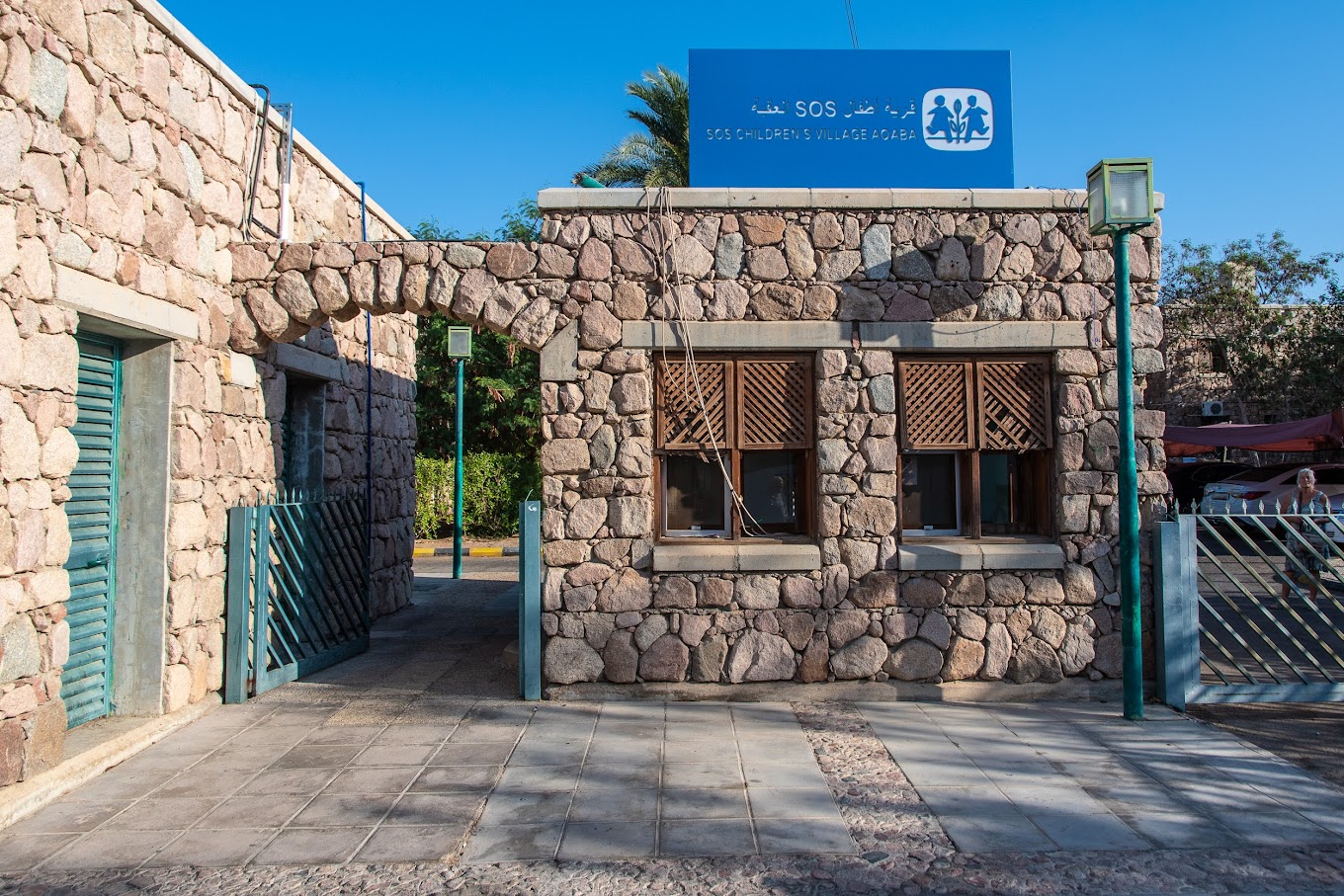
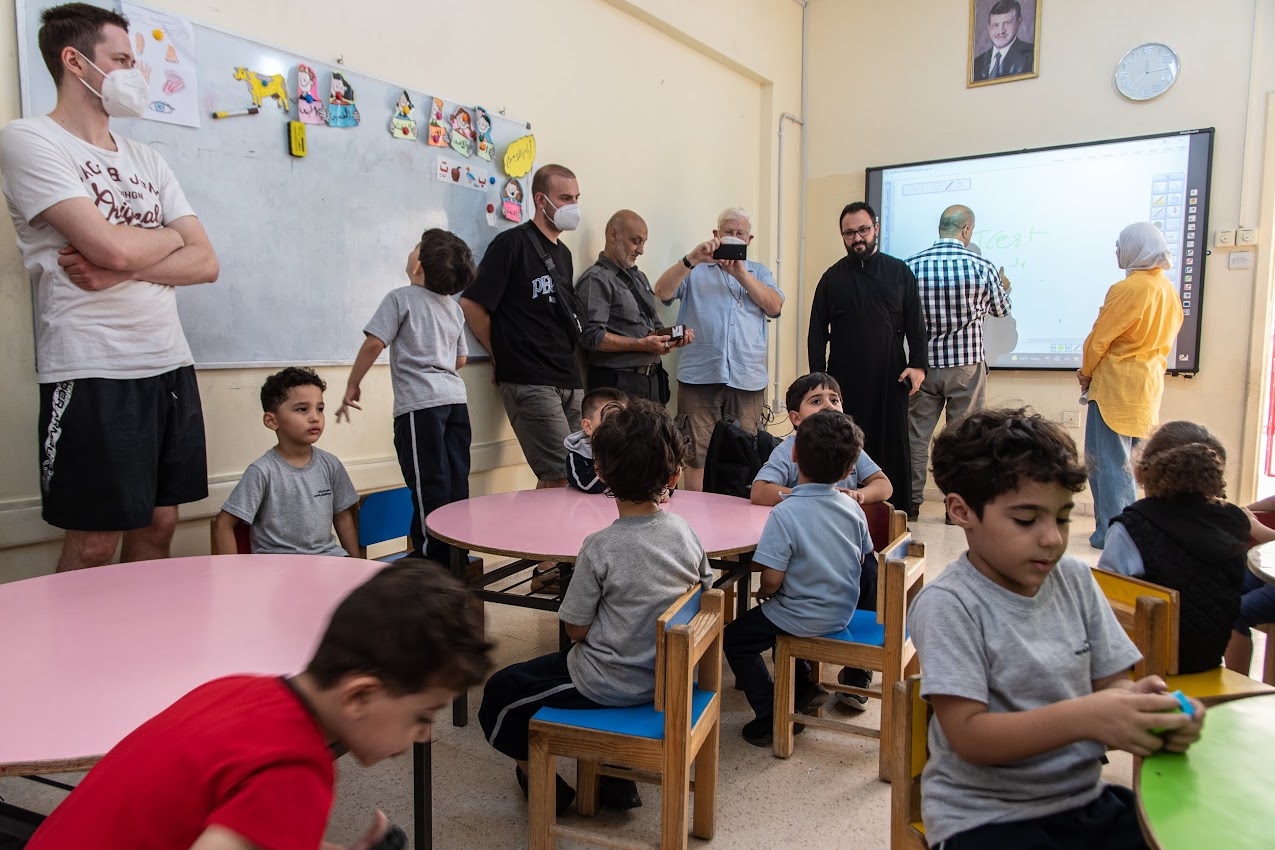
Aqaba: SOS Children’s Village and Kindergarten of the Greek Orthodox Church in Aqaba
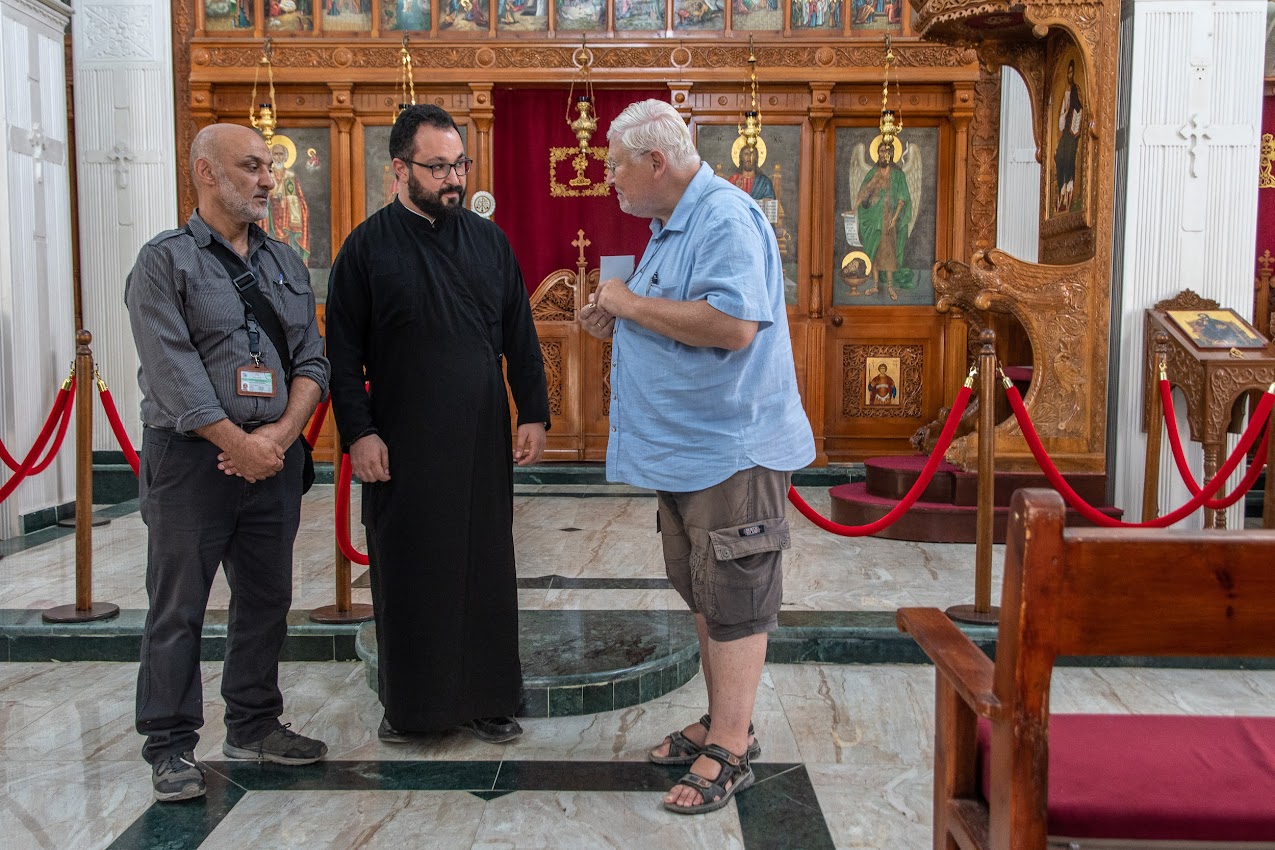
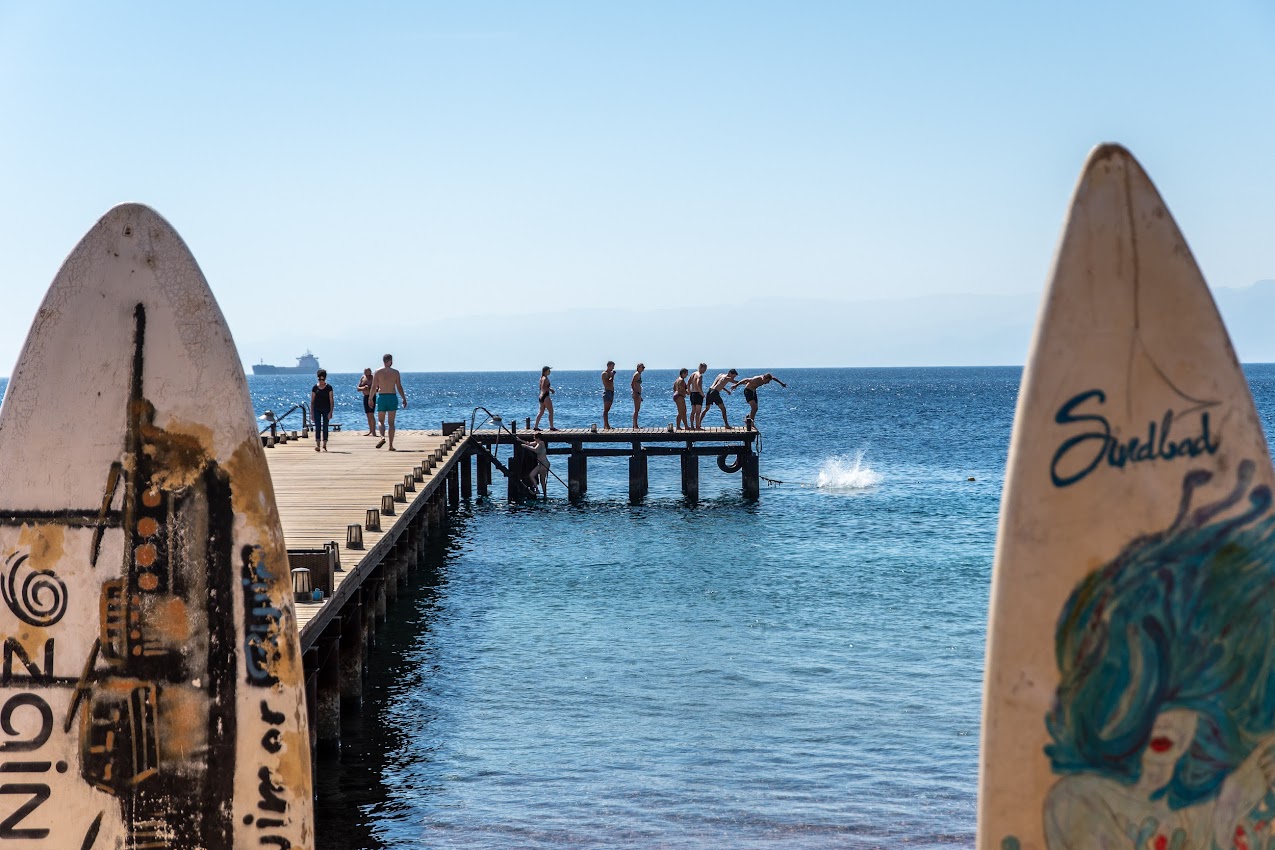
Spiritual leader of the church with tour guide Amin and me and bathing in Aqaba in the Red Sea
After dinner, we gathered in front of our bungalows, as we could talk there more undisturbed. The area where the tourists could gather after dinner was unsuitable for us due to the bad, but overloud music. Some still undertook a night hike into the desert.
Day 13: Thursday, 13.10.: Wadi Rum
Since the scheduled balloon flight was not until Saturday morning, we were able to have breakfast later and then go out for a 2-hour camel ride. What all TN also like very much. However, not only I was glad that we could dismount after 2 hours, because sitting on a camel is quite uncomfortable in the long run. In the afternoon we took 3 Toyota pick-ups on a 4-hour jeep tour through Wadi Rum until sunset. It was also a very nice experience for us, although much less adventurous and spectacular than 2016-19, because the Bedouins did not drive as fast as before and only wanted individual TN to drive a short distance for payment. The routing was also more interesting in the past. After the “Zarb” evening buffet, we gathered again in front of our bungalows, with some again taking a night hike and admiring the clear starry sky from a hill.
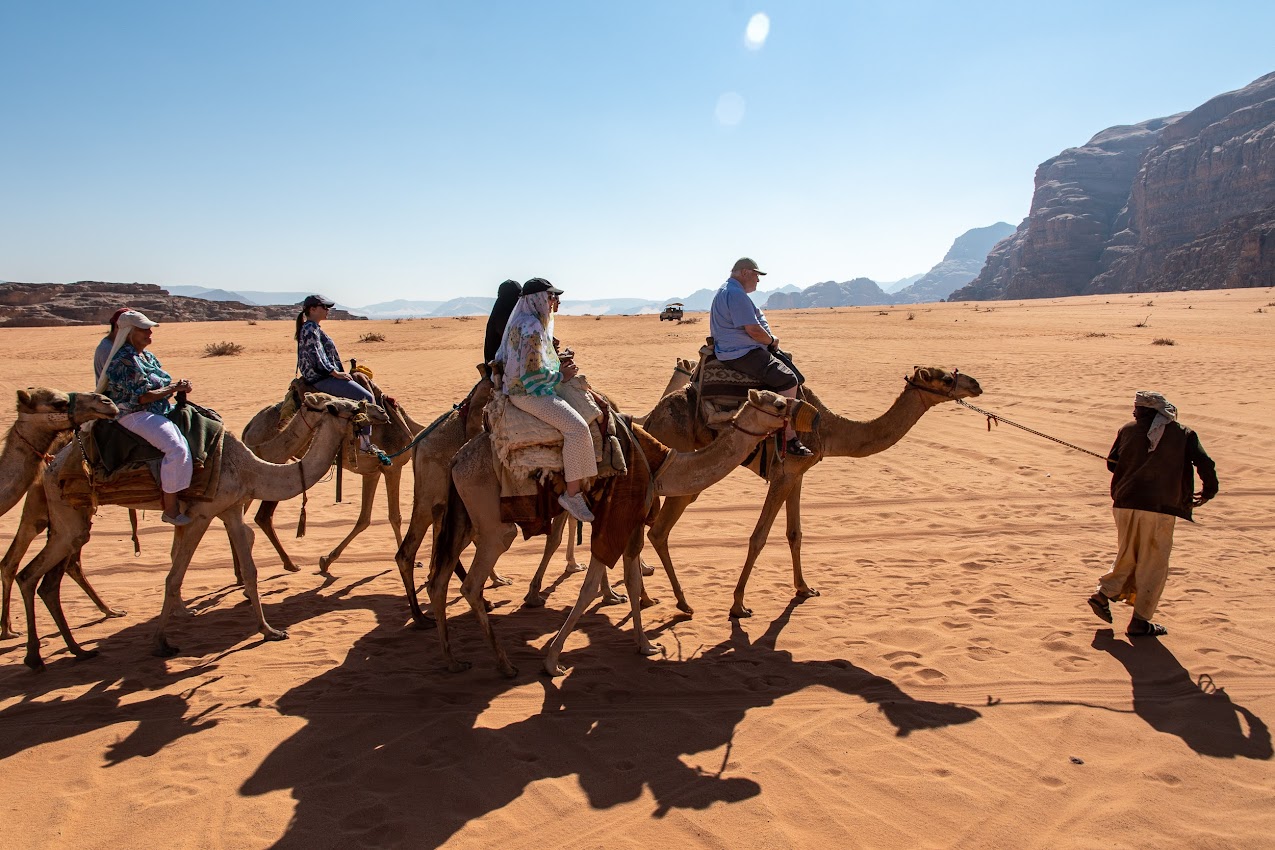
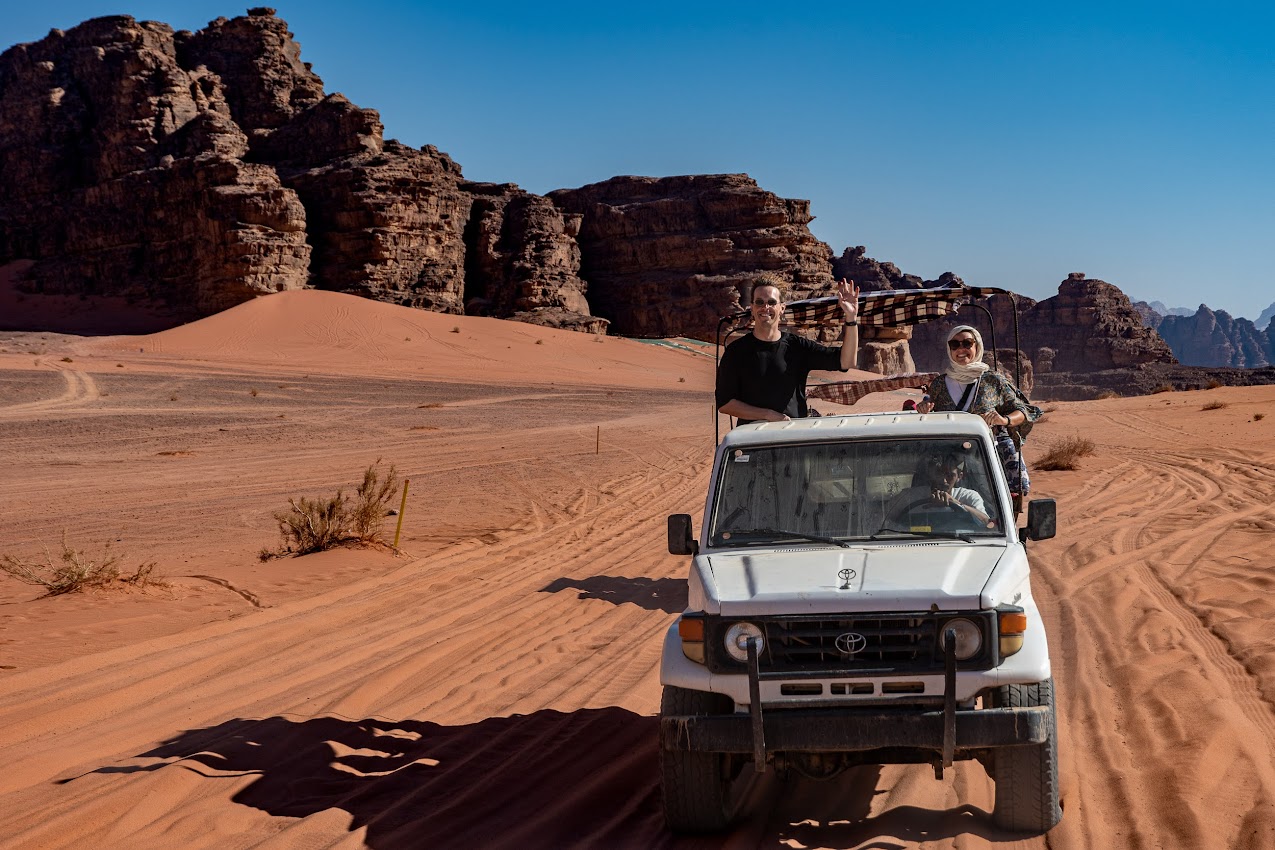
Wadi Rum: camel ride and jeep tour
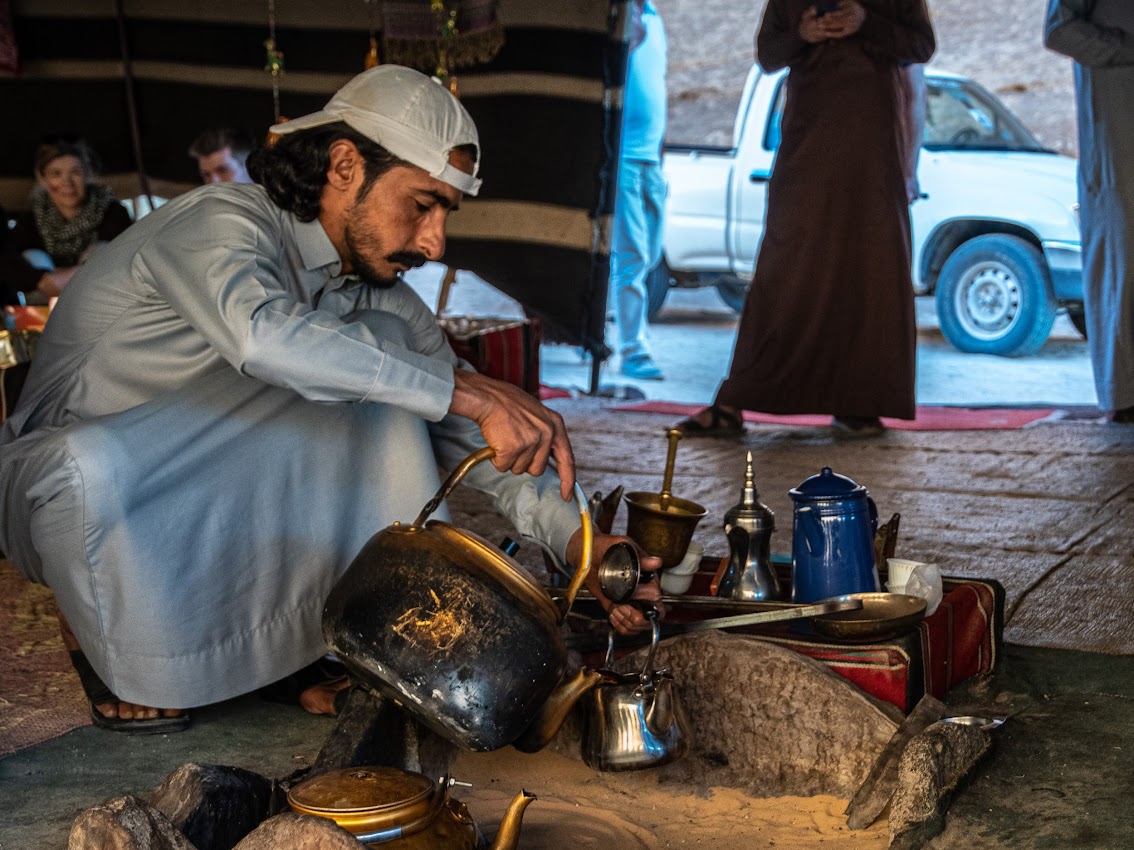
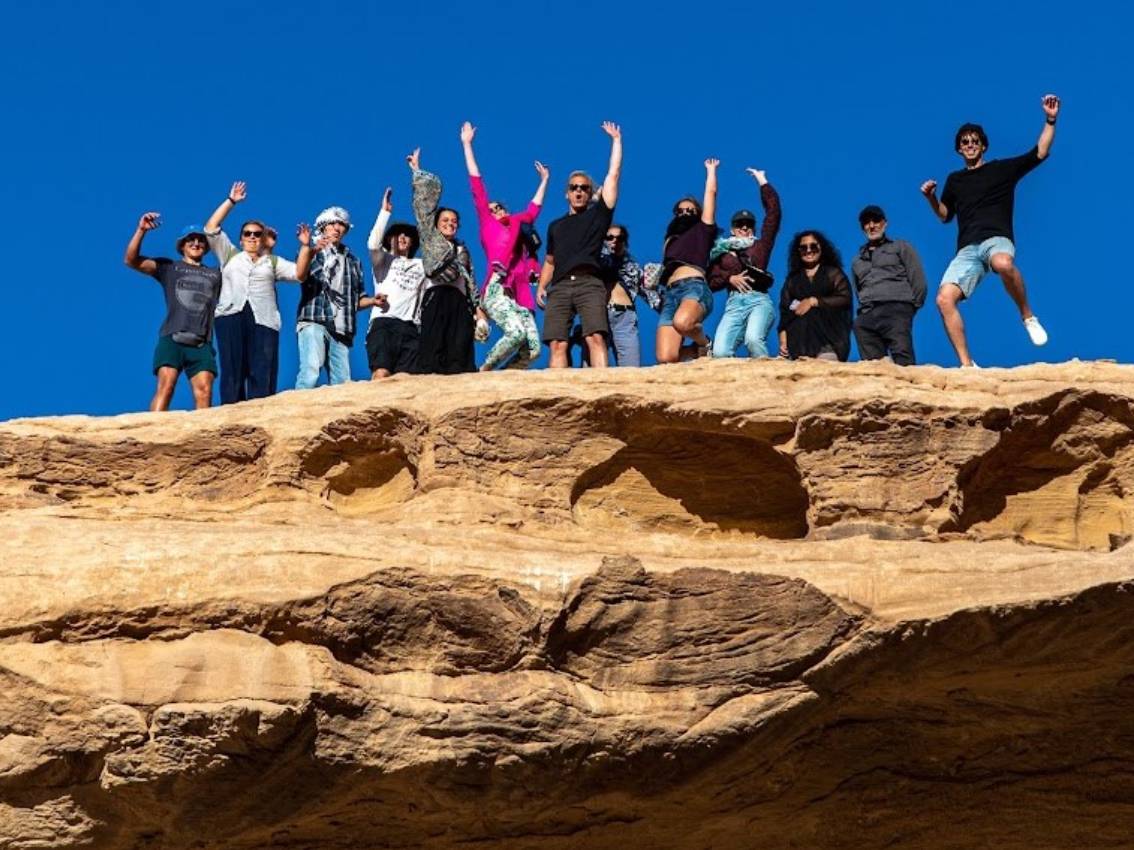
Visiting Bedouins and – On a high bridge (see start picture of our website)
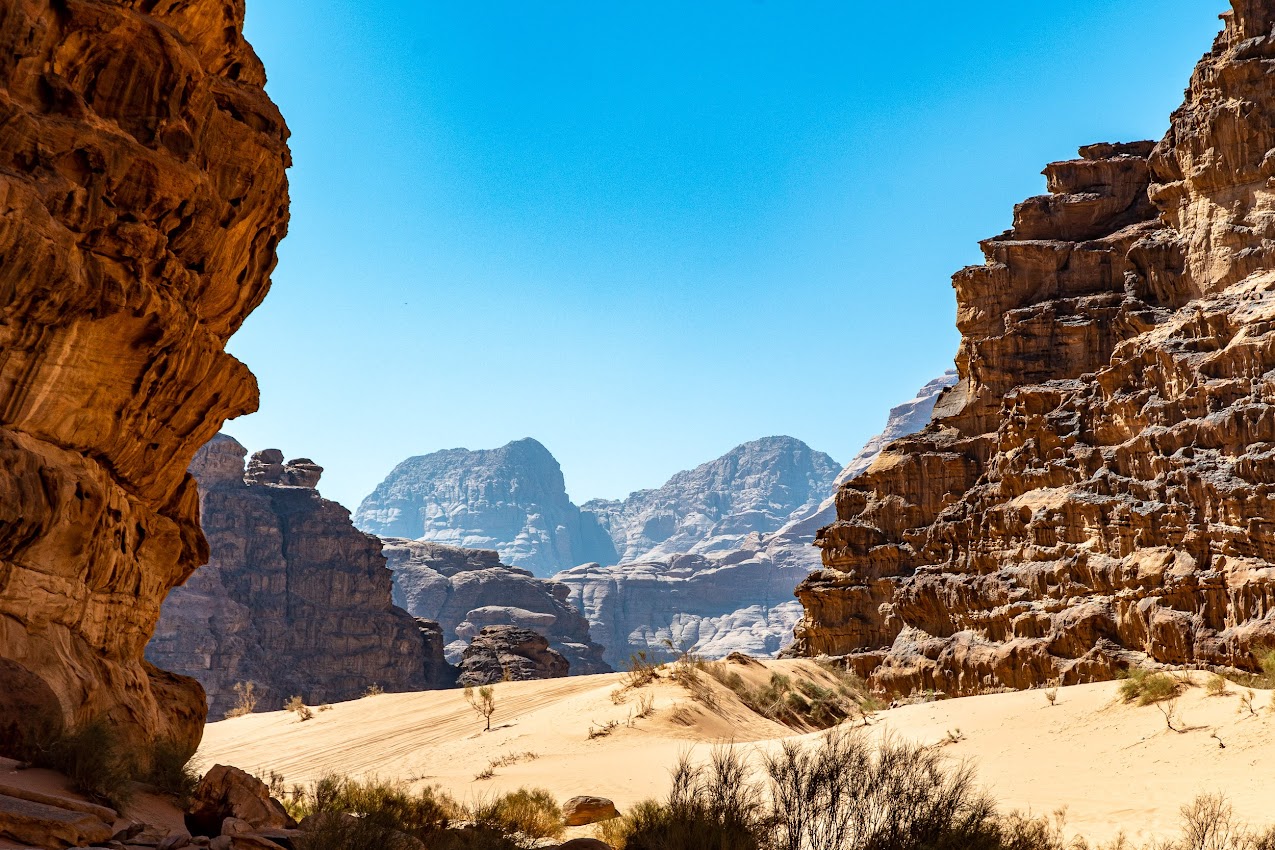
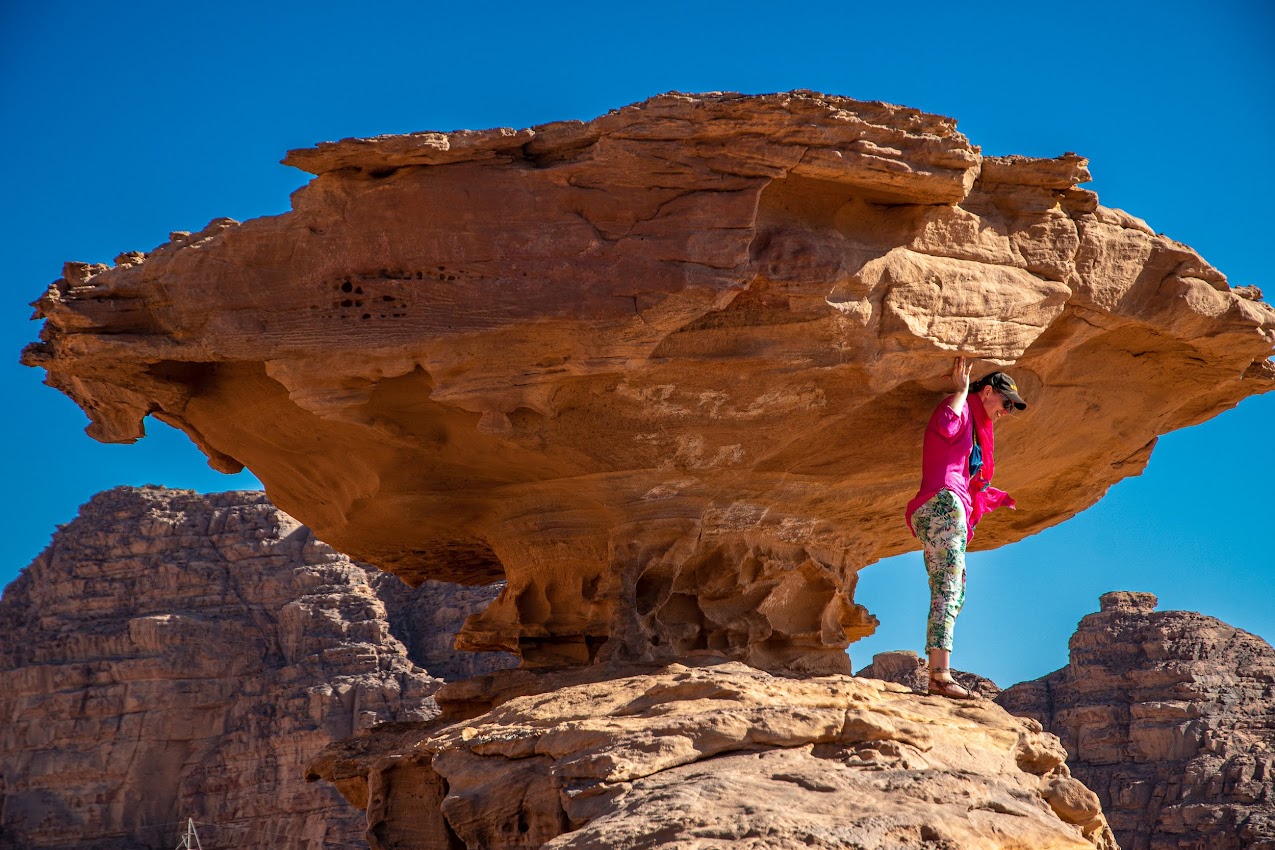
Rock formations in Wadi Rum
Day 14: Friday, 14.10.: Wadi Rum – Petra – Wadi Rum
After breakfast we drove to Petra, where the Jordanian tour guide Amin gave me different or confusing information several times about the duration of his tour. After we had taken a filled pita and a drink as provisions on the way, the unfortunately very unprofessional guided tour in the former Nabataean city by Amin began. Some therefore left the less informative guided tour behind the treasure house early to explore Petra on their own. Nevertheless, Petra is of course always an incomparable experience. On the way back we stopped at the Petra panoramic viewpoint, from where we could once again enjoy a breathtaking view of the Petra Gorge and surroundings from above. After dinner we gathered for the last time in front of our bungalows with stimulating conversations and reflections of the wonderful stay in Jordan.
Petra
The heyday of the city began around the 2nd century BC when Petra was the capital of the Nabataean Empire, which reached as far as Damascus and just before Jerusalem, and the impressive facades carved into the rock were created. In 106 AD Emperor Trajan defeated the Nabataeans and occupied Petra. At that time the rock city of Petra had about 30,000 inhabitants, but due to changes in trade routes decided by the Romans began the decline of the city.
After two earthquakes and the conquest of the region by the Arabs, the city was abandoned and the myth of the lost rock city was born. In 1812 Petra was rediscovered by the Swiss Johann Burckhardt. The legendary reputation of Petra is due to the ornate facades and houses, up to 40 meters high, carved directly into the rock. Most often pictured is the Treasure House of Petra, which was the location of the Holy Grail in an Indiana Jones film adaptation. Other great monuments are the rock tombs with the Ed-Deir and the great Roman amphitheater. Today Petra is one of the most important and most visited sites in the Middle East and is one of the 7 new wonders of the world.
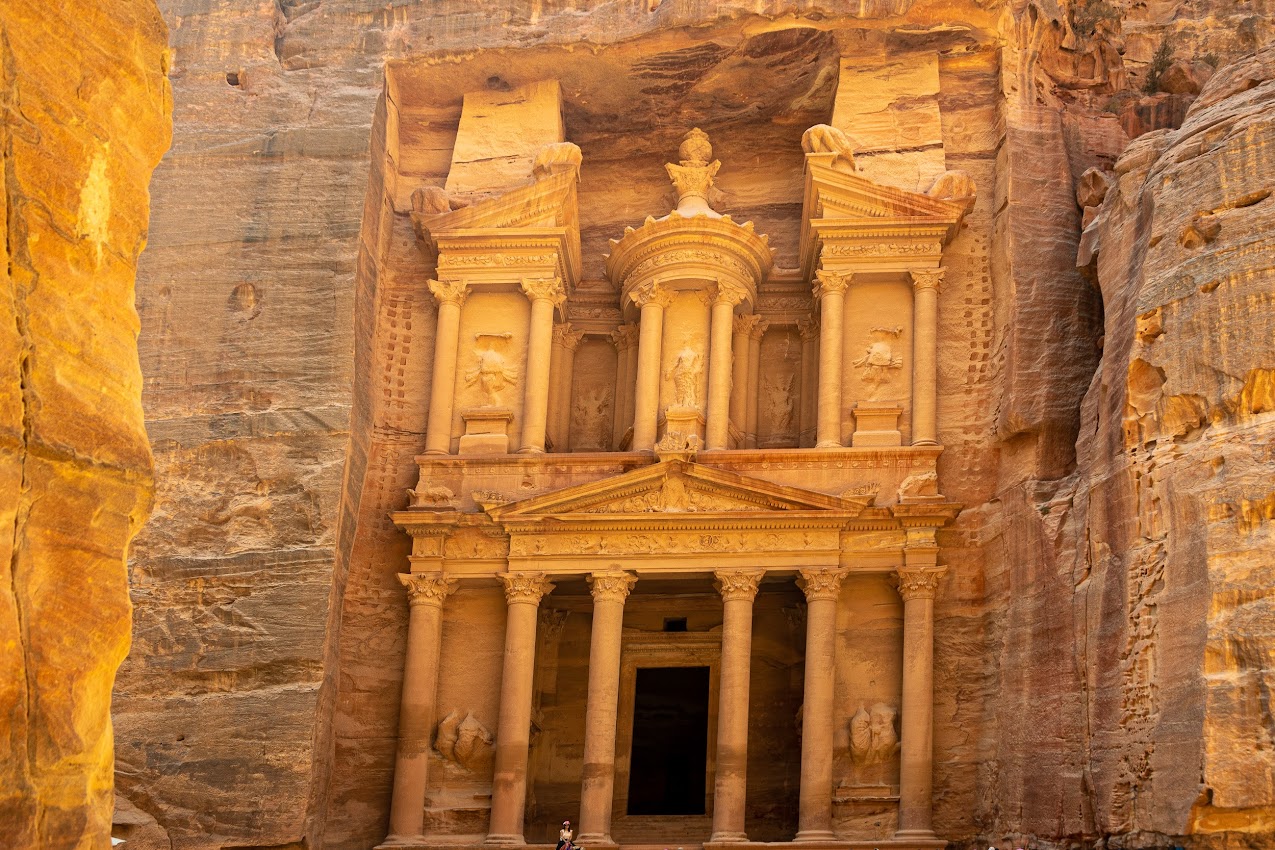
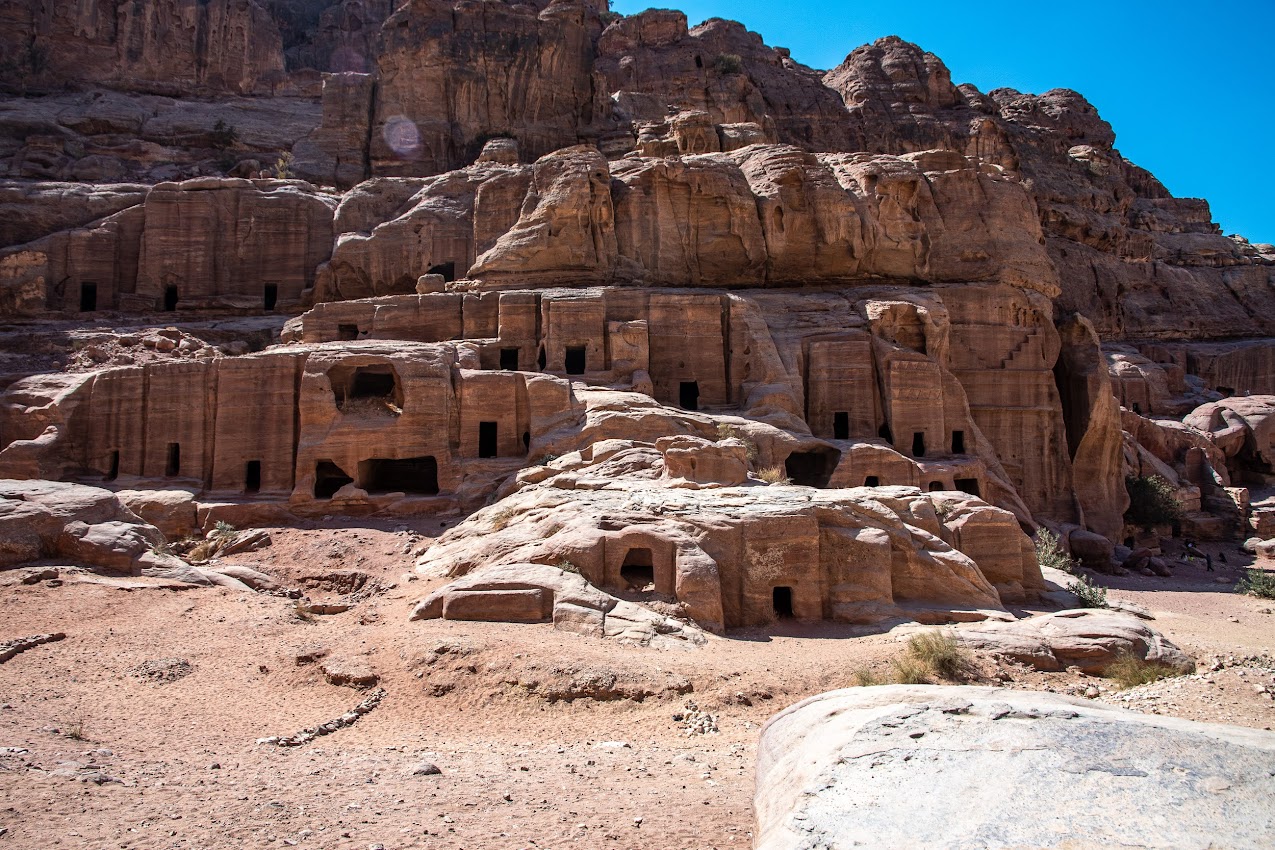
Petra: treasure house and cave tombs
Day 15: Saturday, 15.10.: Wadi Rum – Masada – Dead Sea – Bethlehem – Jerusalem
Early in the morning at 6 o’clock our TN were picked up by 2 jeeps from the camp and brought to the place from where the balloon flight started. Since the balloon basket had a capacity of 14 people (maximum 1,000 kg), Roland and I as “heavyweights” had to do without this balloon ride. For the 14 participants it was an incomparable experience. Due to the postponement of the balloon flight to the day of departure, the arrival at the border crossing was delayed. After some additional problems re-entering Israel, we met our driver Edgar only 2 hours later than planned, so we drove 3 hours non-stop to Masada. After an informative, but ideologically very overloaded film, we took the cable car to the palace and spent about 1 hour looking at the very extensive area (including the North Palace, synagogue and large cistern).
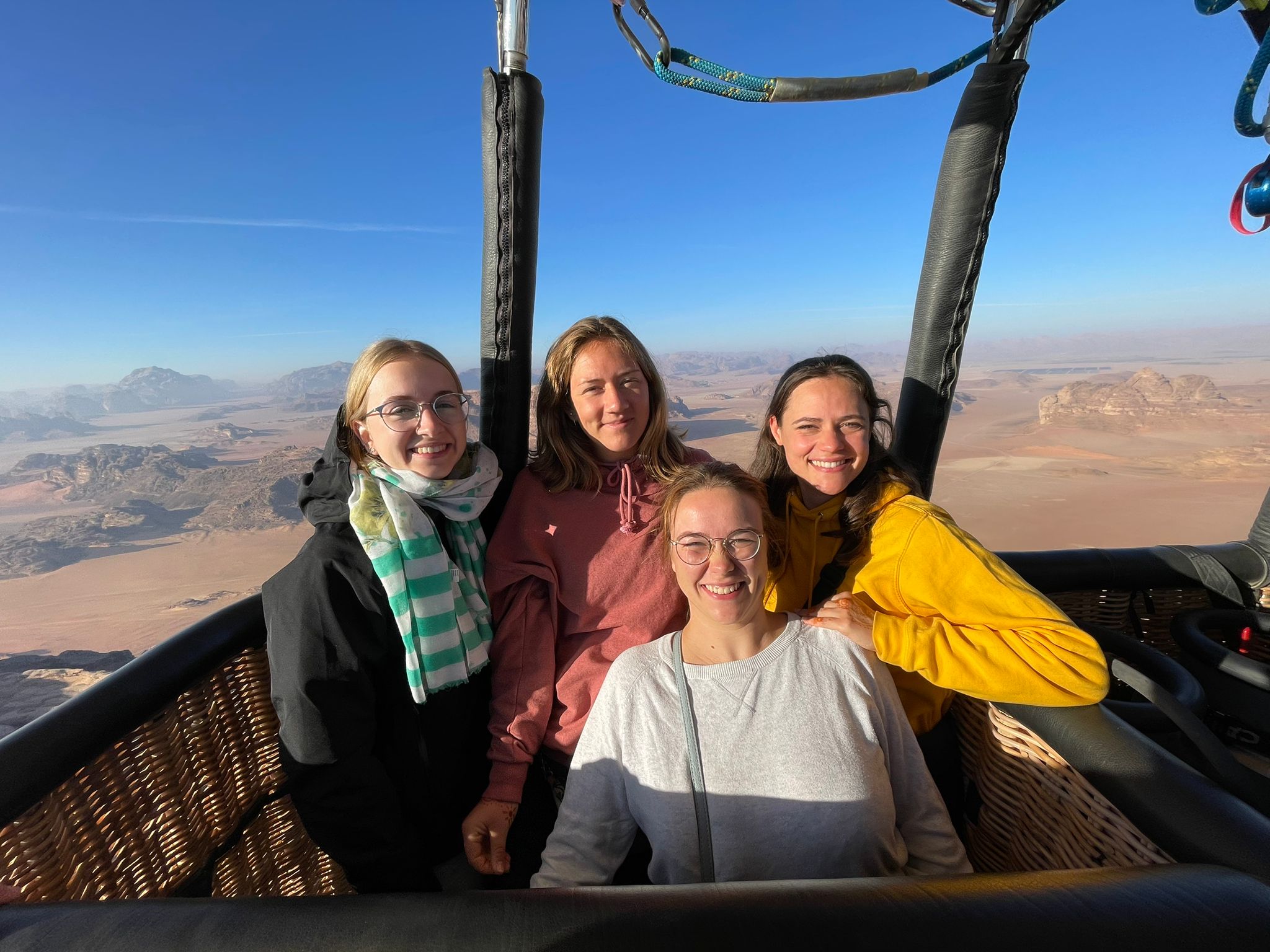
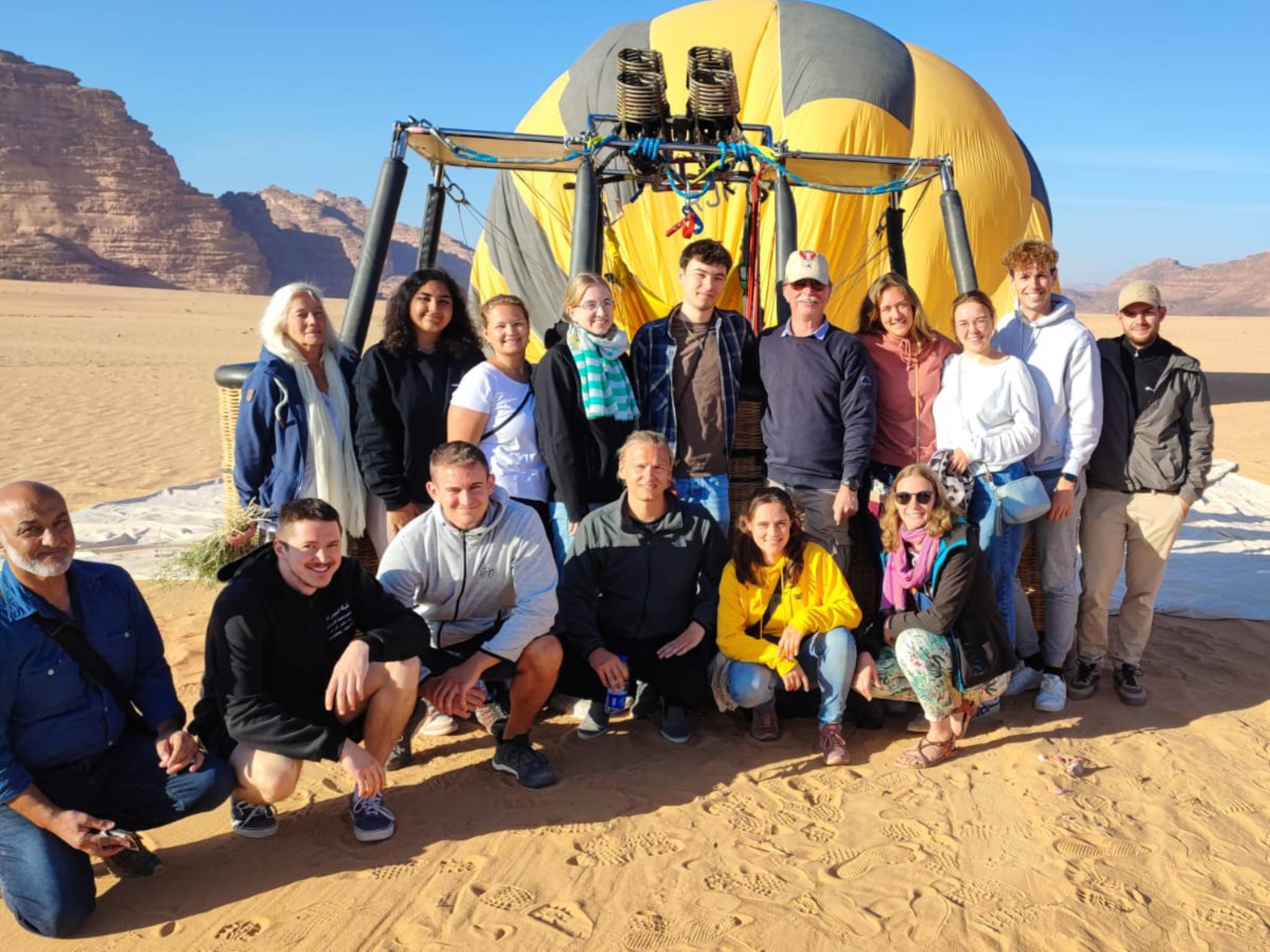
Wadi Rum: Balloon flight, group picture with tour guide Amin (2nd picture far left)
Masada – history and present
410 meters above the Dead Sea, Herod the Great had a mountain massif of over 18 hectares leveled from 36-30 BC and built a gigantic winter palace with several palaces, thermal baths, palace villas (all lined with marble and magnificently painted), warehouses, cisterns, etc., of which little can be seen today. After his death in 4 BC, the Romans established a small garrison here. After Jewish Zealots stormed the Jerusalem royal palace in 66 AD and massacred the Roman garrison, Titus conquered Jerusalem in a punitive action 4 years later and had the temple destroyed. Masada was now the last refuge of the Zealots in the hopeless fight against the Romans and for their freedom. On 2.5.73 AD, after a 4-year siege, the fortress, which was considered impregnable, fell. The Romans had forced thousands of prisoners of war to build a ramp over which they used their war machines to bring down the walls of the fortress. According to the Roman Jewish historian Flavius Josephus, approximately 1,000 men, women and children would have resisted over 15,000 Roman soldiers until they chose mass suicide over surrender. Archaeological evidence, however, calls this account into question. Presumably, he and later historians deliberately magnified the “myth of Masada” of the brave resistance of the Jews. “Masada (= Israel) must never fall again” was the slogan used a few years ago when Israeli recruits were sworn in there. Politically, the fortress stands for Israel’s unconditional will for freedom, thus establishing a connection to the Shoa.
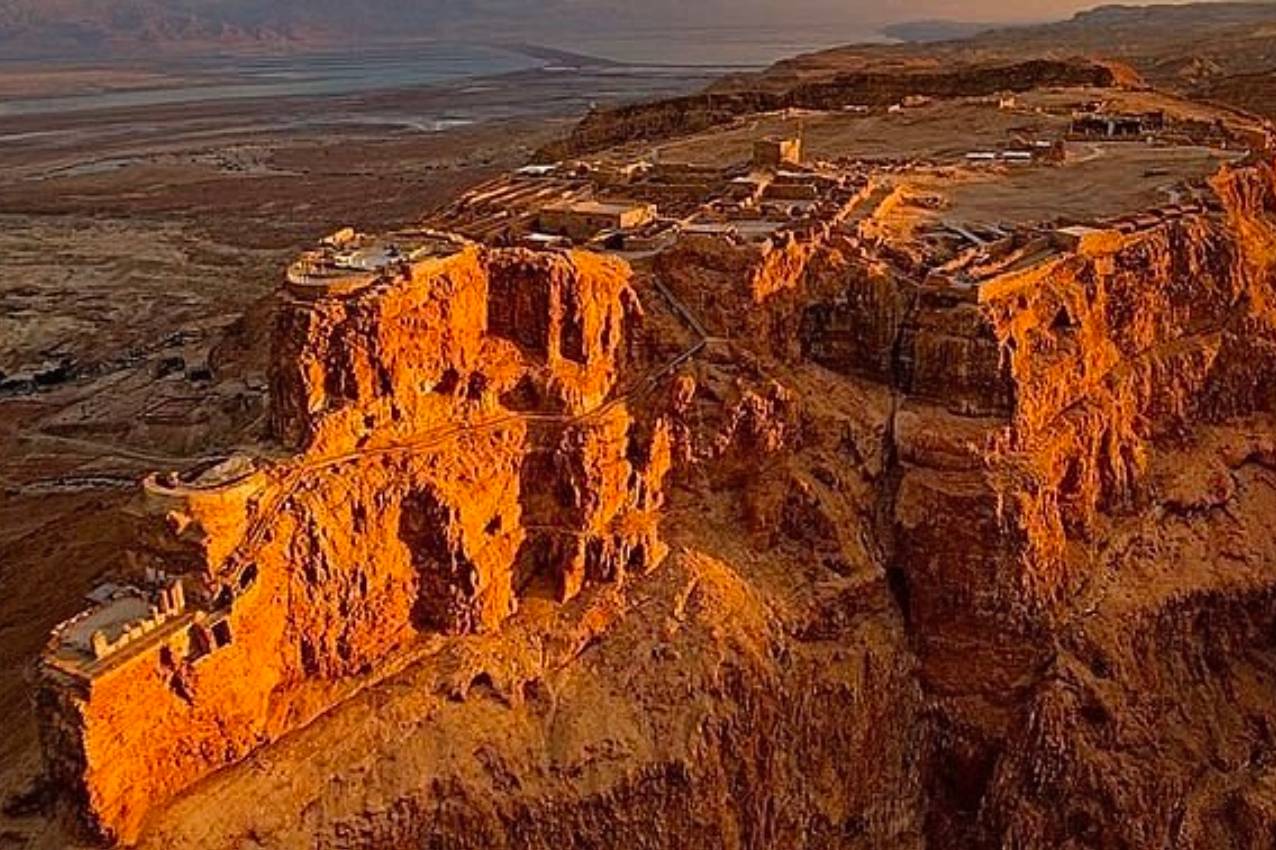
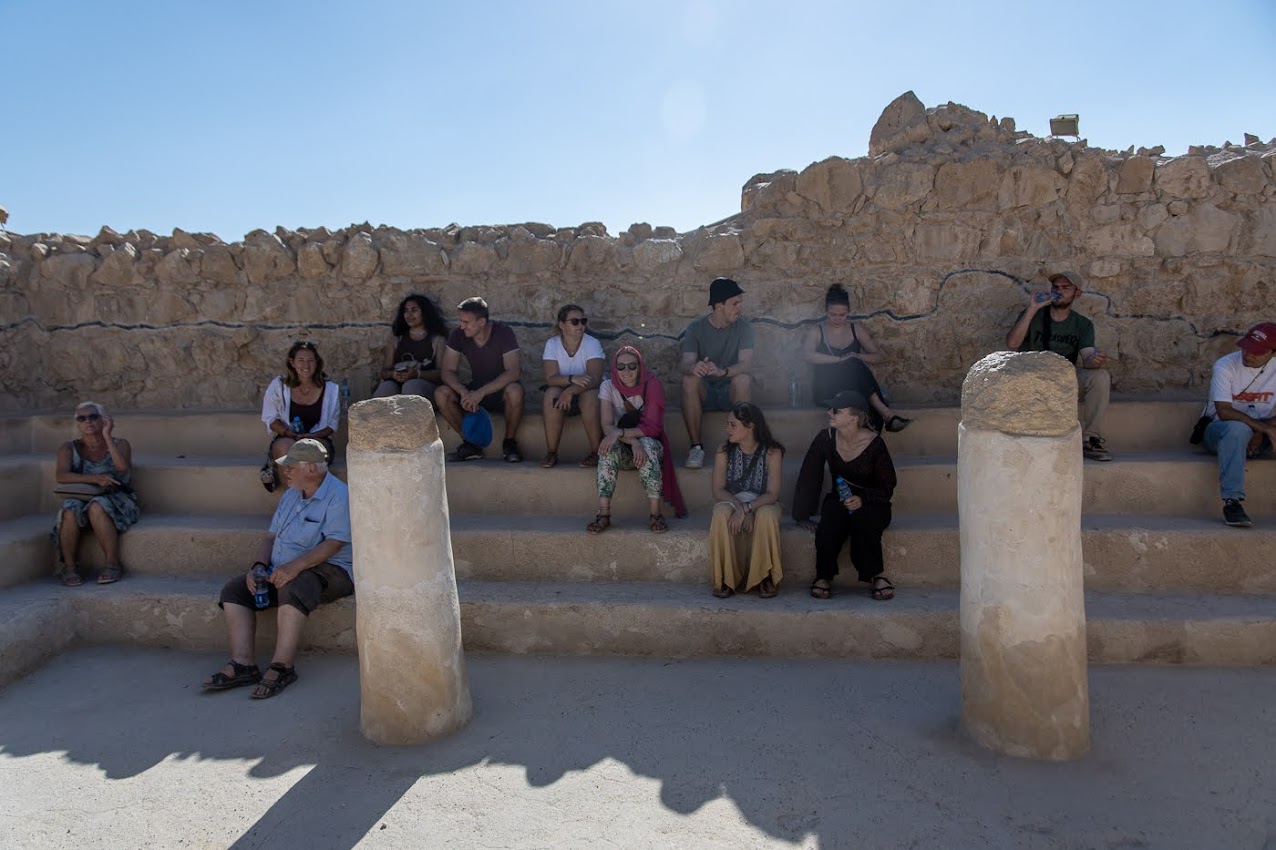
General view of Masada and synagogue
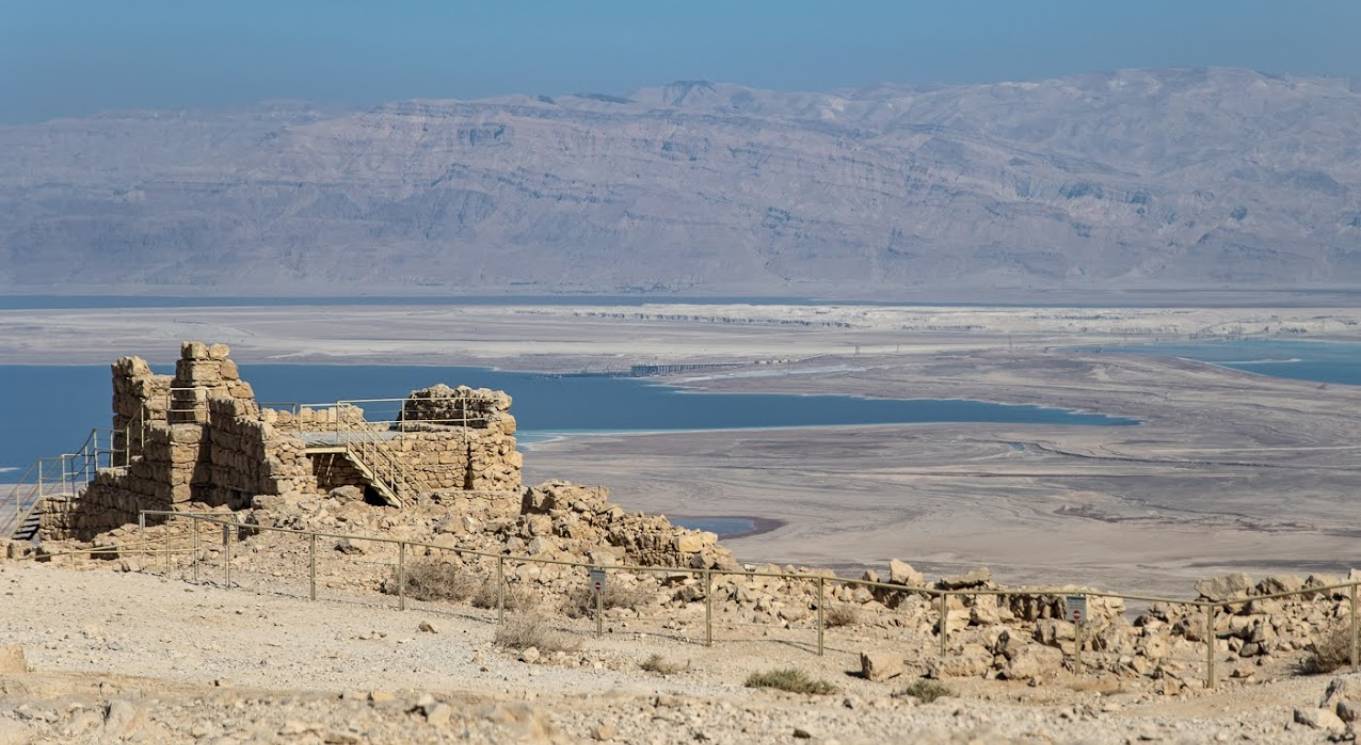
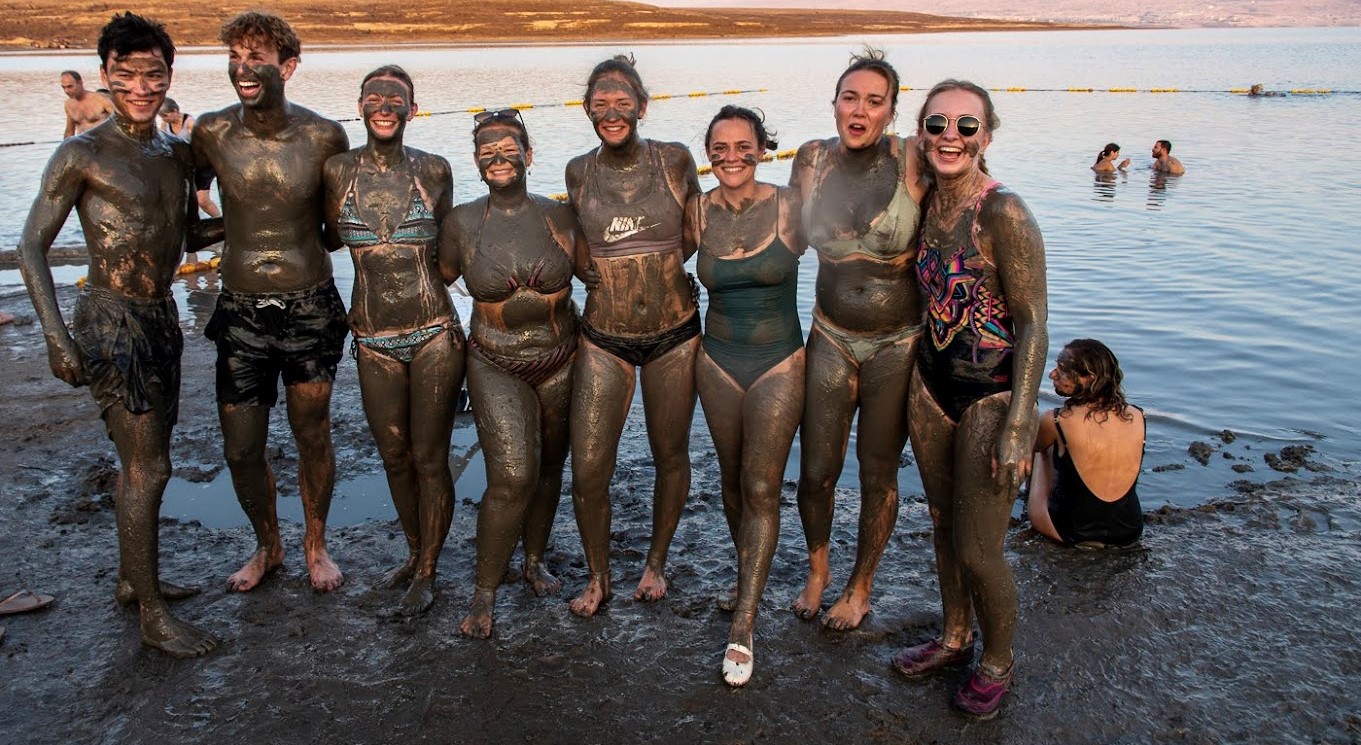
View from Masada to the Dead Sea and Kalia Beach at the Dead Sea near Qumran
Since we had lost a lot of time, we did not visit the botanical garden of Ein Gedi, which was worth seeing, and went directly to Qumran, where we had only lunch, which entitled us to a free visit to Kalia Beach at the Dead Sea (otherwise 70 NIS per person). Due to time constraints and because the excavation site in Qumran offers little spectacular apart from the view of the caves where the Dead Sea Scrolls were found, we also refrained from visiting and drove directly to Kalia Beach, where we had at least another 1.5 hours to enjoy the unique experience of bathing in the Dead Sea.
Qumran and the Dead Sea Scrolls
The Dead Sea Scrolls are a group of ancient Jewish texts attributed to eleven caves near the archaeological site of Khirbet Qumran in the West Bank. From 1947 to 1956 the caves were discovered, mostly by Bedouins. The manuscripts were partly acquired from the antiquities trade, partly found during the archaeological investigation of the caves. About 15 scrolls are still recognizable as such. The rest, an estimated 900 to 1000 rolls, has disintegrated into more than 15,000 fragments. The manuscripts are dated on the basis of the letter forms (paleographically) to the period of the 3rd century. v. Chr. until the 1st century n. Chr. dated. The radiocarbon method was used to verify and confirm this dating in some cases. Most of the texts are written in Hebrew; almost all are literary and have religious content. There are hardly any everyday texts such as letters. The literary character distinguishes the Qumran manuscripts from other ancient textual finds in the region (with the exception of Masada) and, despite the diversity of content, makes them appear to many experts to belong together.
In the Qumran script, a group of texts stands out that were composed in a Jewish community with a special character. This community called itself Jachad and is often identified in research with the Essenes. Members of the Jachad followed the commandments of the Torah with great radicalism and, in addition, their own commandments, of which one knew nothing outside the Jachad. The Jachad rejected the Jerusalem Temple and believed that liturgy in their own group could replace the Jerusalem sacrificial cult. Many writers were convinced that they were living in the end times. This was compatible with an interest in wisdom literature, which is well represented in the spectrum of Qumran writings. Persons of early Christianity are not mentioned in the Qumran texts, which are on average 100 years older.
On the current state of research: Prof. Reinhard Kratz ” Qumran – The Dead Sea Scrolls and the Origin of Biblical Judaism”, Munich 2022).
We then went to the restaurant “The Tent” in Beit Sahour for the farewell evening with 3 teachers, the Palestinian youth and some parents as well as the families of our driver Husam, of Tony Nassar (principal of the Dar Al-Kalima school in Bethlehem) and his brother Daoud Nassar.
After the money exchange of the superfluous NIS and JOD of all TN in € by me with the help of Patrick our guests arrived and we celebrated our farewell with typical Palestinian food for about 2 hours.
Everyone was very enthusiastic about this intensive exchange and the many encounters with Palestinian young people, some of whom had already participated in the exchange in June with us. Unfortunately, the restaurant was very large and quite impersonal, as we did not have a separate area for ourselves. Also, the food was not good as in Al Hakoura Restaurant.
Around 10 p.m., we drove to the Birgittine Convent at the foot of the Mount of Olives and held a brief reflection on the entire trip. As the tour guide, I thanked the wonderful group with 2 small symbols made of olive wood (Star of David and Jerusalem Cross, see below), which symbolized this trip in a very special way.
Early in the morning (16.10.) Edgar drove us to the airport, where we said goodbye to him, then boarded without any major problems with the obligatory security questions, took our flight home (with a stopover in Istanbul) on the very comfortable Turkish Airlines planes and landed safely in Cologne.
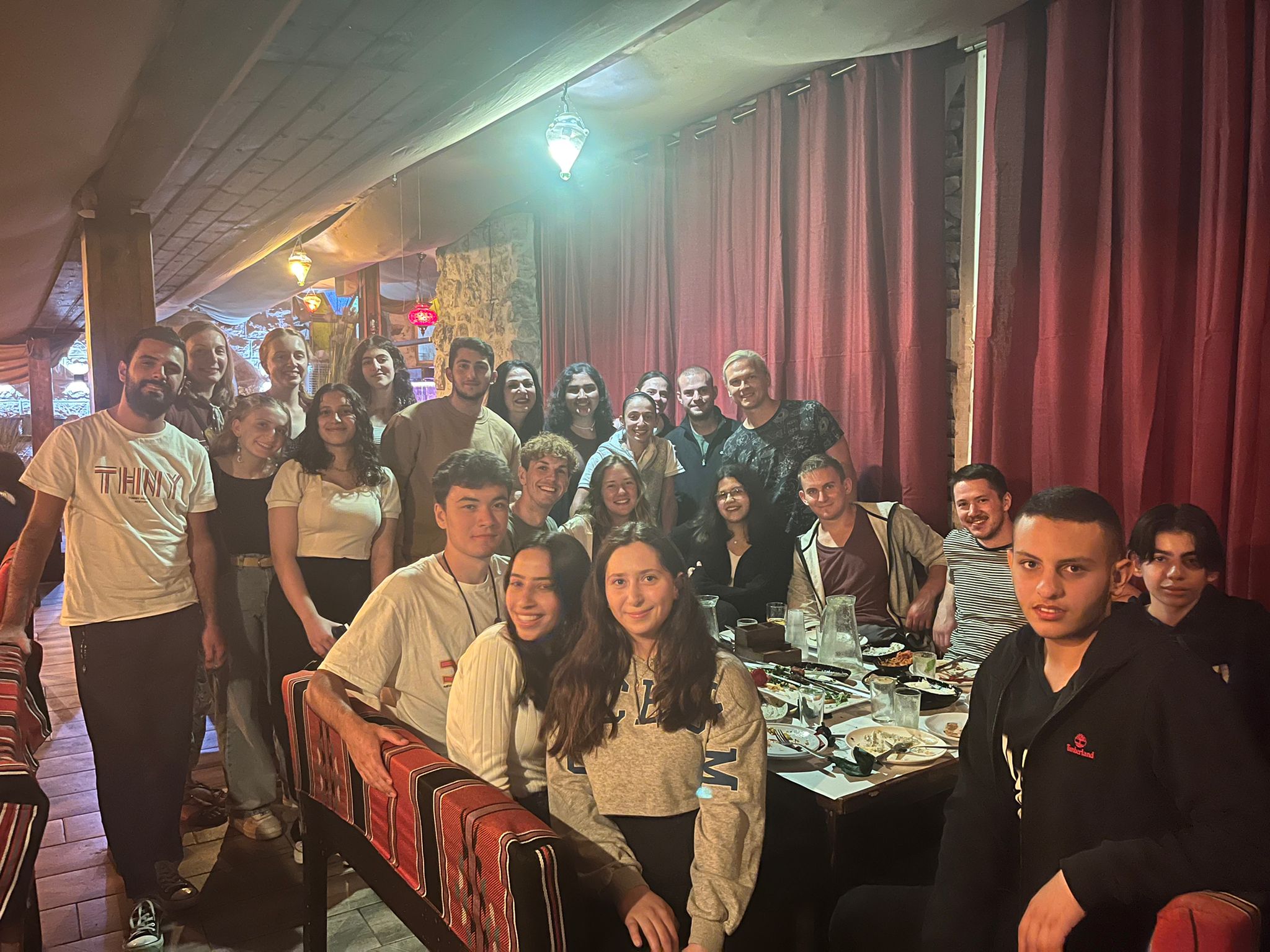
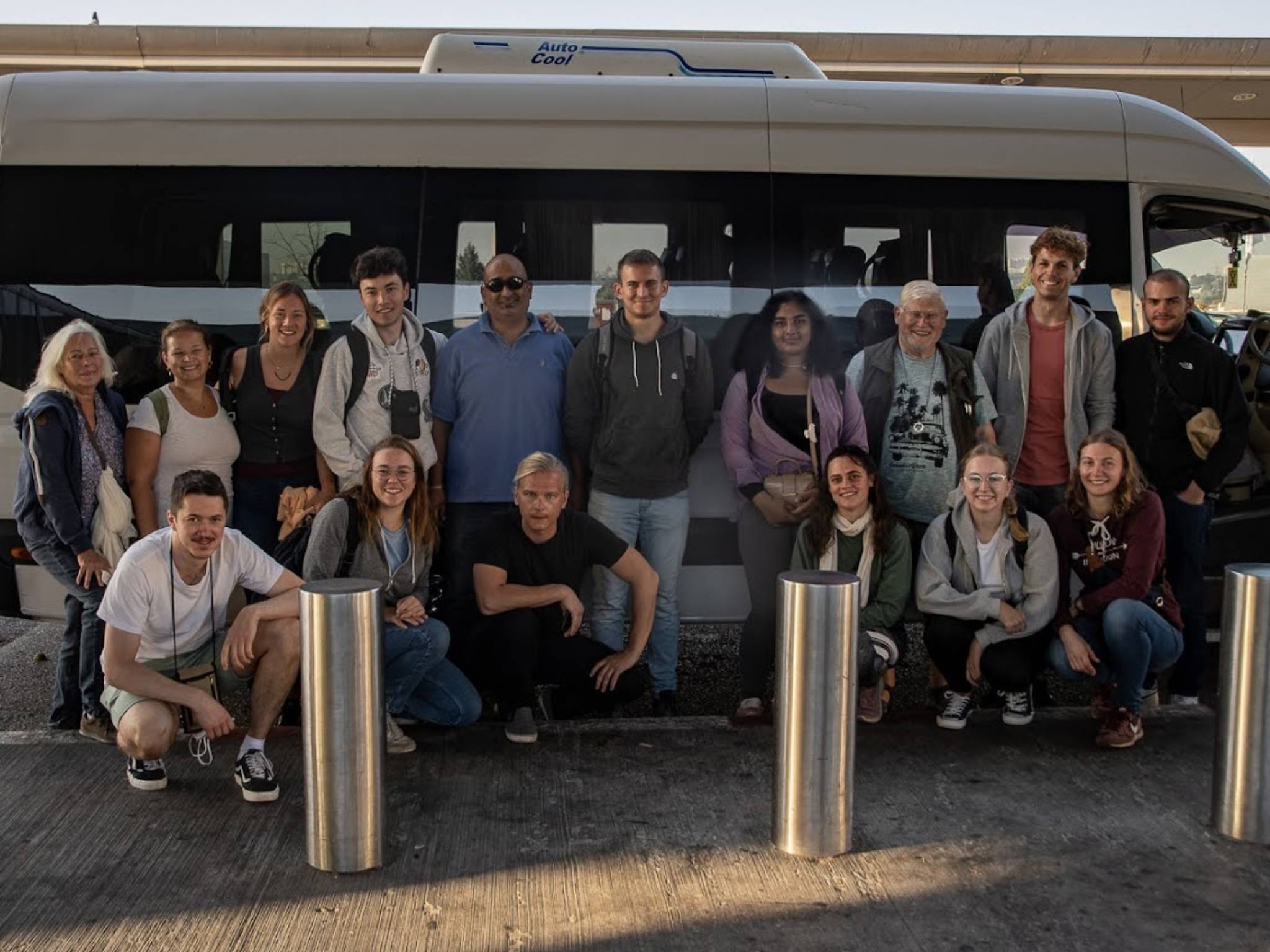
Farewell evening at the restaurant “The Tent” and farewell to Edgar at Ben Gourion Airport
Conclusion:
It was again an overwhelming trip with a very harmonious and interested group. Only a few program points (among others on the 8th day) should be better planned in the future. I will probably not book the Jordanian travel agency or the German-speaking tour guide Amin again. Incidentally, every trip offers new, unpredictable challenges that you can’t plan for beforehand. If the next group in 2023 is as enjoyable and easy to lead as the one this year, I’m already looking forward to the next trip immensely. Perhaps a new management team will be able to replace me from 2025.
Your Gregor
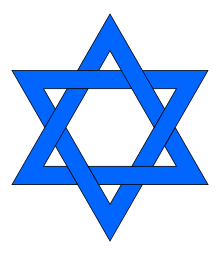
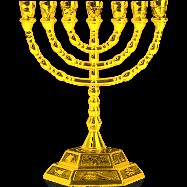
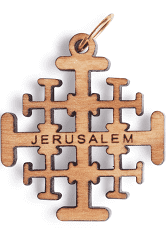
Star of David, Menorah and Jerusalem Cross
Star of David – Menorah – Jerusalem Cross
1. star of David
Depending on the purpose and use of the hexagram, the interpretation of this symbol also varies. For example, the Star of David is interpreted as a symbolic representation of the relationship between man and God. The triangle pointing downward says: Man has received his life from God. The triangle pointing upward says: man will return to God. The outline has 6 outer vertices and 6 corners bent inward, which together form 12 corners. These 12 corners of the star are said to represent the 12 tribes of Israel. Also, the 6 triangles represent the 6 days of creation and the large hexagon in the center represents the 7th day, the day of rest (as in the menorah, the 7-branched candelabrum).
In the Hellenistic world, the hexagram was initially a decorative motif generally used by Jews and gentiles and had no direct connection to Judaism. In the early Middle Ages, the hexagram acquired a defensive meaning and was used equally by Muslims, Christians and Jews as a talisman against demons and the danger of fire. Church buildings, Bible manuscripts, Christian and Jewish signatures on official documents were decorated with this symbol. To avoid the 14th c. Jewish mystical texts connected the hexagram as a talisman – as well as other symbols – with older representations on a shield, which is said to have been connected with the power of God and to have once protected King David (the hexagram consists of two equilateral, interwoven triangles – Greek “Delta” = initial and final letter of David). With the advent of printing in the 15th c. some Jewish publishers in Europe used the hexagram for the design of their imprimatur.
The Jewish community of Prague used the Magen David (Star of David) on their banner for the 1st time in 1490 during the public celebrations on the occasion of the coronation of Vladislav II as King of Hungary. In 1598, Emperor Rudolf II granted the head of the Jewish community in Prague, Mordechai Meisel, the right to have a banner of the same design made for his private synagogue as a sign of special favor. The banners were taken out of the synagogue and publicly displayed only on special occasions such as coronation ceremonies, visits of the king to Prague or birth of an heir to the throne. Throughout history, the banners underwent some changes. Thus, since the middle of the 16th century. a Jewish hat embedded in the Star of David.
With the Enlightenment in the 18th century. an, the hexagram was considered a general symbol of faith. In Europe, Jewish emancipation raised hopes for full citizenship in the newly formed European nation-states. Until now, Judaism had never been recognized as an equal by the other religions of the book. For the integration-minded Jews of the Enlightenment, who championed Judaism as a religion, a symbol representing the religion, like the cross represents Christianity, became necessary. The Star of David (Magen David) offered itself as such a symbol. Gentile architects used the Magen David to delineate the similar building forms of churches when building synagogues.
When European Jews at the end of the 19th century. Finally, as Jews became increasingly equal and involved in political life, anti-Semitism grew in non-Jewish circles. Zionism can be seen as a response to this: the movement to establish an independent Jewish nation-state. The Zionists adopted the Magen David, as a secular rather than a religious symbol. During the Nazi era, the police order of September 1, 1941, compulsorily imposed on those considered Jews under the racial laws the wearing of a modified version of the Magen David, the “Jewish Star” (“Yellow Star”), to publicly identify their clothing. This can be seen as a repetition of events in medieval Europe, in that Christian princes ordered the wearing of a Yellow Patch to make Jews recognizable to Christians.
With the founding of the State of Israel on 14.5. In 1948, the Magen David became the emblem of the national flag of Israel. M. In my opinion, the choice of the Star of David as the symbol of Israel was not a good choice because of the past history.
The menorah, on the other hand, is the oldest peaceful religious symbol of Judaism, since Moses was already commissioned by God to make a menorah, and is not so negatively politically biased or ideologically charged.
3. Jerusalem cross
The sign associated with the Kingdom of Jerusalem, founded by the Crusaders in 1099, actually appears on coins, seals and flags that have nothing to do with the world of the Crusades. It is a Greek cross, with a smaller Greek cross arranged in each of the 4 quadrants again. The 5 crosses of the Jerusalem Cross are interpreted as the 5 wounds of Christ. Most likely, the Jerusalem Cross is the development of a Greek cross with small dots in place of the small Greek crosses used by the very first Christian communities in the Middle East in Roman times, a thousand years before the Crusades. Many signs found in various places in the Holy Land refer to the Jerusalem Cross, including a certain number of mosaics in which it appears in a form completely identical to its present representation. Its origin can be traced back to the Phoenicians in the form of a white eight-point cross, which is said to represent the 8 Beatitudes of Christ. With the Crusades, the Jerusalem Cross acquired a political meaning and a territorial identity in addition to its spiritual significance. It was first used as a coat of arms by the crusader Gottfried von Bouillon in 1099. He made the coat of arms of the Duchy of Bouillon, the Belgian crutch cross with four additional Greek crosses, the symbol and national emblem of the Kingdom of Jerusalem. There it was used in gold on silver until 1291. At 14th c. the cross was painted in red color under King Giorgi V the Radiant until the 15th c. to the flag of Georgia. The mostly noble Jerusalem pilgrims, who were knighted at the Holy Sepulcher by the Order of the Knights of the Holy Sepulcher of Jerusalem, chose it in the 14th c. also to their emblem, similar to the Canons of the Holy Sepulchre. The representation of a Latin cross without the crucified is first found on sarcophagi of the 4th/5th century. Century. The Latin cross prevailed especially in Western Christianity, where it was perceived as the actual form of Jesus’ cross (hence “passion cross”). It is therefore the usual form of the crucifix in the Western tradition. At the latest with the depiction of the suffering Jesus on the cross, the focus was placed on the crucifixion of Jesus, which then naturally made the non-Christians, especially the Jews (= “Christ murderers”), the target of persecution. The early Christians, e.g. in Rome, on the other hand, used the fish as their secret religious identification sign, each letter symbolizing a word (Greek “ἰχθύς” (Ichthys): Ιησούς – Iesóus– Jesus, Χριστός – Christós– Christ (the “Anointed One,” in Hebrew “Mashiach” = Messiah), Θεού – Theoú– God, Υιός – Hyiós– Son Σωτήρ – Soter– Savior, Redeemer. Even in the Roman catacombs, Jesus is portrayed only as the Teacher, the Savior, the Good Shepherd, the Savior, etc., without the accusatory component of Christ crucified.
The choice of religious symbols can therefore certainly bring about a change in this religion itself.
